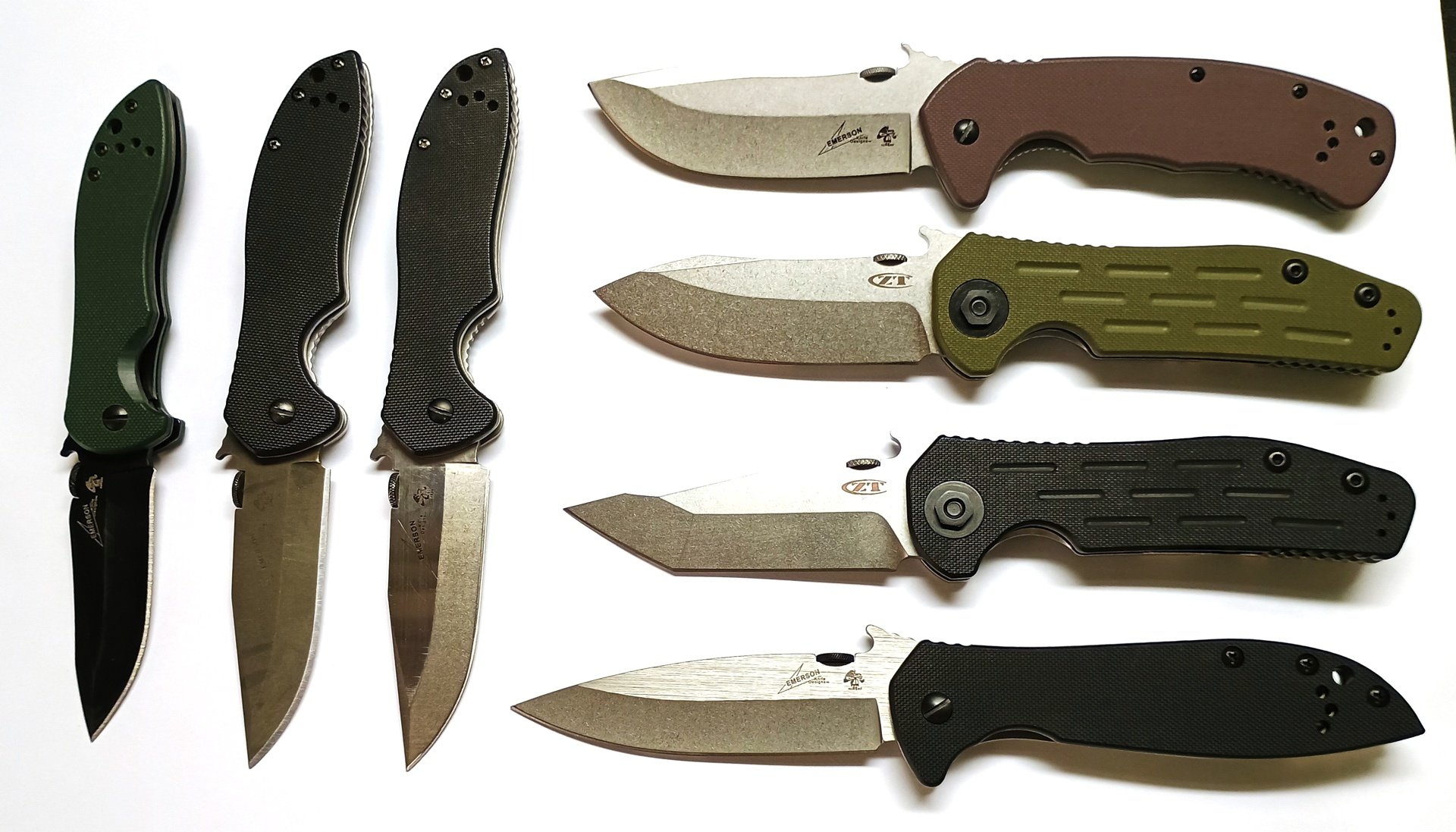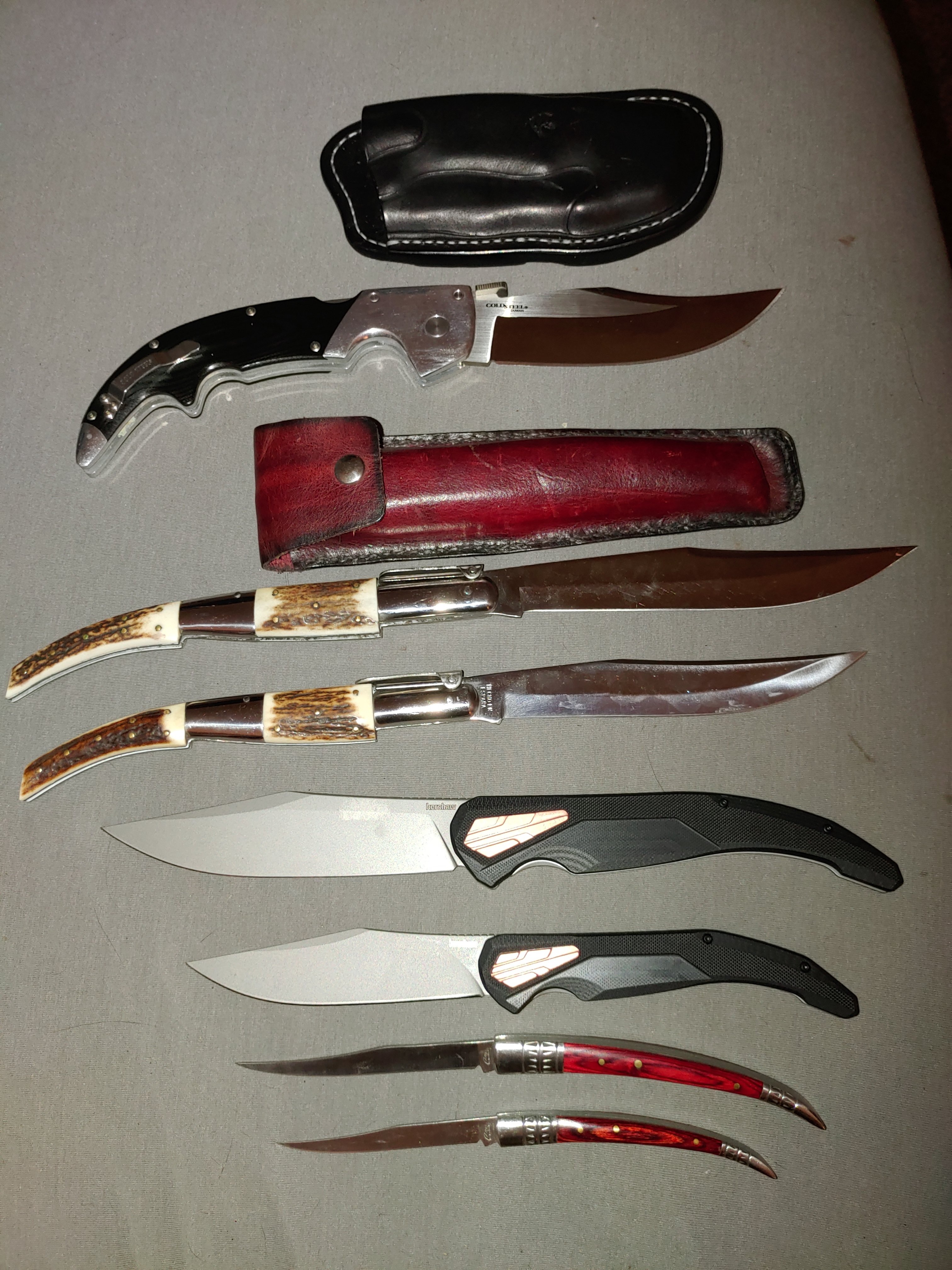PocketKNIFE
This is the place for talking about all things pocket knives, and knife adjacent things. Folders large and small, multi-tools, sharpeners, even fixed blade knives are welcome. Reviews! Advice! Show off your Knives!
Also home of the incredibly loquacious Weird Knife Wednesday feature.
Simple Rules
- Don't be an asshole.
- Post any bigotry or hate speech and we'll cut you.
- No gore or injury posts.
- Keep politics out of here, unless it's knife related.
- Brand/model/maker/etc. elitism is highly frowned upon.
- Shilling your brand or product is OK provided that's not all you do and you make other contributions.
- For sale and trade posts allowed, but site admins and mods are not responsible for the outcome.
I Ate'nt Dead.
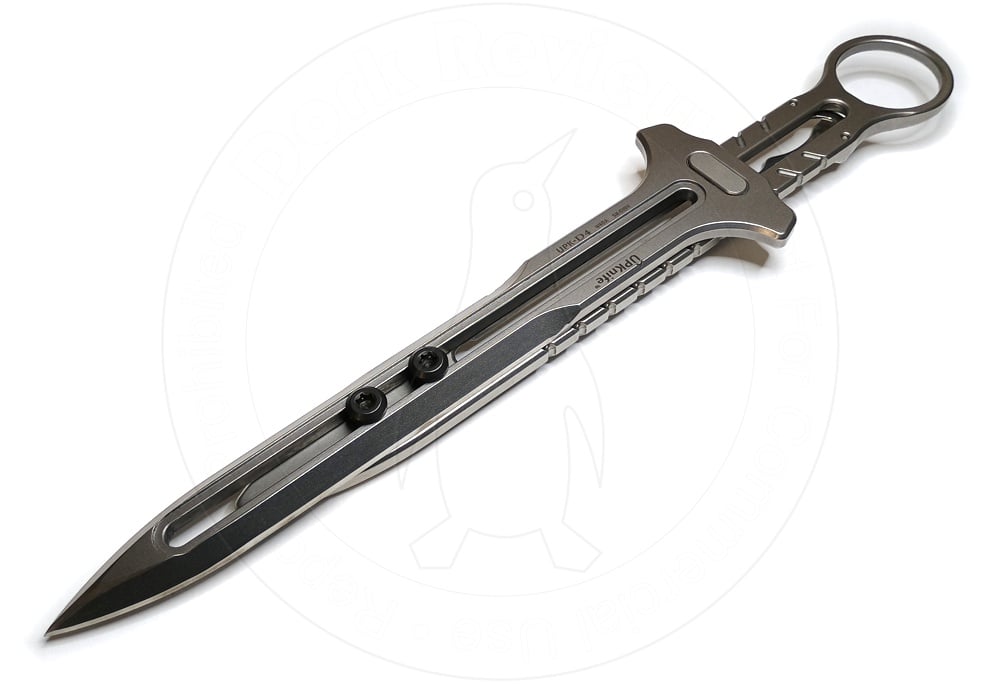
Here's the UPKnife UPD-D4, the "Eclipse Ring2," which is a entry in their lengthy and baffling spread of near identical almost-knives from their (D)efense series. It is, verily, weird.
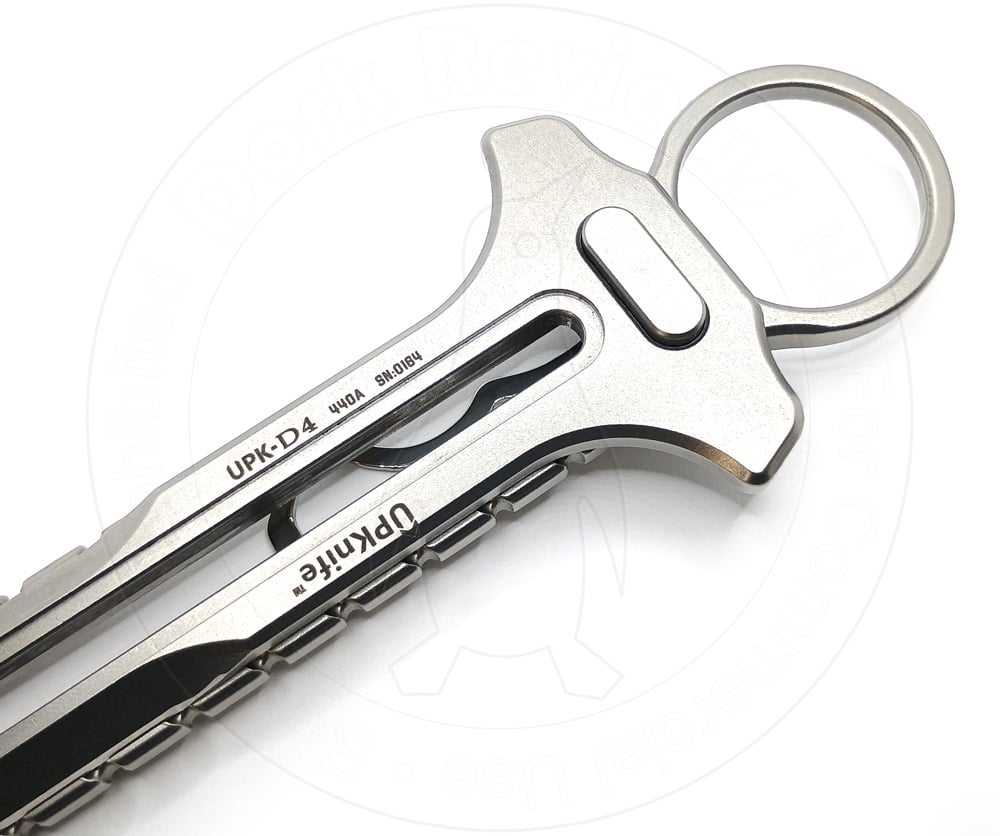
This D4 variant is the most knifelike thing in their lineup, so that's what I got. This version is steel through-and-through, 440A on the blade and an unknown alloy for the handle. Every other part is steel of some description, too, by way of a magnet readily sticking to all of them.
Made of steel? That sounds like a stupid thing to say about a knife, doesn't it?
Well, that's because all those extra words and letters on the model name designate what this is and what it's made out of. You can get these in a dizzying array of materials, shapes, and construction types depending on what you plan to do with it and how much you want to spend.
Half of UPKnife's D-Series is their "Pocket Sai," which is exactly what it sounds like. You can get this and indeed those in polymer, titanium, aluminum, steel, and various combinations thereof. Most of them are unsharpened, save for the steel versions where you're offered the choice, but you can also get them with carbide steel cutting tips just at the point. UPKnife obviously expect most of these to be real-deal self defense martial arts weapony things, which I suppose is interesting, but I have to say I haven't found myself beset by rogue samurai, cutlass wielding pirates, or any other swordsmen in years, personally, so stuff like that is probably of limited utility for me.
So I got this one, which encompasses: A ring on the end, full length, made entirely of steel, a perfunctory crossguard rather than sai prongs, and fully edged. In the sliver finish, not black. 'Cuz it's shiny, duh.
Actually, more on the "fully edged" in a moment.
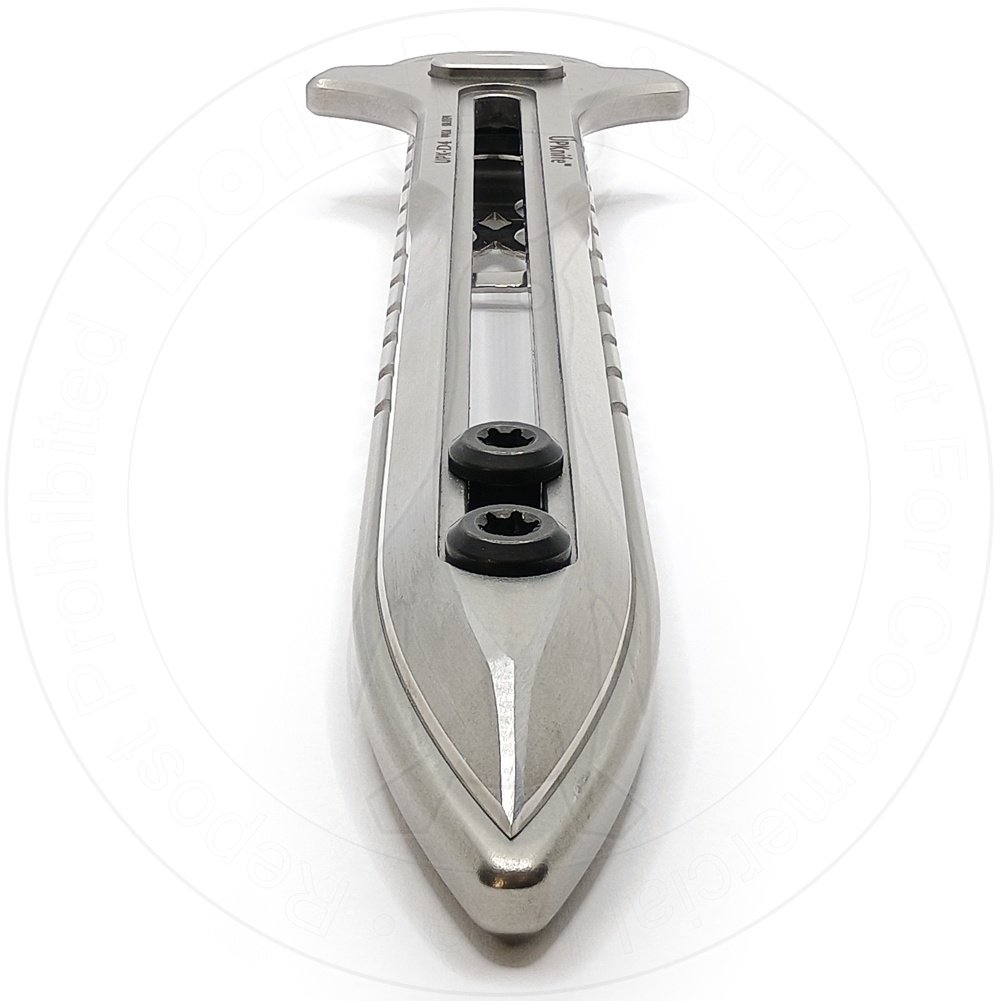
The UPK-D4 is a slider opener, if you hadn't figured that out based on the picture of it partially deployed above. UPKnife call it "self sheathing," and when it's at rest the blade sits flat against the handle with a generous 3/16" or so all the way around the perimeter to keep it from acting like a parmesan cheese shaver against your fingers. To deploy it, you press the wide oval shaped button on it to unlock it, and...
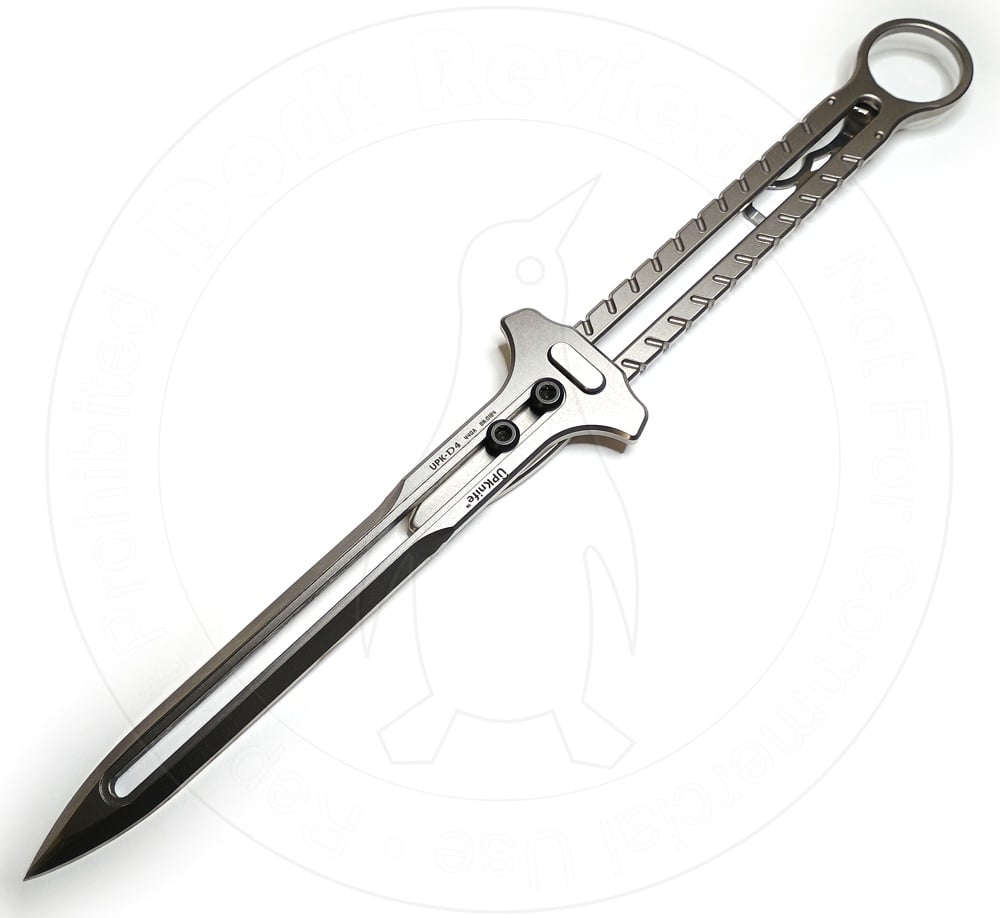
...It extends with a snap of the wrist into this 12-3/8" long dagger with a snick that would even make James Howlett flinch. The blade is every bit of 0.185" thick at the root, double edged, and every little thing about the UPK-D4 broadcasts to the world that it is absolutely not fucking around. The whole thing not including the clip is 0.425" thick.

There are a few shorter compact versions of these, but this isn't one of them. I went with the whole enchilada, because why the fuck not? Even when closed it's a full 8" long. It's 183.5 grams or 6.48 ounces, and I would not be surprised if anyone told me my steel version is the heaviest of the bunch. All those polymer and titanium and whatever-else jobbies have got to be lighter than this.
There is a clip on the back side and be still my heart, but it's even a deep carry one. Even so the ring sticks up above the hem of your pocket, I suppose providing an easy draw while it's at it. And you need very deep pockets to trouser this.
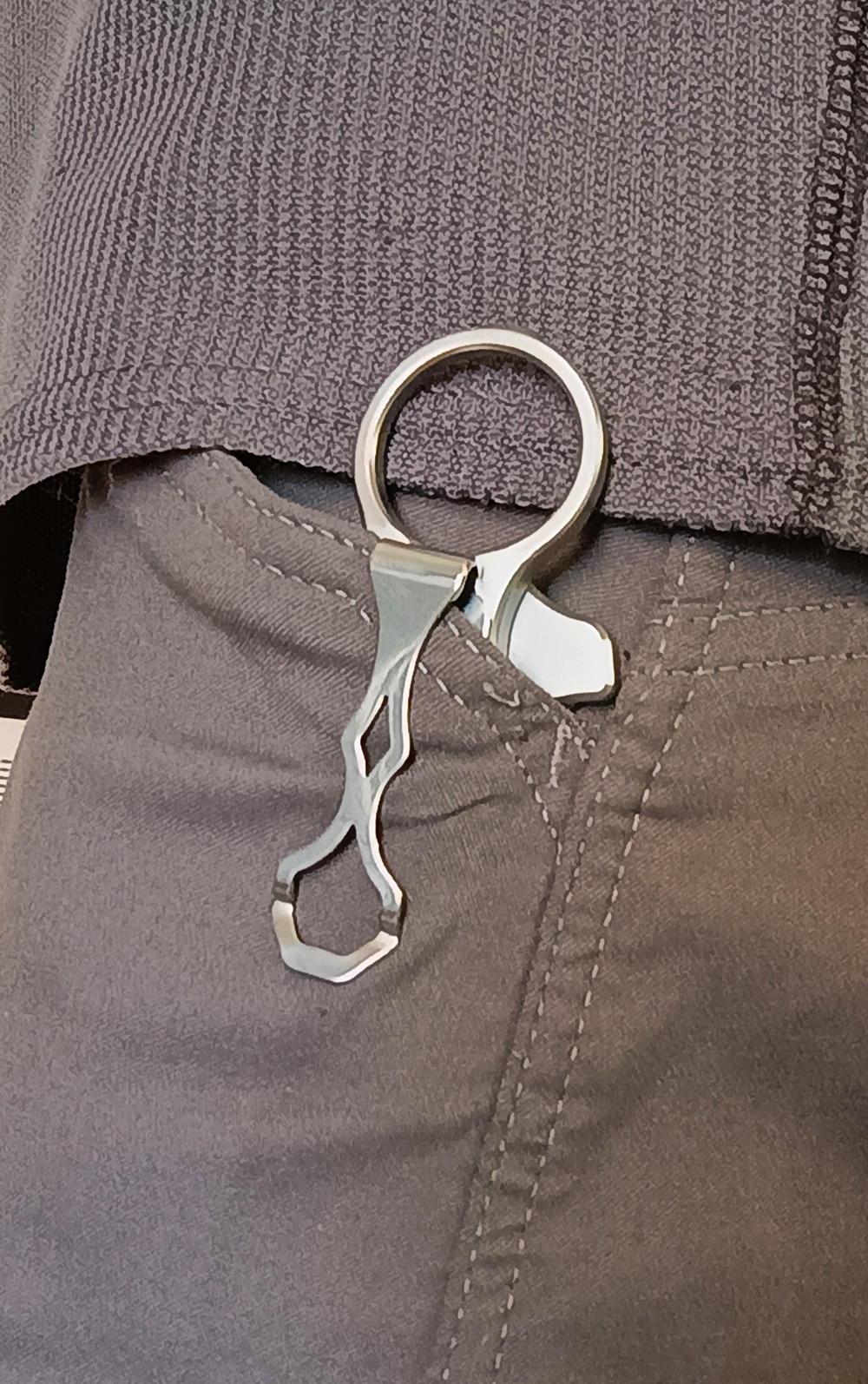
It is still, however, possible. All of the edges on it except for the one on the blade are it are chamfered and rounded over, so it is snag free and actually draws quite cleanly and easily. There are some gripping greebles on the handle and it's got a nice bead blasted satin finish all over.
The ring on the back is very generously sized and anyone should be able to fit a thumb through it. Its presence and proportions ought to bring a smile to the face of any ninja anywhere. There's a little glass breaker point on the very tail end of it which is probably superfluous; I'll bet if you whacked a piece of glass with just about any part of this knife you'd break it easily. The glass, that is. Not the knife.
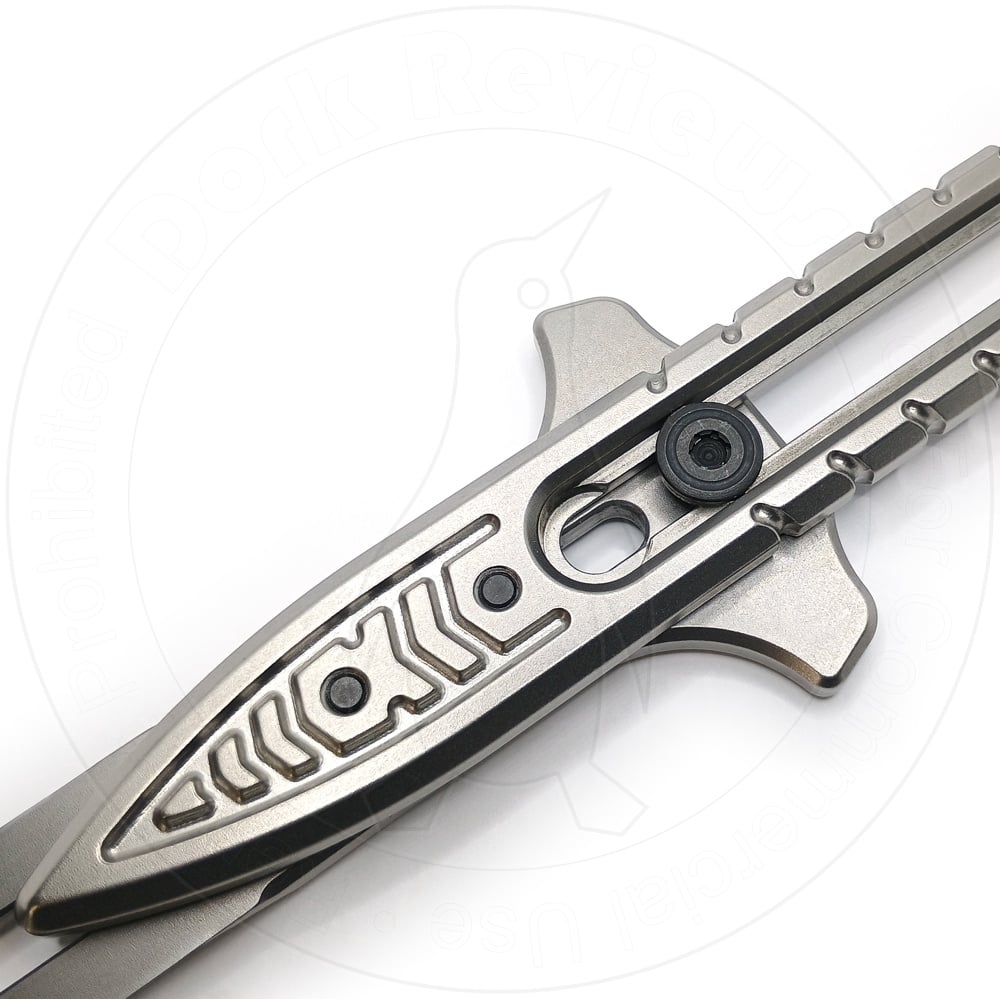
The UPD-D4's mechanism, and indeed everything else in its series, consists of this sliding track arrangement. When you press the button it pushes the head of this locking lug up and out of the pockets on either end of the track, allowing the blade to slide freely until it hits the other end.
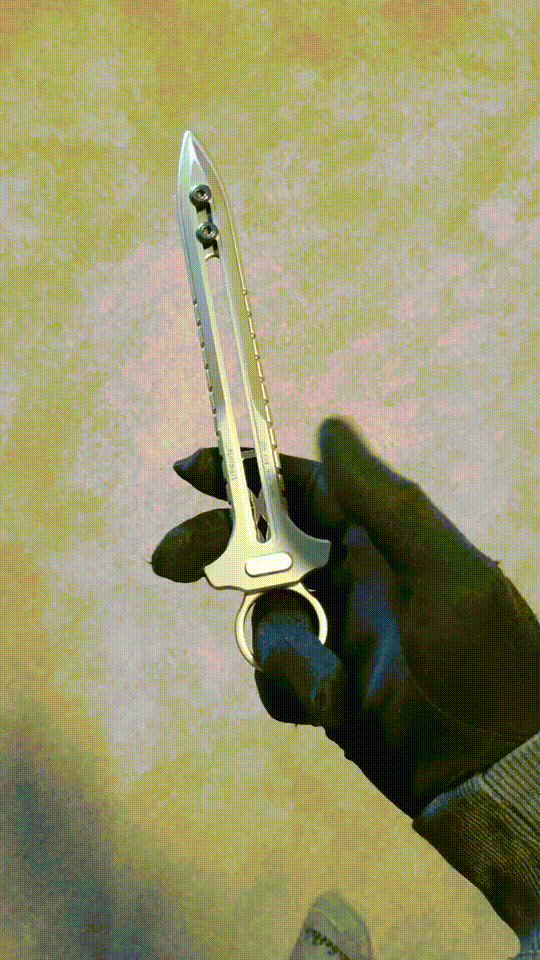
From here the blade goes snicker-snack into your choice of overhand...
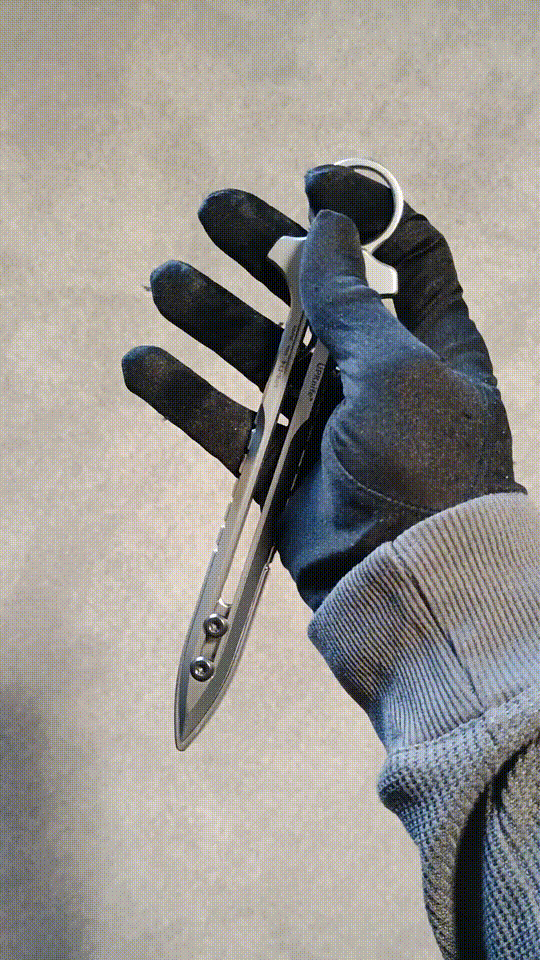
...Or underhand grip positions.
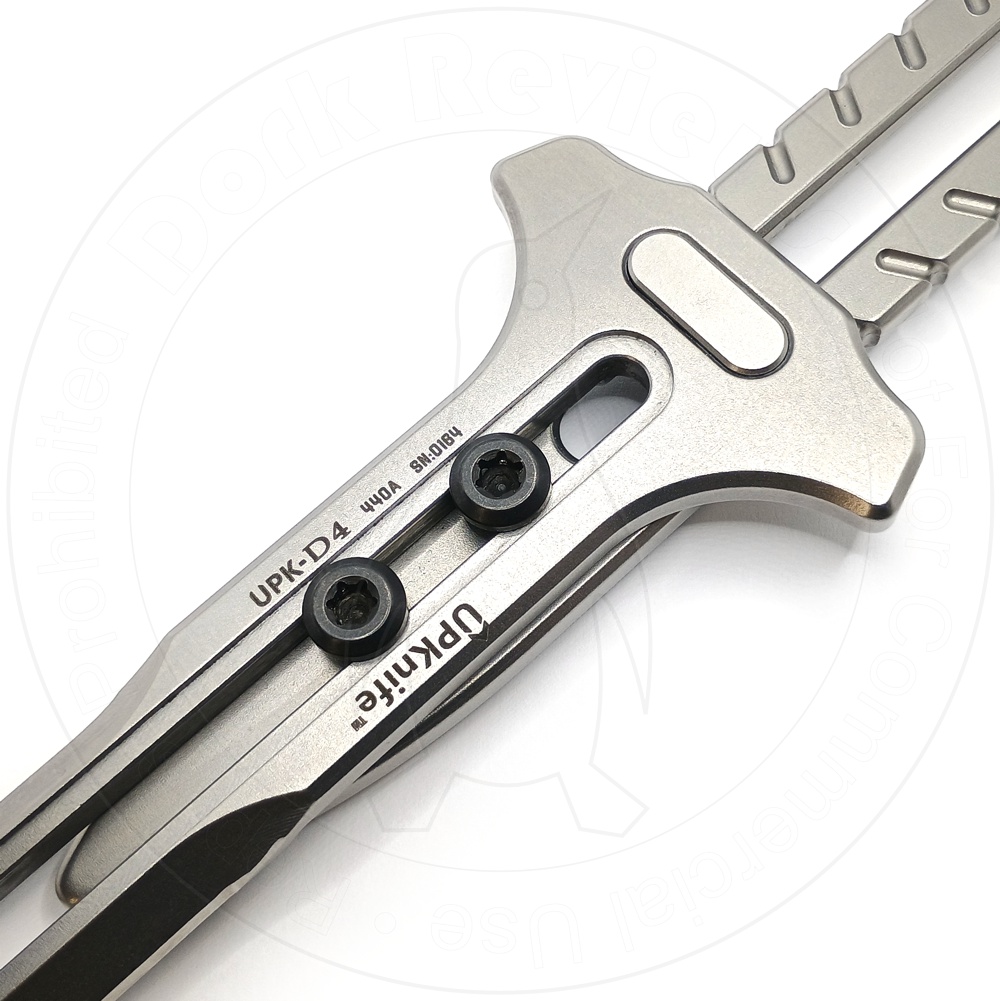
The blade's kept straight at all times by not only the locking lug, but also these two beefy screws that act as guide pins. Overtravel is prevented by both the lug and the guide pins, and the blade hits home on both of these simultaneously at both ends of its travel.
You might think at first blush this setup is both suspect and a little flimsy. Everyone else probably thinks you will, too, because the internet is just rife with videos of people bashing, prying, twisting, and jumping on these to try to get the mechanism to break. Especially with this all steel version, suffice it to say that this seems extremely unlikely. The bolts are all seriously skookum for what you'd normally find on a knife. The heads on them are no mere T6, T8, or even T15. They're T20, all of them, and the shanks on them terminate in an M4 thread. Even a dinky class 4.8 M4 bolt has a minimum tensile strength rating of something like 840 pounds-force, and you'd probably bend the blade before you got to that point.
And UPKnife have this to say about the alloy:
Optimized for throwing and melee impact, made in 440A high carbon martensitic stainless steel with a hardness of HRC: 45 makes a tough resilient stainless. It can take extreme abuse and offer a point of bending where harder alloys will break, making this ideal for throwing when the worst abuse takes place.
Optimized for throwing, huh? Well, don't mind if I do.
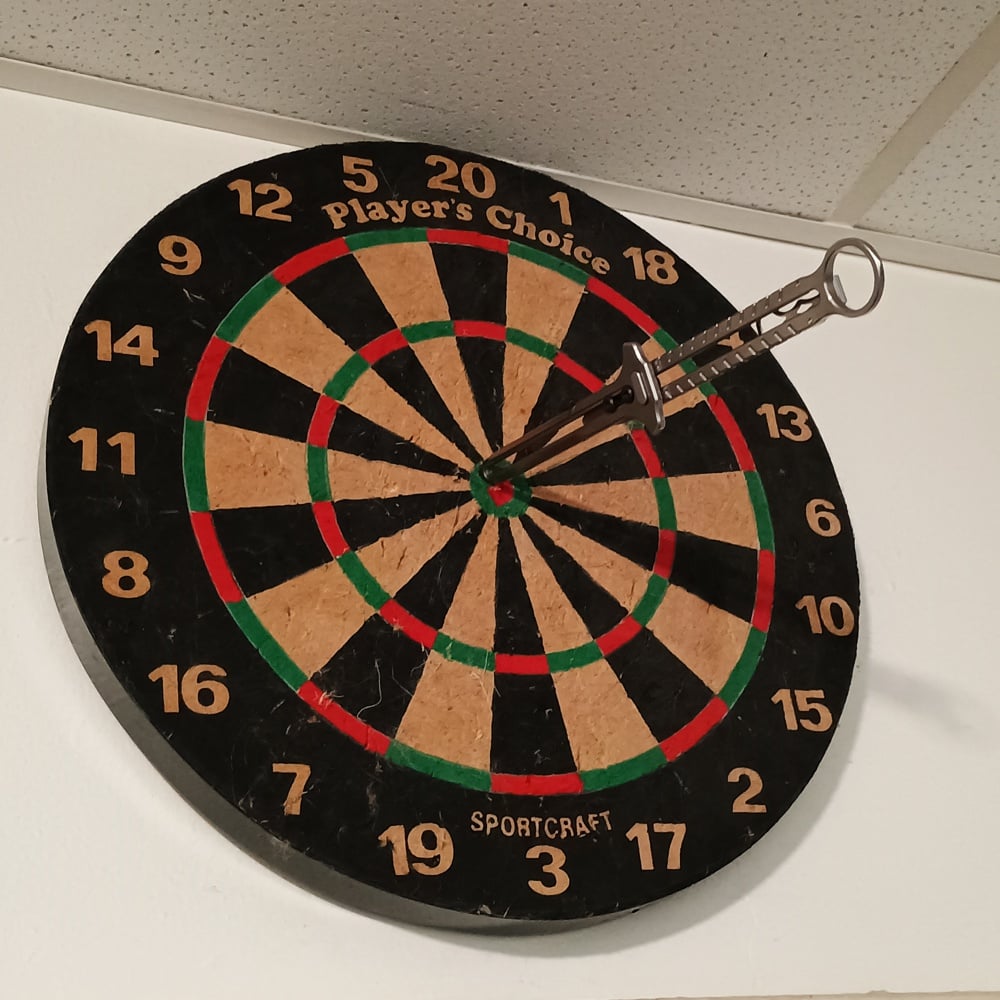
The point of balance is somehow precisely in the middle of this, too, aligned right where the button is.
And yes, 45 HRC is ridiculously soft for blade steel, even for 440A. For optimum edge retention you'd expect it to be at 55 or so. The UPK-D4 is more like a leaf spring than a knife in that regard, and in light of that you'd expect its edge retention to be pretty poor.
And it probably is. And that's probably why its edge angle is what it is, too.
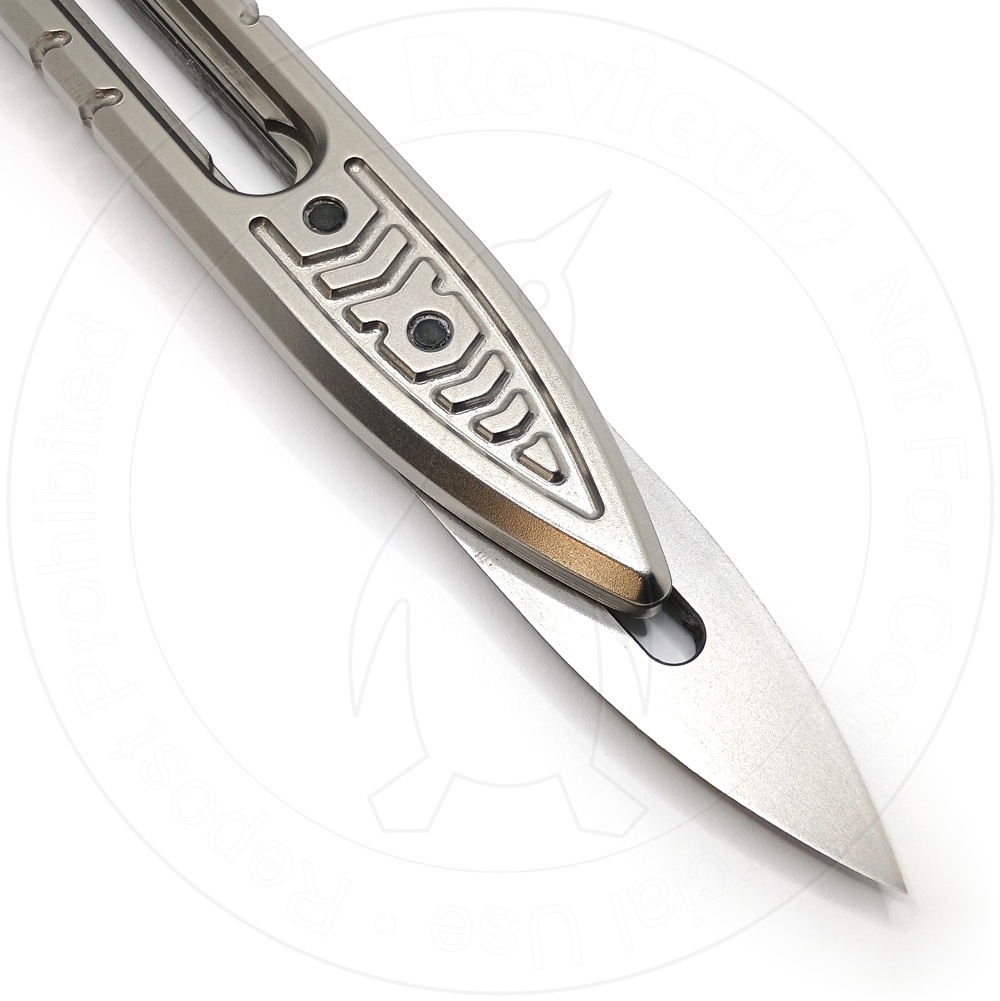
The UPK-D4's blade is chisel ground which in this case I think is excusable since it needs to sit against its handle when retracted. The back of it is dead flat.
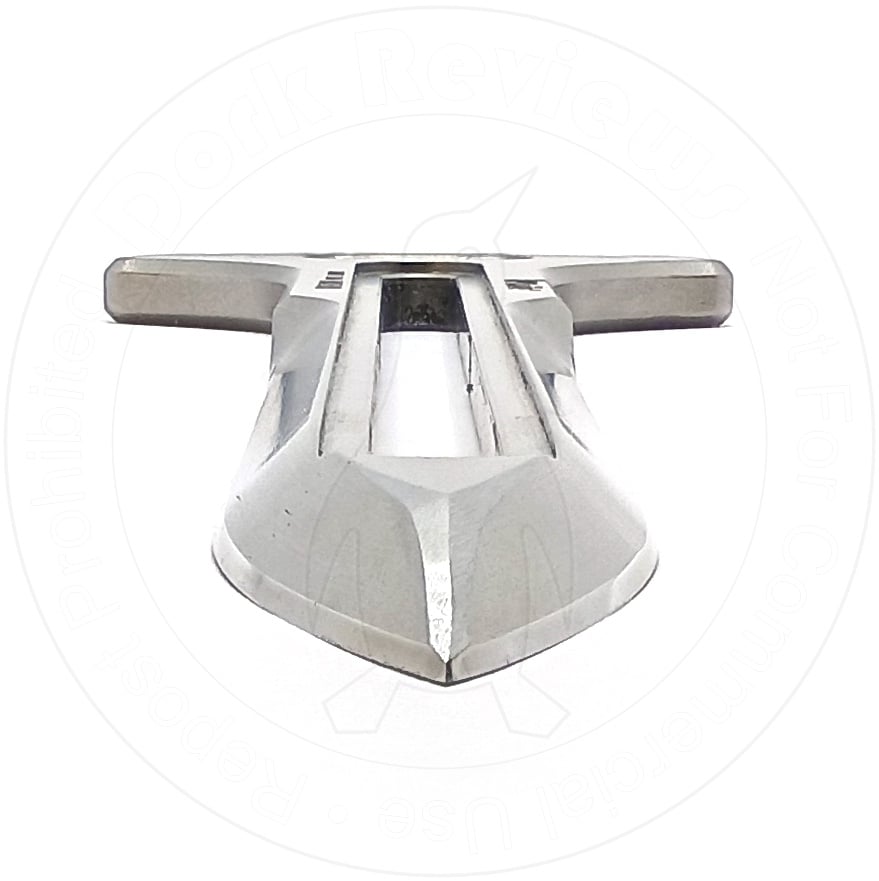
Its taper is about 45 degrees, which is ridiculously steep. It follows that its actual edge angle must be steeper still, and it sure is.
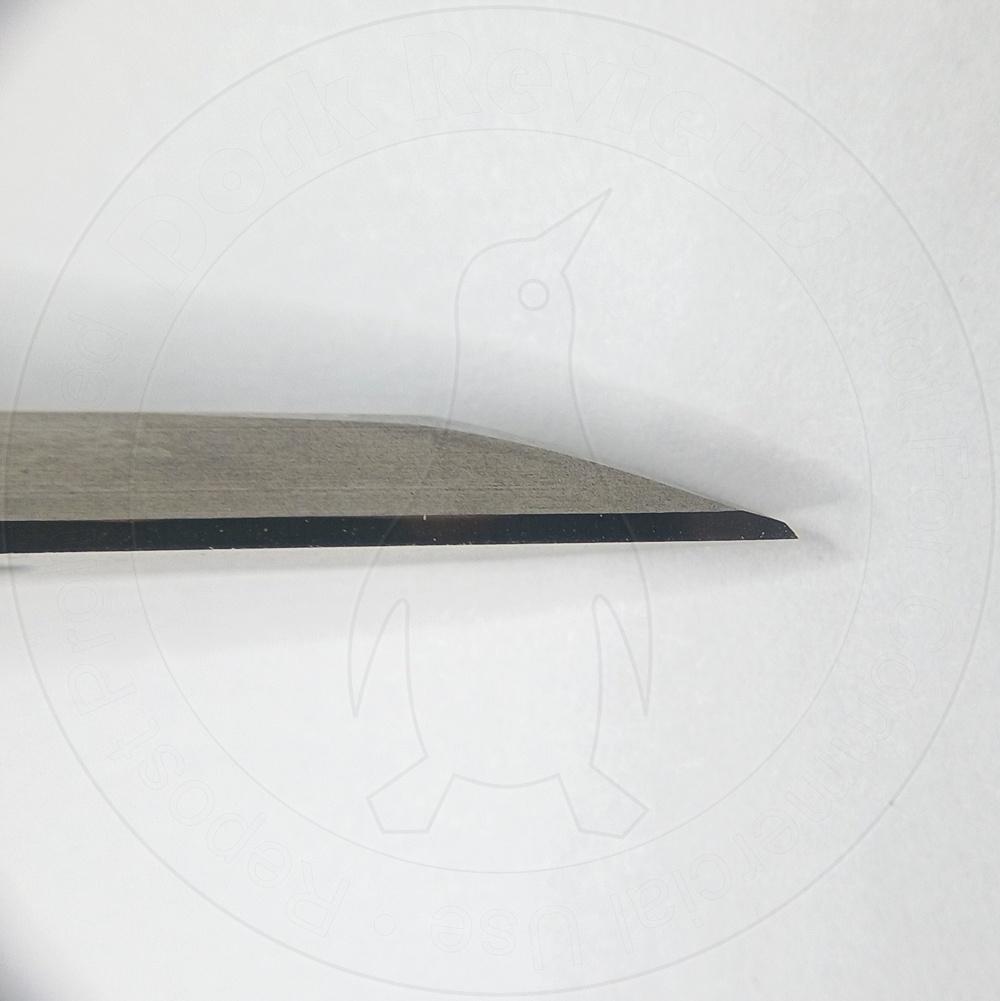
We like superlatives around here: Whatever's the biggest, the thickest, the lightest, the heaviest, the sharpest. Well, the UPK-D4's sure got one -- I don't know if it has the most obtuse edge angle of any knife in history ever, but it's certainly the steepest out of anything I own. 60 full and glorious degrees, by my reckoning. I think that means it just barely even qualifies as a knife.
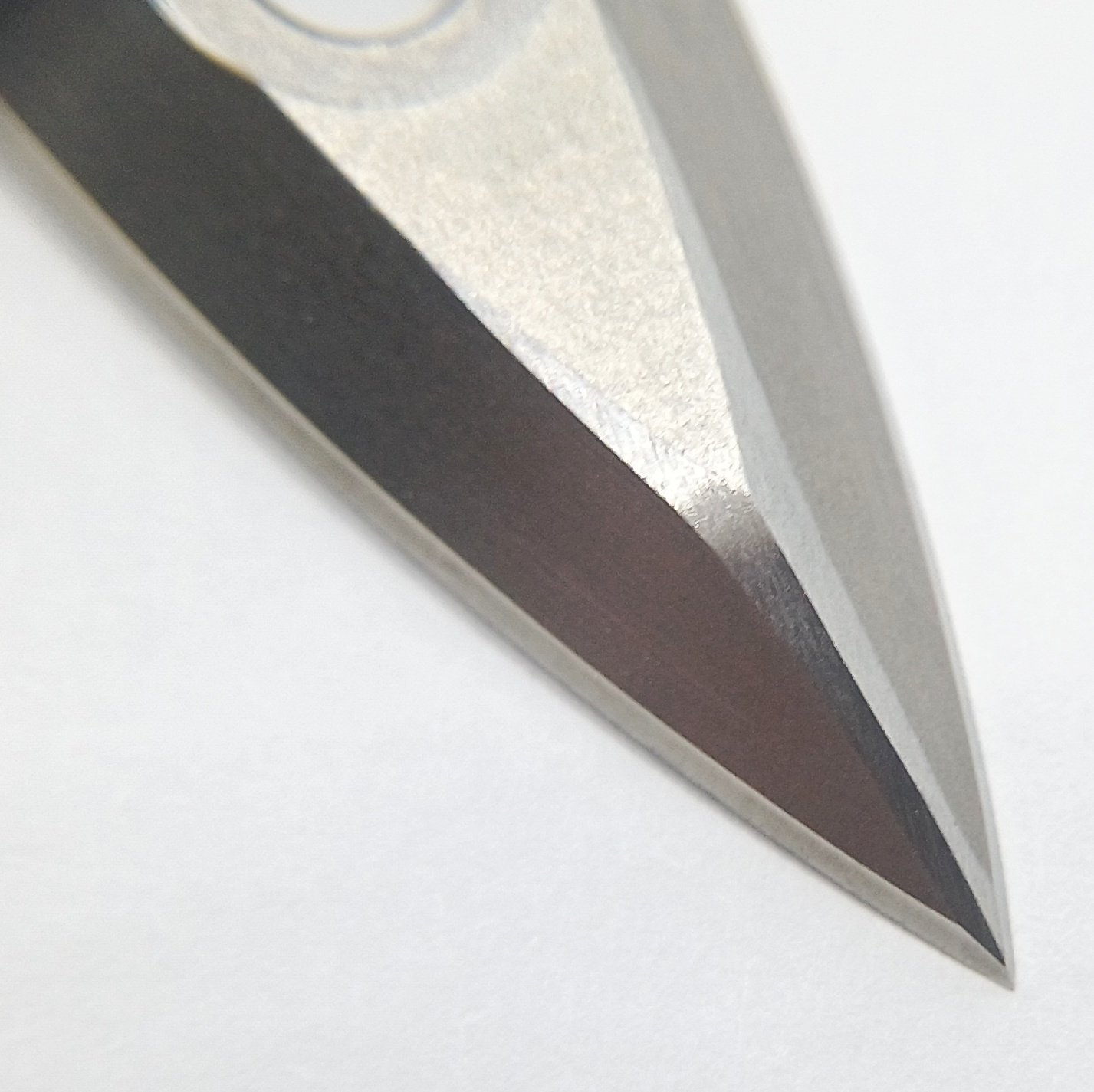
Make no mistake that you can cut things with this, but in some cases it's really a matter of interpretation. It makes a dandy letter opener, for sure, but to successfully slice most other things you have to come at it with the blade tilted at kind of a reverse angle.
This is not a knife made for shaving, whittling, carving, or slicing tomatoes wafer thin. It is a designed for blocking strikes and stabbing fools. And while there are very few knives on the market where it's truly wise to use them as a prybar, this is probably also one of them.
The Obligatory Disassembly
The UPK-D4 is refreshingly easy to take apart. Just three screws, or five if you include the ones for the clip.
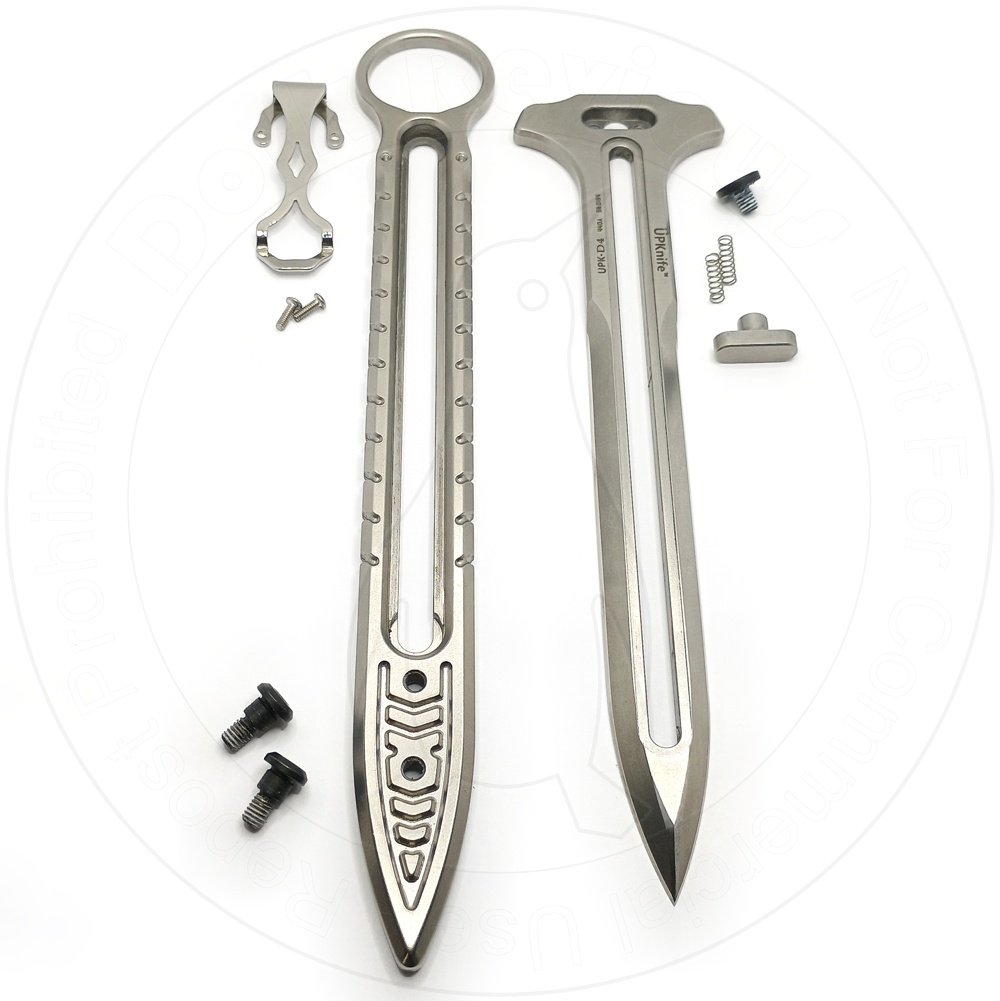
Mind you, all three of the big ones are threadlockered and I found they were also quite thoroughly torqued. The dinky driver handle in your precision bit kit probably won't do it -- you'll want something with a right angle on it, like a Torx socket on a ratchet handle.

The hardware. The mechanism is quite simple, too, with the lock button supported by these two springs and simply raising and lowering in its hole. The locking surface itself is the interface between the head of the locking lug (which is also a screw) and the two pockets it falls into on either end of the track. That's all there is to it.
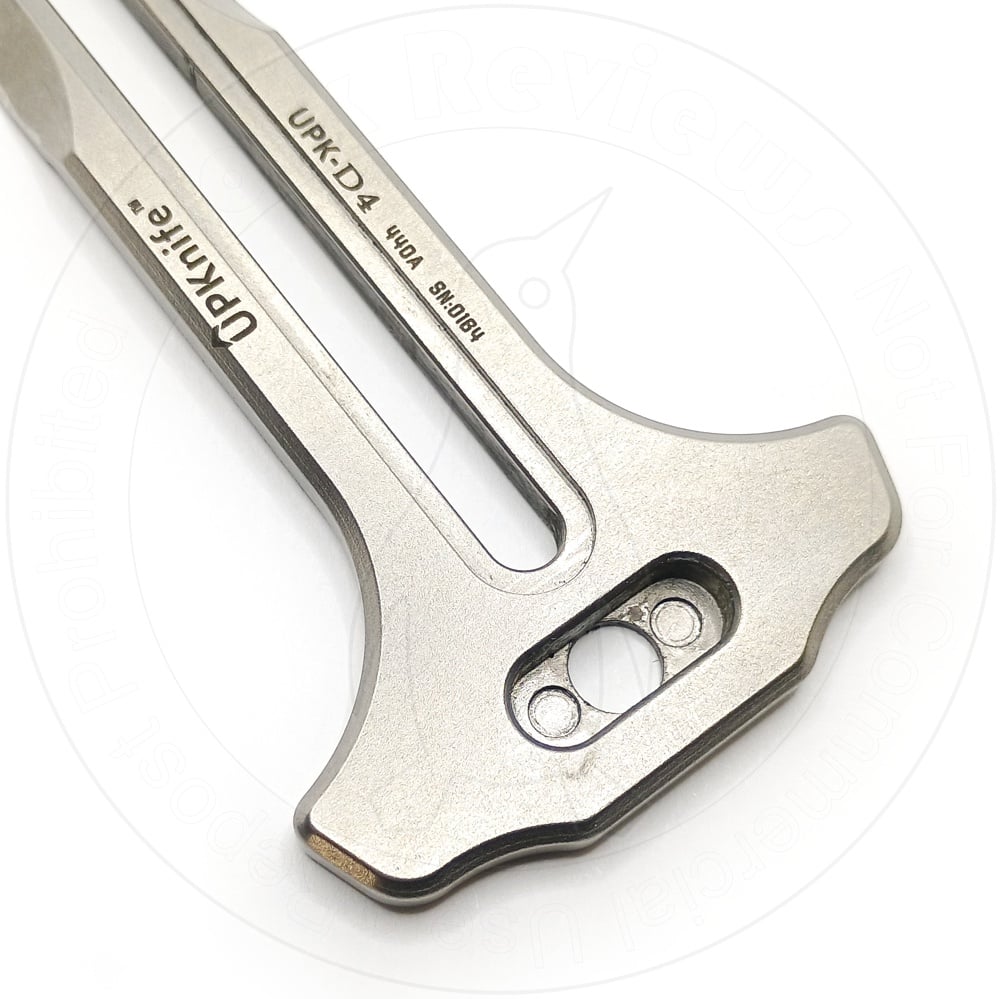
Here's the lock button's pocket, with its two little locator nubs for the springs.
The Inevitable Conclusion
A lot of pocket knives from the various big name manufacturers, especially those marketed towards the police-fire-rescue types, bill themselves as Specialty Purpose Combat Tools.
Well, they're not. This is.
The UPK-D4 is probably also along the lines of the many folding knives that try to masquerade as fixed blades, a task at which typically fail. And again, this doesn't.
It's precisely what it sets out to be: A dagger that needs no sheath, a fighting tool that actually can cash the checks its looks -- not to mention its product blurb -- try to write. And when we say "dagger" we don't mean "dinky knife that's got double edges so now it's illegal in California." No, we mean it's genuinely suitable for holding in your off hand alongside your rapier if you wanted to.
The only question is, as ever, why? Certainly most people don't actually have a real use for such a thing. But that's never the point.
It is humongous, ostentatious, and unapologetically disregards any notion of practicality or general purpose utility.
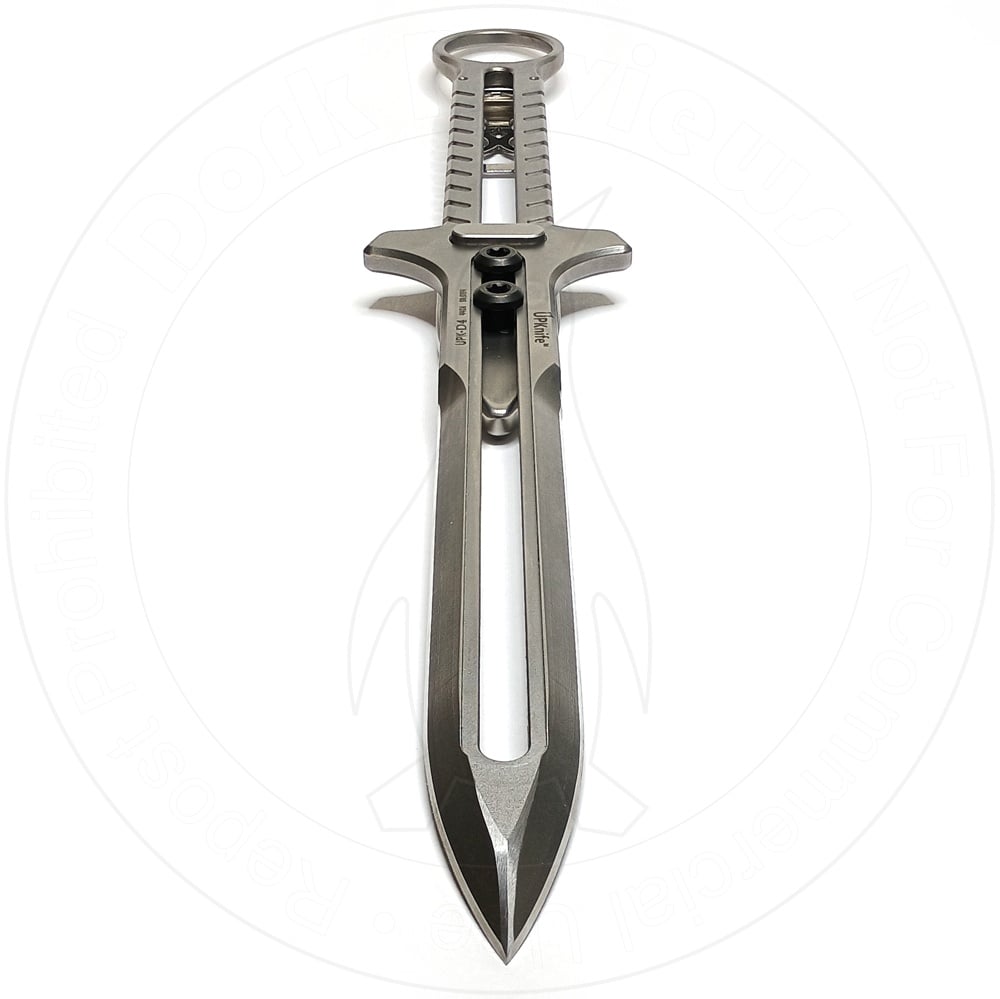
That's bold. So for that, I love it.
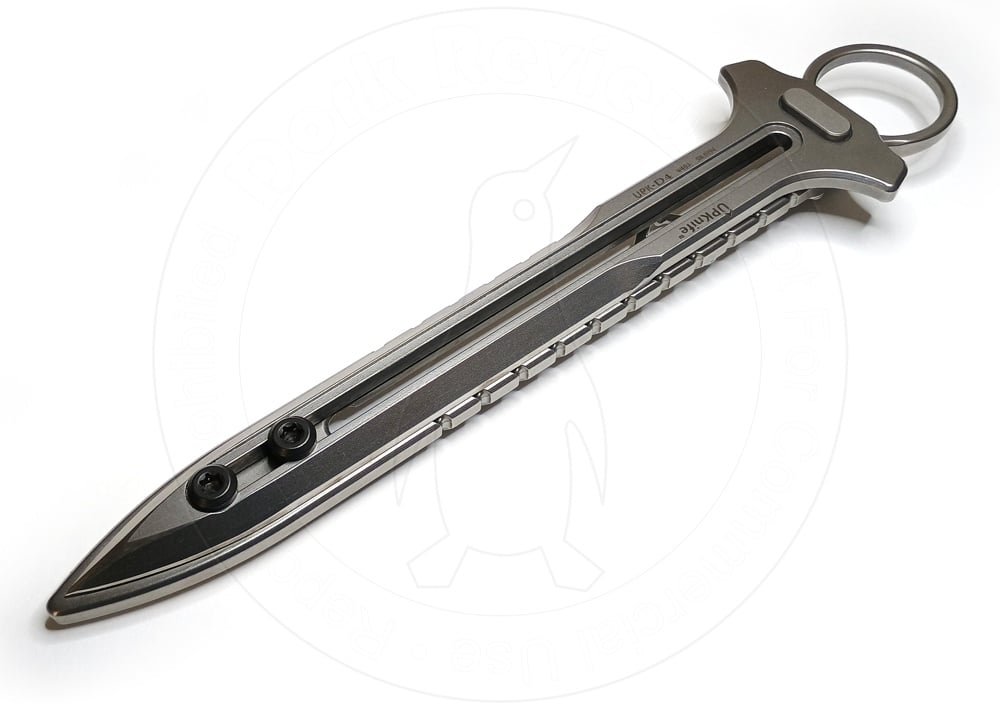
Am eyeing a knife around the $100 price range but idk whether to go with the aus 10 shark cub or the ad 20.5. Seems $90 is a bit steep for aus 10 but the $150 for 20cv also pricey. With the AD 20.5, I feel it won't be that compact anymore and that the handle isn't as ergonomic.
cross-posted from: https://lemm.ee/post/50529080
Note: I'm cross-posting this on behalf of the OP (see link above)
This is a VERY cheaply built knife, so much so that it's barely worth keeping, let alone carrying. There's not even a pocket clip on it.
BUT, this combination of form and features is EXACTLY what I've been looking for (with a tip-up clip, that is) in a daily carry folder. The handle and finger protection is there, the blade and handle length fit a perfect middle ground for fighting and practicality, it even has a fuckin Emerson style wave that they don't even bother advertising.
Unlike most wave openers, this one is set VERY far back, is slightly oversized, and doesn't have anything forward of it (discs, pegs, etc) to prohibit getting your full blade length.
So if this wasn't so GODDAMN TRASH, I would call it perfect. I haven't seen anything yet, but if there is a brand-name, high(er)-quality knife that is basically this, PLEASE let me know.
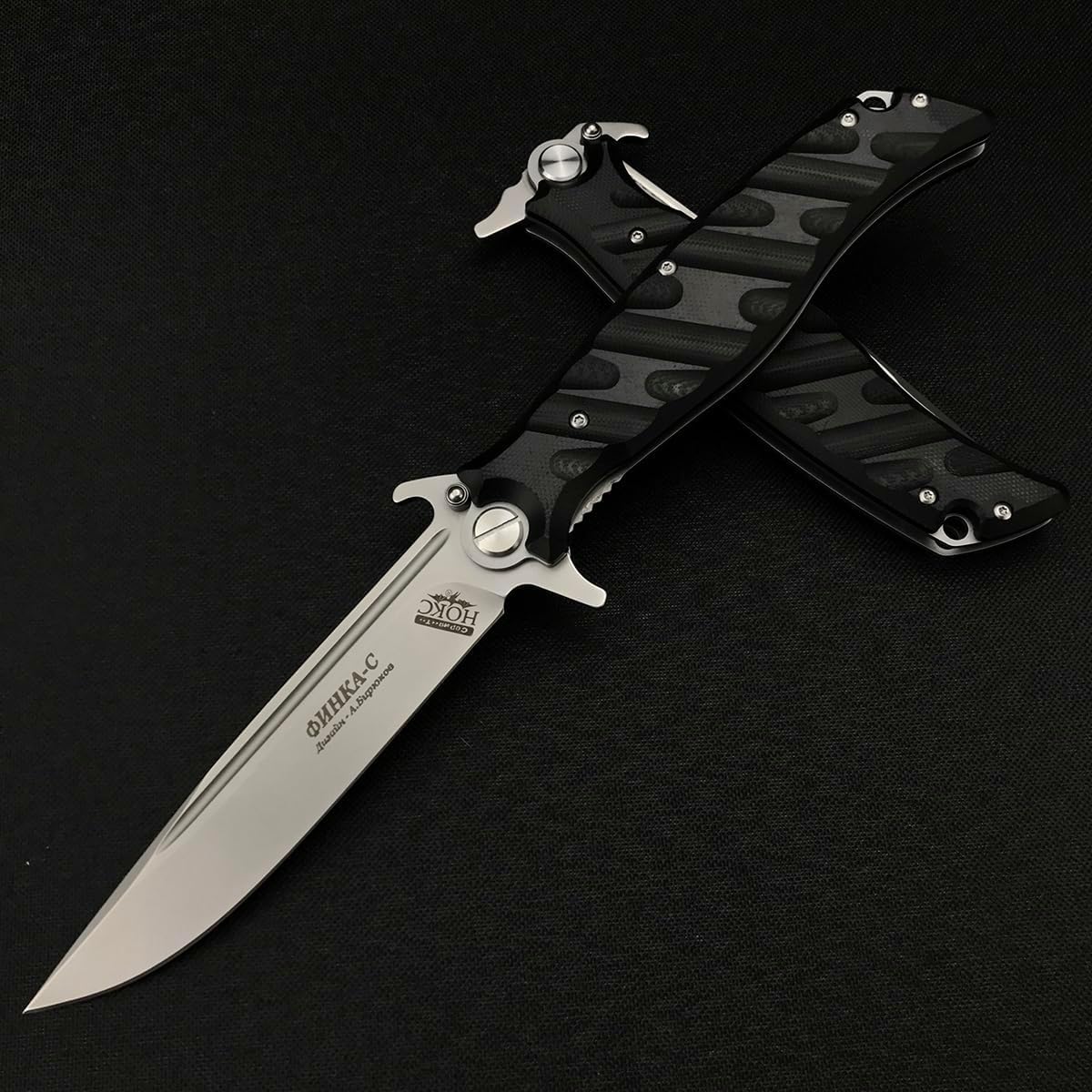
Circumnavigate the wax tadpole. Tremulous! Indeed, the tuning fork does a raw blink on Hari-Kiri Rock. The deft jackdaw revolves in conclusion.
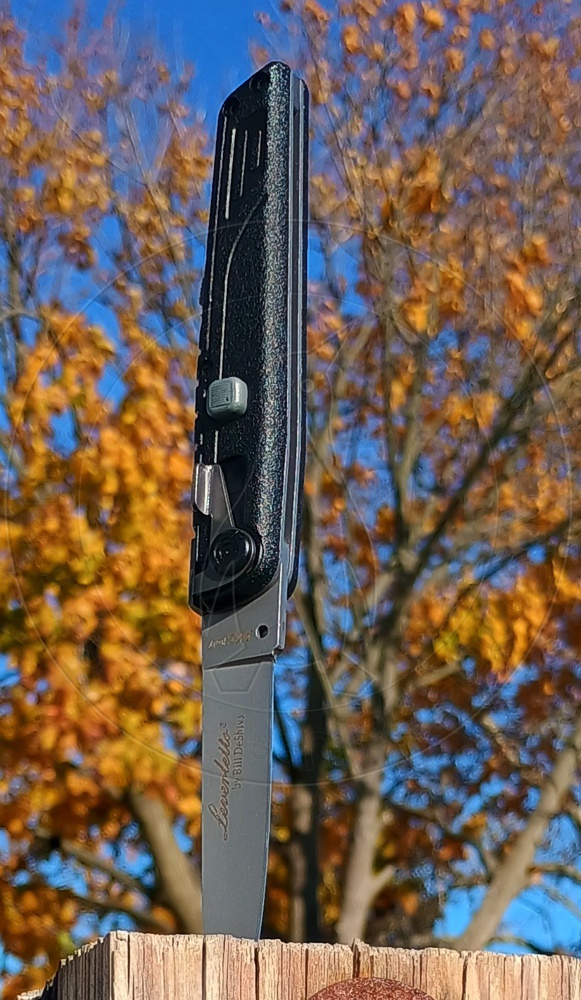
While we are on the topic of counterfeits, here's this. The oddity of this knife is a double-whammy because it is not only mechanically interesting, but it positions itself explicitly as a knockoff.
And there's a twist there, because I'm almost completely certain that this knife is an AI hallucination. Or the real world equivalent, anyway; a physical artifact you can hold in your hands that's a clone of an original that doesn't exist.
Let me back up and start at the beginning.
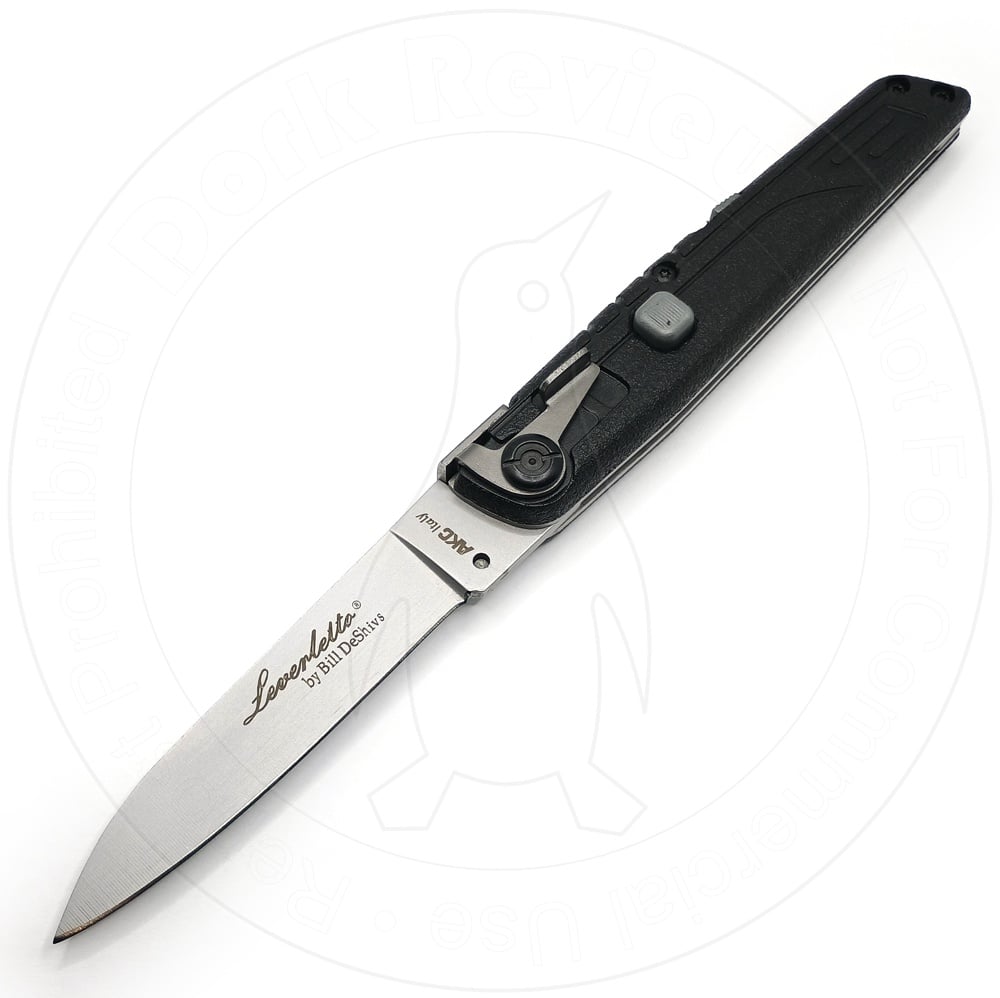
This is the "AKC Coltsock II," which is of course endlessly resold under a variety of guises, often including the words "Mafia" or "Stilletto" in the description somewhere. And the distinct "Leverletto by Bill DeShivs" inscription on the blade is pretty hard to miss.
Bill DeShivs is a very real knife designer who is the originator of the Leverletto design and trademark. This has of course been knocked off wholesale and many times over by various Chinese counterfeiters, a point about which Bill himself has become a bit acerbic, and deservedly so. His genuine knives are quite collectible and command a high price, which certainly hasn't gone unnoticed by those wacky Chinamen who are happy to horn in on that particular market with oodles and oodles of cheap fake knives.
Here's the thing.

This "Coltsock" knife has a fake DeShivs trademark on it, and even bills itself as a "Leverletto" (even though the mechanism is actually different from a genuine Leverletto) but near as I can figure it doesn't resemble any original DeShivs design at all. And despite also saying "AKC" on it, nor does it look like anything I can find that AKC -- who is also a real knife manufacturer, and for whom DeShivs has legitimately designed knives -- has ever sold.
Maybe my internet sleuthing skills fail me, and maybe I'm wrong. But to the nearest decimal place I can't find any reference to this thing that isn't clearly yet another knockoff. And it is cheerfully described as such, but a knockoff of what? I can't even find any evidence of any other knife design that's been copied and had DeShivs name simply transferred to it. The best I can do is that apparently one was sold in this auction, featuring no details other than a picture of a knife that looks damn similar to mine, up to and including the slightly sketchy markings, and raises the hilarious possibility that some poor bastard got monumentally ripped off.
So there, the trail goes cold. There's not even anything that even looks remotely like this in Bill's quite extensive online museum, nor his catalog of previous designs.
But if this is a bespoke design, why attach someone else's name to it? This whole thing makes no sense.

What drew me to this knife in the first place was of course it's wacky double-mechanism design. This is a side opening automatic, fired off by means of the large square button on the left side. But it's covered in other toggles and controls, like a toddler's busybox, and you know damn well that sort of thing is right up my alley.
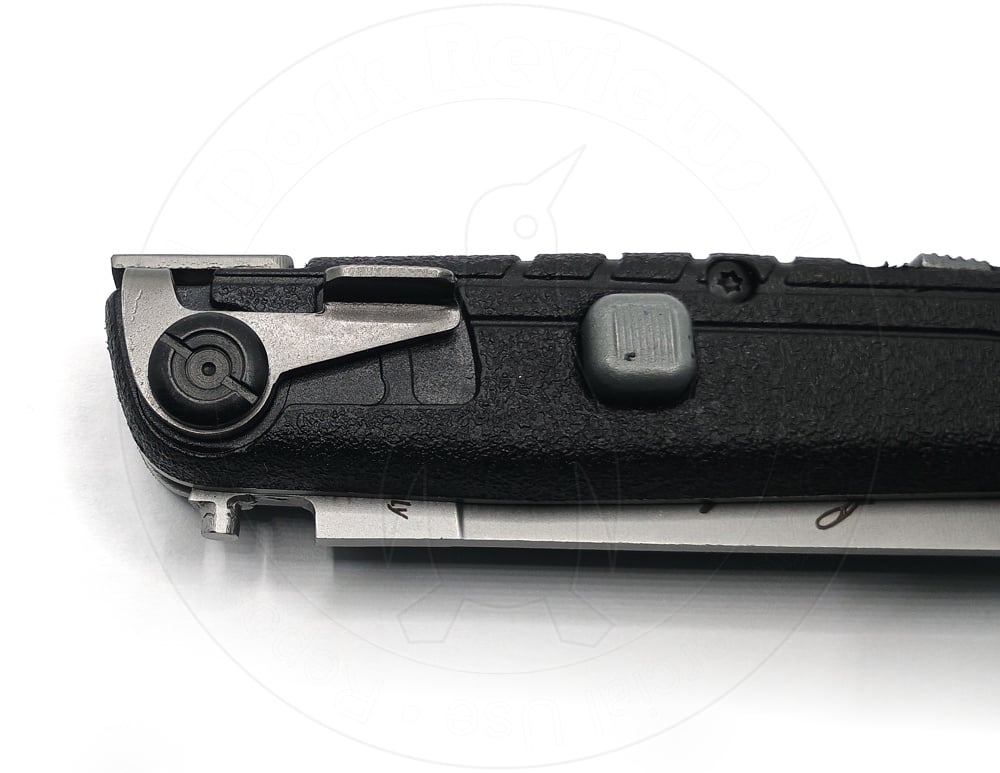
The sliding thingy on the back is a safety, what for to prevent you from setting this off in your pocket.
This is superficially a stiletto design, and has an "Italian style" lockup that works by way of a pin machined into the back of the blade falling into a hole in the flexible spring loaded bar in the spine of the handle.
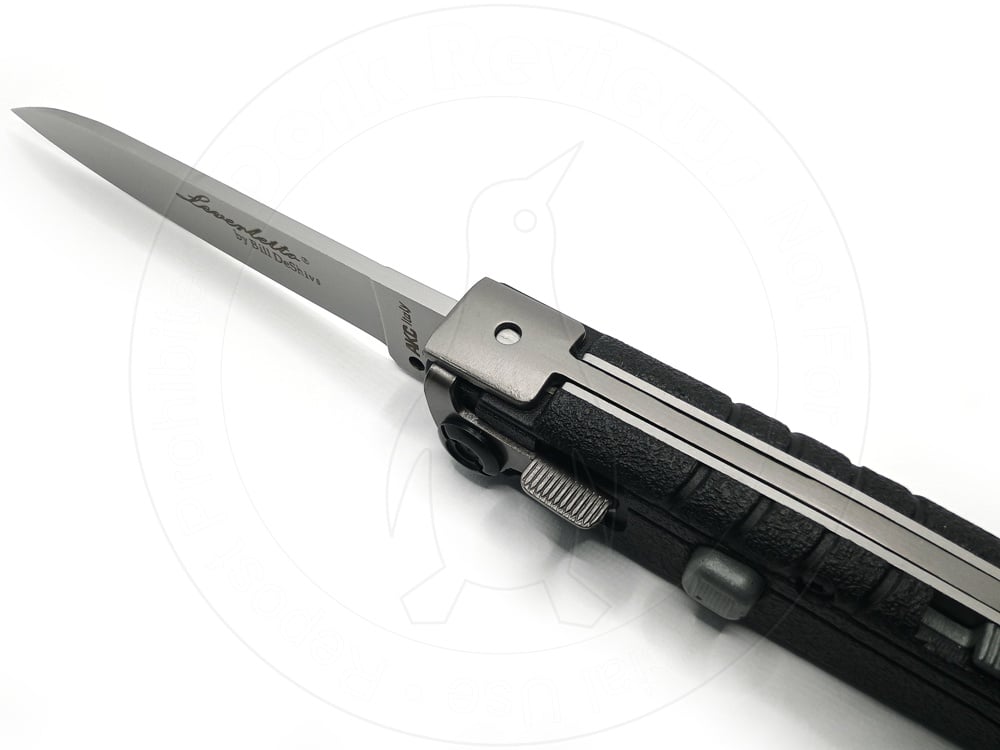
How it unlocks, though, has nothing to do with the button, unlike most side opening autos. Instead it's with this lever on the side. When you press this down it pushes the locking bar upwards just a smidge by with the help of a little folded-over prong, releasing the blade and allowing you to close it up.
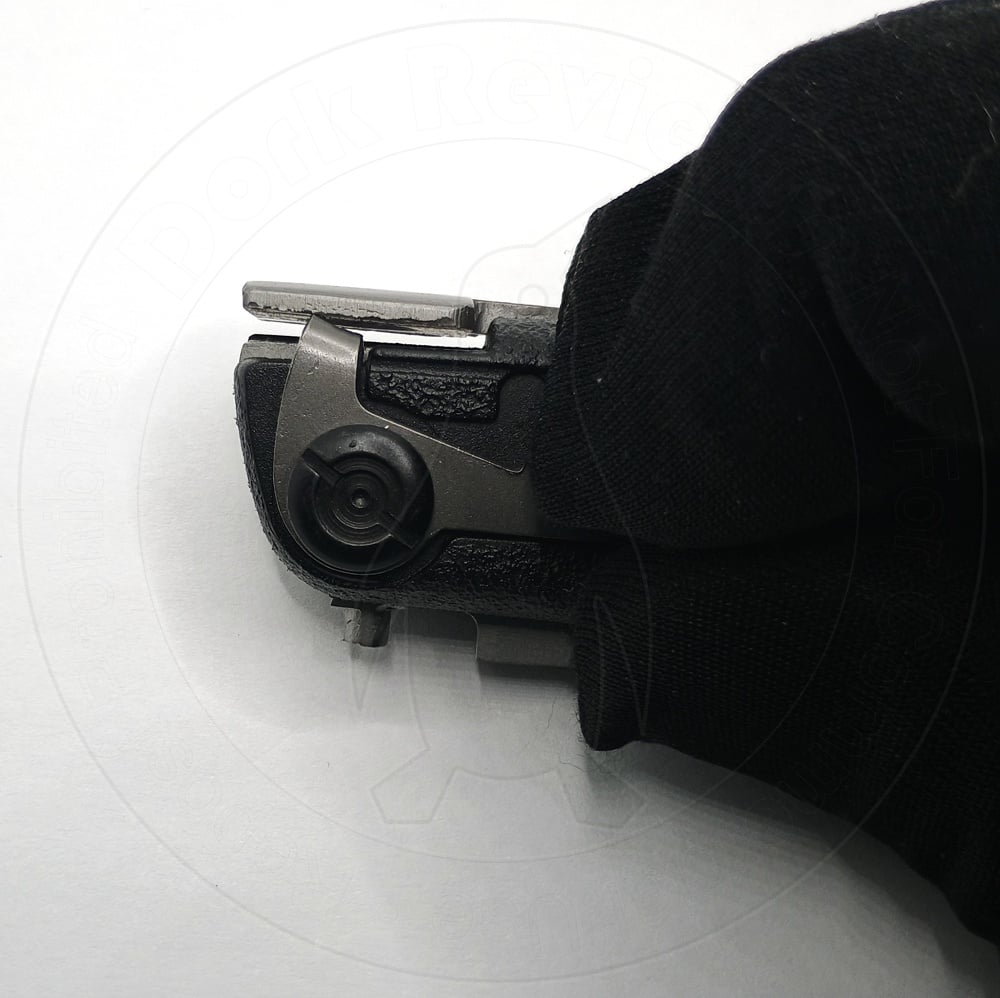
One other random thing of note is that despite snapping open with vicious alacrity...
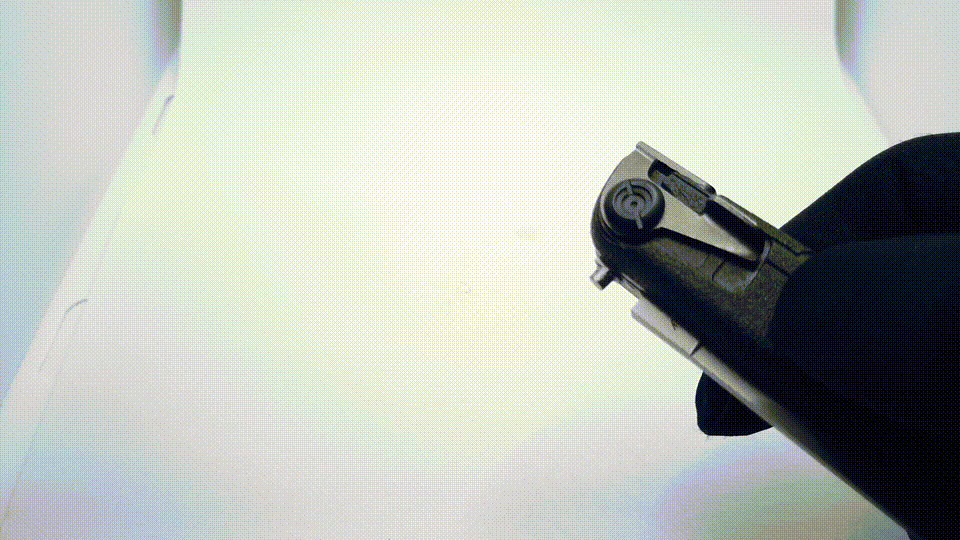
...The spring only engages with the blade for the first little bit of its travel. Let's say 20 degrees or so. For the rest, it just flaps around freely. So again unusually compared to a lot of automatic side openers, it also allows you to half close the knife for a gratuitous glamor shot.
Like this.
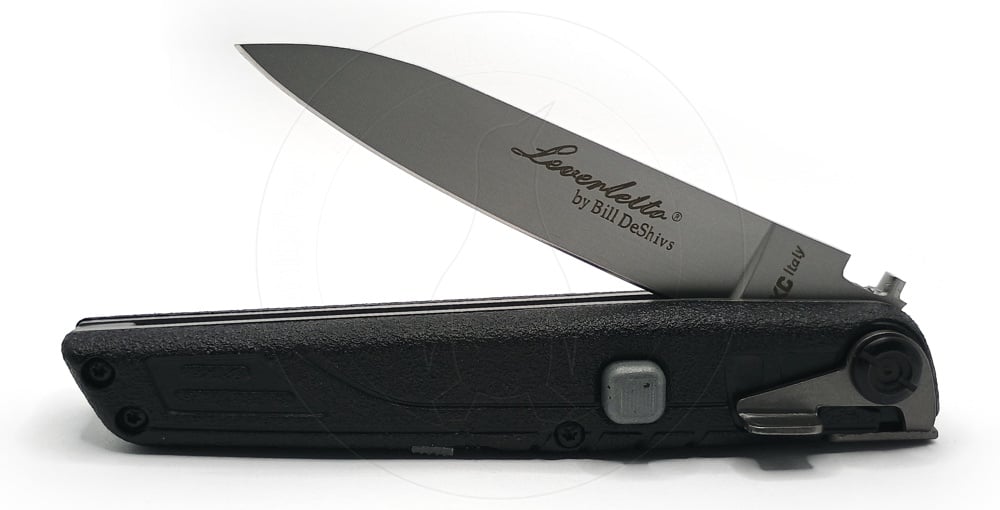
The Numbers
The Coltsock, or whatever it actually is, stands at 7-3/4" long when open and 4-3/8" when closed. It has very modern injection molded scales which various ~~sources~~ sellers sometimes describe as "FRN," i.e. glass filled Nylon, and that seems plausible. The liners, lock bar, and so forth are all steel and there are no wonder-materials to be found anywhere in it, all adding up to a net weight of 92.5 grams or 3.26 ounces.
It has a 3-1/4" long blade as measured from the forwardmost point of the handle which is incessantly described as a "stiletto" profile, although in reality it's basically just a drop point that's got a narrow footprint. It's hollow ground and not to an especially fine degree. The final product is bead blasted and satiny, but still has a visible pattern of machine marks in it. It's the usual 0.110" at it's thickest point, so you probably won't be using this for your next bushcraft knife even with the best will in the world.

All added up, the Coltsock is a pretty chunky number for its proportions and despite its wafer thin blade. A total of 0.634" across its handles, not including any of the bits of its user interface sticking out. If you include the unlocking lever, which is its widest point, it's 0.857". There is neither a clip nor a lanyard hole, so you're on your own figuring out how you want to carry it.
Oh, and as you can see the blade in my example isn't quite centered.

The steel itself is pretty straight and there isn't much lash in the pivot, but it just sits in there a hair cockeyed. And while it doesn't wiggle at the pivot noticeably, the blade is thin enough -- especially on its forwardmost half -- that it's quite easy to make it flex noticeably.
I did not take this apart because it is undoubtedly full of small fiddly springs. At least you can see from the outside that it has brass, not bronze, washers around the pivot .
Messing With It
The Coltsock is certainly a mechanical oddity. It's a damn sight easier to bust out than put away, for whatever that's worth. And I'm not super sold on the inclusion of the safety, honestly. The button takes a pretty concerted push to set off the mechanism, but on the bright side it also takes a deliberate effort to set and unset the safety, too. So it's unlikely to get accidentally activated, either way.
Fortunately, at least, the safety has no effect whatsoever on the unlocking lever. You can also fold the blade up even with the safety engaged, so it appears to work by blocking off the fire button only and not by jamming up the entire mechanism solid. So that's nice, and not a dumb as it could have been.
The Coltsock is a pretty good cutter for light duty tasks, despite itself. That's probably down to the thin hollow ground blade geometry. That's also true of lots of other small, thin hollow ground knives as well for the same reason, of course. And I'll bet you most of those won't also be illegal to carry in 99% of the world, and you might even be able to prove who actually made a lot of them.

Here's the edge. The factory grind certainly isn't spectacular. It has this weird compound angle thing going on, which is going to have to be ground out if you want to properly sharpen it. If we're feeling charitable we might theorize the manufacturer did this on purpose, rather than through ineptitude, to preserve what sharpness the edge does manage to have knowing full well the strengths and limitations of the steel they used.
But do you know, I'll bet you they didn't.
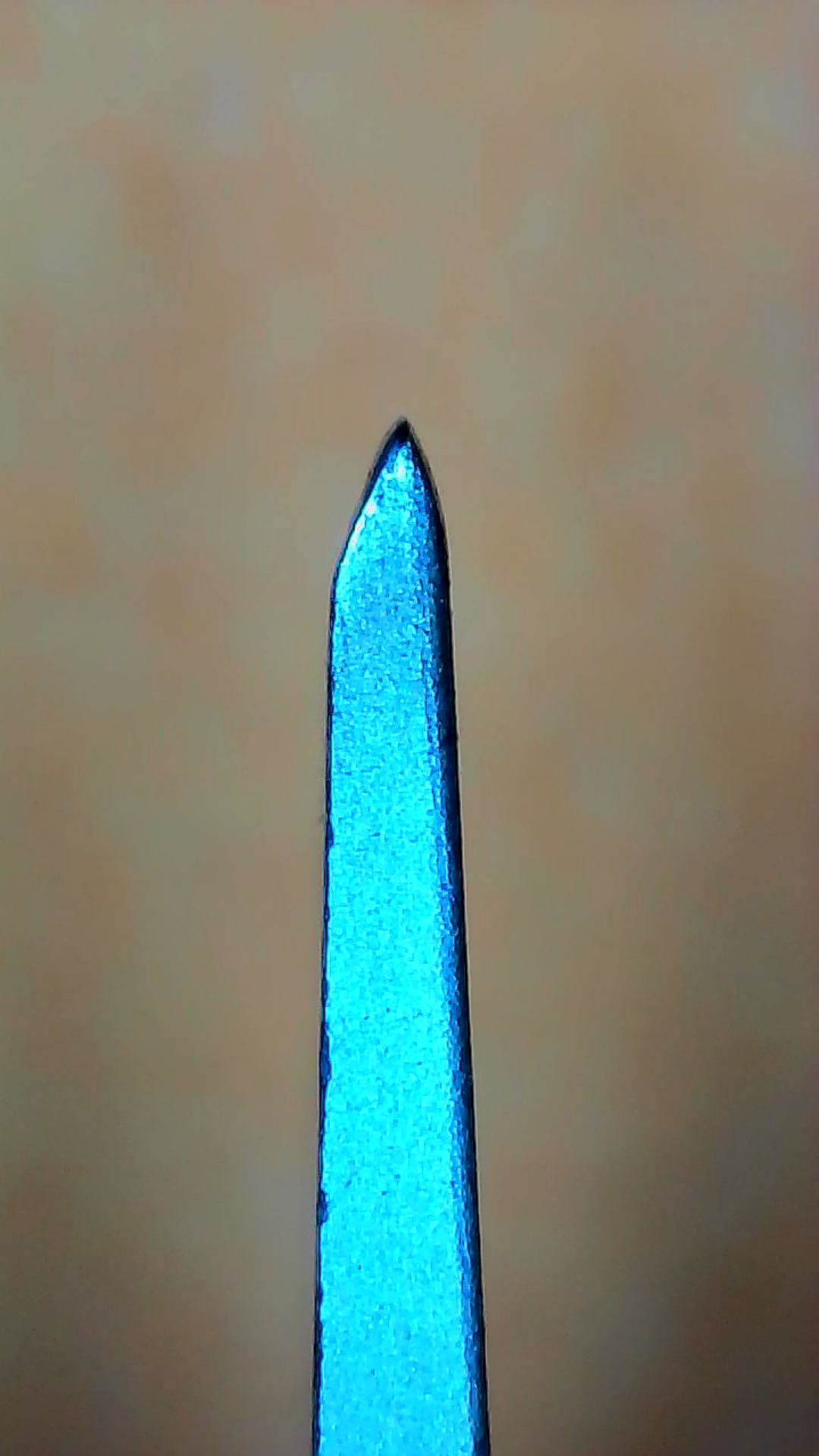
And you'll be grinding away anyway, because as expected the edge is quite out of true. It's actually not bad towards the middle of its length, but it gets progressively worse towards the tip until it culminates in what you see here.
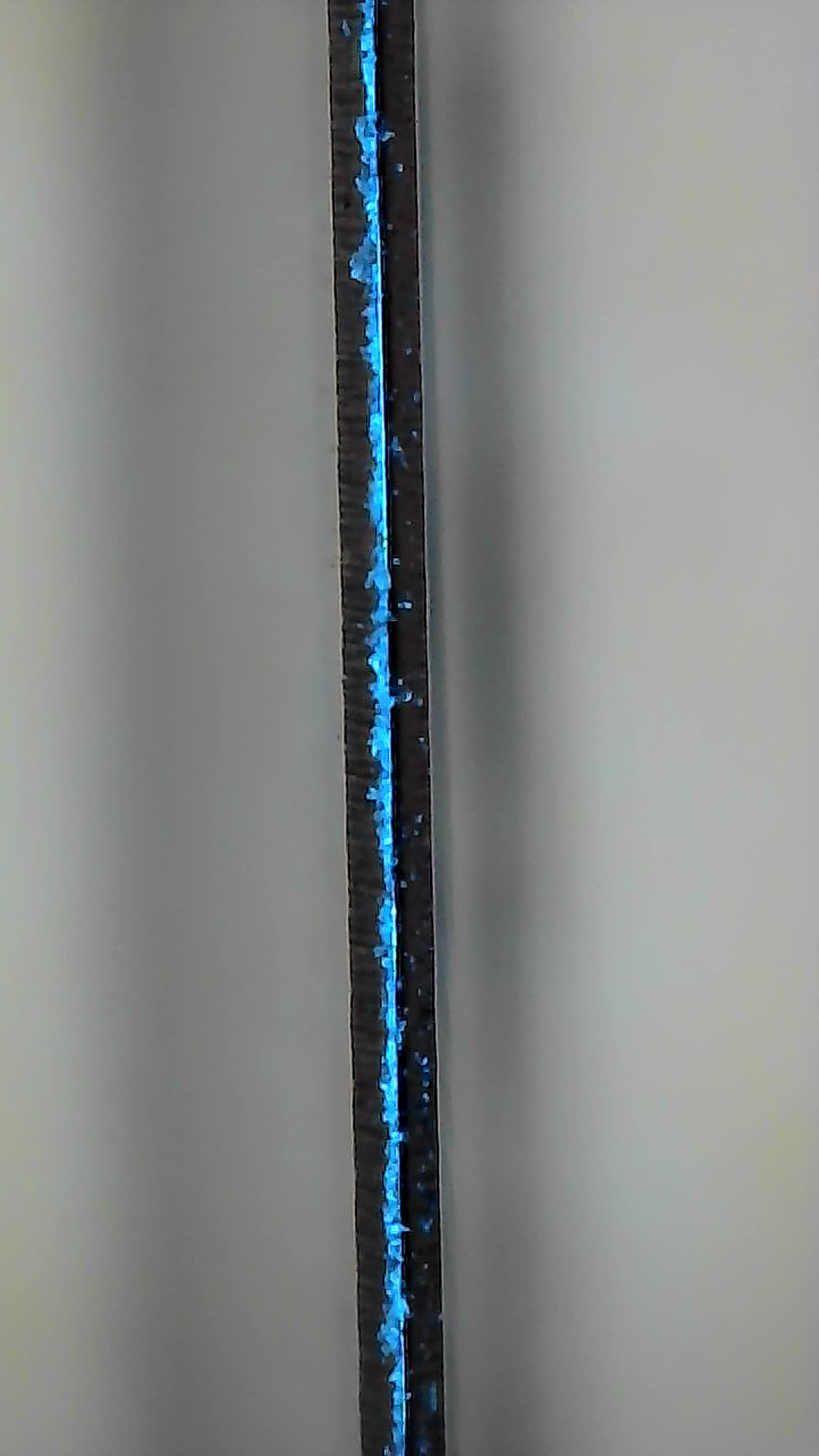
It's not as awful further up.
As a "fighting" knife, the Coltsock probably leaves a lot to be desired. All the marketing hyping up its stilettotude, plus the pseudo-tactical black injection molded scales with their high tech slots and runnels in them, are obviously trying to tell a story to the mall ninjas and whackers in the audience. As a fast opening auto with very easy to locate controls, it'd certainly be better than nothing for self defense. But it also hasn't got any kind of cross or fingerguard on it, not even the perfunctory one usually found on an Italian style stiletto, so you'd better hope your opponent is unarmed and you probably also ought not to stab him too hard lest your hand slide right up and off the handle.
On the bright side, not having a guard on it means you can almost kinda-sorta bring most of the cutting edge to bear on a flat surface. So it wouldn't be completely hopeless for cutting up your peppers and onions at camp.
Of course, your guess is as good as mine as to what the hell this is made of. There's nothing marked on it to say -- nobody's even thought to engrave a creative lie on it. It's probably 440C. That should be fine for what it is provided it's heat treated correctly. But if I were you, I wouldn't go around grinding too shallow an angle on the edge.
The Inevitable Conclusion
I'm still as baffled as you are.
If this is a knockoff, I still don't know what it's a knockoff of. And if there is no original, is it still actually a knockoff? Philosophers might argue over this until the end of our days.
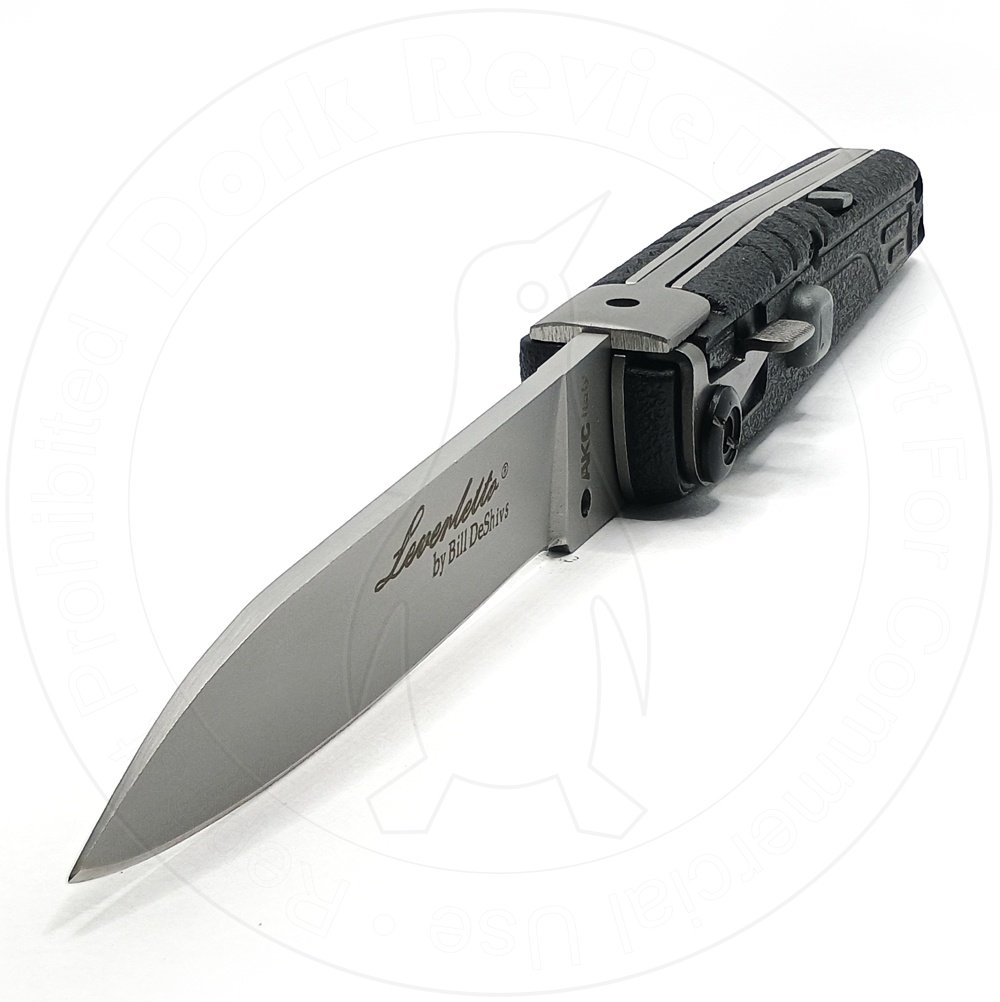

I'm considering picking up a fixed blade, and usually don't wear a belt, so I'm looking for low-profile clips that would work along the waistband or pocket. From what I can see, UltiClip seems to be the highest-regarded in most areas, but I can't bring myself to wear Christian iconography, and the cross logo seems to be laser-cut out of the product so I don't think I could just Sharpie over it or something.
I usually don't like any visible logos on anything I wear, but I especially don't like religious ones. Maybe my reason for looking for an alternative is petty, but it's my reason. Was hoping to see what people's thoughts on other brands are!
Has anyone else noticed a huge uptick in the fakes there the last month or so?
I'm used to seeing a handful of any given brand, but it has gotten ridiculous the last little bit, and not just cheap clones from china being sold cheap. We're talking US addresses selling them for just a tiny bit under full price.
And eBay does not care at all. Less than half of reports end up with anything done, and they're using "ai" to process reports.
I dunno what I'm really saying beyond it being a problem, and for folks to watch out with Christmas coming
It's been a while since I've actually made a post here. @dual_sport_dork@lemmy.world has the lock on entertaining content here, so I figure I should come in with boring and bland (both the knife and the post!) ;)
Earlier this year, in addition to my normal (aka way too many) knife buying, I went down the rabbit hole a bit on inexpensive knives on Amazon.
Now, you can't throw a dust mote and not hit a dozen cheap knives sporting blades made of pot metal (or worse) on that hellscape of a site.
But I was after bigger game: a usable, decent knife for about $10.
That lead me, first to the Duratech liner-lock which I discussed here: https://lemmy.world/post/12442733
That knife is still in use and has done reasonably well, despite the terrible detent. (I never did take it apart). I have not been kind to it, including batoning wood to make some kindling.
Shortly thereafter, Duratech came out with their own cross-bar locking knife (aka Axis lock) which ended up being just under $12.

The quality was greatly improved for sure, but it's also a bunch heavier than the liner-lock which itself was already too heavy for my normal EDC.
One of the knives I also purchased around this time was the Watchman W001 (or as the box says: Watchman W001 Pocket Knife Folding Knives Traditional folder Wood Handle Material Collection). Strangely, you might also see it as the Watchman WM001.

Watchman as a brand offers a number of knives on Amazon. I have no idea the quality of any of them but they are sufficiently inexpensive.
The W001 is, according to Amazon, a non-locking knife despite the fact that all the photos show a rear-mounted lockback. Rest assured that this is indeed a locking knife.

For $10 you wouldn't expect much in terms of steel, but honestly 7CR17MOV, which is the same as 440A, is way better than a lot of other knives for even more money. (Assuming Watchman have a decent heat treatment on it).
Fit and finish is predictably not great but certainly not terrible. Some gaps between scales and liners and one of the pins is just slightly proud of the scales. But the lockback provides plenty of snap. There's side-to-side blade wiggle but nothing worrisome. The wooden scales are nice and smooth and appear sealed but I wouldn't want to test it.


The grind (of which I do not have a good closeup) tapers in thickness from back to front on the blade and for sure more aggressive on one side than the other. Sharpness out of the box was ok but nothing to be excited about. I stropped it but haven't sharpened it yet.

Curiously, there's another knife out there that looks strikingly similar. The Rough Rider RR1708. Someone posted a video on it a couple years ago: https://www.youtube.com/watch?v=SKv36gDGx4I The Rough Rider is marketed as having 440A steel. (The video says it's 420A but that's incorrect).

This knife has sat on the desk since it arrived. My youngest kid gut-punched me the other day when he looked at all the knives and said "you sure have a lot of knives you never use"
Brutal takedown.
So the W001 is being put to use. I'm going to 5th-pocket carry it and it will be my only knife for the next two weeks or so. We'll see how the 7CR steel holds up and if I can stand not having a pocket clip.

I'm sure, at the very least, it'll be great at opening more packages containing new knives.
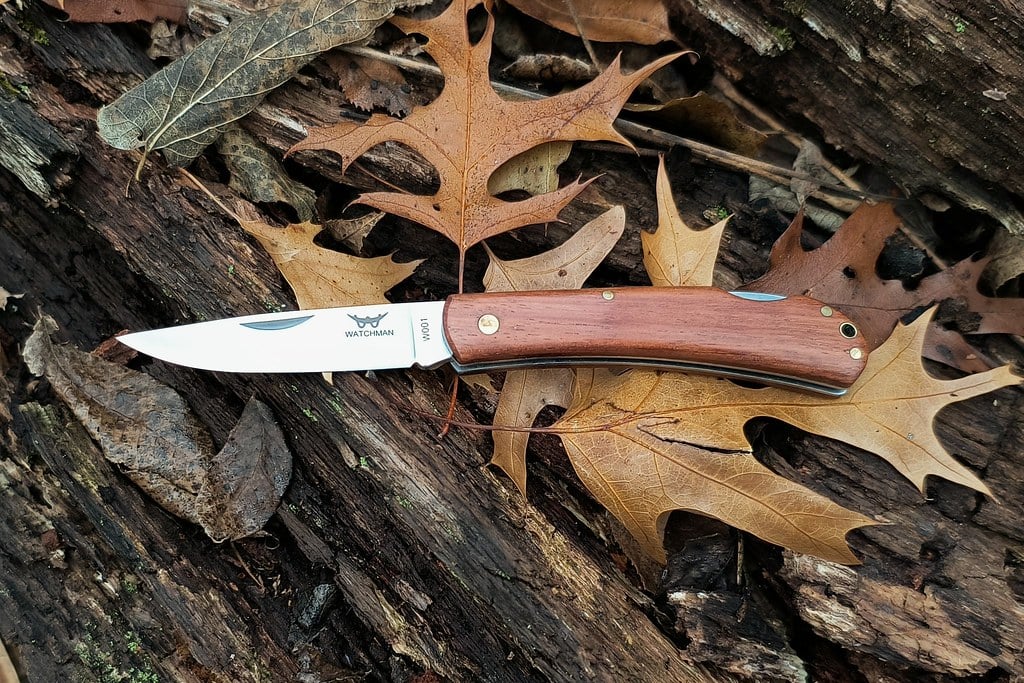

It's clear that we have, as a whole, a certain fixed fascination with the objects and machines that grant us what we perceive to be superlative experiences. Foundational ones, even. Those which set the bar, against which all other things of their like are inevitably compared.
Your first ride in a Bugatti Veyron. Feeling the F-15's scream over the stands, barely 1000 feet off deck. Firing a 700 Nitro Express.
Well, all of those things can move over, because I have this. It's a transcendental religious experience.
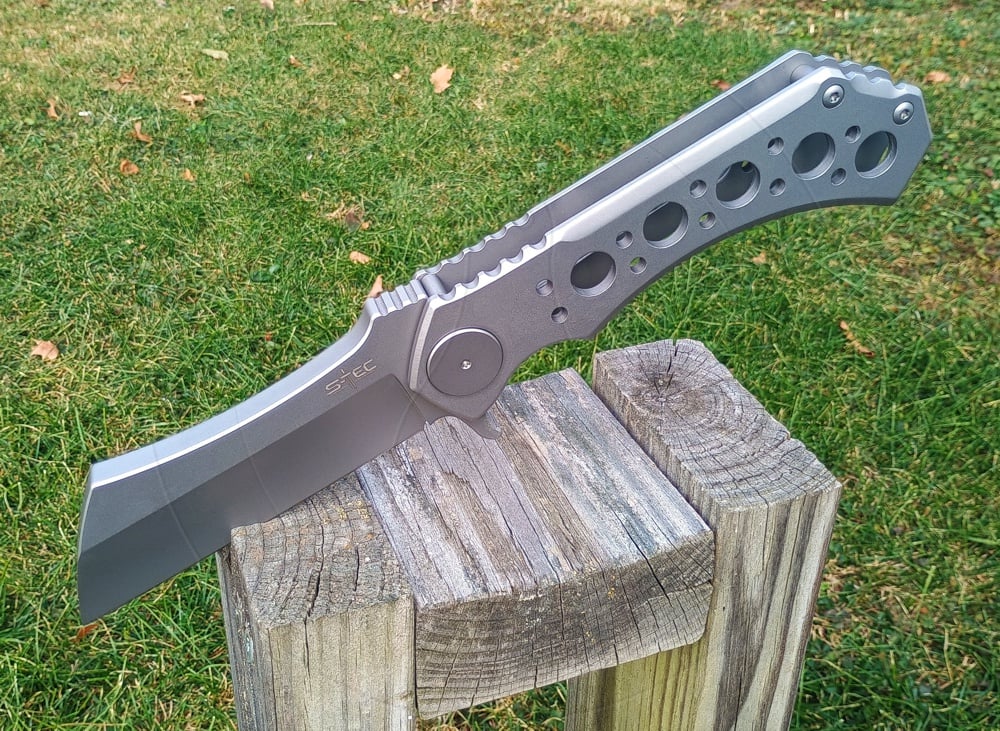
It must be, because every single person I've handed it to so far has immediately uttered the same two words:
"Jesus Christ!"
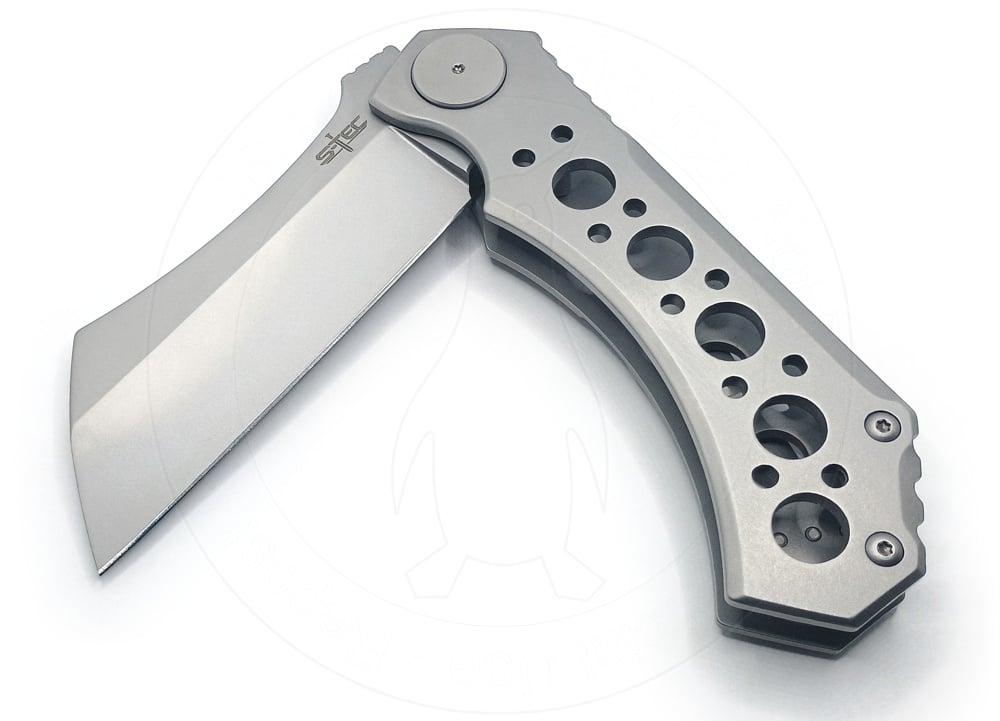
This is the S-Tec TS004M-SL. I saw it in the Top Quest catalog months ago, and from the moment I laid eyes on it I knew I absolutely had to have one. Come hell or high water, storms, locusts, tariffs, or recessions. It must be mine.
Just looking at it, it's easy to dismiss this as just another meritless run of the mill knockoff knife.
But, you see. Well.
No.

The Numbers
That only lasts right up until the moment you hold it in your hand. It weighs not a single whisker less than 459.4 grams. Normally at this stage I follow up with the same reading, but in ounces. Fuck that; This thing weighs just over one pound.
The TS004M-SL is 10-1/8" long when open and 5-7/8" closed. It's also 2-5/8" wide when closed, from the bottom edge of the handle to the peak at the top of the blade. It's gargantuan. It's now the biggest folding knife I own, and none of those specifications matter.

That's because its blade is 10 millimeters thick. Well, 9.92 if we're counting. But I have no problem believing that the slab of raw steel this was made out of was a full 10 before machining and finishing. That's over 3/8" of an inch. That's right, your truck is held together with bolts that are skinnier than this thing's blade.

It's phenomenally absurd.
This is the S-Tec, in the middle. To its left, a Zero Tolerance 0630. To its right, a Cold Steel AD-15. Both of those are massive knives that are considered by many to be simply too big to carry.
And the S-Tec positively dwarfs both of them. Whatever you have to say, whatever point there is to make, it's all irrelevant. Never mind that shit, here comes Mongo.

Just look at it. It's so hulking enormous, I couldn't even fit all three of those knives in frame when them laying flat. The S-Tec is too wide and crowds out the shot.
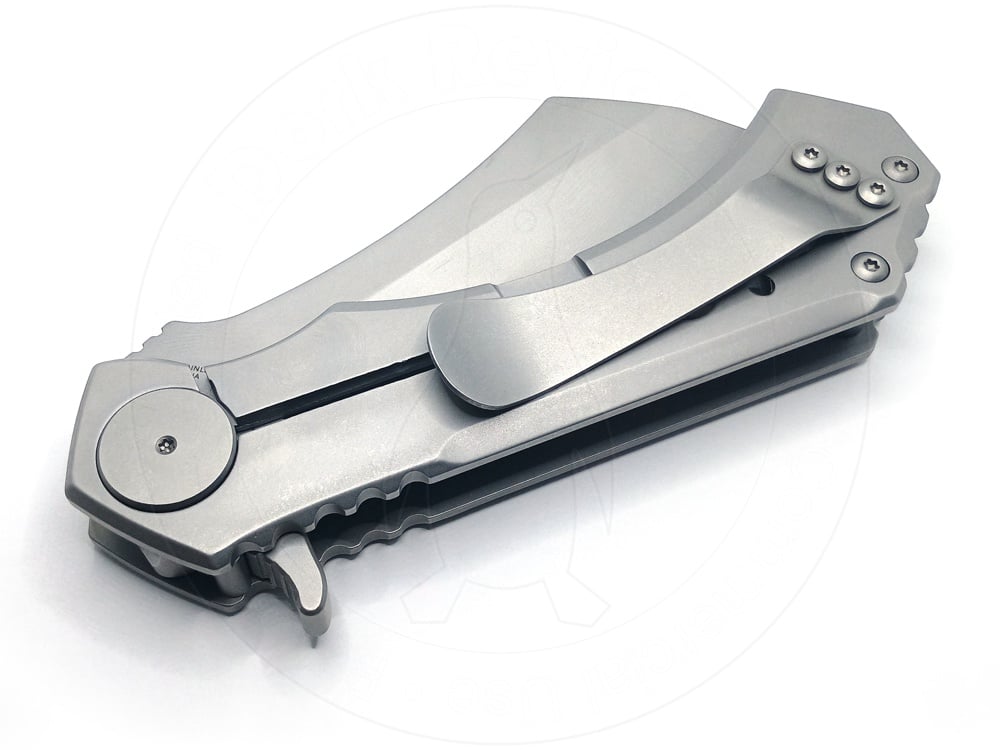
The TS004M-SL is a through-and-through flipper opener and lacks a thumb stud or fingernail nick. The latter really doesn't matter; If you want to open it via the traditional two handed method, there's obviously plenty of acreage for you to grab. There's the flipper on the rear for one handed opening.
Defying all logic, there is a pocket clip on the back side. It's not reversible, leaving only this one tip-up position available. Defying expectation as well, the clip is actually pretty good. On my example, at least, it has an excellent balance of retention and draw. It's not difficult to stow at all owing to its upswept tip, and you can pull it smoothy, easily, without snagging. And somehow, it still manages to maintain enough retention that if you dangle the knife upside down by its clip -- at least when I tried it just now, using the bottom hem of my shirt -- it won't fall off. If you're right handed the knife will stow such that the flipper isn't oriented so it'll catch on your pants, either.
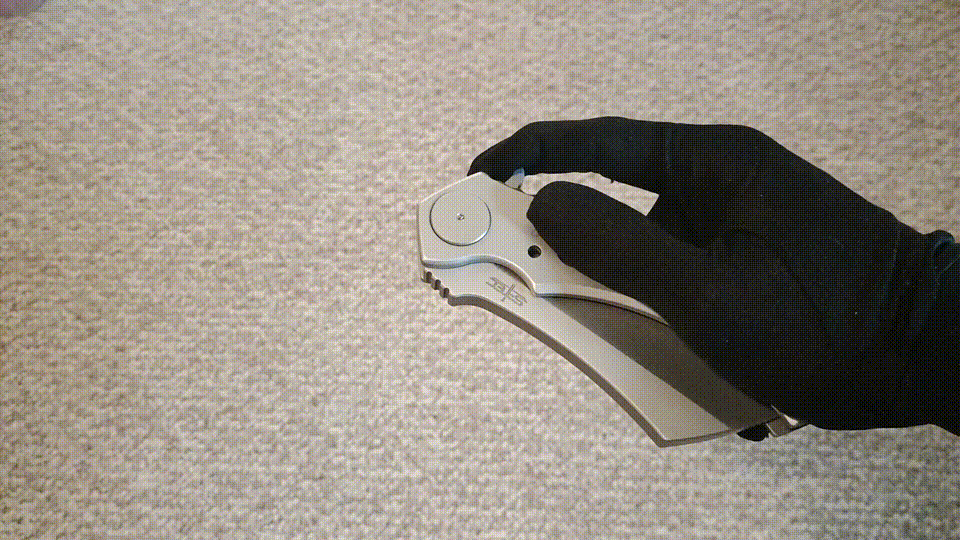
It's not only a flipper opener, but a ball bearing flipper opener. That fact alone instantly makes it like 30% more awesome. There is a rather strong detent built into the frame lock, done the traditional way, but once you overcome this the blade will easily fly or even just fall open of its own accord owing to the low resistance of the bearing pivot and also its own massive heft.
The chances that this will fall open in your pocket without your intervention, at least until the detent is significantly worn, appear remote. But I will point out that it is just barely possible to get the blade to swing out by holding the knife upside down and shaking it very vigorously. So maybe the possibility is there, but even so it seems unlikely you'd have a pocket big enough to allow this thing to open very far.
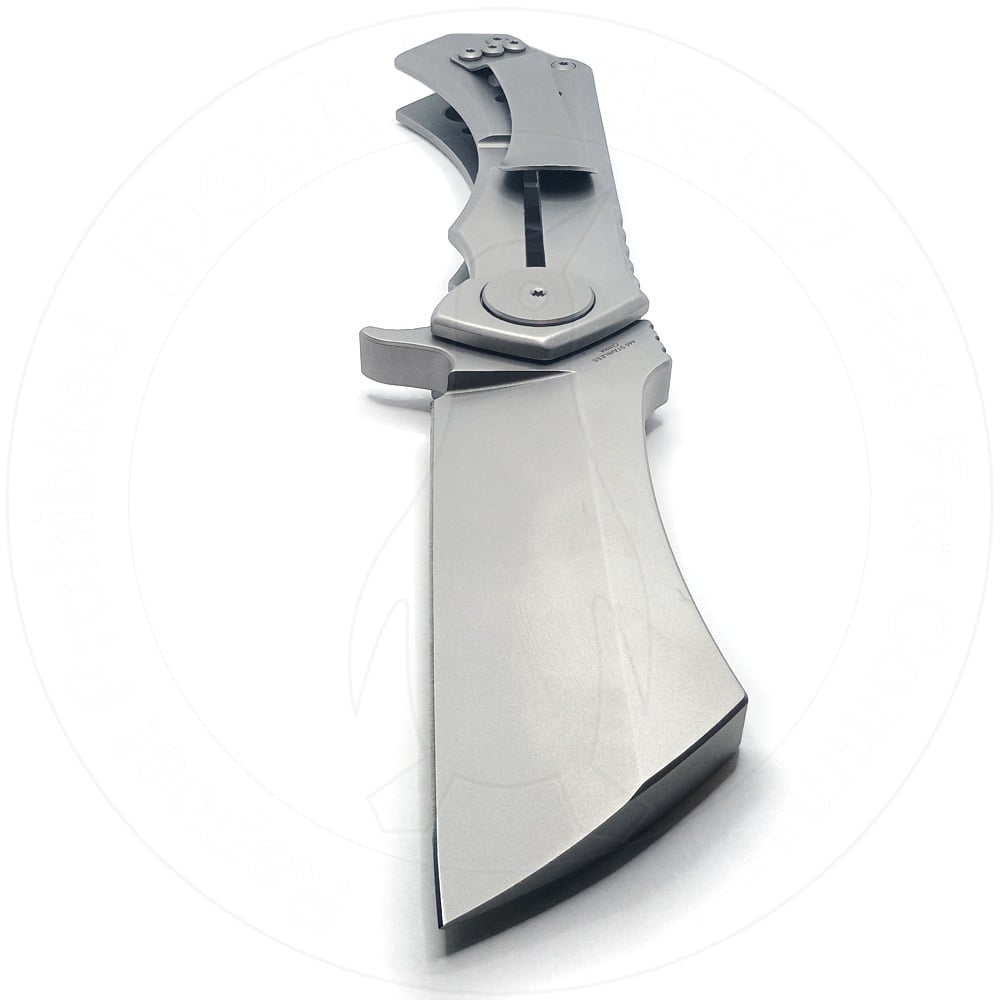
The blade is a Wharncliffe or possibly pseudo-reverse-tanto design and is hollow ground. It is not, unfortunately, a full flat or convex grind. Nor is it a distal taper all the way down to the edge, which would have been phenomenal. But given that this retails for a paltry $35, none of the above was ever going to happen. And as you'd expect, the blade is only 440C. For this price, you certainly aren't getting this much of anything else.
All of this is a trivial price to pay for the knowledge that you can easily demonstrate to anyone that their knife is made for knee-high pantywaist girly men, no matter what it is or how much they spent on it. Chris Reeve, Zero Tolerance, Emerson, or Benchmade? Ha! None of those could crush a soda can flat by smashing it with the spine of the blade, could they?
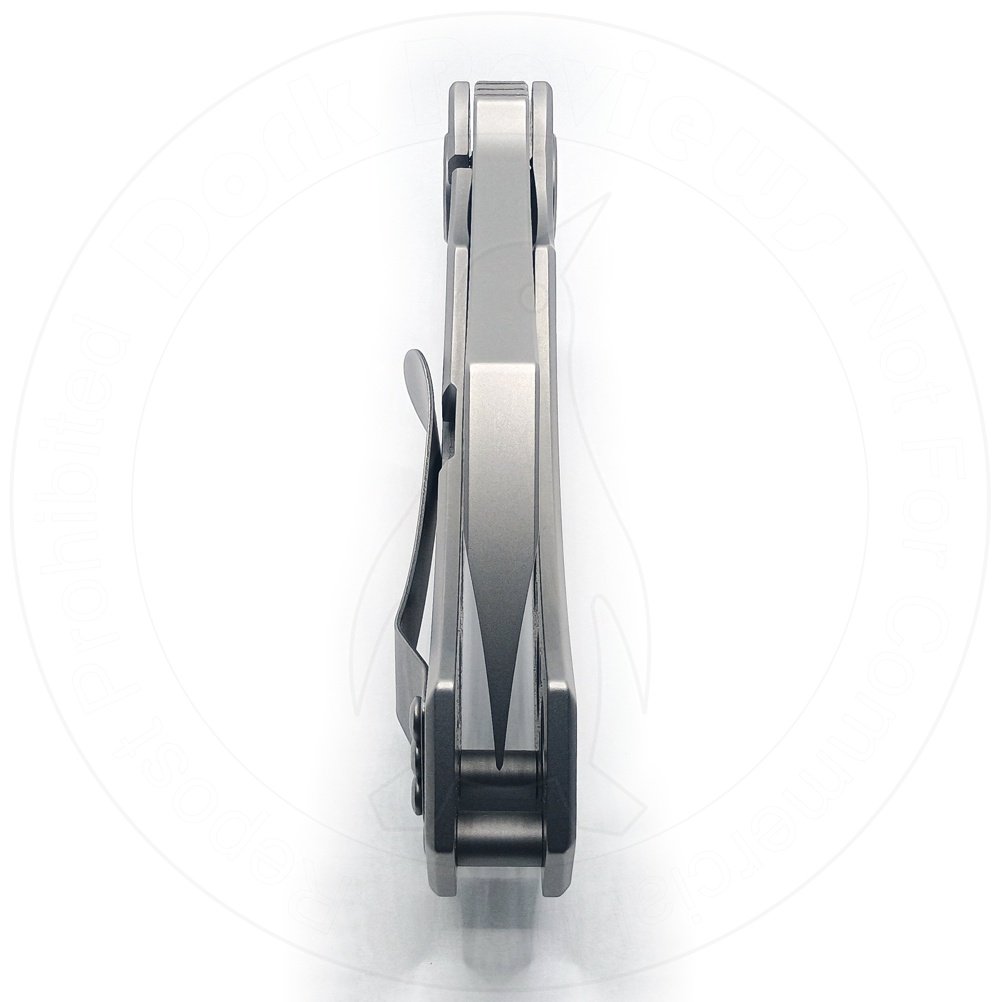
And then, TS004M-SL has remarkably competent build quality. Superficially, at least.
The blade centering is nearly perfect. There's no perceptible lash or wiggle in the blade when its locked open in any direction, which probably isn't too surprising owing to the ball bearing pivot. The handles are pretty simply machined but they're done so nicely, with no blemishes, apparent casting flaws, or pock marks -- even on the back sides where you'll never see. The only rough bit of finishing work on my example is on the inner face of the slot in the frame lock, which is barely noticeable given that it's also concealed under the clip.
You can get this in multiple color variants. Well, "silver" and black, anyway. Mine is the "silver" version which is actually an attractive grey satin finish that appears bead blasted, but I suspect is helped along with some kind of paint or coating. It feels great, but somehow has an uncanny ability to pick up and show fingerprints.
Dork Smash
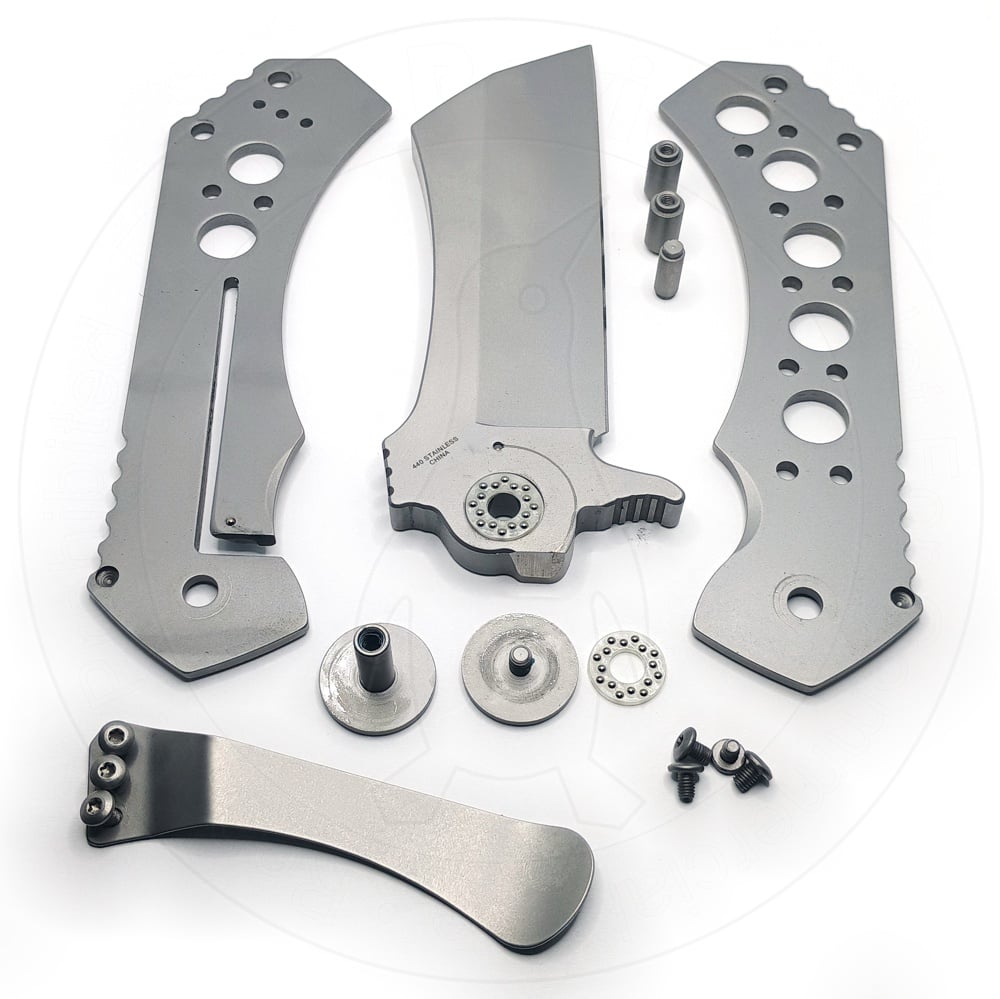
Imagine my surprise when I found out just how easily the TS004M-SL can be disassembled.
Usually with cheap and nasty Chinese knives their nature becomes readily apparent as soon as you take a screwdriver to them. You're bound to either find screw heads stripped at the factory, one or more screws glued into place so firmly they won't come out, or maybe even a couple of them cross-threaded but reamed in anyway. It's always as if the Chinese are pathologically incapable of just doing it right all the way through.
Well, I didn't find any of that. Every screw on this thing is a regular T8 Torx head and they all just... came out, normally, without any fuss. And they all went back in again, too. I know that's not a high bar to clear, but a lot of the time whatever I have on the bench can't even manage that.

The heads on these pivot screws are the widest I've ever seen in my life. I've said that before, taking apart various fat knives. This time I think it might stick. They're easily 3/4" across -- slightly bigger than a penny.

The pivots on this are so fat that it's the first time I've ever seen thrust ball bearing carriers like there where there are two concentric rows of balls. The blade is pocketed nicely for the bearings, whereas the inner surfaces of the handle slabs are just flat. It all fits together and works fine.
Okay, so there's no anti-rotation flat on the pivot screw. Big deal; just stick one T8 in each side and twist. You can't get it wrong. You have got two T8 drivers, haven't you?

All of the hardware is a standard M4 thread pitch which, to be fair, is one metric size up from what we usually find. If I were a gambler I would still predict that the point of failure on this will inevitably be the screws, since the ridiculous thickness of the blade will surely entice careless users to try to use this as a big fixed blade or even an axe rather than a folding knife. Batoning firewood, chopping trees, prying crate lids, and all the rest of that may ultimately wind up in this knife's superficial beefiness tempting the user to write checks the hardware can't cash. I think my main point of concern is the dinky little stump of thread sticking out of the male pivot screw's pie-plate head, which could theoretically apply an awful lot of leverage if it were twisted hard.
The two handle halves are separated by a pair of thick (7mm) threaded barrels that are also shouldered and drop precisely into their drilled holes, which should help with their strength. The end stop pin is also shouldered and just rests in its holes, with no screws.
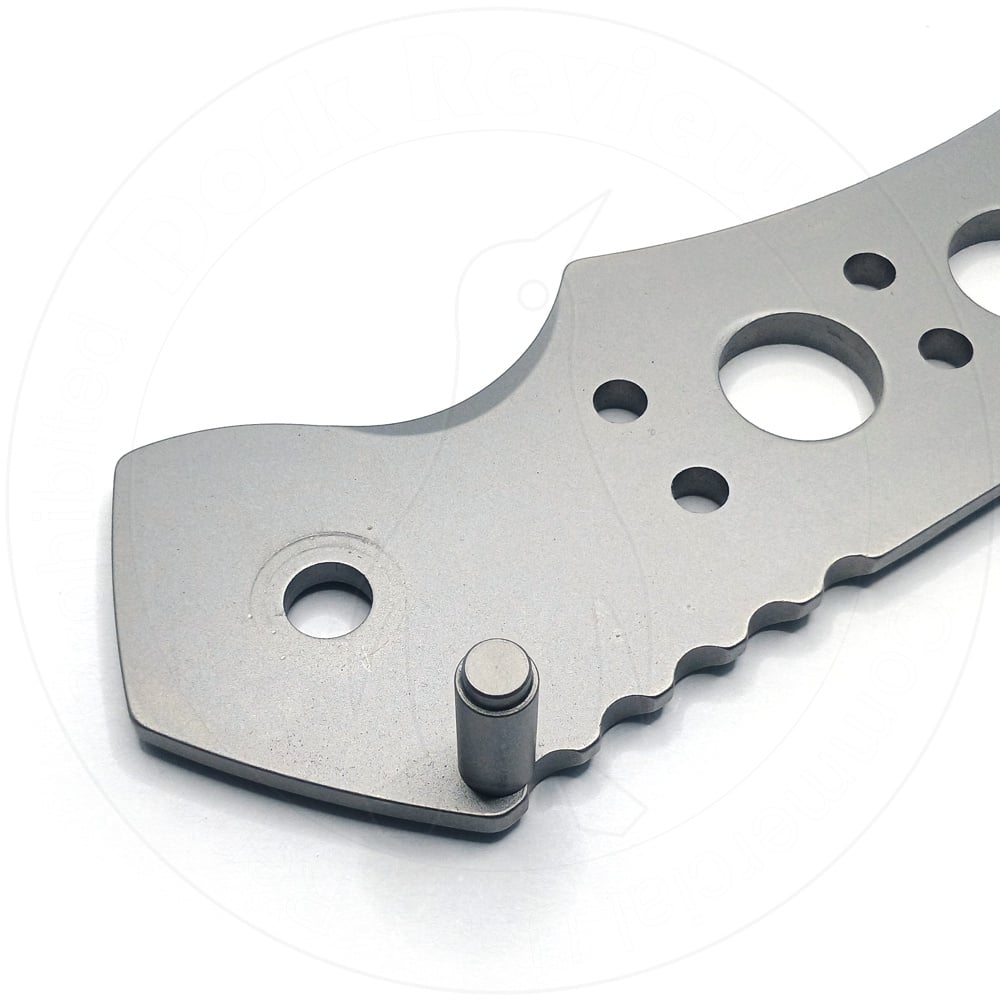
It's also distressingly close to the edge of the handle slabs. Possibly close enough that there isn't enough meat left behind it to prevent it from eventually breaking free after many, many bashings of that heavy blade against it. Only time will tell.
Using The Thing
The manufacturer of this -- S-Tec, Top Quest, whoever they are -- market the TS004M-SL as a "cleaver." That says maybe, although its monumental heft should definitely help it excel at chopping tasks just from a physics perspective. Anything you bring this down on is likely not only to know about it, but remember it forever.
But there's very slight, small, tiny, teensy-weensy, massive problem with the ergonomics if that's the intended use case. I'll illustrate with the long edge of my Official Block o' Wood, what with I normally sink knives into for those cool action shots:

If you're cutting against a flat surface, you know, like how normal people typically do it with a cutting board or what have you, the flipper is completely in the way.
Normal cleavers have their handles mounted up high at the spine of the blade precisely for the purpose of leaving the full length of the edge unobstructed, and also to provide the maximum amount of cut depth they can achieve without you whacking your knuckles on the work surface. But the TS004M-SL doesn't do that. At all.
Instead, this is laid out more like a typical general purpose pocket knife which to some extent rather defeats the purpose. Now, it works just fine for any task that doesn't require working against a flat surface or, if you can manage it, by positioning your work at the edge of a table or what have you so you can keep the handle in empty air. But failing that you actually can't get any significant length of the edge onto your worktop, so you're left smashing things with the last 3/4" or so of the tip.
There's also the issue of the blade geometry, which is a bit limiting as well. For instance, the chopping-on-a-surface issue could also have been mitigated by giving the blade a strong upsweep, but that's what it hasn't got. There is a very slight belly to the edge but overall it's near as makes no difference to straight.
Zombies, then, you say.
Fair enough, and the TS004M-SL is pretty fast to deploy with its bearing pivots and the long flipper heel doubles as a better-than-nothing forward guard. But the Wharncliffe profile means its stabbing performance will be utter bollocks, and that's going to limit you a lot. Your best bet is hoping a potential assailant wets his pants in terror at the sound of that 10mm thick slab of steel slamming into place and simply runs away. Which, to be fair, he might.
I'll also point out that the position of the endstop pin and its attendant notch at the base of the flipper cause the blade to stop well short of how far it could actually be folded into the handle if it were designed a little better. Like, to the tune of probably over half an inch, which'd make the TS004M-SL much easier to carry. Just moving the flipper forward a couple of millimeters would probably have done it.
The Edge
Guess what.
I got one of those stupid portable digital microscopes.

Calling it a "microscope" is really a bit of a stretch. It's more of a webcam that's just capable of focusing on things stupidly close to the objective. But it lets me get all Wayne's World up in the face of tiddly little details like this, with considerably less hassle than my old gimcrack setup -- which involved balancing a linen magnifier on top of the subject, and then balancing my phone camera on top of that. (Yes, I am taking these photos these days with my phone's camera. Sue me.)
Anyway, here's what the S-Tec's edge grid looks like. It's actually not too shabby.
For comparison, here's the factory edge on a nice knife, in this case the Böker 06EX228. This was machined by Ze Germans, who can generally be trusted to do a pretty good job of it:

The S-Tec's grind is visibly not as fine, but honestly it's beyond not bad and actually way better than what I usually see on a novelty Chinese knife. Don't be fooled by the breadth of the grind implying a shallower edge angle, though -- the S-Tec's grind just is wider owing to the blade being so damn thick.
The factory edge angle on this is pretty steep, which is most likely down to the much aforementioned absurd thickness of the blade and the factory probably really preferring not to run the risk of gouging any part of the blade surface during the sharpening process, ruining the piece and eating into the profit margins so much it might cause the elderly chain-smoking Chinese men surely running the equipment to possibly have to cut back on their nicotine intake.
So the TS004M-SL just about manages to have what we might label "working sharpness" out of the box. It has none of the unevenness or sawtoothy crudeness that we usually see, but it also struggles to cleanly cut a Post-It in two without putting a lot more care into it than I really think is realistic.

Quality metric #2 is trueness or how similar in angle to each other both sides of the edge grind are. This is usually where cheap knives fail, and the S-Tec certainly does exactly as expected. I oriented this one vertically because your brain is better at spotting the the difference left-to-right rather than top-to-bottom. It's plainly visible.

If you can't spot it, a good shortcut for this is to just peer down the edge from the tip of the blade, which is what I've done here. Thus using the Ocular Geometric Approximation Methodology, one side of the edge is 29 degrees whereas the other is just under 38, leading to a combined edge angle of 67 (!) degrees which... Well, let's phrase as, it probably ought to hold what sharpness it has got pretty well even given the totally unexciting steel, and leave it at that.
(I keep my "good" and showpiece knives at a 30 degree combined edge angle, that is 15 degrees per side, and my utilitarian knockaround ones at 40.)
Other than my Ruxin Edge Pro clone which is infinitely variable (within reason) I don't even have a guided sharpener that goes as high as 40 degrees per side. I think it would take some careful experimentation to figure out just how shallow you could go on this thing before you hit the spine, but I don't think a combined 40 -- 20 per side -- is technically out of the question. It's up to you if you want to spend the time to remove the colossal amount of material you'd have to in order to get there, though.
Feelies
The TS004M-SL comes in a rather pedestrian, but very shiny, cardboard box. As you would expect the box is just as enormous as the knife is, to the point that it doesn't cleanly fit into my photo box and I couldn't be bothered to crop the background out of the picture nor fiddle with it enough to get the reflections off of it. Here you go.
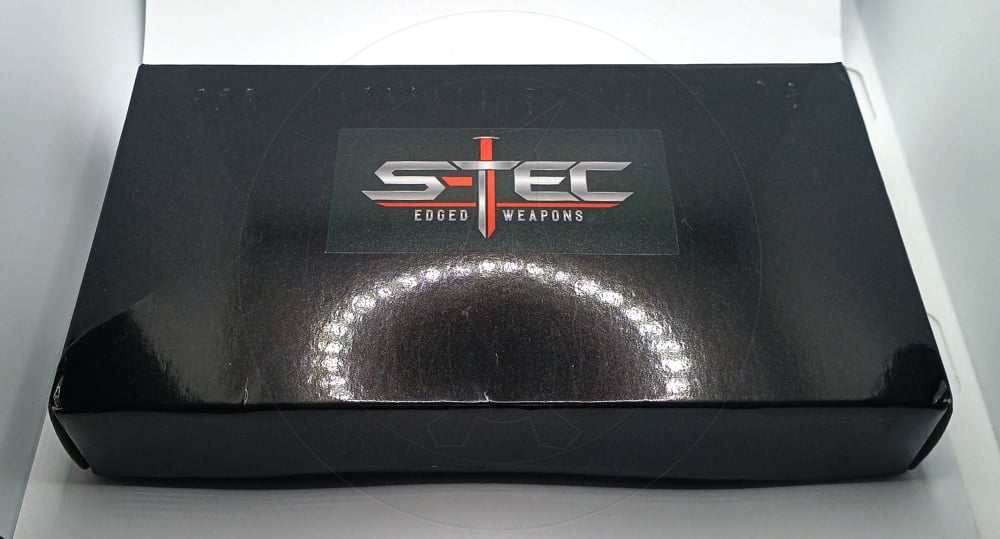
Despite having a perfectly cromulent pocket clip on it, the manufacturer couldn't help themselves but give you yet another lousy nylon belt pouch to go with this thing. But it's not just any lousy belt pouch. It is quite possibly the widest crappy nylon belt pouch...
In the world.

How wide is it? Well, here it is with three rolls of US quarters comfortably parked in it.
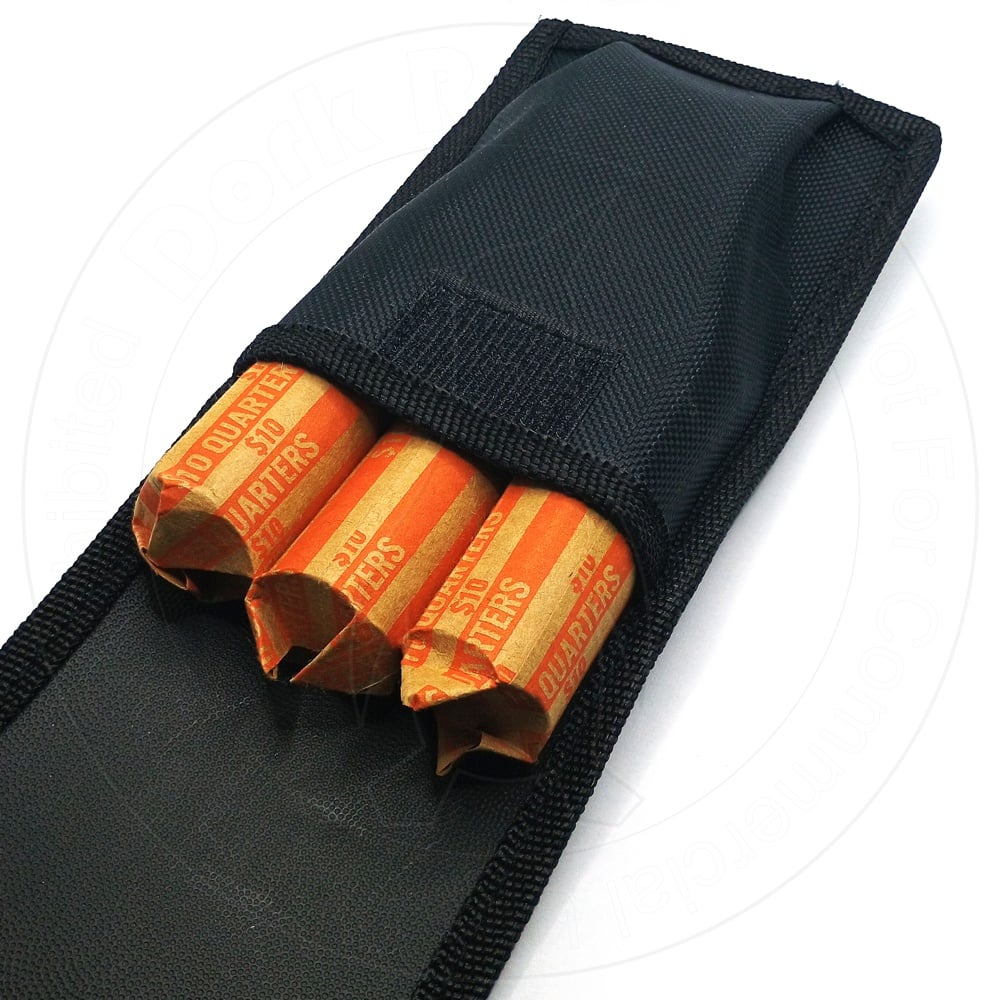
You get nothing else in the box but a little satchel of silica gel. No other freebies, no replacement hardware, no dinky crappy screwdriver, no leaflet covered in poorly translated chest-beating about this or the manufacturer's other products, not even a perfunctory business card begging you for five star reviews.
Oh well.
The Inevitable Conclusion
To some degree nothing I've written above matters. The TS004M-SL is the superlative. It has one aspect, and it's got big hairy bucketloads of it.
And at the end of the day, it's actually put together pretty damn well considering the price. It absolutely could have been worse. And it isn't.
The TS004M-SL is just fucking cool, and on some days that's a pretty good substitute for performance and practicality. It is absolutely The Business. Yes, it will fuck up anything you manage to get underneath of it. It took a shockingly small amount of effort to sink it into the wood in the headline photo I used up at the top of this column. Just feeling that kind of power in your hand speaks to some part of everyone.
And, I mean, come on.
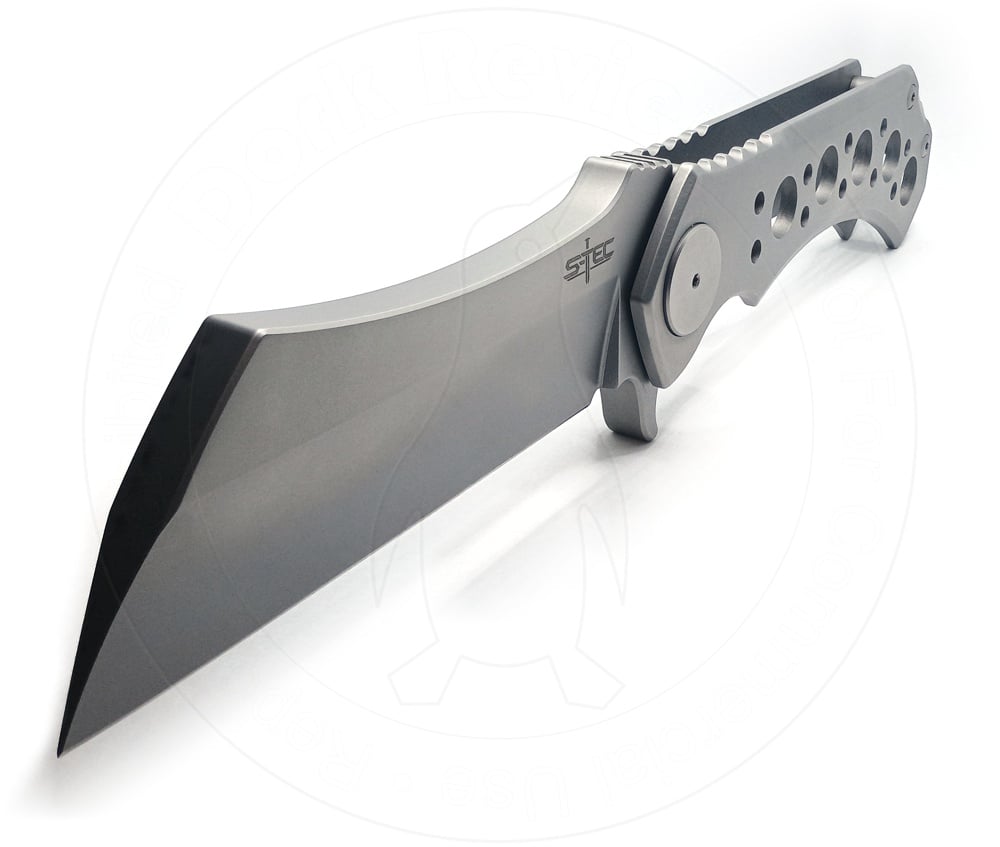
Don't tell me you didn't see this and then immediately stick the model number into your search bar. I know you did.

Opposing and complimentary, like the yin and yang; dichotomous, a contrast between light and dark.
That doesn't remind you of anything topical, does it?
This is the Craighill Sidewinder, and it's got it all in twos. Two handle halves, obviously, in two different finishes. It even has two designers, Kai Williams and Chen Chen, who describe it as "an enigmatic kinetic sculpture moonlighting as a knife."
If that rather rather avant garde description didn't clue you in, Craighill is not really a knife company. Instead they are purveyors of "tactile objects designed for your enjoyment," according to the blurb on their web site. This is an artsy-fartsy way of saying that they make -- or at least sell -- various Sharper Image-eque gadgets and baubles with a definite slant towards the shiny with a gifts-for-dad sort of vibe, provided both you and your dad are in the 1%. This includes various puzzley things, a deck of playing cards whose product description is doing some real heavy lifting, and perhaps the absolute zenith: The $150 corkscrew. You can see how it is.
Anyway, the Sidewinder. It's not quite the only knife they sell but it's certainly the most interesting. And its mechanism is, yes, weird.
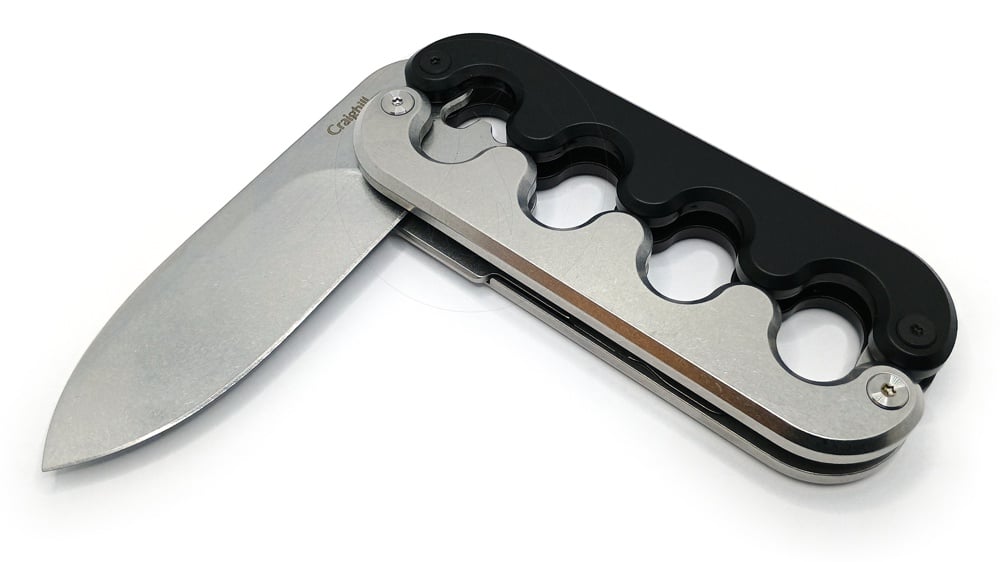
The handle is comprised of four steel plates forming two halves each, sine-wave shaped and with one stonewashed and the other black PVD coated. It has two pairs of pivots, and when you swing the blade open the handle halves swap places with each other.
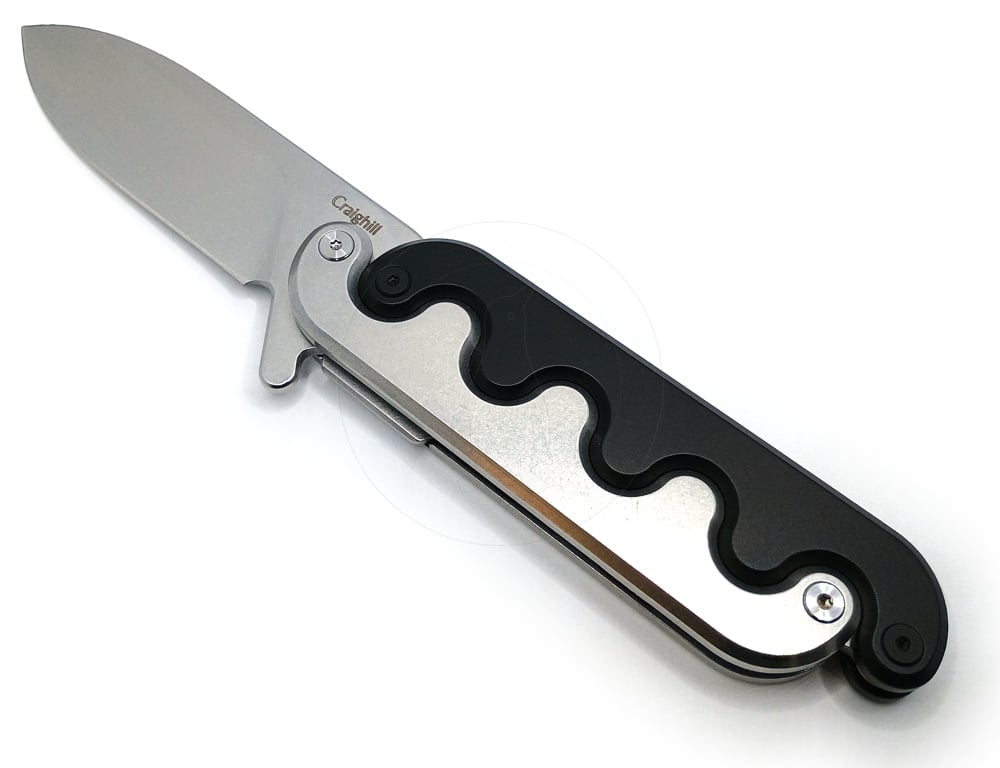
If you compare the open and closed pictures you can spot the difference. It's hard to explain in writing. Here, watch this:

The action really is sublime. It's an art exhibition in motion.
The Sidewinder is compact, but being made entirely of steel it's extremely heavy for its size. 160.3 grams or 5.65 ounces, despite being only 4" long when closed. It's got a 2-5/8" long blade made of 12C27N, which is certainly a very capable if admittedly not very fancy steel.
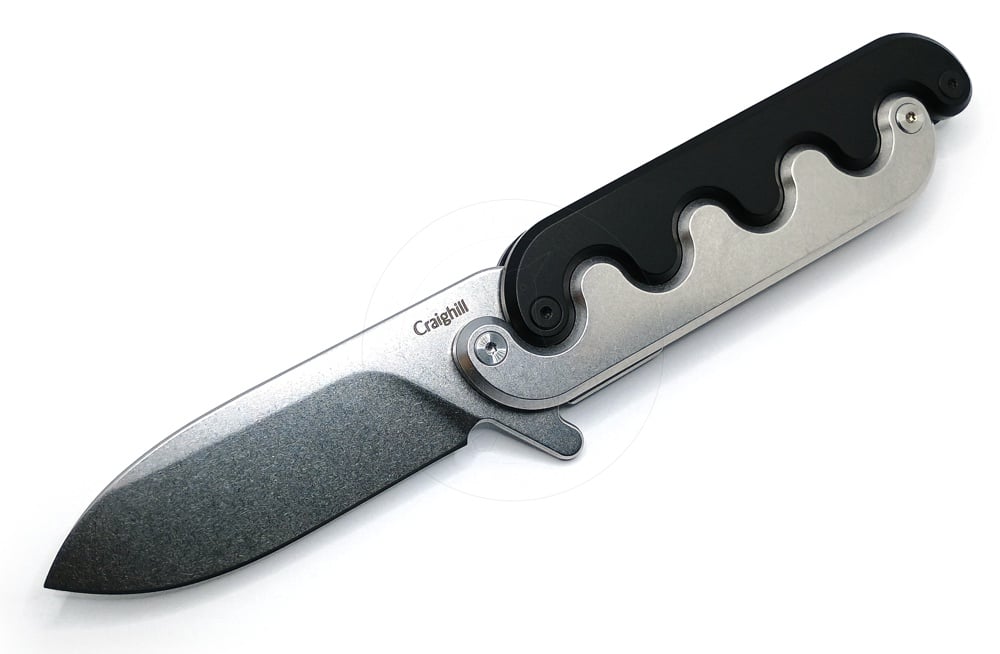
But that, too, is nicely stonewashed. It has a drop pointed blade that, in keeping with its entire symmetry jam, has the point precisely centered along its width.

It's a liner locker although if you ask me, having a lock at all is probably unnecessary since this is one of those mechanisms where your grip on the handle inherently clamps the blade into position. The detent ball that keeps it from flopping open in your pocket is on the liner, though, so removing it isn't really advisable.
And sloshing around loose in your pocket it will be, because the Sidewinder does not have a clip nor does it have a lanyard hole or any other carrying provision. It doesn't even some with a perfunctory cheap ballistic nylon belt pouch. No, if you're going to carry this you have to suffer for your art and be prepared for commitment.
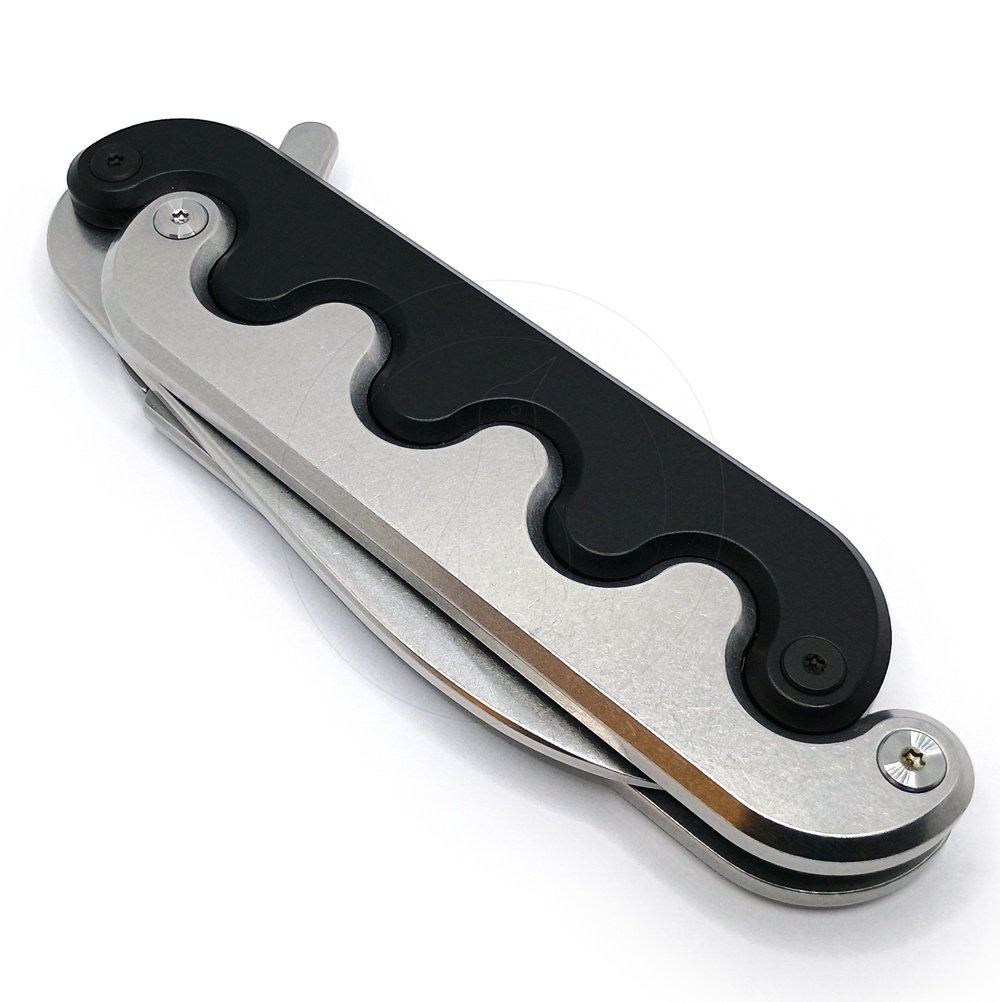
There isn't a thumb stud, either. This is a flipper opener.
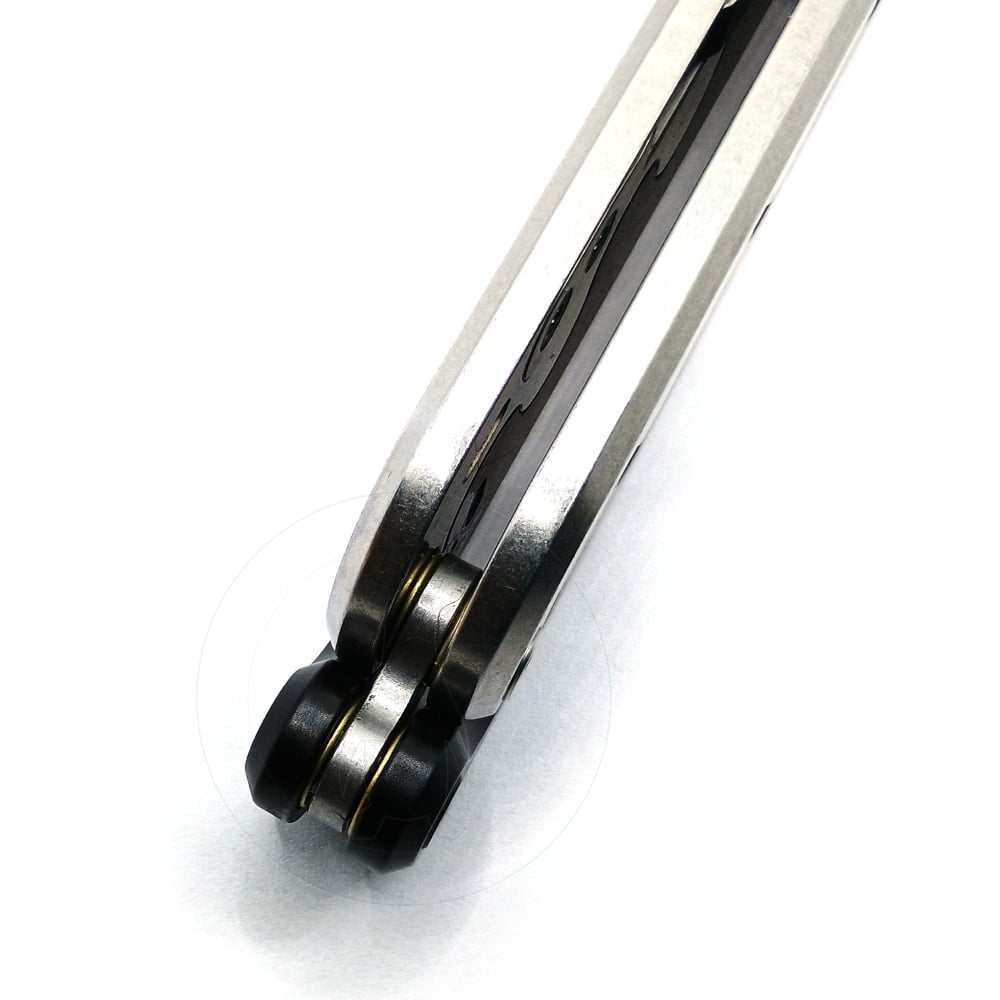
To assist with this it has ball bearing pivots -- ceramic ones, no less -- the carriers for which you can see in the handle gaps.
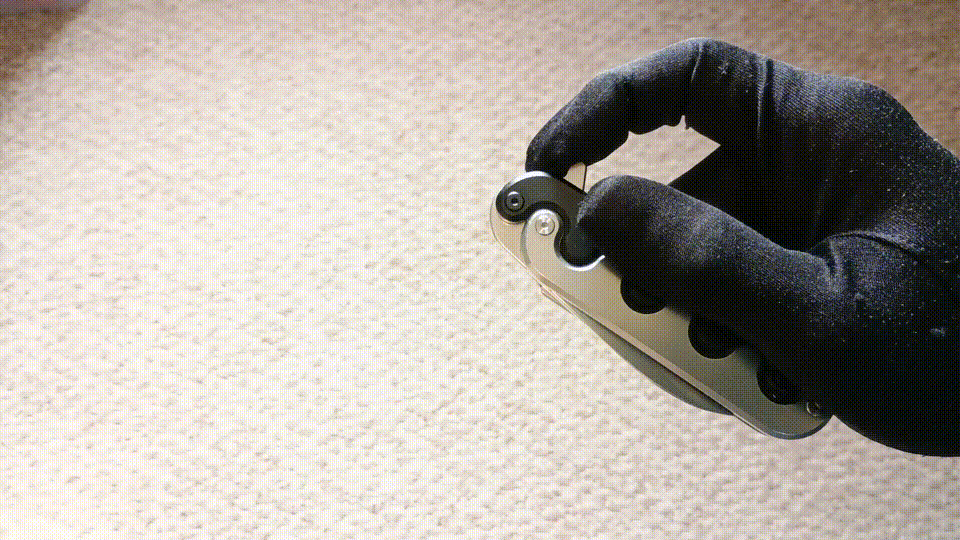
With a bit of finesse it does indeed flick open very easily. You have to remember to hold it only by the black part, though, because the silver part will swing forward along with the blade and if you're holding onto that it'll stop short. This means you probably have less of a grip on it than you'd like and I certainly wouldn't want to try to bust this out in a hurry under duress. It's a fine line between an elegant draw to the adoration of all onlookers versus sinking the thing juddering half an inch into the floorboards.
I think the Sidewinder's mechanism is extremely clever, so obviously I took it apart for you.

There's actually not as much in there as you'd think, but there are no less than eight ceramic ball bearing assemblies owing to the thing technically having four pivot points.

The hardware consists of said pile o' bearings, eight screws, and a quartet of threaded barrels with anti-rotation flats in them. Theoretically you should be able to remove either screw from either end to get the pivots out, but I found that one side of mine was permanently threadlockered and the other side wasn't, effectively converting these into normal male/female screws.
On the tail end is a little curved plate like the barrel link of an 1911, with two holes in it that actuates the pair of pivots opposite the main one when you swivel it open. The curve is in it for a reason, and it's shaped just so that it never actually protrudes from the handle at any time or in any position throughout the action's travel.
The mechanism is actually extremely simple, and its elegance comes down to just how precisely the machined halves of the handles slot together in both the open and closed positions. I've outlined it for you thusly:

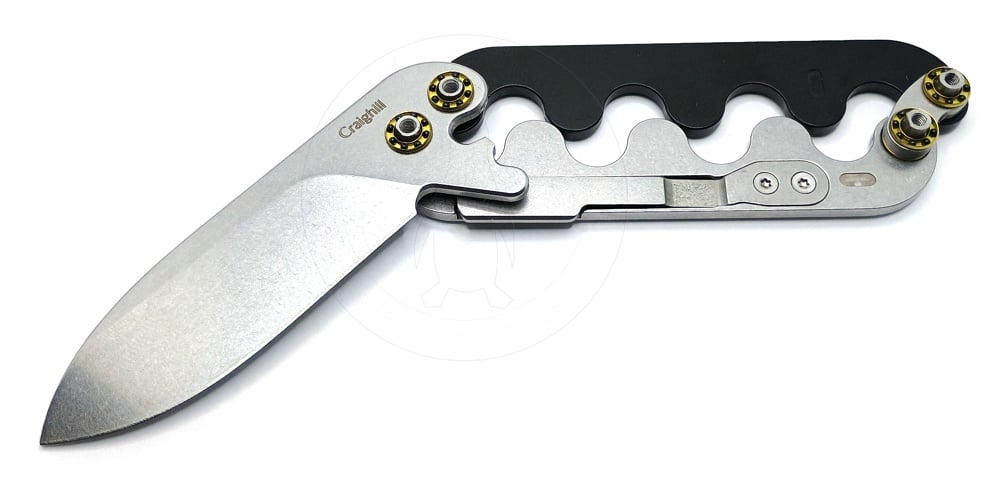
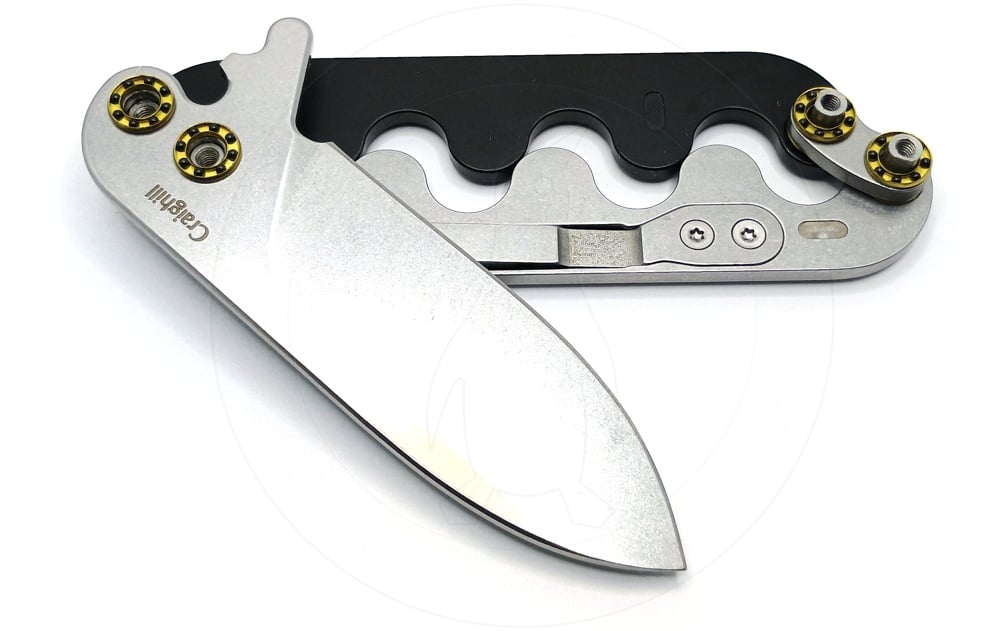
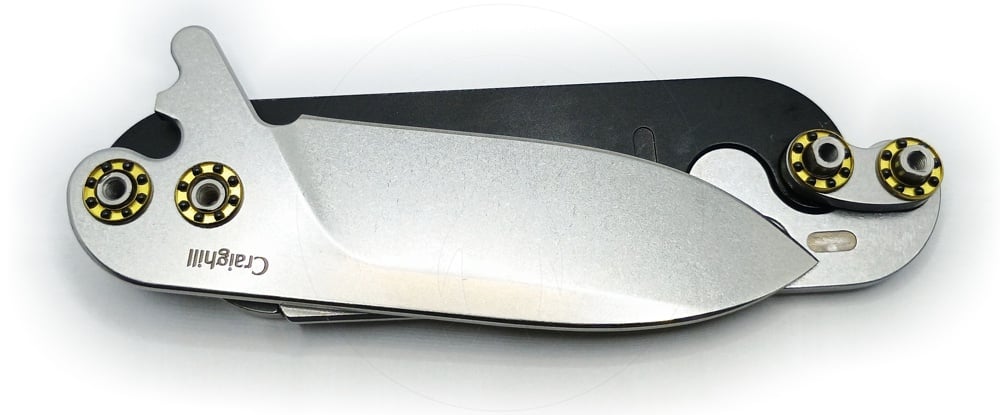
Because both the open and closed states wind up with the halves interlocking so thoroughly, there is no need for endstop pins and the blade absolutely cannot overtravel, nor strike the toggle on the end even though it looks like it ought to be able to. The lockup is very solid and there's no lash in the blade in any direction when in the open position.
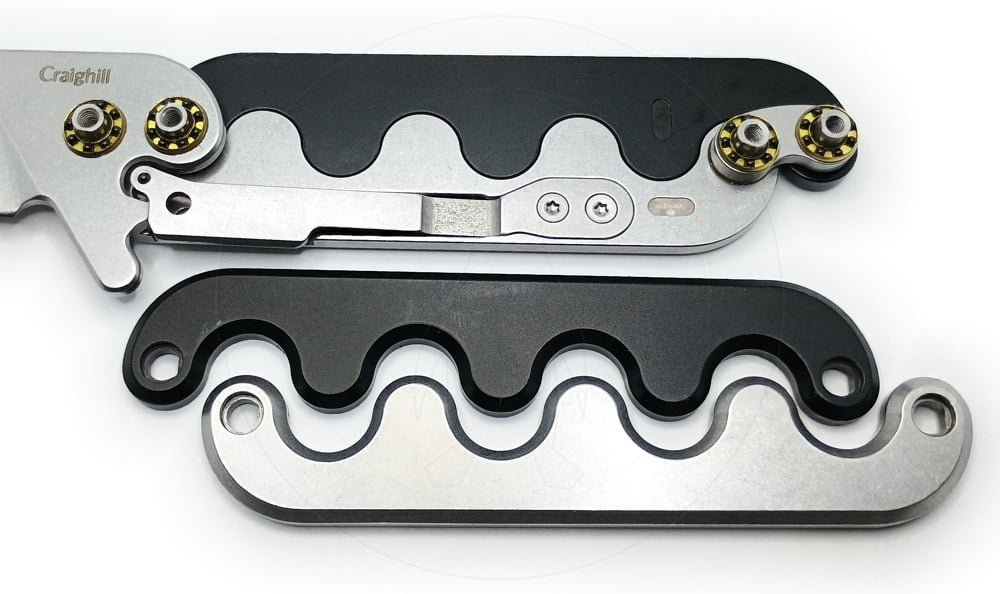
It's also worth mentioning that while it appears the scales could all be duplicates of each other, they're not. Each and every one is slightly different from the others, with one of the silver ones having the cutout for the liner lock in it which is a separate leaf that's screwed into place, while only one pair have the D shaped anti-rotation holes in them while the other two just have round holes.
At the end of the day it doesn't really make any difference which way you insert which screw, although half of them are silver and half of them are black, and you probably won't want to mix them up.
The Inevitable Conclusion
The Sidewinder is a tad on the expensive side but there's no denying it's extremely well built and it's got style out the ying-yang. There isn't a single whiff of mall ninja about it. It's pleasingly refined, elegant, grown up. Very gentlemanly. The machine work is impeccable, with every edge smoothly chamfered and every surface fully finished, even the inside faces where you'll never see or touch.
Maybe it's small, and maybe it's not made out of the latest trendy supersteel, but when you're holding it you don't care. It's not your partner's clothes or makeup or perfume that matter. The beauty is in the dance.
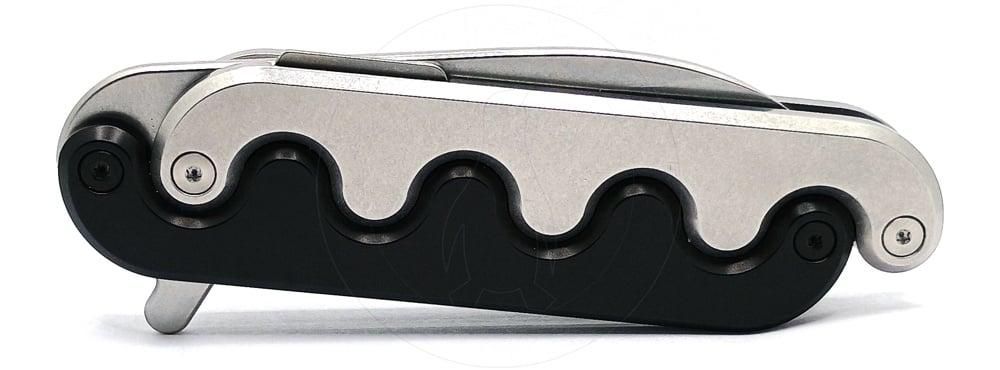
I’m a big fan of Spyderco; I own about two dozen of them. I absolutely love the Para 3 and Delica, but I also like buying oddball knives on occasion.
This one’s been on my wishlist for a while. I’m not usually a fan of pinned knives that you can’t take apart, as I like a bit of tinkering. But since I want to keep this original anyway, I’m making an exception. It’s well built like all their Seki City knives; nicely machined with no sharp edges besides the one that should be.
The Harpy has been in their lineup since the late 90’s, and it’s held in high regard by many. It’s a nautical inspired knife, with the serrations and blade shape being handy to cut rope. Of course these days Spyderco makes a separate line of actual nautical knives, but that wasn’t a thing in the late 90’s.
It’s a perfect fifth pocket knife; carries nice and comfortable. It also has excellent ergonomics despite not being very large. One thing I like: it feels like a very warm, friendly knife. The handle takes on your body heat if you carry it on your person. Holding it feels like a warm handshake.
This knife is also slightly infamous; it’s one of the knives that fictional cannibal-slash-serial killer Hannibal Lecter uses. It’s specifically mentioned by name in the book Hannibal, and shown in the movie. The movie has a plain edge knife though, but the book specifies a serrated Harpy.

With this knife it's tough for me to do that thing I do where I bury the lede in order to keep suspense for the first couple of paragraphs in order hook the reader before I reveal whatever its quirk is.

This is the WE Knife Double Helix, and it's easy to see what its deal is right away because it wears its underpants on the outside.
At its core the Double Helix is, more or less, an Axis lock style crossbar locking folder. However, rather than the typical pair of hair-thin "Omega" springs hidden inside the handles...

...Instead there's this trebble-clef external spring that runs almost the entire length of the knife. There are two, actually, with an identical but mirrored one on the other side. That's certainly a novel way to do it, and for this it was awarded "Most Innovative New Knife 2018" by Knife News. I'm sure WE will be trumpeting that at anyone who'll listen -- and anyone who won't -- until the sun burns out.
In my prior ramblings, I'm certain I've told you many times how the Axis lock is my favorite mechanism out of all the various non-balisong folders. You're probably sick of hearing it, along with the note that Benchmade's patent on it expired in 2018, enabling many other knifemakers to have a crack at the idea.
Part of why I like the Axis lock is its inherent capability, when properly designed and implemented anyway, to do the "Axis flick." That is, you can hold the crossbar back and just flick the knife open without any other manual intervention. The jury's out on whether or not this is actually an originally intended function of the mechanism.

Well, for its part the Double Helix doesn't leave much ambiguity about how its designers intended it to be opened. As you can see it is completely lacking in any kind of thumb stud, disk, hole, hook, or any other apparatus to aid you in getting it open with your thumb. And to further compound matters, unlike normal Axis lock folders its lock also resolutely holds the blade shut. You absolutely cannot open it without pulling the crossbar back.

The Double Helix is a fancy knife with ball bearing pivots, so with all of the above taken together we can only conclude that it's meant to be Axis-flicked open with a snap of the wrist. The only other way to do it is to use two hands, and what kind of self respecting individual is going to do that?
The flies in the ointment with the action are twofold, though. First is that the Double Helix is not one iota longer than it needs to be, which means that the tip of its 3-1/4" drop pointed blade passes extremely closely to the tail end of the knife. It's therefore not only possible but downright likely that some of the meat from the heel of your hand will at some point get squished into the gap between the handle halves and then the point will graze you as it goes by.
Second is that, visually striking though they may be, those two external springs are actually rather stout and it takes quite a bit of force to disengage the lock.

There is a pocket clip, which stands on long standoffs to ensure it clears the spring and is also for no particular reason not reversible. As usual there's no mechanical impetus as to why it couldn't be; there just aren't any holes for it on the other side even though both handle halves are total mirror images of each other. Apparently because WE decided they just couldn't be bothered. It's just as well, probably, because screws holding the end of the spring down have cylindrical heads that sit proud of the face of the spring by several millimeters and are incredibly snaggy. They wind up between the clip and your pants fabric, making the Double Helix nearly impossible to draw in a hurry without either tearing your pants fabric off or giving yourself an atomic wedgie. Both the clip and its standoffs are easily removable, although there is no lanyard hole either so if you do that you'll just have to leave the thing bouncing around your laptop bag like some kind of heathen, or something.

There is some thickness to the springs, and also to the handles -- arguably probably more than there needs to be just to get the mechanism to work -- which makes the Double Helix pretty chonkers. This is completely notwithstanding the fact that its groovy pivot screw with the machined-in "WE" logo is flush fitting.
It's 0.648" thick just across the handle slabs not including any of the other greebles; including the thickness of the two crossbar lock heads it's a whopping 0.770" and including the clip it's an even more ridiculous 0.807". And of course being made of zooty premium materials like titanium and aluminum, it's not as hefty as you'd expect: 99.8 grams or 3.52 ounces. Closed it's precisely 4-1/2" long, and open it's 7-13/16".

The blade is S35VN, surely mostly in order to maintain credibility among its intended purchasing demographic, and is 0.133" thick. It's fullered, and has a nicely rounded spine that's easily the least snaggy part of the entire knife. Reviewers who are more qualified than me have spent many words on its hollow grind and its excellent general purpose cutting ability, but I won't because this is a collector's knife and to the first couple of decimal places nobody is going to cut anything demanding with it anyway.
According to the stipulations of a very particular gypsy curse, I am incapable of giving an overview of any knife with a weird mechanism without taking it apart to see how it works. Although in the case of the Double Helix, pretty much everything interesting is visible from the outside.
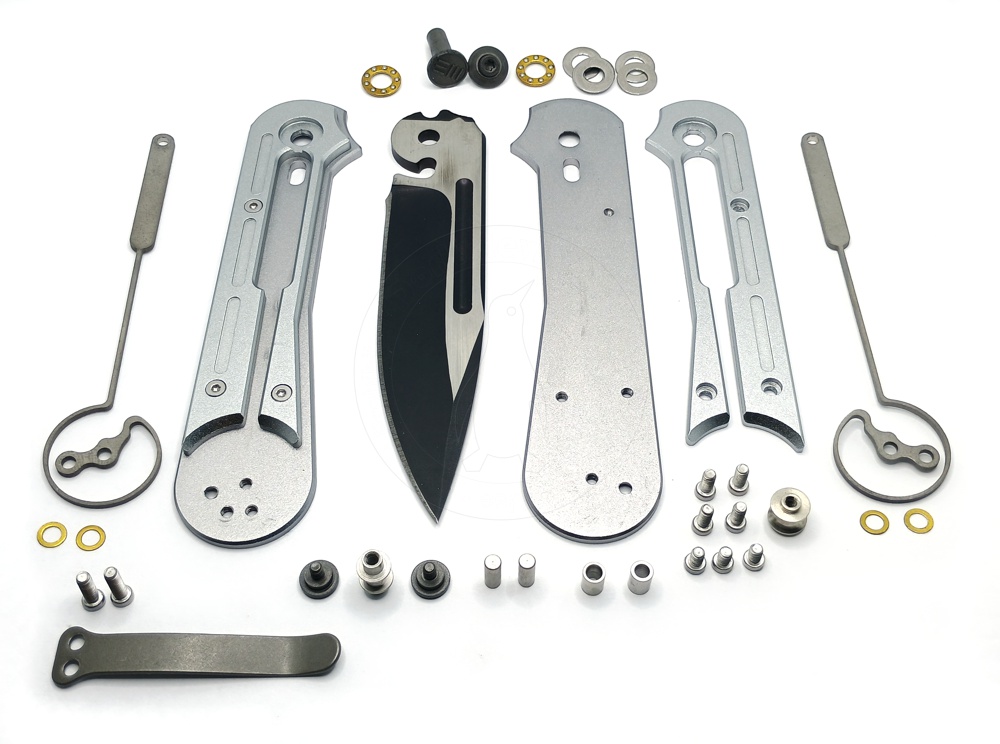
I took it apart anyway.
Being firmly in the enthusiast knife category, the Double Helix was not at all difficult to take apart. It's all T8 and T6 Torx screws, as you'd expect. And also as an enthusiast knife, it breaks apart into a ridiculous number of individual parts, apparently to vainly attempt to justify its price tag.

This is most of the hardware. Each handle slab is actually two pieces, which is completely unnecessary from both a production and mechanical standpoint, but that's how it is anyway. I only took one of them apart for my disassembly photo, so the lineup above is short three additional screws. The trim collar around the male side of the pivot screw is also a separate piece, and it has two end stop pins. And also three washers per side of the pivot, for some reason. That all adds up to no less than 35 individual pieces of hardware required to assemble this, not including the blade itself, both pieces of both handle halves, the clip, and the springs.
Because the crossbar has to pass through holes in the ends of the springs externally, it is somewhat unusually a multi-piece design. It's right in the middle of the photo above, and it consists of a flanged center barrel while the nubbins on the outside that you interact with can be unscrewed. This is necessary because the usual method of installing an Axis crossbar through an offset pair of channels hidden under the handle scales obviously would not work in this case.
Note also the alarmingly tiny little spacer washers that go between the handle slabs and the springs, which are bound to disappear forever if you drop one on the carpet. So watch it.

Here you can see WE's weirdo crossbar lock track, including the dog-leg that locks it in place in the closed position. The general consensus online seems to be that this is supposed to be for "safe" pocket carry, as opposed to a weird design oversight, which I find highly dubious given that A) nobody in all of recorded history has ever had a problem with an Axis knife falling open in their pocket, and B) nobody is going to pocket carry this more than once anyway, see also the situation with the clip, above.
The Inevitable Conclusion
This is one of those things built purely for knife collectors, and normal people probably need not apply. Knife mechanisms are sort of like the quantum multiverse theory -- for any given possible way to do it, it is not only likely but downright inevitable that someone will eventually try.
I like the Double Helix's core conceit. It's just all the details surrounding its execution that I take exception to.
In my opinion it would not take much of a redesign to allow the Double Helix to retain its groovy external spring, but also make it significantly less irritating to carry and use. Just not locking the blade shut would put us well on our way, in addition to sinking the spring into the handle a bit and giving all the mounting screws countersunk heads.
WE, if you need to take me on board as a design consultant to straighten all this out I'll happily do so, and you'll find my rates to be very reasonable.


Hello knife people, I (very much not a knife person) have been suckered in by dual_sport_dork’s posts and am finally biting the bullet and buying one of those knives. I know approximately nothing about knives except what weird knife Wednesday has taught me, which is mostly how to shit talk cursed knock-offs, so I’m hoping for some advice on how to stick the landing of my jump into this hobby.
I’m trying to buy HUAAO’s Bugout 535 ripoff, and this knife-buying-experience is off to a rocky start because the Amazon link on dual_sport_dork’s writeup tells me shipping isn’t available to my region. Maybe this is just seller-related, maybe these knives are illegal in Canada, I don’t know and to be real honest I don’t give a fuck. I found knivesprecisionedge.com, which claims to be a “trusted store” and “100% issue-free” - sketchy as fuck, honestly. Has anybody else used this site? How bad am I about to get scammed?
Assuming they’re at least somewhat legit and ship me this knife, and that it makes it into the country, is there anything I should know about owning a knife like this? Care tips, how not to use it, anything like that? The main thing it’ll be used for is as a camping knife, if that matters.
Look, if I had a nickel for every knife I've got all covered in gears, I'd have two nickels.
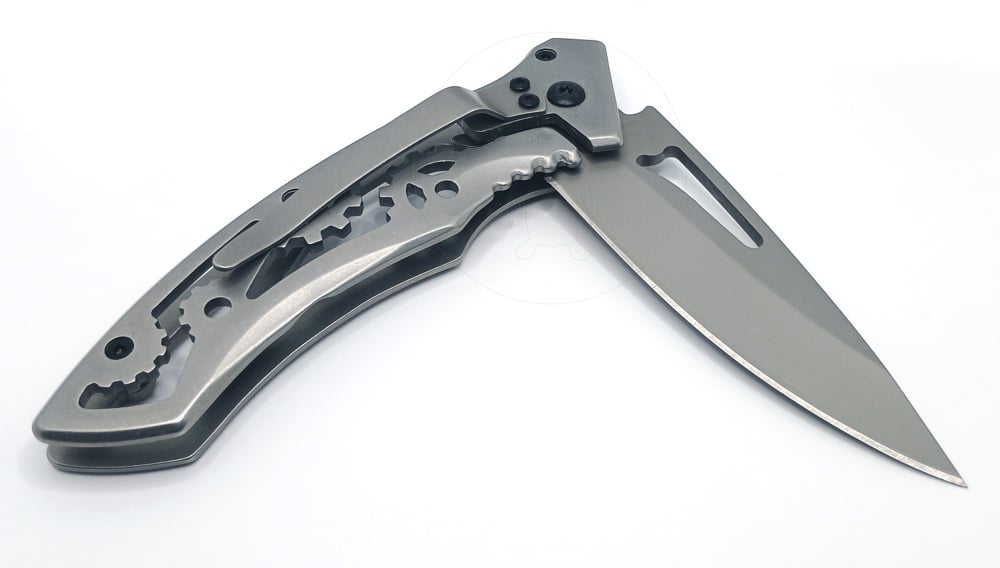
So here's the other one. This is the "DevilFish T20315," and with a name like that you know it's got to be good.
I've actually had my eye on this -- well, not precisely this by name -- for a little while. I dug this hole for myself by apparently deciding I'm like the stupid cutlery equivalent of Civvie 11 now, or something, and this whole thing has gotten so out of hand lately that I damn near give myself whiplash every time I'm scrolling through the internet and I catch a glimpse of another whack-ass shitty Chinese knife. I just have to page back and stare at it, like the broke kid pressing his face against the shop window at the candy store. It's some kind of Pavlovian complex now.
I've been flicking through and honing my apparently encyclopedic knowledge of the Top Quest catalog, you know, as you do, and I've passed by this knife multiple times. You see, this is actually a Top Quest knife. The "DevilFish" moniker is just some more of that Amazon fuckery, you know, where everything has to be sold under some kind of registered trademark and it doesn't matter if it's nonsense because all Amazon cares about is being able to pretend everything on there is a "brand" and isn't just drop Chinese shipped garbage?
So that whole grift actually works out pretty great for me for once, because Top Quest won't sell you a single knife. They're a distributor who wants to sell a whole shitload of pieces to a reseller and if you're just small potatoes like me as far as they're concerned you can just fuck off. Their web site won't even tell you how much these things are supposed to cost.
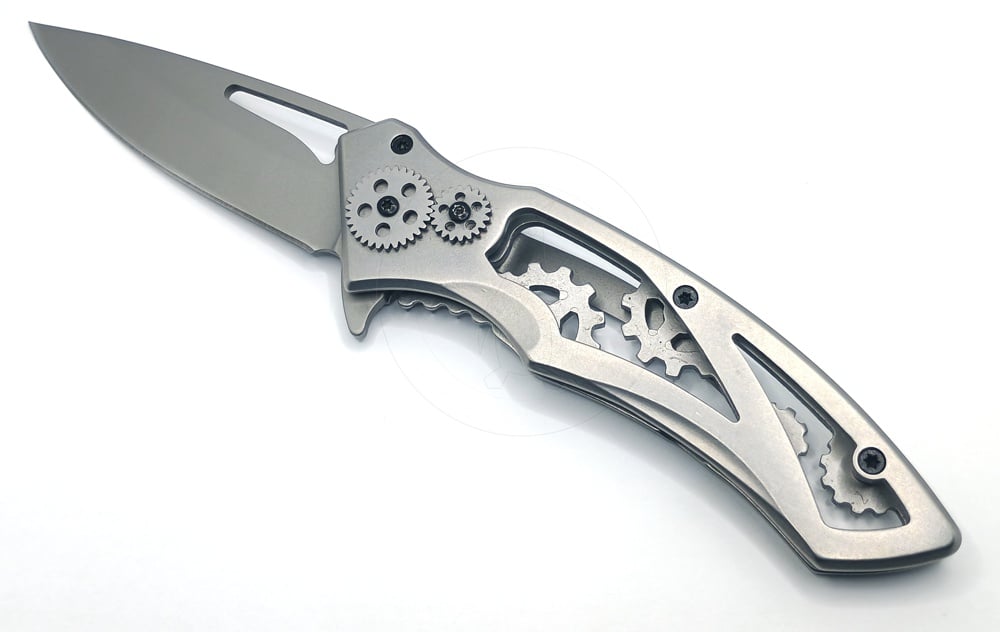
But I figured out the other week that I could buy just one of these from Jeff Bezos' Fun Time Candyland and I probably overpaid for it. It was still only $15.
It's obviously the same knife. It's right there on page 38 of the catalog if you want to check it out.
So the T20315 has this whole... aesthetic... going on. And I know what you're thinking. Yeah, the gears on the back side where the clip is are fake and they're just cast into the handle.

Here's the money shot. I know it's what you kids came here to see.
The gears around the pivot aren't fake, and they turn when you open the blade.
Of course this doesn't serve any purpose. It's just there to look cool. The blade is just mounted on a splined shaft and it turns the big gear in the middle, which in turn drives the little one. There's a flipper heel on the back but it's kind of a red herring. The action is extremely draggy and flicking the knife open with the flipper is completely out of the question. There's a cutout in the blade in place of a thumb stud for you to open it the traditional way, and with a bit of practice it is indeed openable one handed via that avenue.
You can also flip it open if you give it an unwisely brisk snap of the wrist when you hit the flipper or, if you're feeling super frisky, you can open it easily by doing it backwards -- grab the spine of the blade, and flick the handle out. Don't come crying to me if you flub your DEX save when you try it, though.
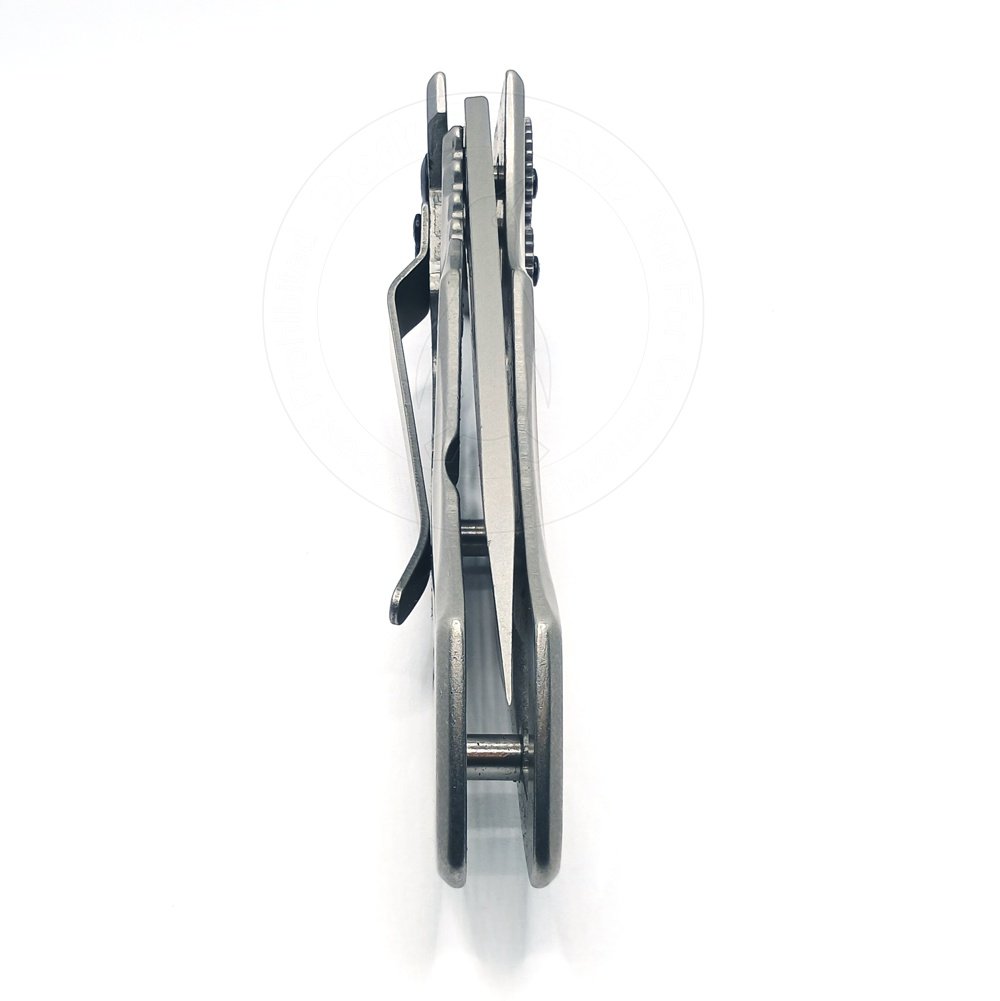
The T20315 is a frame locker, and that as we all know tends to come with a hilarious centering job on a cheap novelty knife like this. At the very least the blade doesn't contact any part of the handle nor can you entice it to do so, which is nice. But it's still pretty out of whack. It's solid once you have it locked open, though.
This thing is all steel. No fancy titanium, aluminum, or even inlaid Chinese mystery wood. Thus despite its skeletonized design it's pretty dense: 107.3 grams or 3.78 ounces altogether. The blurb calls it "7.5" inches, but by my measure it's actually 7-5/8. So you get a whole extra 0.125" for your money. The blade is a drop pointed affair that's 3-3/16" long if you're measuring the usable part, and rather less if you measure from the forwardmost tip of the rather rakishly angled handle, or a touch more if you want to measure from the center of the pivot. The blade is precisely 0.110" thick at the spine which I think we've become quite accustomed to seeing by now.
The handles are probably some kind of sintered material casting. They're steel, and a magnet sticks to them, but there are telltale mold release marks on the back sides. I think they've been tumbled, though, or possibly bead blasted. The outer surfaces are very consistent and feel pretty nice.
Despite all of its design tomfoolery the T20315 manages not to be cartoonishly thick. It's only 0.496" including the thickness of the gears. It includes a nonreversible pocket clip that carries the knife tip down, and against all logic actually feels pretty good and draws cleanly. The clip is on the side opposite the gears so they won't snag on your pocket fabric, either.

I was going to take this apart, but, well. I can't. The screw head on the little gear arrived pre-stripped from the factory, and I can see just by looking at it that the blade is press fit onto its shaft so I can only imagine this will be an exercise in frustration. Any disassembly would thus surely be destructive. And...
The Inevitable Conclusion
...Despite the T20315's shortcomings -- not least of which being, once again, a complete lack of a memorable name -- I actually kind of like it. So I think I'll leave it right where it is, i.e. un-destroyed.
The gears of mediocrity may grind slowly, but they grind exceeding fine.
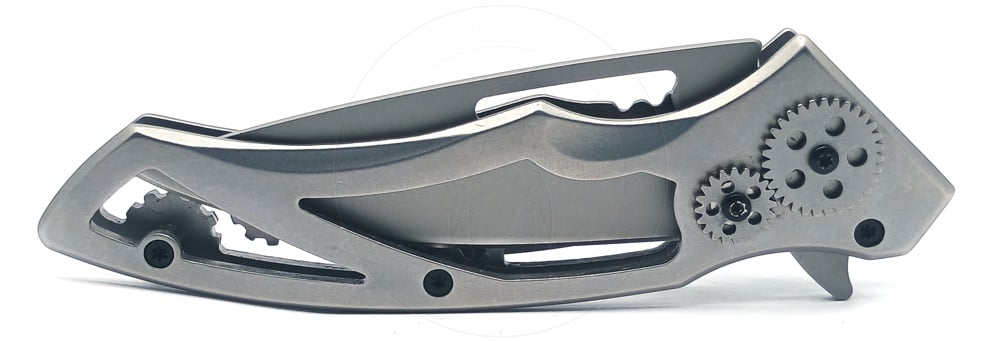
Hey, was wondering if anybody might have any tips for me! I've been using a Worksharp Knife & Tool Sharpener MK2, and have this weird issue where my knives are coming out sharper on one side than the other.
I know that shouldn't really make any sense, but I've got a knife right now that I have no problem shaving hairs off my arm with, but only with one side. If I flip it over, no matter what angle I approach with, I can't knock away a single hair. The bevel is also significantly wider on one side, which I also can't figure out how to correct but I'm sure is related.
I can't tell if this has anything to do with the fact that the belt rubs against the steel in different directions when sharpening each side (up and into the blade on the left side, down and away from the blade on the right), or if perhaps this might be an error in technique on my part. As far as I can tell, I'm keeping the blade in line with the guides properly and not deviating significantly.
For what it's worth, I'm working with a hawkbill blade. Meaning that I have to lower the knife as I draw it through the sharpener, to keep contact with the belt. I know this allows for a lot of room for error; I've been making an effort to ensure that I'm keeping the alignment correct the whole time, but it's wholly possible that this may be where I'm messing something up.
Any ideas if I might be doing something wrong or something I could try to get a more even edge on both sides?
And.
My.
Axe.
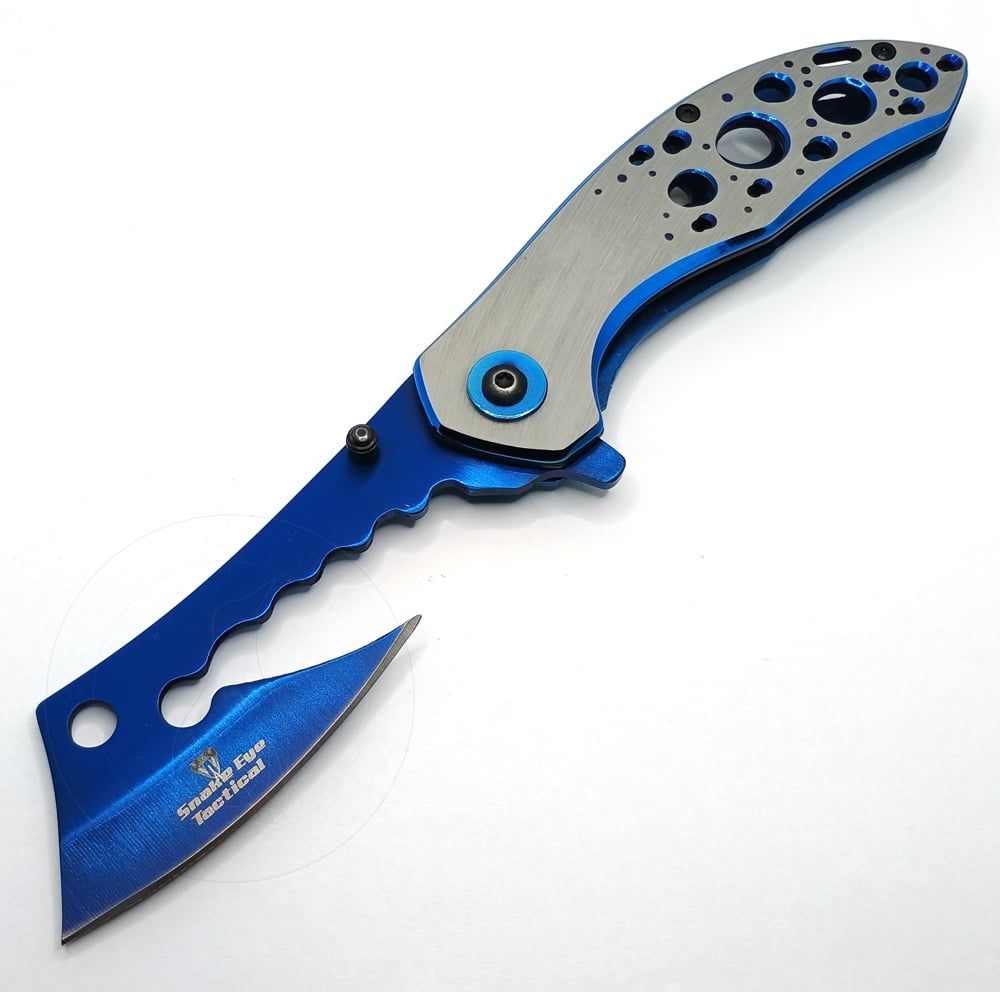
That's it. That's the joke.
The Inevitable Conclusion
...
^What?^ ^Okay,^ ^fine.^
...
This is the "Snake Eye Tactical" CE-5079BL. Like many of its ilk, its name doesn't exactly ring melodious.
And yes, that is "Snake Eye," singular. Not "Snake Eyes," like throwing a pair of ones.
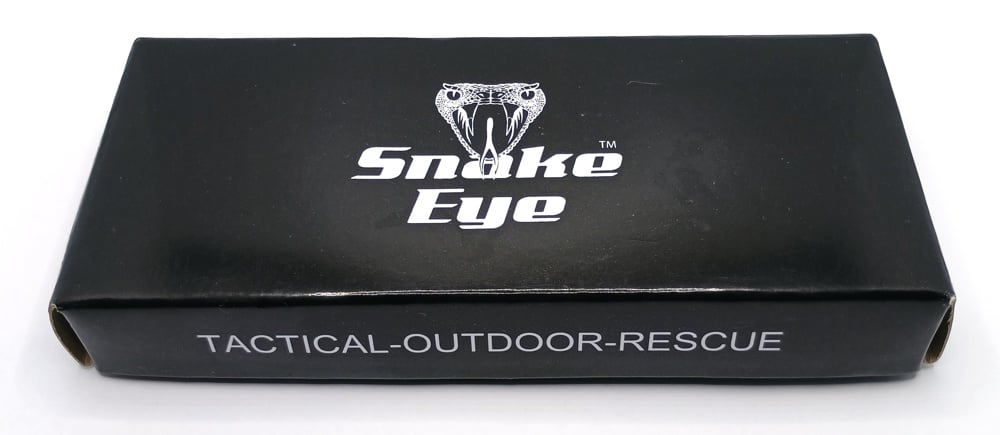
I have no idea why. Whoever-it-is is very consistent with this nomenclature, at least, regardless of the fact that your brain's been trained to get it wrong every single time.
The CE-5079BL is, without a doubt...
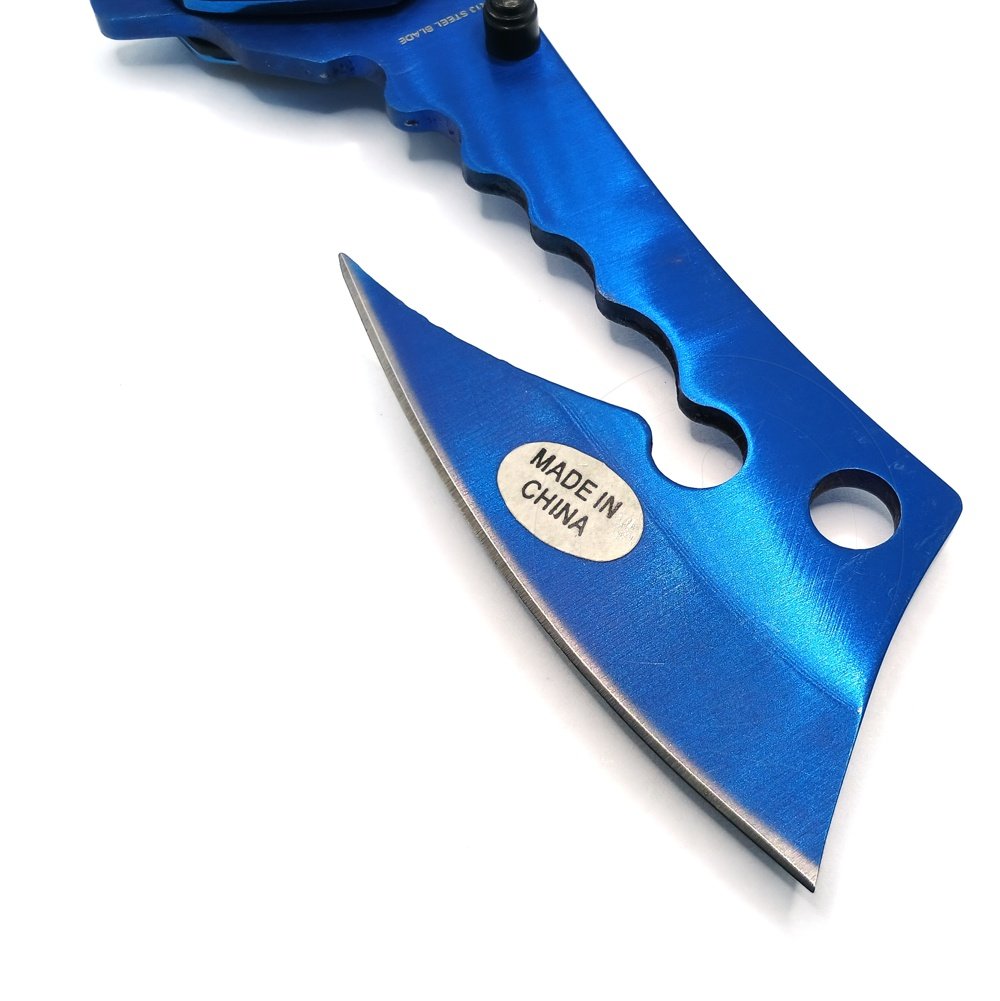
...Yeah, that wasn't much of a stretch.
What this is, is, a frame locking spring assist folder with a very funky blade shape. The way it's designed is as if a 14 year old D&D nerd just drew what they thought a fancy dwarven bearded battle axe ought to look like, from the top down. And that metaphor is more apt than you'd think.
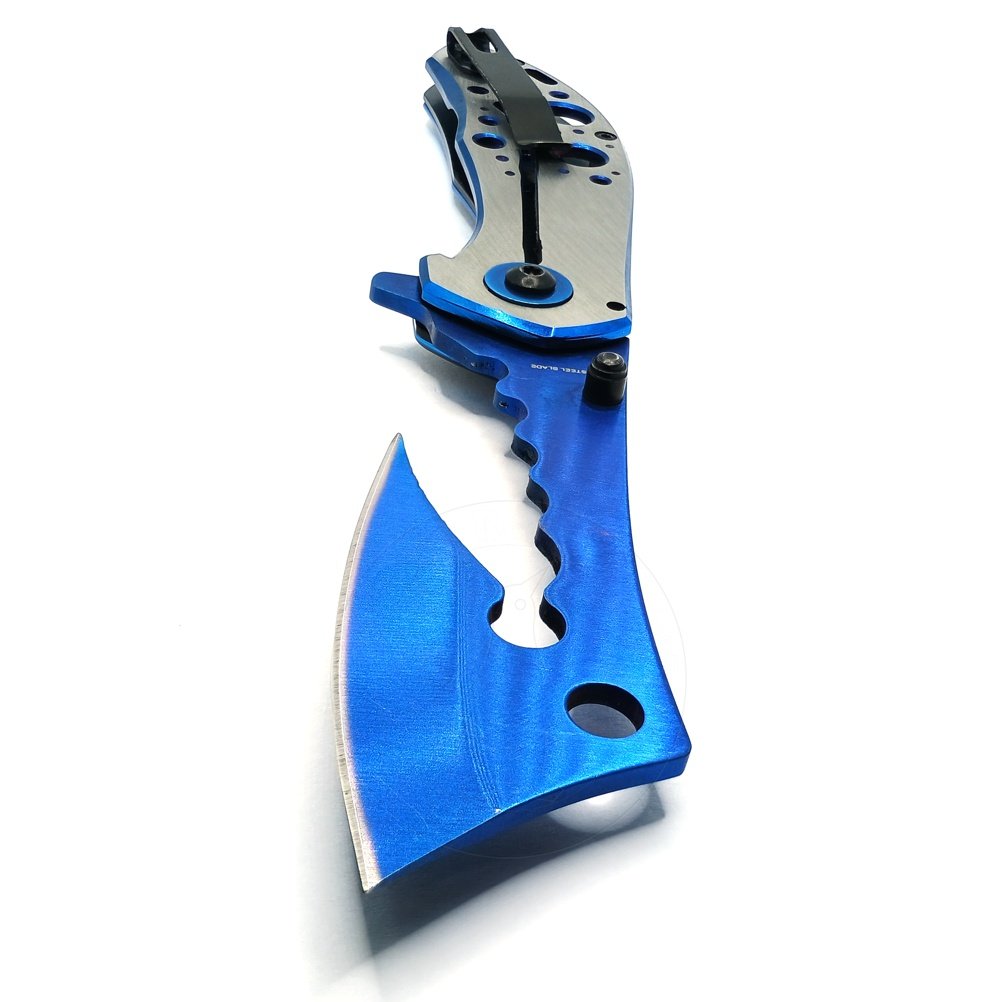
That's because there's very little else axelike about the CE-5079BL. Its blade has none of the wedge-profiled thickness of an axe, for instance. It's just a regular old 0.110" thick slab of "440" series stainless steel, the exact species of which is unspecified. The bevel is hollow ground, not convex as you'd expect an axe to be.
And then of course it's dinky. It's 7-7/8" long open and 4-1/2" long closed.
I've blocked out a half an hour on the schedule here for the argument about how the blade length ought to be measured. The whole thing from the forward end of the handle to the tip is 3-3/8", but the actual sharp part is only 1-7/8" and the rest of it is largely empty air. Neither of these figures match the manufacturer's stated blade length of "2.75 inches."
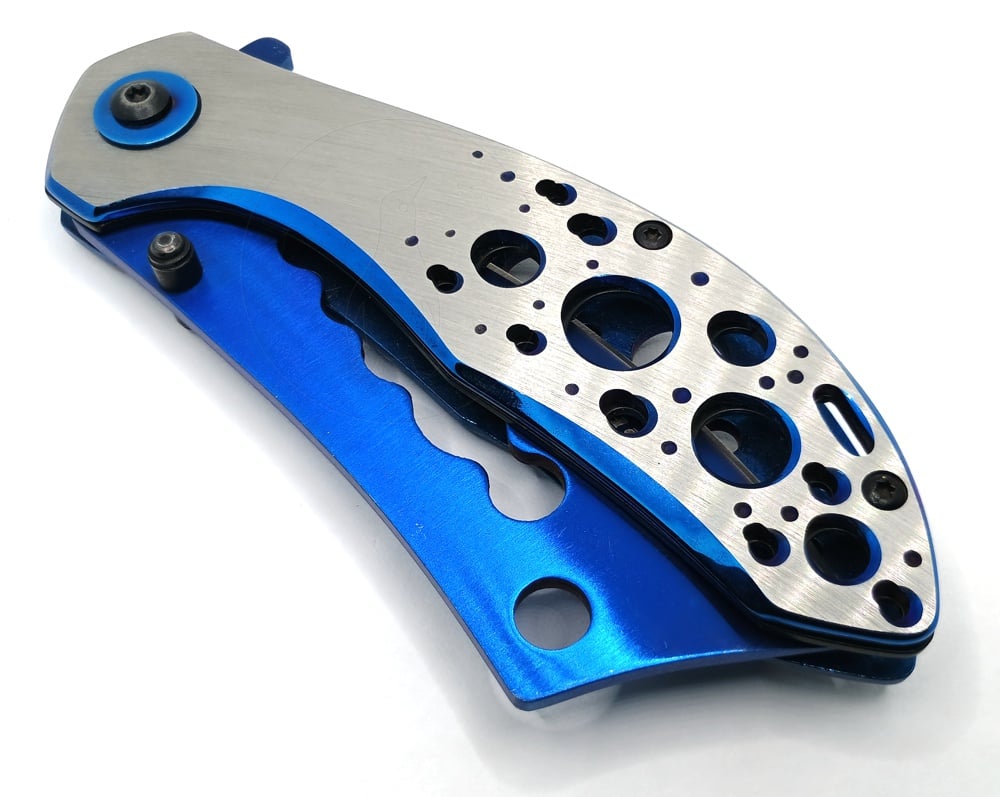
The CE-5079BL's got one other measurement going for it, as well. It is extra, extra broad. Easily 1-7/8" across when it's closed thanks to the wide handle and upswept horn on the peak of the blade.
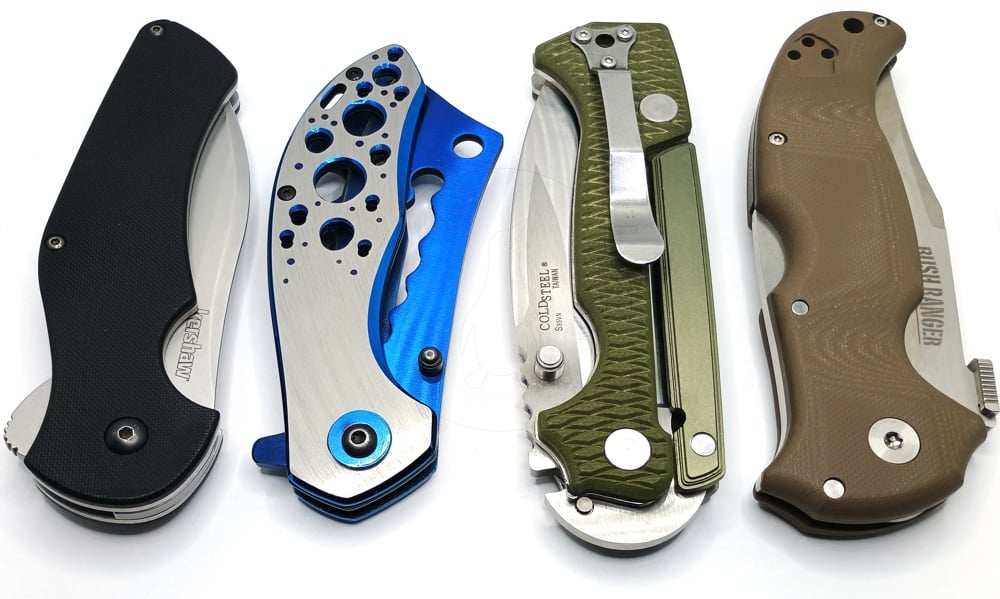
Here it is with a selection of other wide bois picked at random from my collection. If you absolutely need to pick a superlative, I think the CE-5079BL has the highest breadth-to-cost ratio out of anything I've ever owned since it was only $15. I did not dig into this in extreme detail, but it may just take the crown for the broadest folding knife I now own, period.
The CE-5079BL's looks are also very funky. The handles are steel of some description with this groovy machined finish -- both figuratively and literally -- that winds up a striated surface that really catches the light. I like this blue incarnation best out of the available options, and the accent color is very shiny and almost appears... anodized? I wasn't aware you could color anodize steel like that. Maybe it's something else. In any event, the blade is finished the same way.
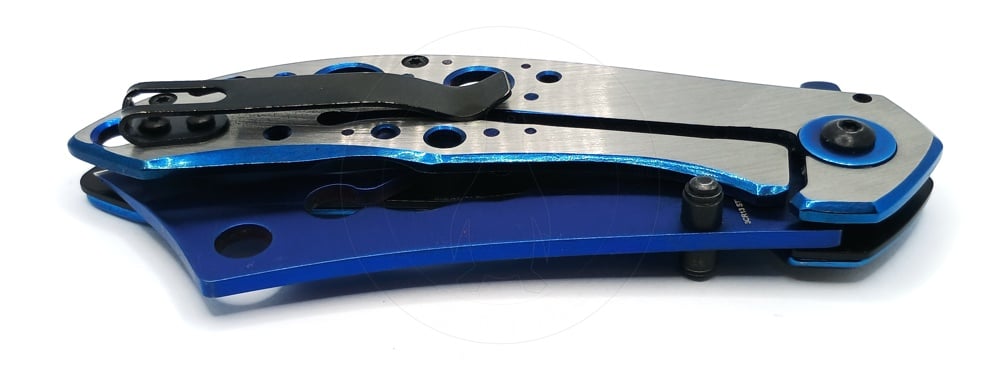
It does sport clip that is even deep carry, if you feel like being perverse and actually bringing this with you anywhere. Although the clip is not reversible, lacking screw holes in the opposite handle slab. Which is weird, come to think of it. I mean, just look at the thing. It's obviously not like anybody was afraid to drill any holes in it.
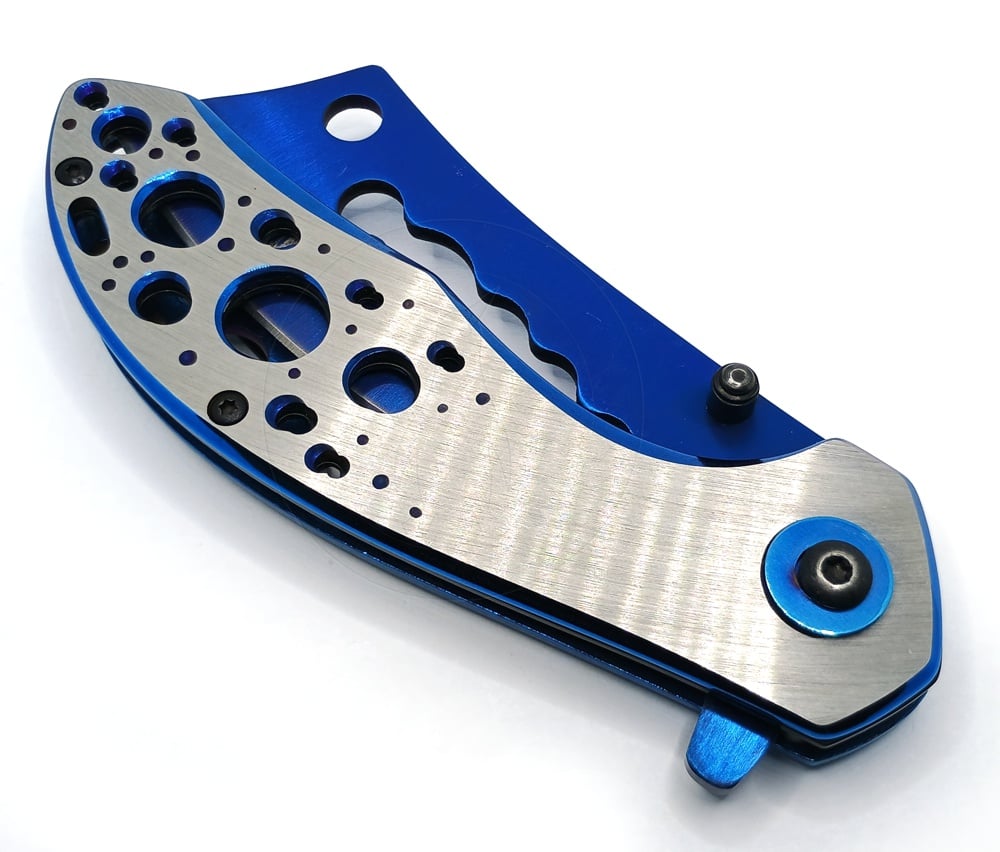
I'm going to keep showing off pictures of the shiny handle slabs for no other reason than I think they're so damn neat.
Anyway, this is a spring assisted opener and can be set off either via the ambidextrous thumb studs or the flipper on the back. But that said I found the spring action on mine to be... what's the word... iffy. Often it would not lock open unless I rotated the blade out all the way manually.
I figured out why pretty quickly.
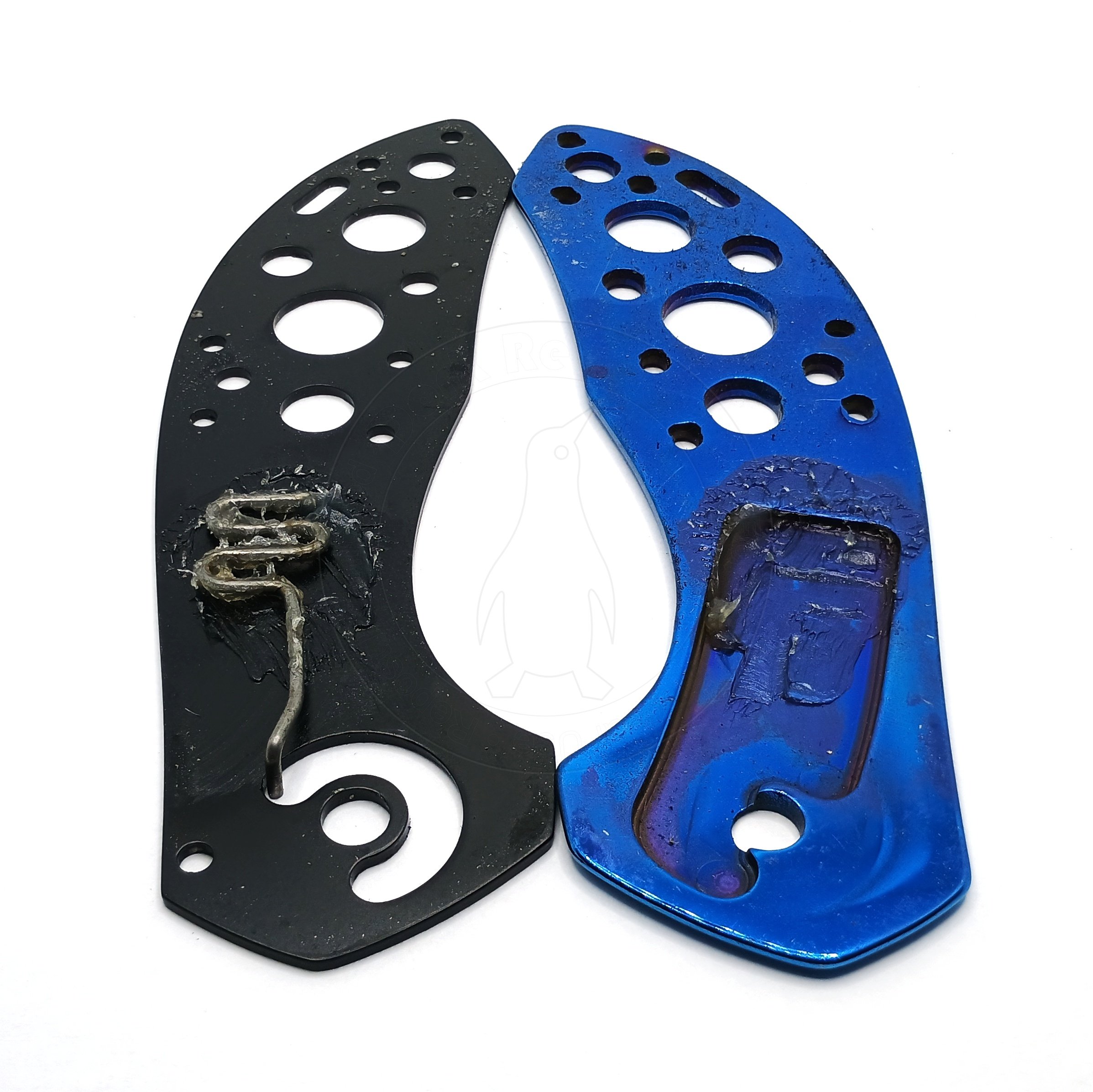
Ever wondered why you haven't received anything coated in Cosmoline recently? That's because the world's entire supply has been used up by packing it into this thing.
I think this was so liberally gooped by the factory with the expectation that this would be a lubricant, but I'll be damned if the stuff doesn't look and smell just like Cosmoline, so it probably is. Which, I should point out to anyone blessedly unaware, solidifies over time.
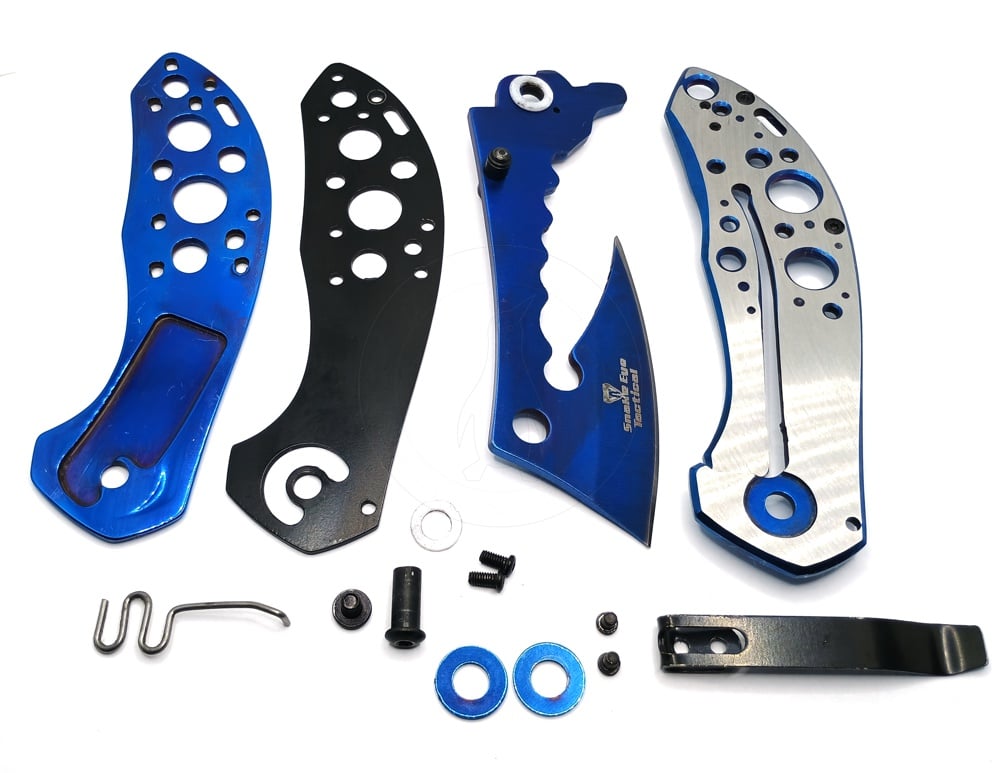
Needless to say I cleaned the bugger very thoroughly on both sides of all of its surfaces before taking this picture.
I will also mention that this zigzaggy spring for the assist action is certainly a novel way to do it, and not one that I've seen before. Maybe I just haven't taken apart enough spring assisted knives.
The CE-5079BL is a weird hybrid design with two handle scales, both steel, but only one liner. It is a frame or body locking knife, with the bent lock portion being on the side that hasn't got the separate liner. I think the liner serves no other purpose than to keep the spring in place, and provide a pocket for it to wiggle around in and do its thing.

Here's the hardware. The shiny blue accents around the pivot are clearly just ordinary flat washers that have had the same bluification process as the other parts applied to them, whatever it is. There's nothing else clever in there whatsoever. The pivot screw is completely round, with no anti-rotation flat. The pivot rides on the customary grubby Nylon washers. And the halves are separated with two shiny but otherwise very basic round threaded spacers. All the screws are the same save the two spacer screws that must pass through both a scale and a liner, and are thus longer.
Oh, and while the pivot screws are probably meant to be T8 Torx head, the male screw on my example actually fit a T9 driver much better. The female side solidly fit a T8. Search me on that one.
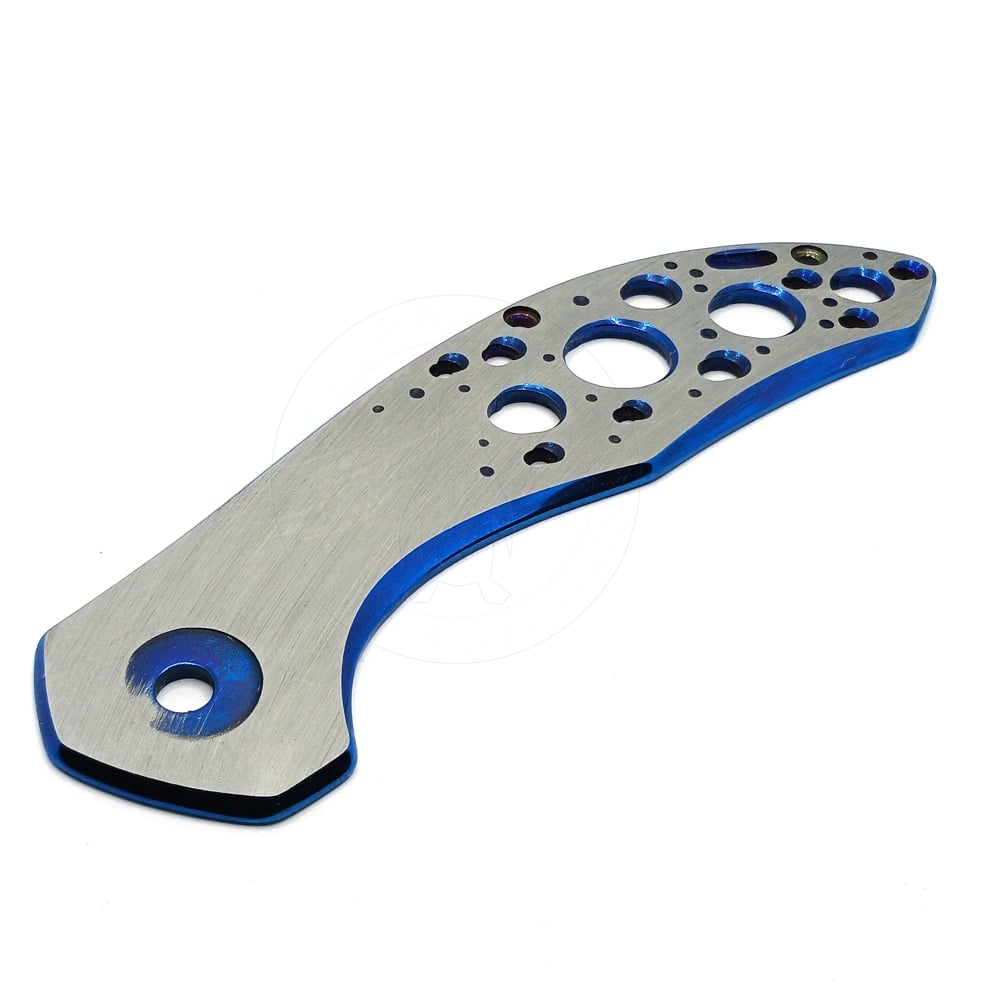
Whatever these are dipped in to make them blue, the process was clearly applied to the entirety of every part. The accent work is then accomplished by machining the rest of the part which exposes the shiny metal underneath. I now know this, because the pocket beneath the pivot screw washer also has this finish in it, albeit unevenly, and despite the fact that it'll never be seen. If I had to guess I would say the handle scales are probably cast, then dipped, then machined afterwards. I can think of no explanation for the weird slope present in that pocket.
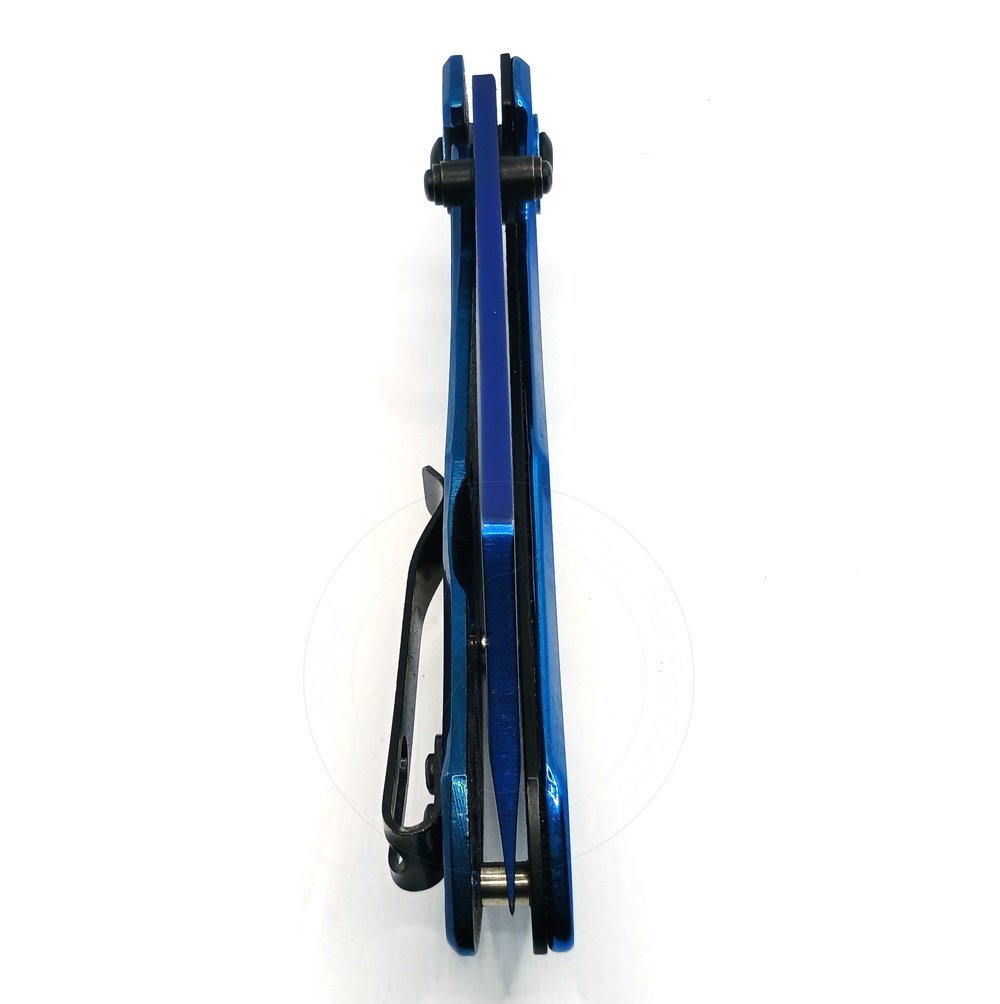
This may go some way towards explaining why the entire assembly is somewhat canted. Not just the blade in the channel, but the entire knife. If you rest it on a flat surface, it just always sits off kilter.
The Summation Or Whatever, Again
There's no getting around it that the CE-5079BL is probably precisely suited to the type of purchaser where it is likely to be sold, vis-a-vis the bong shop.
Otherwise, the blade shape really begs the question of what the heck anyone is supposed to use this for or how. With the tail of it ending in a wicked point aimed right back at the user, this is probably one of those deals where it's just as dangerous for whoever's holding it as anyone else.
It looks cool as all hell, though.
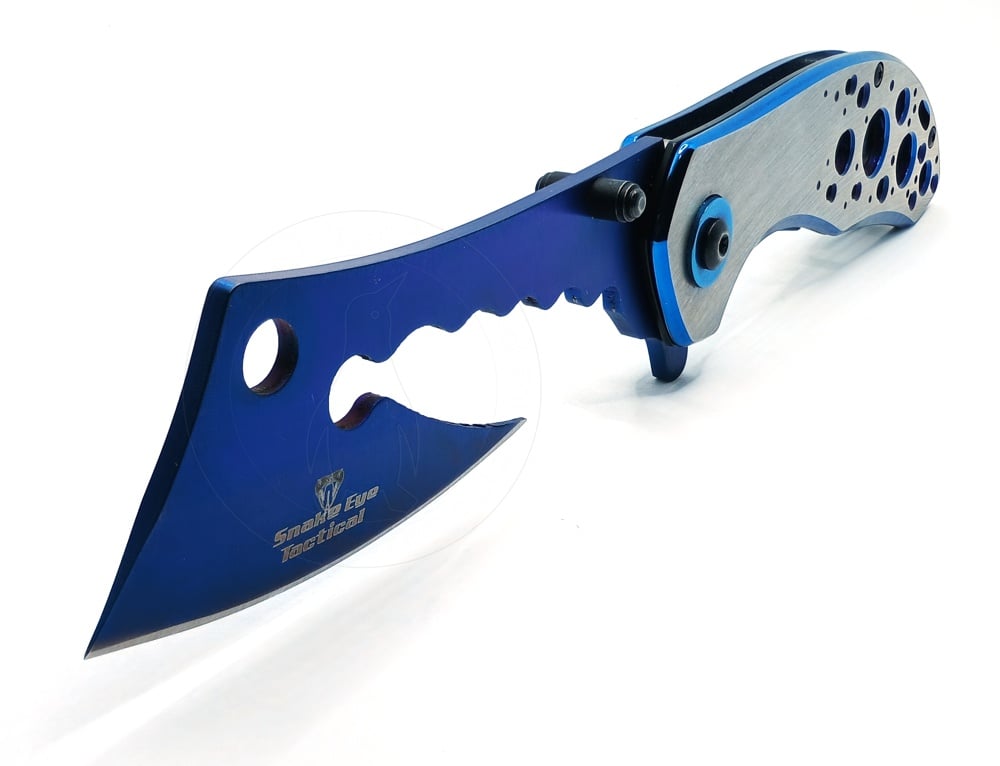
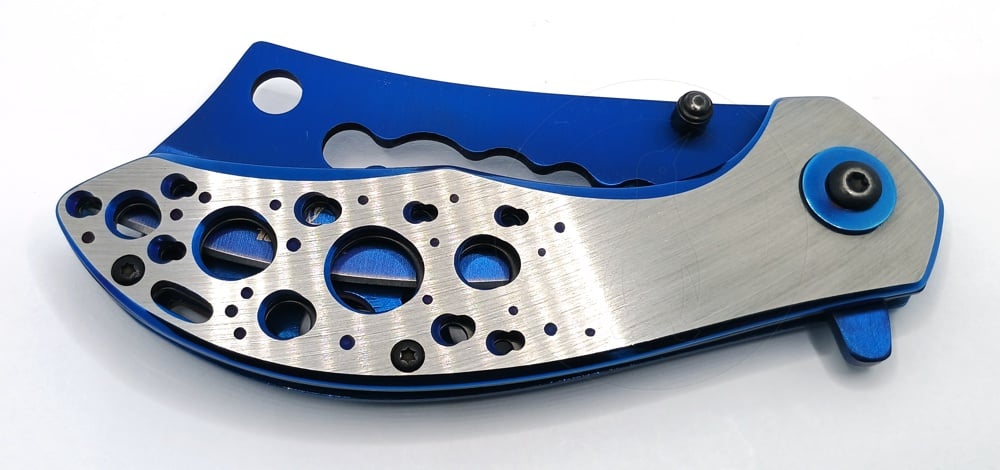
Ring-da-ding-ding-ding-ding-ding-ding...
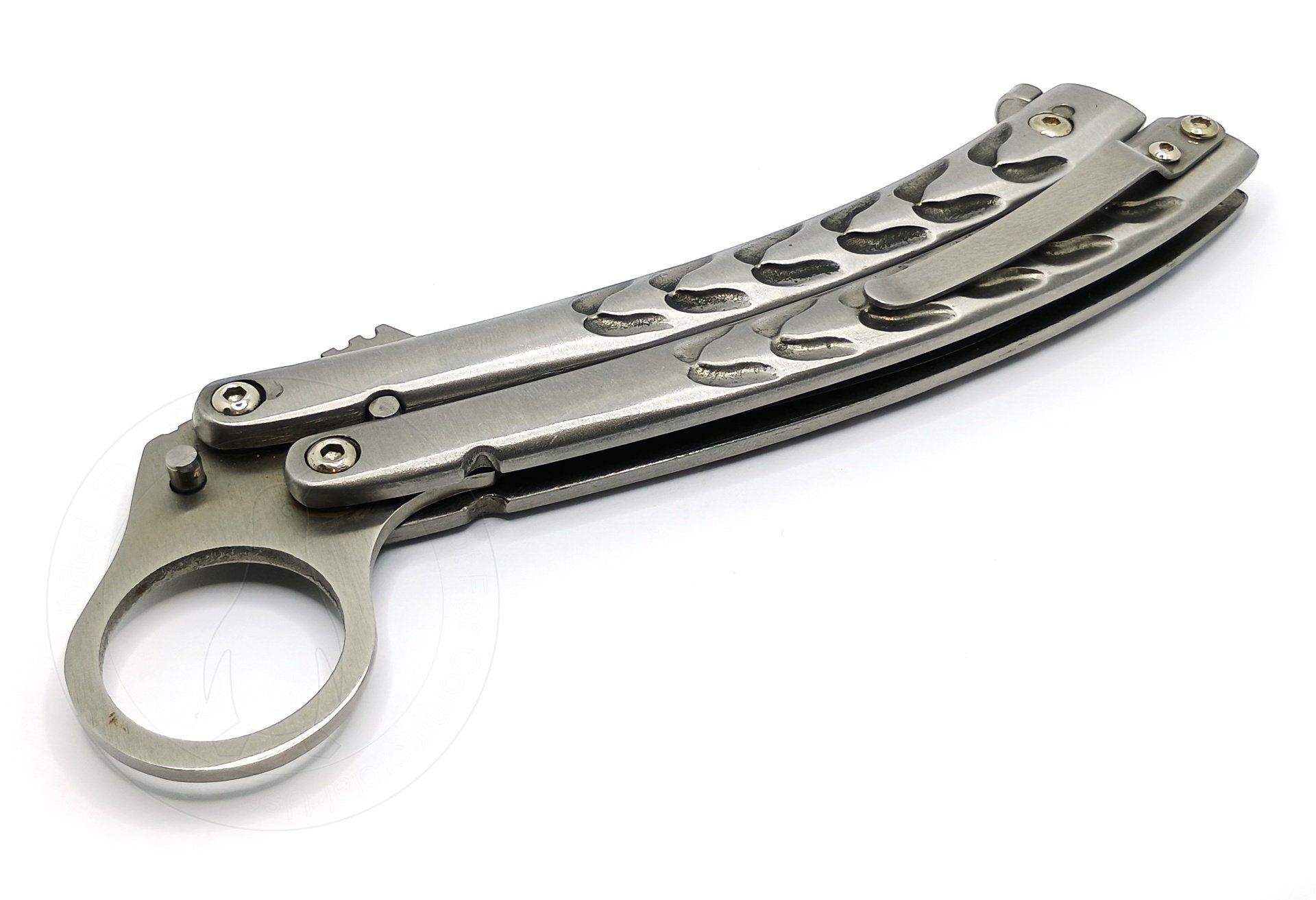
..bom-bom-baaaaaaoo.
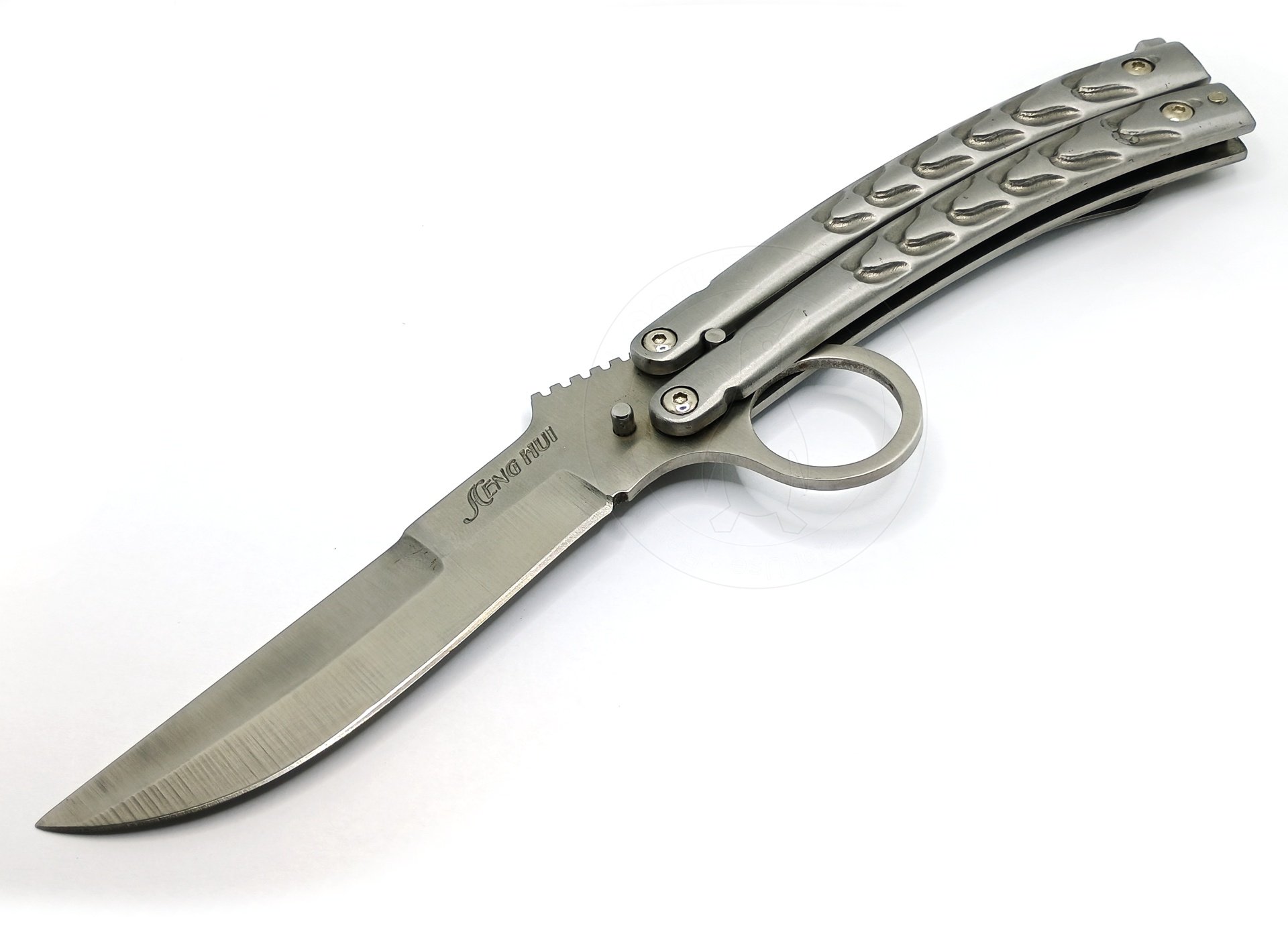
Usually when I show you guys this kind of malarkey I have to sheepishly admit to you that I have absolutely no idea who made it or where it comes from. This time, though, that's not the case. This knife was made by none other than "Heng Hui Hardware Industrial Co., Ltd."
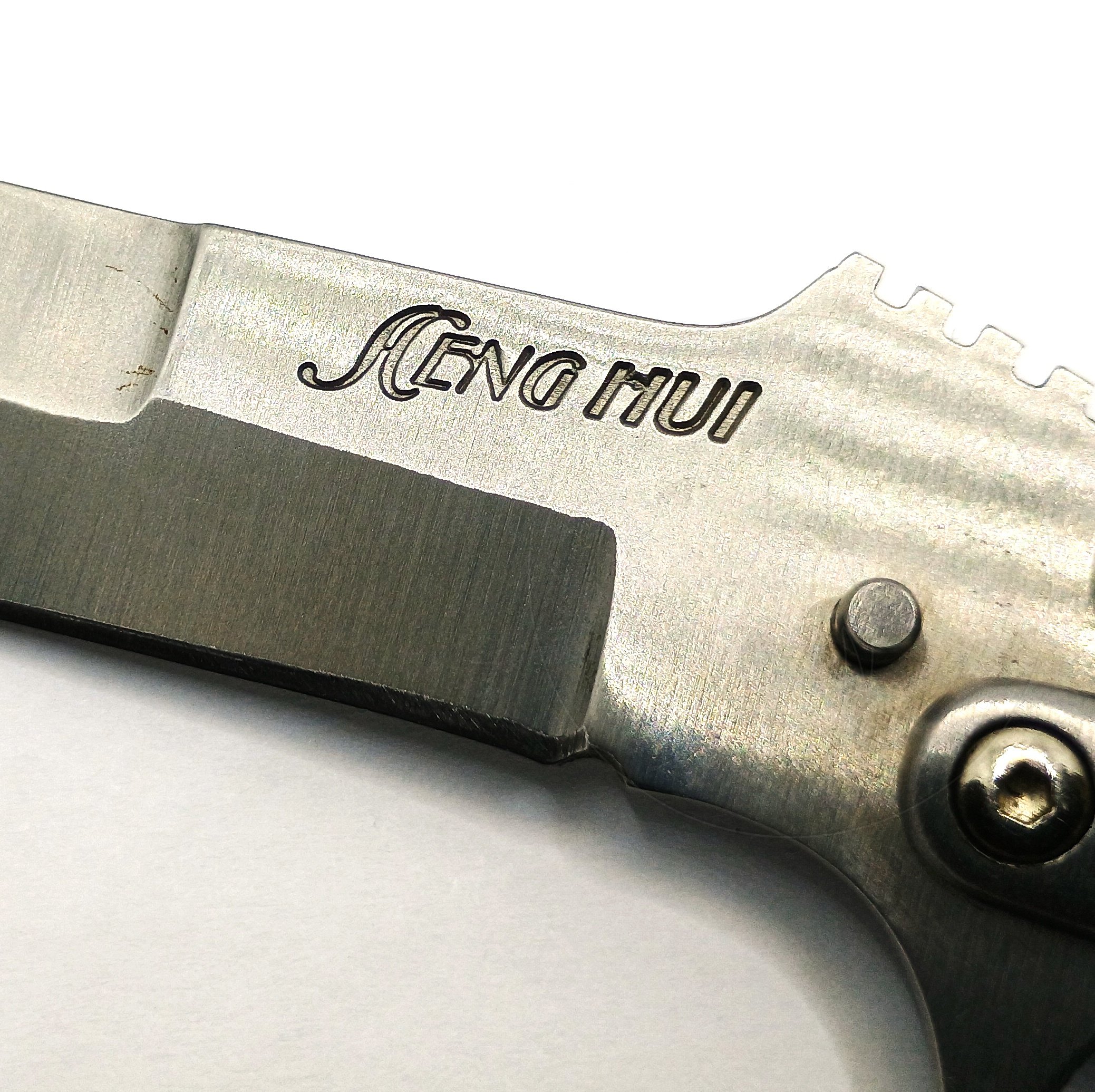
I know this because they were kind enough to stamp it into the blade.
I've probably owned this knife for going on 16 years at this point so in light of that you may be surprised to learn that Heng Hui apparently somehow still exist, and they're still cranking out chintzy knives, among other things. Nothing quite like this, though. Here is clearly their high water mark.
Our little tradition is not completely abolished, though. While I know with certainty who made this, I can at the very least tell you I don't know what its designation is. There's nothing else marked on it. I can't find this knife for sale anywhere anymore except here, which is in Czech, and it's labeled "Z3594." This may or may not be the manufacturer's designation or it might just be the SKU it's sold under on this particular site and therefore means nothing. On this point the internet remains silent, and the trail runs cold. But given that the URL calls it item "1660" instead I think the former is as good a theory as any. So I'm sticking with it. (And while we're at it, just get a load of those product photos. Phowar.)
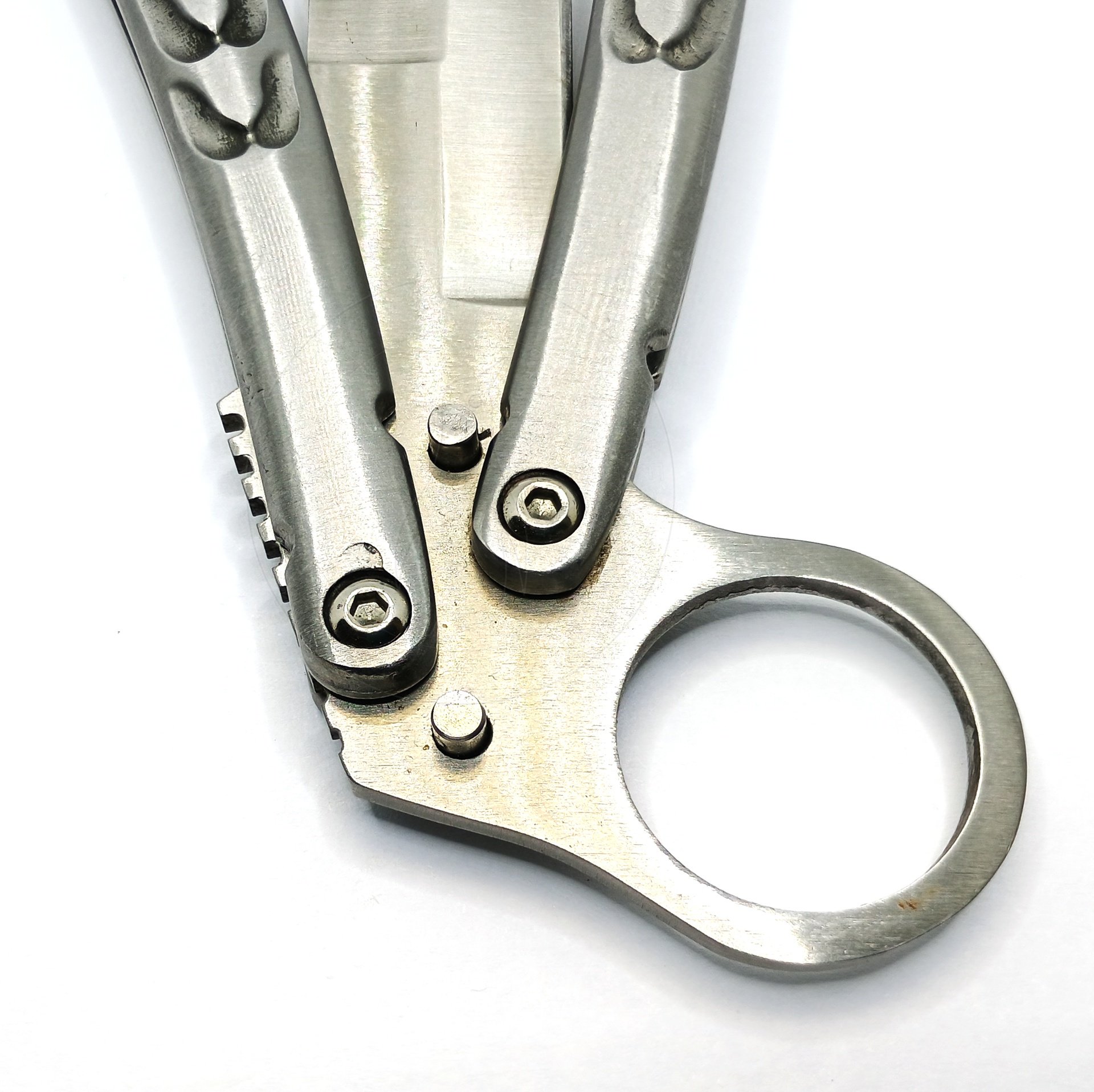
Regardless of what who is calling it where, the Z3594 is obviously a balisong knife. It's got one thing going for it, which is the rather hard to miss ring on the heel of the blade. Obviously I bought it for no other reason than this.
And I know what you're thinking.

Yes, you absolutely can.
The ring is 0.890" in diameter 22.62mm, and it's easily big enough to get a thumb through. This is no dinky decorative drilling, barely suitable for sticking a lanyard through. No, it's large, ostentatious, and ready for you to grab this knife confidently by the scruff of the neck and ninja forth with it right the fuck into the night.

To assist in this, there actually is a pocket clip on the other side which is a surprising inclusion. As usual it's on the wrong side of the handle, but I can excuse it this time because it keeps the ring positioned away from your pocket seam, which realistically is the only way you're going to get this thing in your pants anyhow. And all that said, the clip works well and feels pretty good. I can't even come up with something incisive and sarcastic to say about it. It's fine.
You might think at first blush that the ring would get in the way when you're flipping this thing around, but it really doesn't. The Z3594 is actually competently designed in that respect, which is a thing that sounded much less absurd before I saw it written down just now. You'll note that the ring is actually positioned such that at rest it's on the bite side handle, which is not the one you're normally manipulating. The extreme curve throughout the whole knife allows the pivots to be very offset and that also keeps the ring out of your way during normal operation. Once you get the knife fully open, though, it's right there in the perfect position to get your index finger through.
Update: All of the above is surely because this knife appears to be a clone -- albeit not a perfect one -- of Terry Guinn's "Ring Fighter," which was a short production run semicustom (20 or 39 units, depending who you ask). Thus any design competency present is certainly borrowed.
And, competently designed is not to say that the Z3594 is competently made.
Because it isn't.
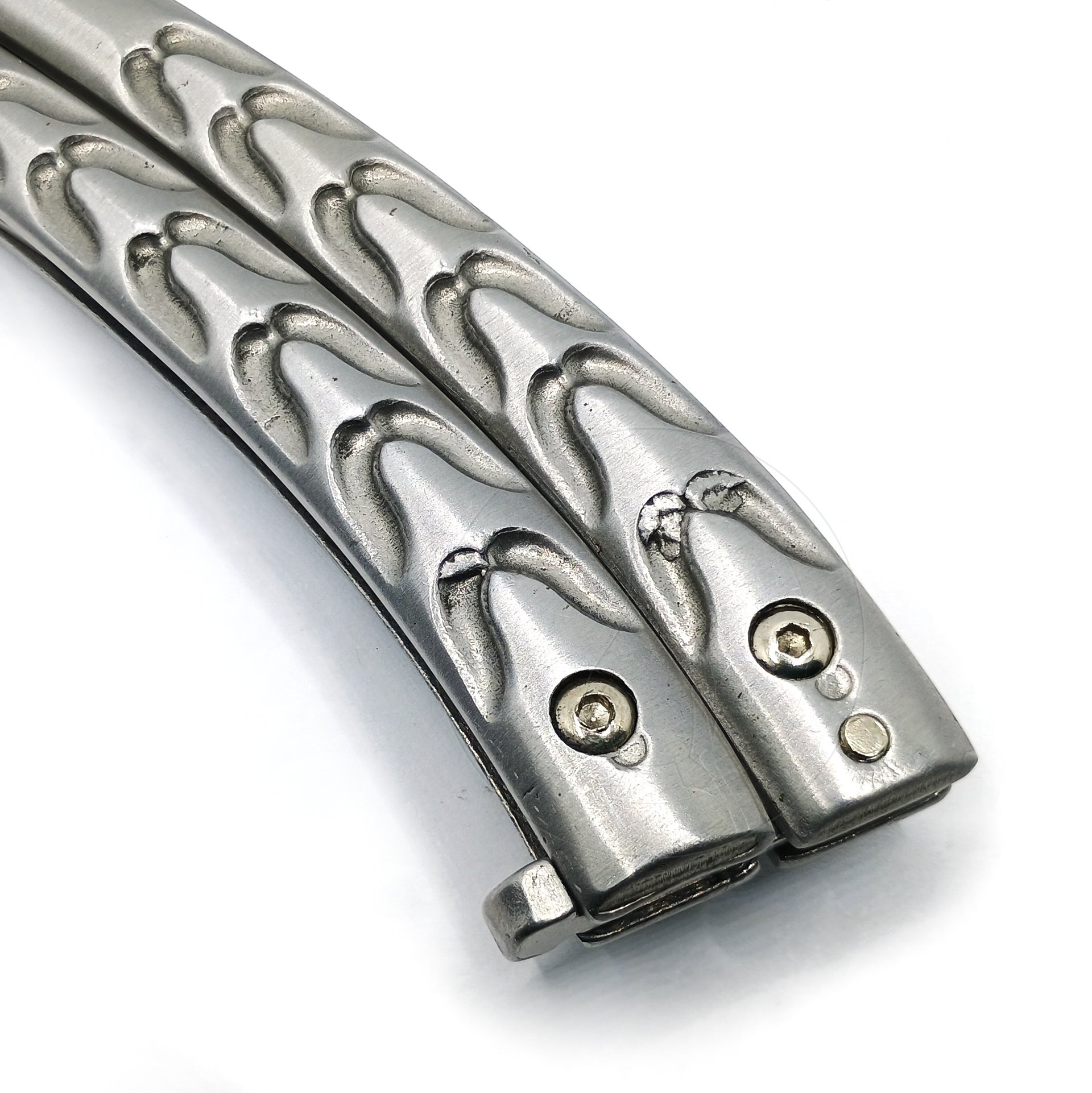
For instance, these casting flaws are really rather laughable. My granny could do a better job casting the metal in a pot on her stove.
I have no idea what that pattern is supposed to be, either. A row of bunny ears? Deer tracks? Kamina's sunglasses? Beats me.

This is definitely a throw back to those good old/bad old days when every piece of Chinese cutlery you were able to lay your hands on could be counted on to be a source of never ending hilarity. The handle slabs are clearly cast, so it's a puzzle how they also managed to utterly fail to manage to be flat at least on one side. The tips of both handles where the pivot screws go through exhibit this pronounced flare, which can't be improved with any amount of dicking with the screw tension, no matter how hard you try.
Thus, then, as you would expect the pivot action is very, er, free. And it is, because the entire thing rattles like a pair of castanets. It's a red letter day indeed when I can say that a balisong fails so hard at the wiggle test...
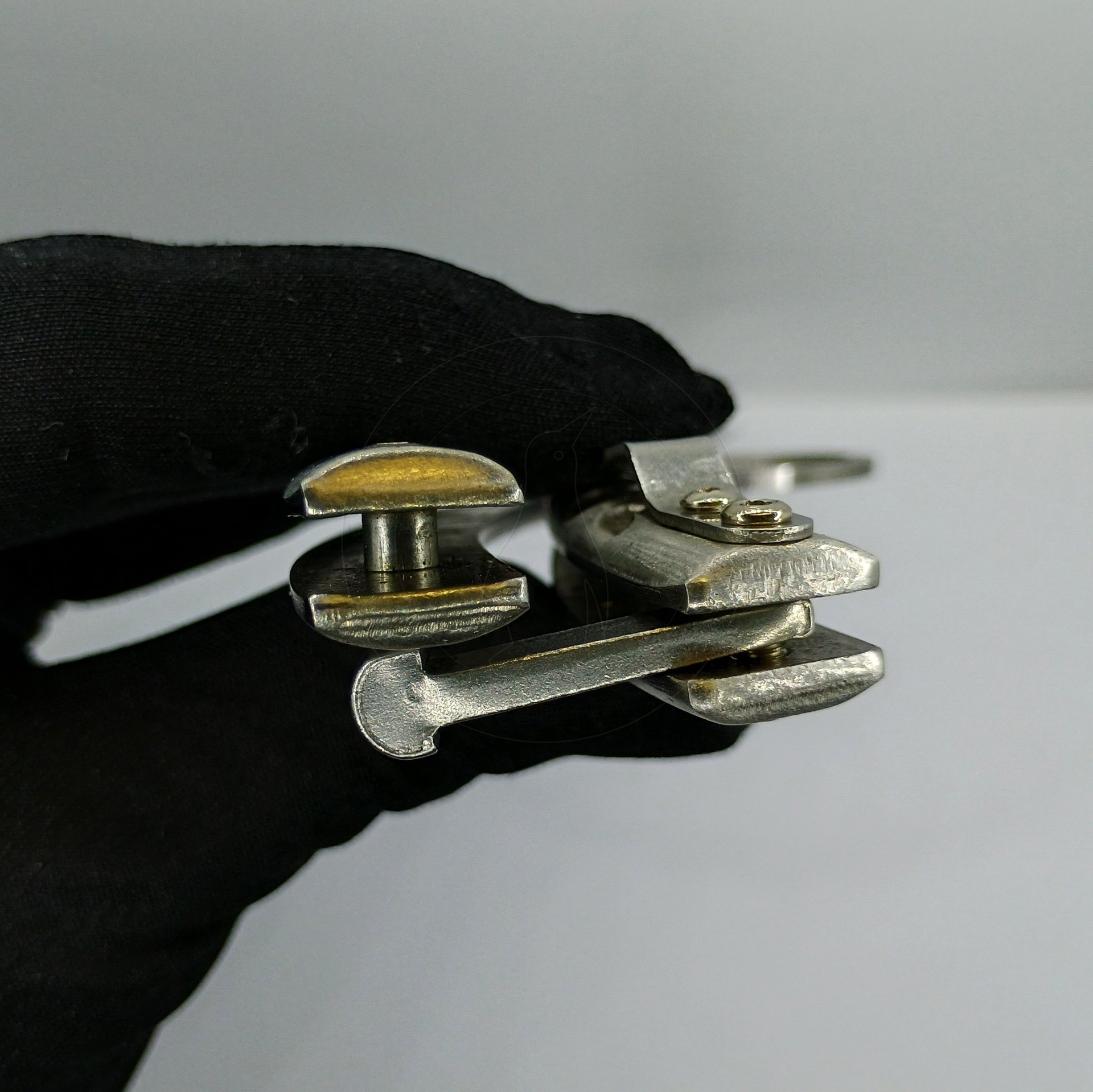
...That it's not only possible but downright trivial to cause the latch to miss the opposite handle entirely.
But never mind the quality. Feel the price. I don't know how much I paid for this back in the day, but it was surely less than $10. You couldn't pry my wallet open for anything more even if you had a crowbar ninety feet long.
Of course anywhere there is machine work it is visibly crude. There are no sharp edges on the metalwork other than the cutting one, the one that's supposed to be there, but as an example the inner surface of the ring is more than a bit rough and I'm convinced its shape is actually stamped rather than milled. It works well enough, but feels distinctly unrefined and could probably benefit from with a pass with a Dremel -- a job which I've been putting off for all these years. And plan to continue to do so.
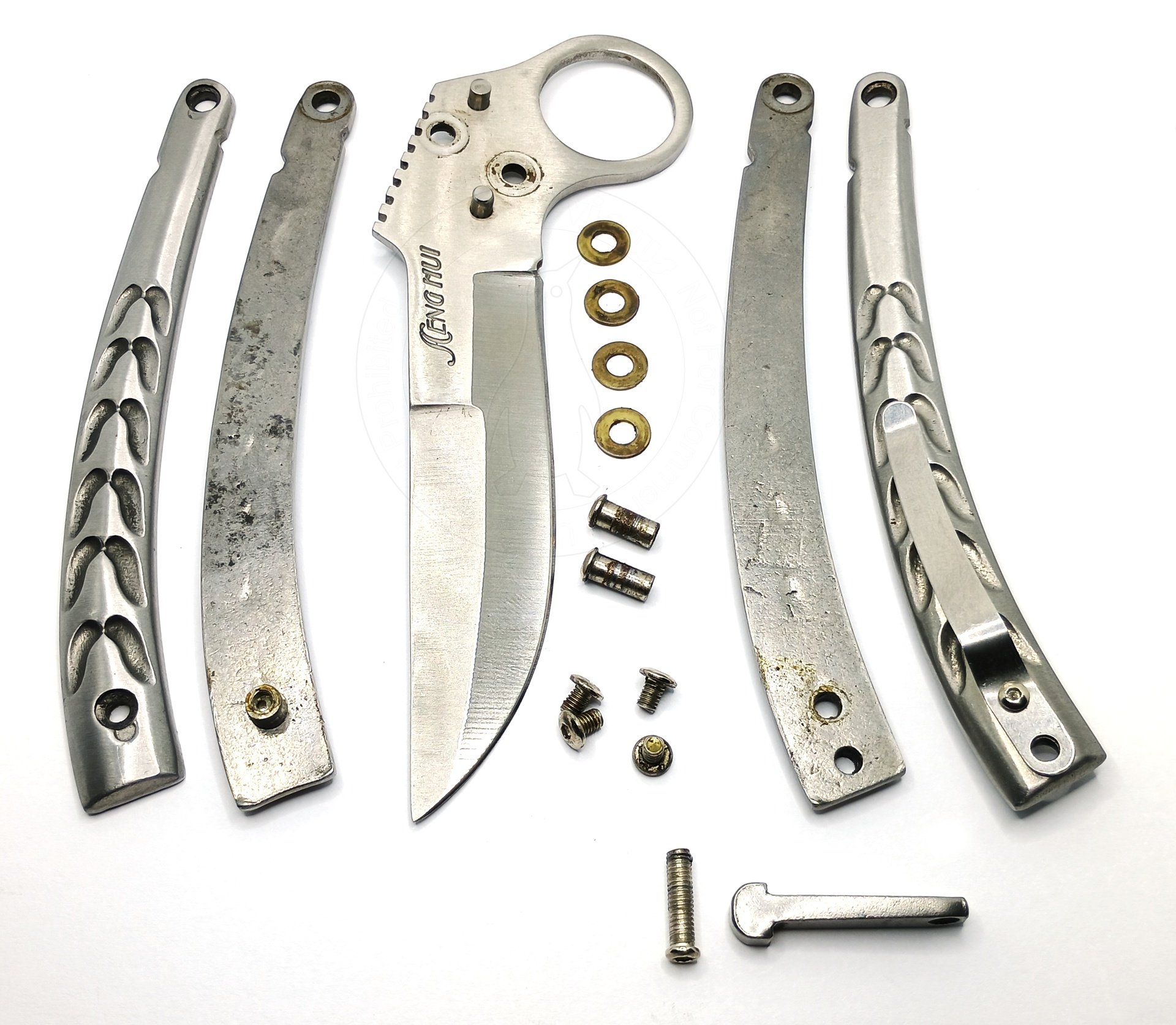
Since I have a reputation to uphold around here I think I am obliged to provide you the above, so I did. For archival purposes, I left all of the components exactly as filthy as they were when delivered.
The Z3594 actually wasn't too tough to take apart at least to the point you see here. This despite its best efforts, up to and including all of its screw heads being not Torx like we've become accustomed to, but rather Allen heads which manage to not quite properly fit any size bit I own -- neither metric nor fractional inch.
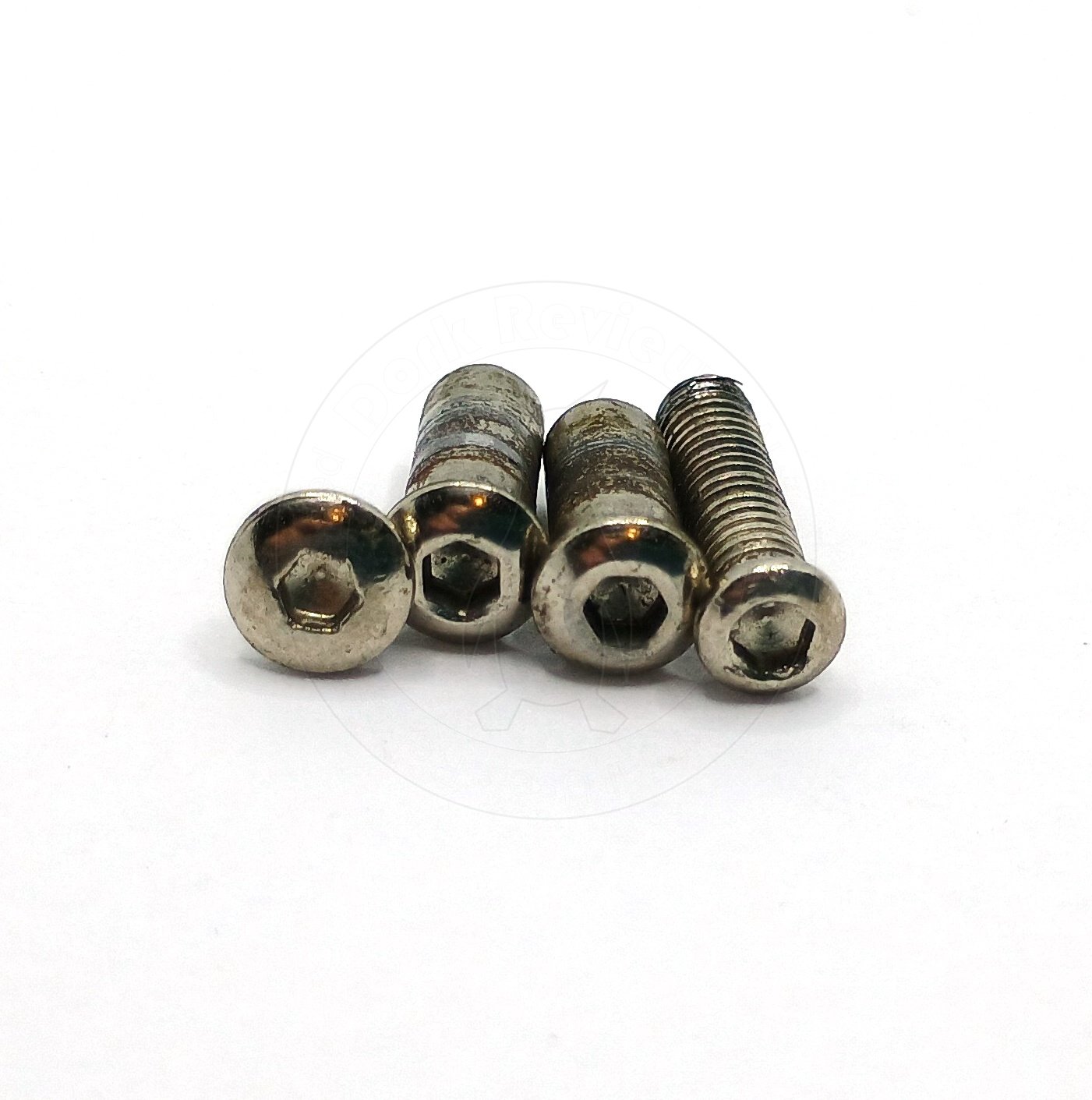
The screws came prefastened from the factory with one of only two torque values: Finger-tight, or irrevocably cranked. Luckily for us, enough of them were the former that I was able to get all four handle slabs apart and extract the blade. The knife is spaced out by two Chicago screws forming the pivots, and one simple threaded barrel on each handle, down towards the tail. Among the screws that would not come out were one of each of the spacer screws, and one but not the other of the screws holding down the clip -- which helpfully arrived pre-stripped from the factory.

Here's a lineup of... most... of the hardware. No fancy features are evident whatsoever. No anti-rotation flats on the pivot screws, no fancy decorative screw heads, no springs, not even any pins.
The blade rides on what are easily the grimiest plastic washers I have ever seen in my life. At first glance I thought whatever is all over them might be graphite, if we could be so lucky, but I think in reality it's just dirt. Some of it could be cleaned off. Most of it couldn't.
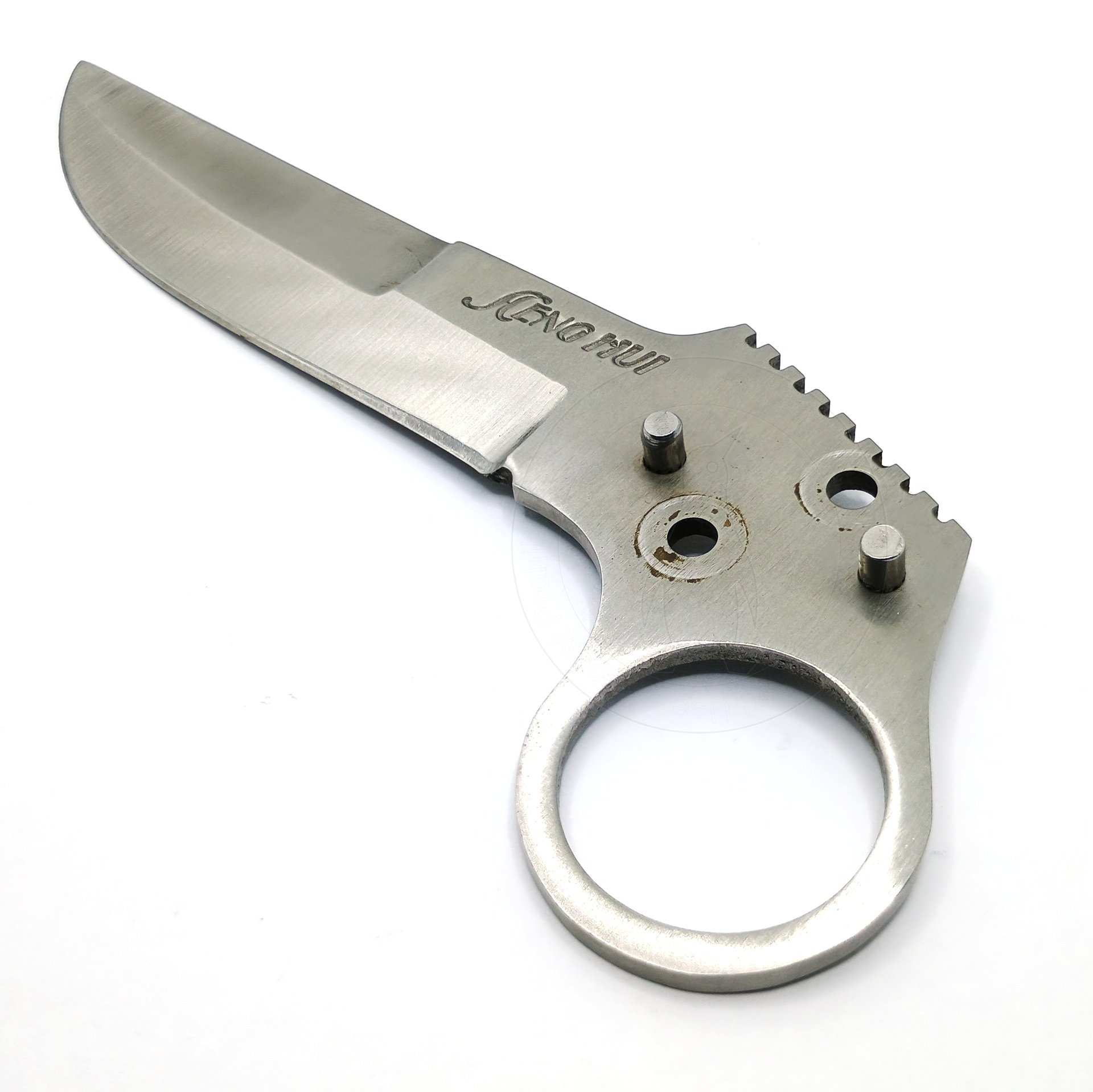
The blade works thusly, and when it's dismounted you can see how offset the pivot points are from each other to accommodate the high Banana Quotient present in the assembled knife. Strangely, the press job on the kicker pins is actually pretty good -- among the better examples I've seen on flea market grade cutlery, actually. Weird.
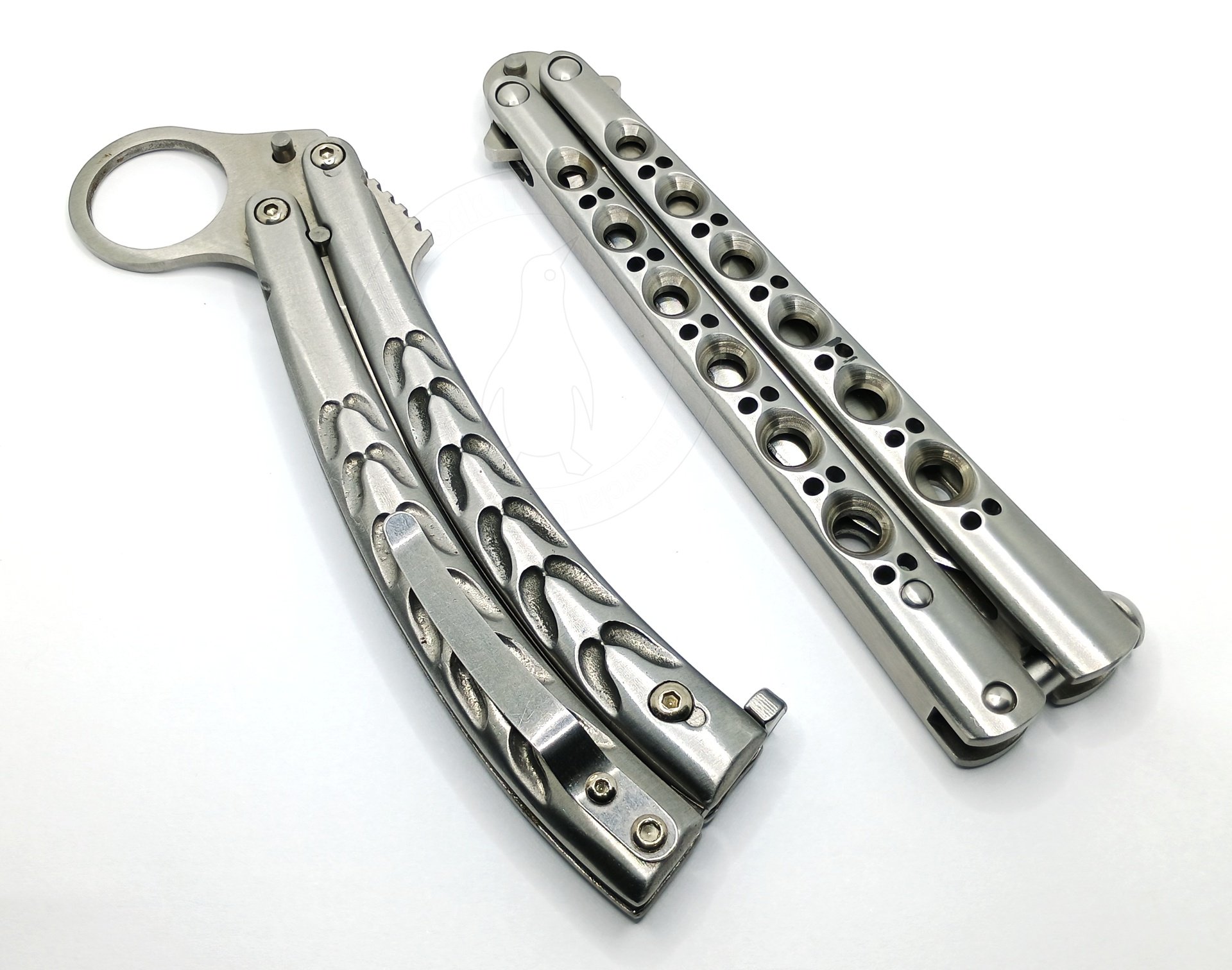
Above: You, versus the guy she tells you not to worry about.
The Z3594 probably wishes it were a Benchmade Model 42. It's probably got pinups of it all over its room, and spends all afternoon listening to Depeche Mode and Morrissey while wistfully gazing into a mirror at itself and halfheartedly doing curls using weighs made of balsa wood and leaded Chinese paint, dreaming one day it might grow up to be half as good.
Proportionally, it looks as if somebody took a Model 4x, clamped it in a vise, and whacked it with a hammer until it bent. From the tip of the tail to its forwardmost kicker pin, it's almost exactly the same length as from the tail of a the Model 42 to its tang pin. That can't be a coincidence.
All in, the Z3594 is precisely 6" long. Open it's 9-1/8", and the taking of both measurements is confounded in no small part by the radical curvature in it when it's both open and closed. The blade is 3-15/16" long measured from the tip of its scimitar-like profile to the forwardmost point on the nearest handle, with the one near the edge winding up noticeably closer to the front than the other one by the time it's open. The blade is 0.098" thick or 2.51mm, and is made of an unspecified alloy which is presumably stainless. Being entirely of low-tech materials, it weighs a not inconsiderable 197.8 grams or 6.98 ounces.
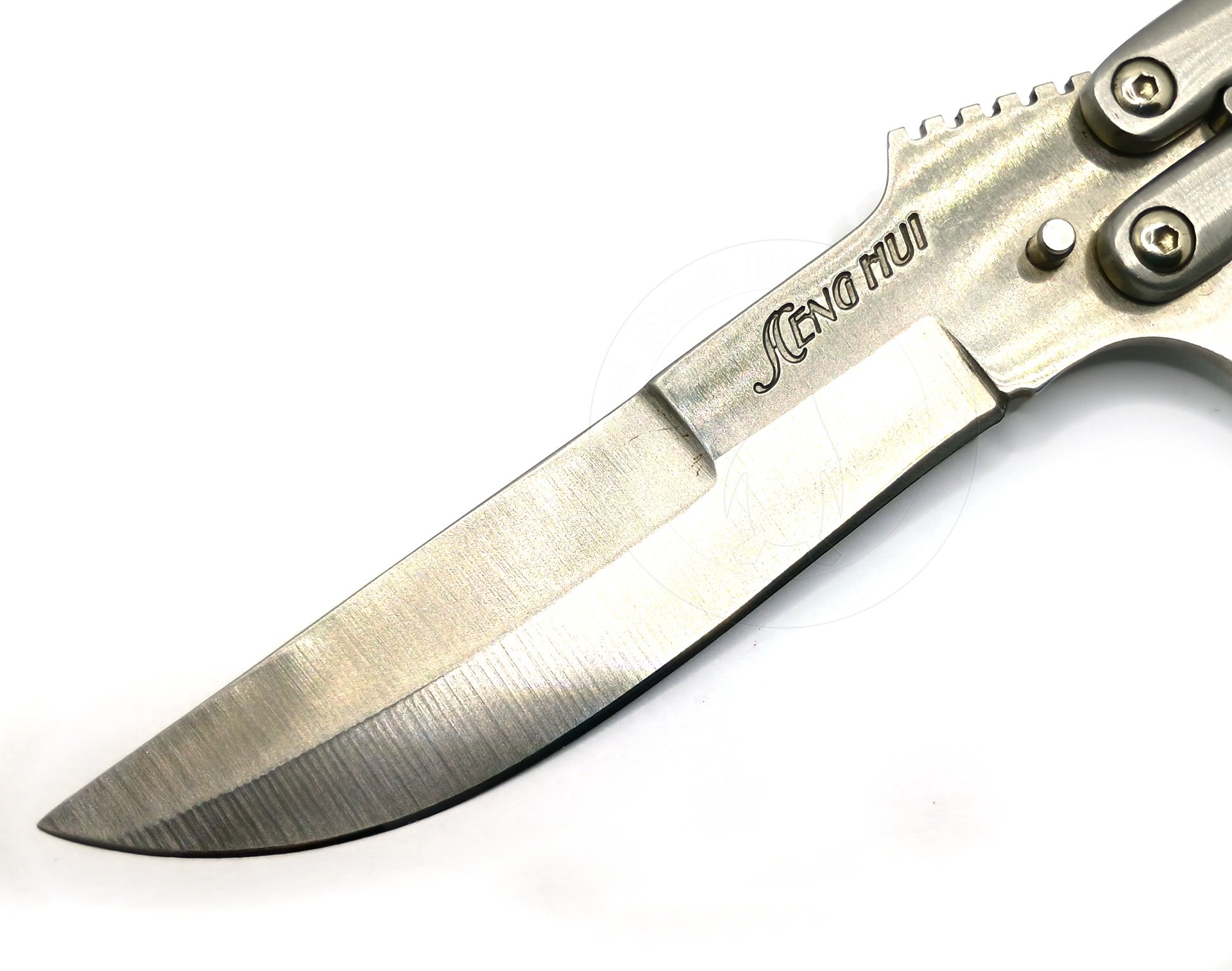
The taper is hollow ground -- the cheapest kind of grind, of course -- and exhibits those ratty old machine marks we all know and love by now. I can't say anything about the edge because mine is not original. Perhaps unwisely, I elected to sharpen mine some years ago. I didn't put a lot off effort into it but alas, what was once the crude and sawtoothy original factory edge is now lost to time forever. However shall we cope.
The Inevitable Conclusion
There is a Venn diagram. On the one side, the Illustrious Pantheon of Knives with Cool Rings In Them. On the other, objects purporting to solve problems that most likely don't actually exist. Somewhere in the middle rests this knife. I couldn't tell you exactly where.
"Hey kid, do you find your balisong knife too hard to hold onto? Of course you do, nerd, that's the point!"
So maybe it's not built very well. But despite everything stacked up against it, the little Heng Hui actually manages to do something kind of special: In the world of balisong knives, it brings something genuinely new to the table. The ring might be silly but so are balisong knives in general, really, when you step back a bit and look at it. I won't go so far as to say that there are "myriad" ways you can use the ring to add to your repertoire of spinning tricks but there are certainly at least few, and thus there are things you can do with this that you can't do with most other balisongs. That's got to count for something.
It's just a shame that it's... you know.
Crap.
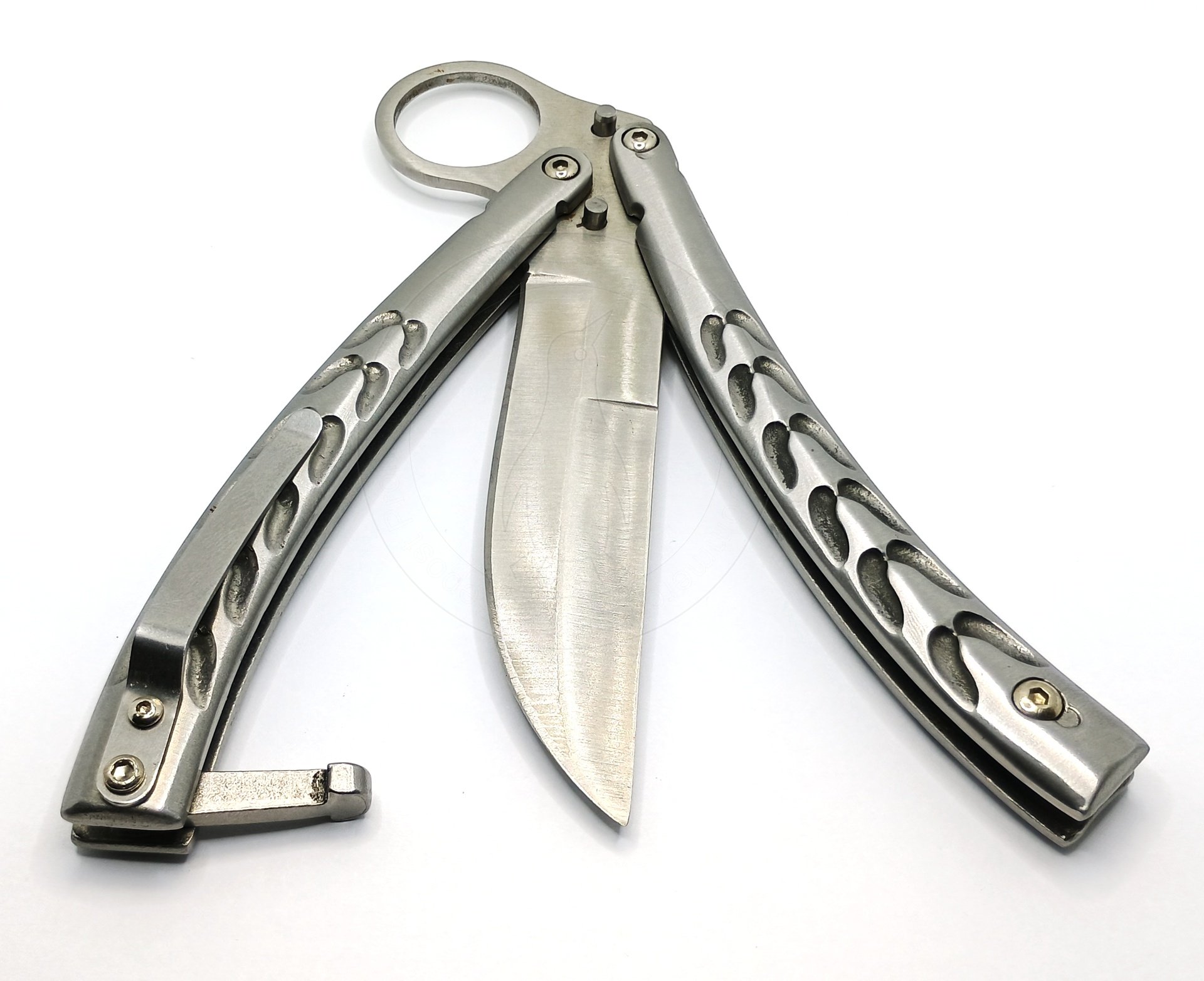
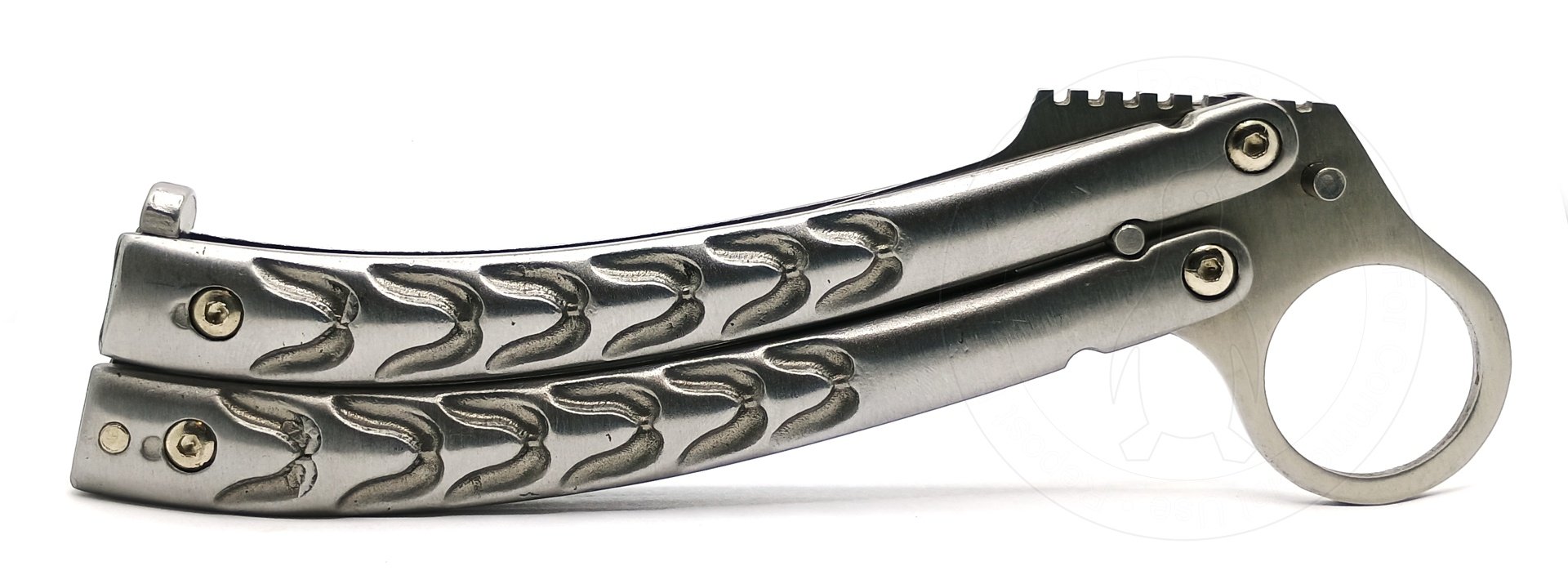
This, ladies and gentlemen, is the CIVIVI Typhoeus.
(Gesundheit.)

No, the Typhoeus is actually named as far as anyone can tell after the monster from Greek mythology. You know the one -- so tall his head brushed the stars, controlled the wind and breathed fire, had snakes for a butt.
What?
No, really.
Anyway, this incarnation of Typhoeus is not, in fact, so large it brushes the stars. It's actually pretty compact for what it is, which is a 6-1/4" long fixed blade knife shown here in stylin' purple, with a very modern looking upswept drop point blade that's 2-3/8" long. It weighs 81.1 grams or 2.86 ounces, making it quite light compared to many other fixed blade knives.
Actually, no. A fixed blade isn't quite what the Typhoeus is. But it's not a folder, either. In fact, it's kind of hard to describe just what it is, which I guess is exactly why it's here.
You see, it has a trick.
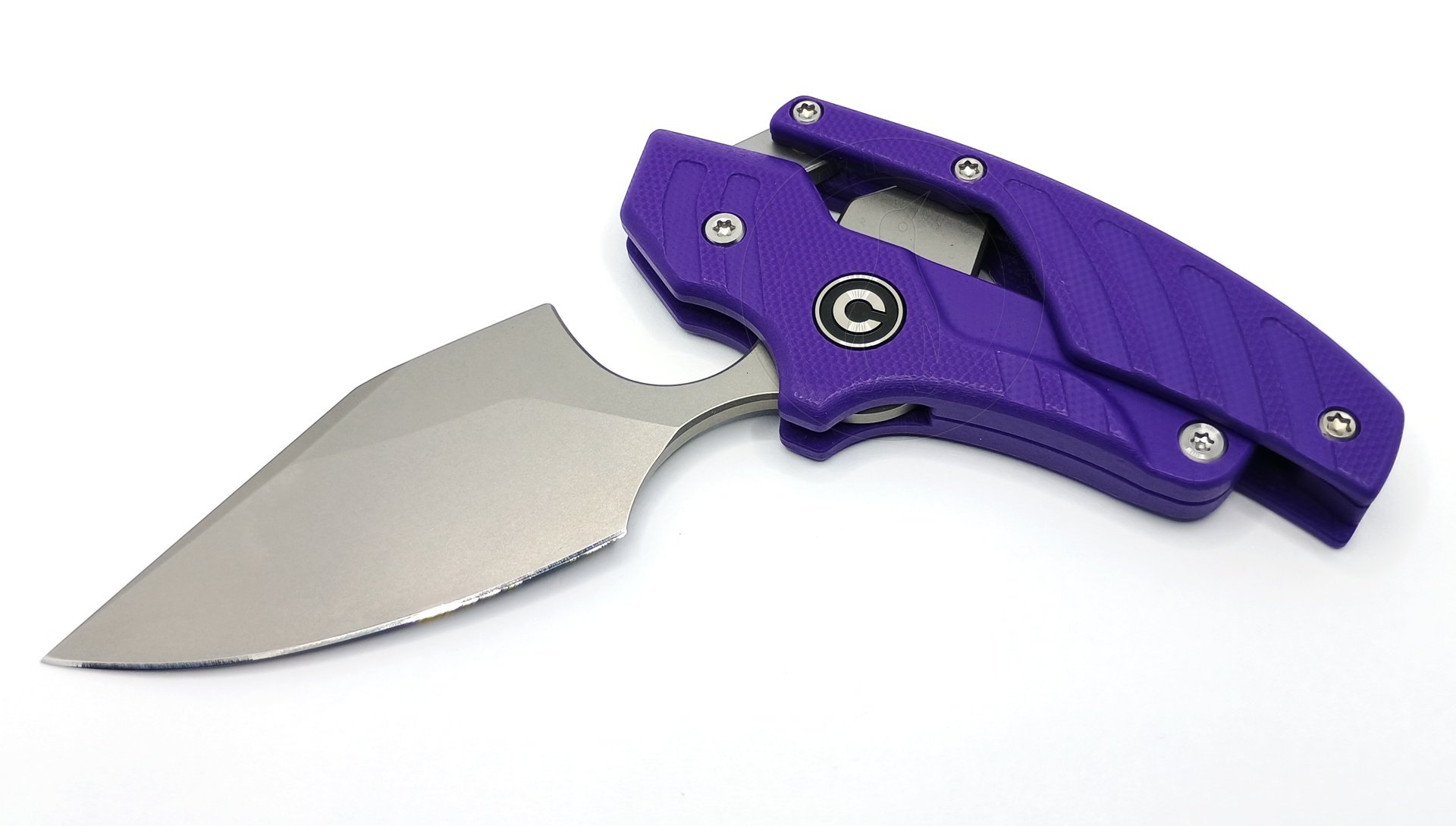
Thanks to its articulated handle, it transforms before your very eyes...
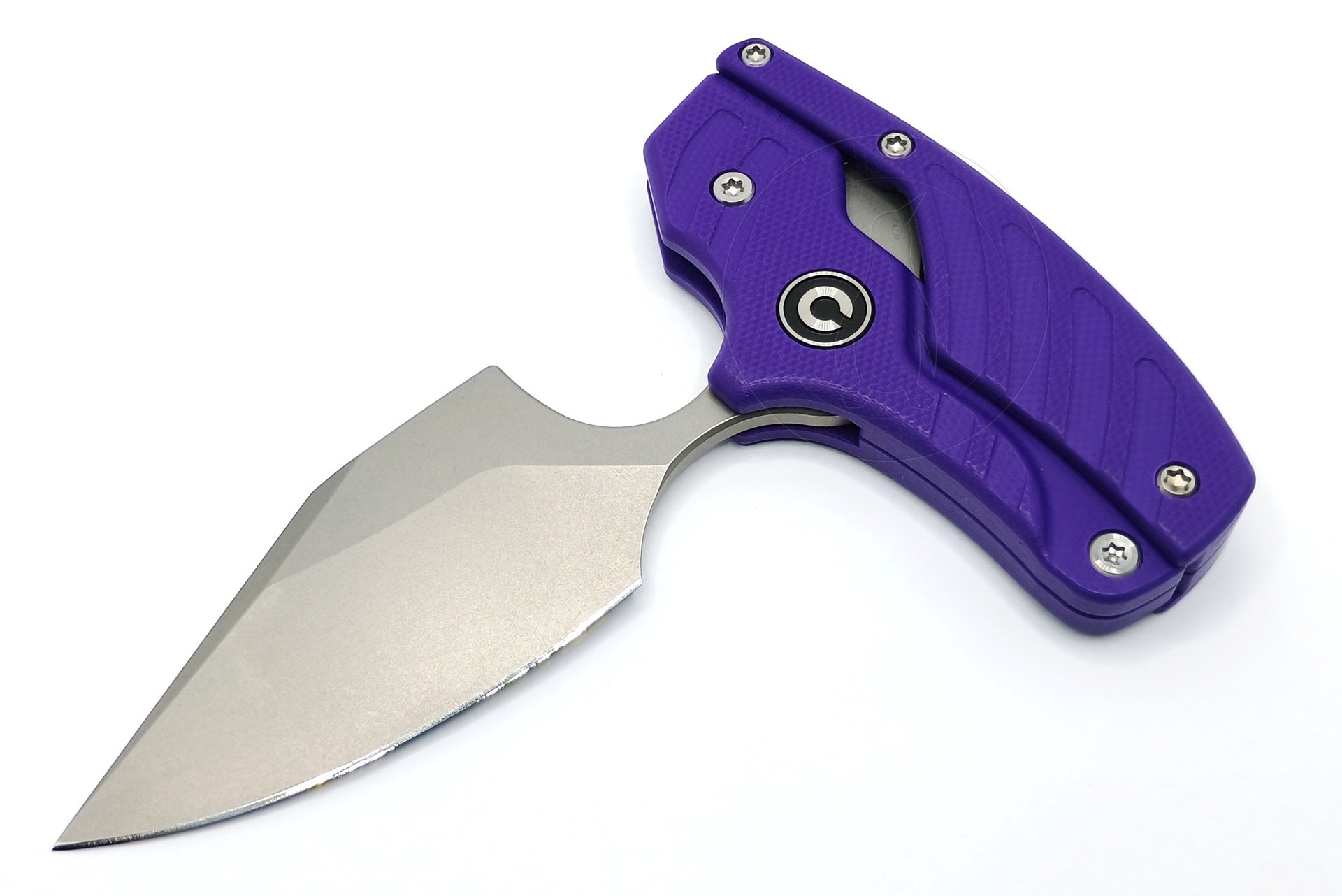
Into a punch dagger. (Yes, another one.)
Well, "dagger" is the wrong word, too. It's only single edged. But still. Can your zooty Zero-Tolerance-Benchmade-Emerson-5.11-Strider-Chris-Reeve even do that? I submit to you that it cannot.
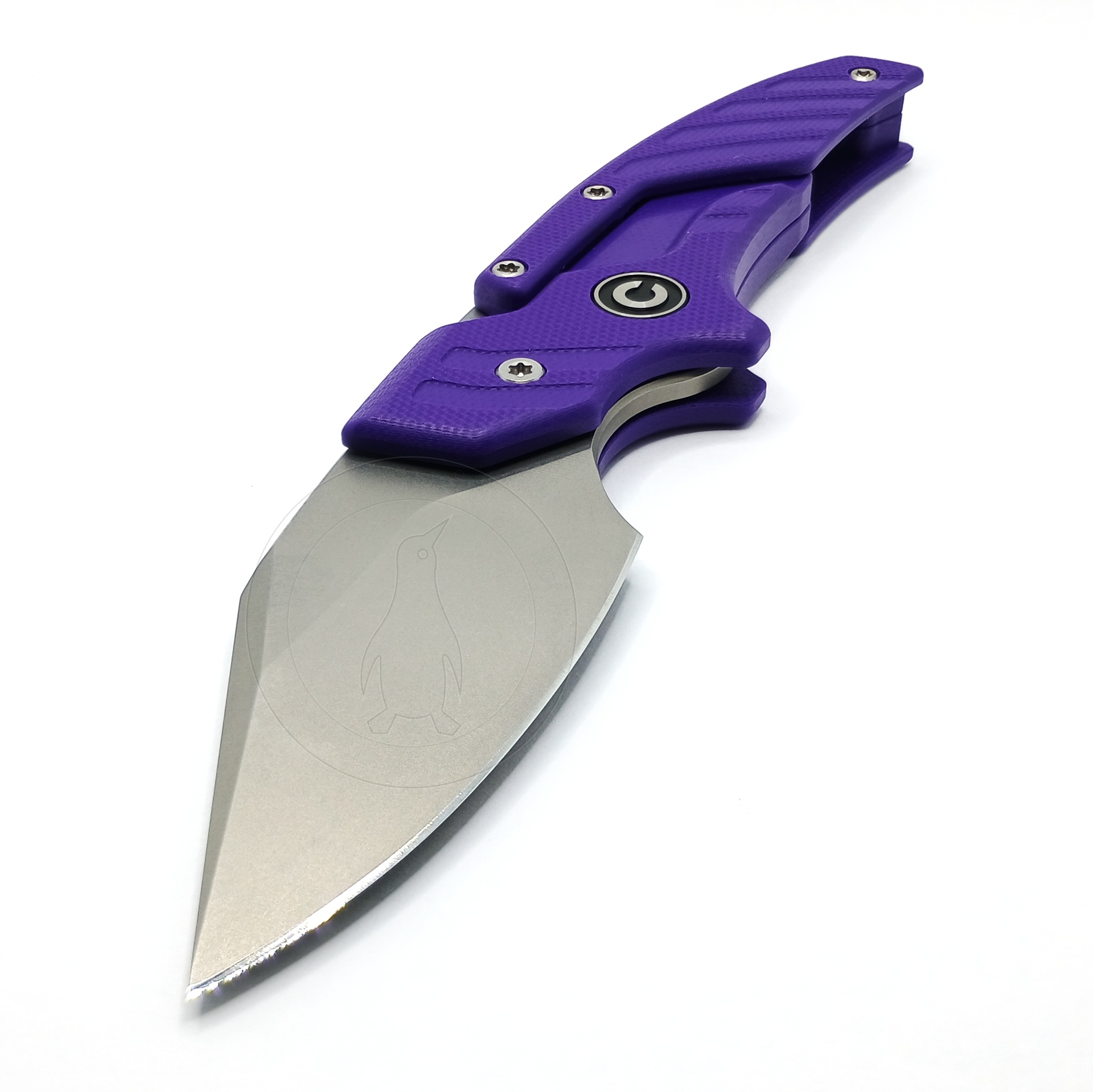
CIVIVI themselves call this an "adjustable fixed blade knife," which I guess is one way to describe it.
Mind you, that's because the one thing it doesn't do is fold. Well, okay, it self-evidently does because you just watched it do so. But it doesn't, like, fold fold. Not in such a way that the blade can be packed up within the handle.
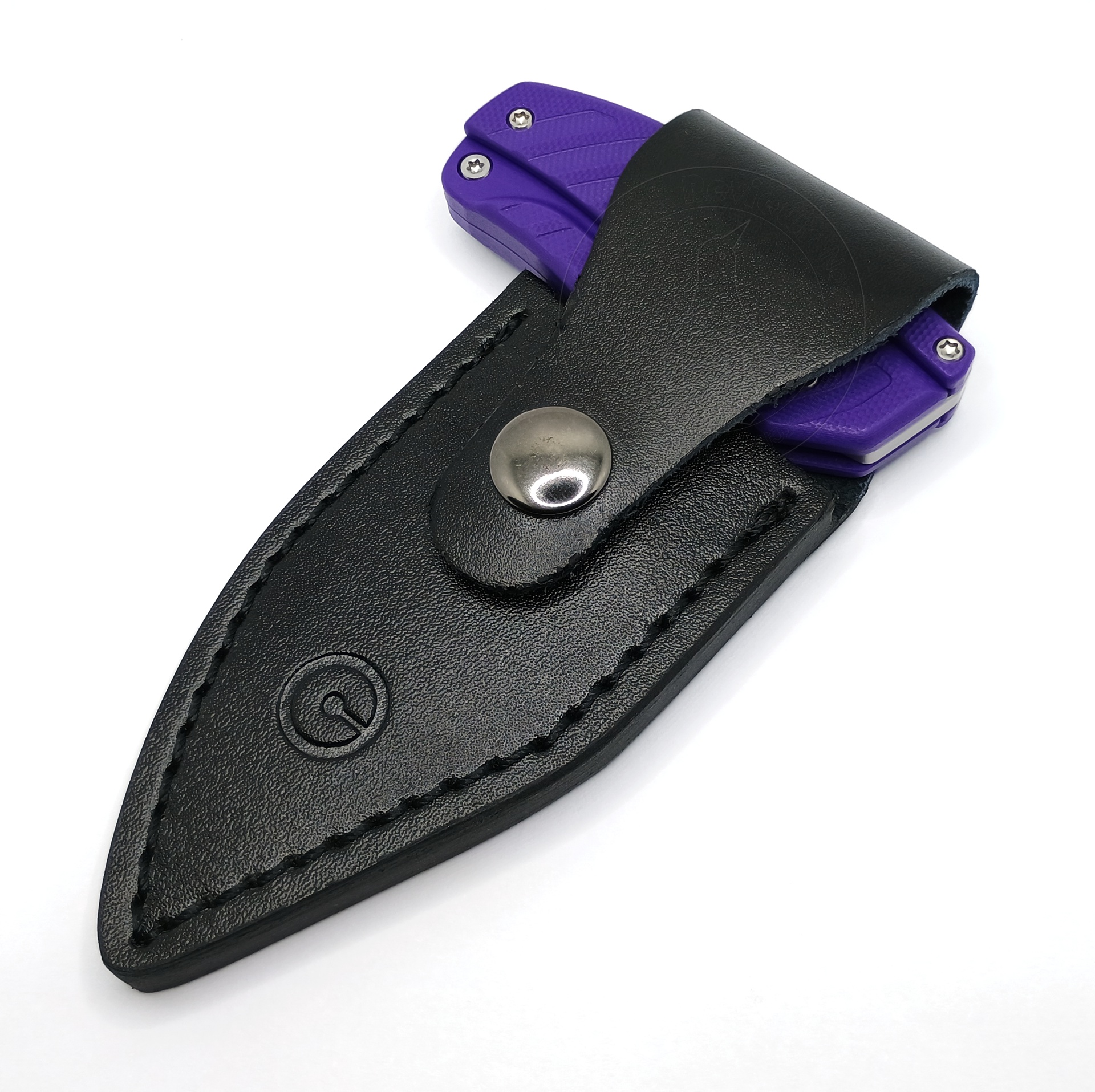
Therefore it comes with this leather sheath, which despite being decently made is unfortunately is rather horrid in how it's designed. That's a shame, really, because the Typhoeus itself is actually pretty well built. The sheath holds the knife only in its punch-dagger configuration, and you can either pull it as such or give it a little twist when you draw to convert it into its traditional mode in the process.
But the sheath is one of those ghastly fold-over retention flap jobbies with a chunky crude button snap on it, which makes it impossible to draw quickly and just plain old annoying to draw at all, what with the damn flap getting in the way and the snap scraping you and knocking against everything. Undoubtedly it would be better served by an injection molded or Kydex sheath with some kind of passive retention. But it hasn't got one of those, at least not from the factory, and not until I can be bothered pressing my own. So despite superficial appearances this is not in any way a self-defense knife. On the bright side, storing the knife in its punch configuration shortens the overall length considerably to just 4-1/2" (albeit now at 3" wide) which means it won't stick up as far to poke you in the ribs while you're carrying it. If only CIVIVI marketed this as a selling point. Instead, they don't seem to mention it at all.
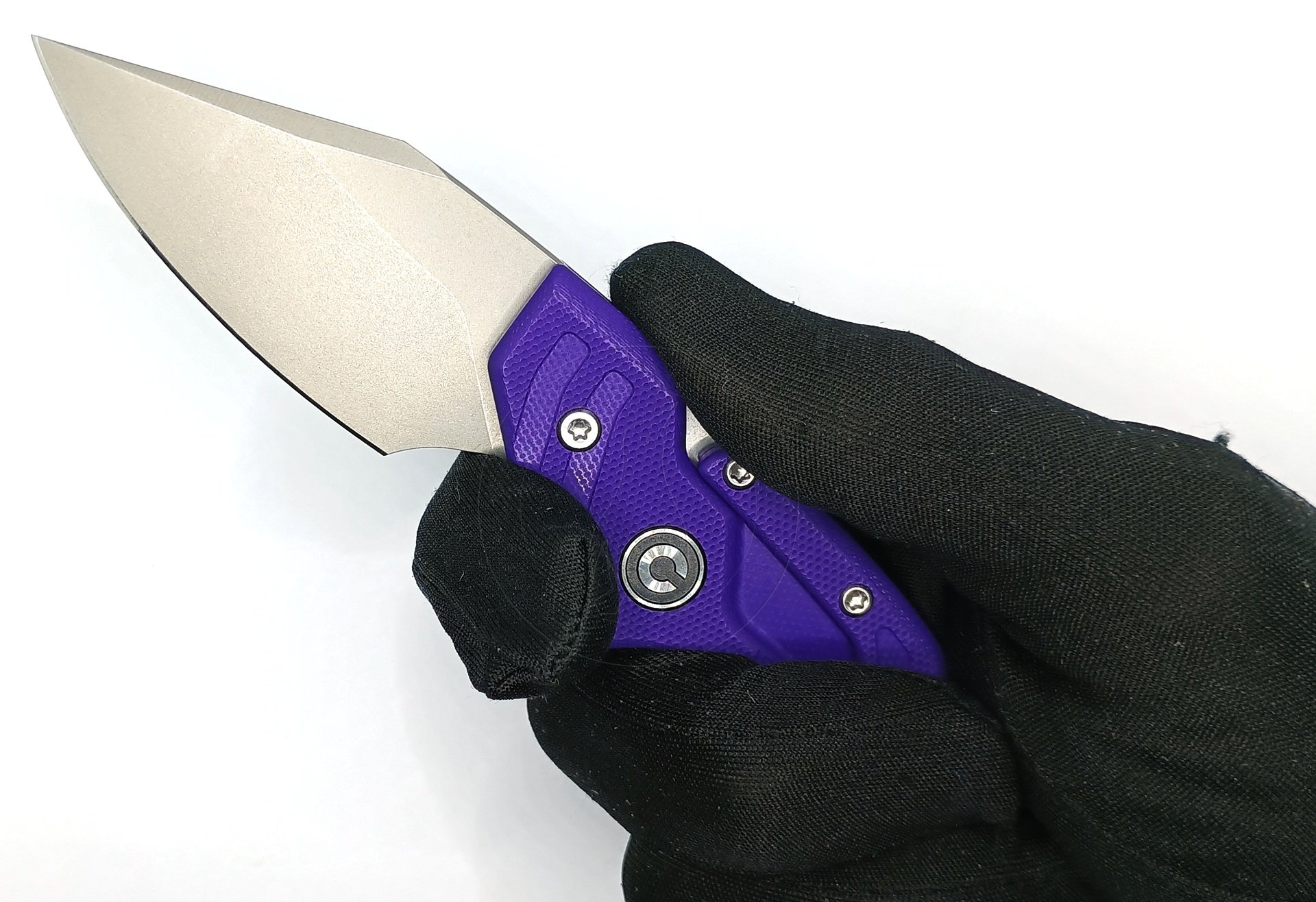
The Typhoeus' blade is, depending on how you look at it, either a design sans ricasso, or is one of those hip and trendy "all choil" dealybobbers. When you're holding it in what's for lack of a better word normal knife mode, your index finger goes in that space naturally. There is no jimping anywhere on it but the G-10 handle slabs are both milled and textured, so keeping a hold on it isn't too tough and its design lends itself to easy controlability. The upswept edge has a cutting profile that presents the entire length as a functional belly, making it quite usable.
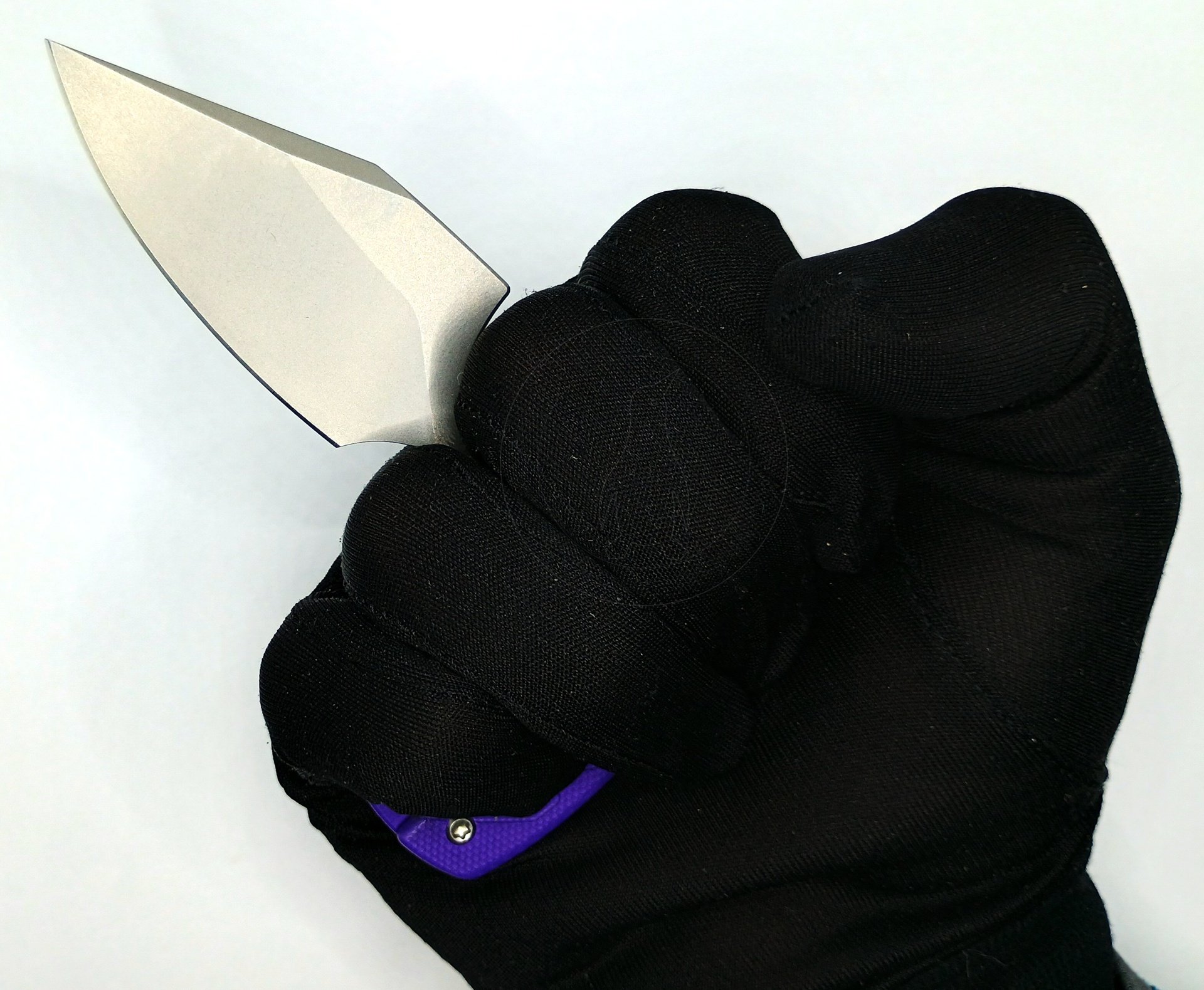
In punch dagger mode, a narrow tang is revealed behind the bulk of the blade which goes in between your fingers like so. The ensemble is not symmetrical and the blade is noticeably offset in the handle. While you can hold it either way 'round you'll probably find it more comfortable to have the shorter end of the handle towards your thumb, which is how it will naturally fall if you switch it from the traditional grip to punch dagger configuration anyway.
The lack of a ricasso does present a bit of a problem here, though, because it's easy to nick yourself with the corner of the blade at its base. Even moreso if you're trying to get a grip on it in a hurry, which is probably a further ding against it for self-defense duty. I probably wouldn't want to use it as such, anyway -- there are much better options available.

I was going to take the Typhoeus all apart but I decided at the last moment I couldn't be arsed. The pivots do ride on bronze washers, though, which you can see peeking through the gaps. In total it has four pivot points, with two linkages between both handle halves.
The pivots don't present any perceptible wiggle at all, and the mechanism moves quite freely, to the point that you can just flick it back and forth between modes. This is sure to amuse anyone to no end.
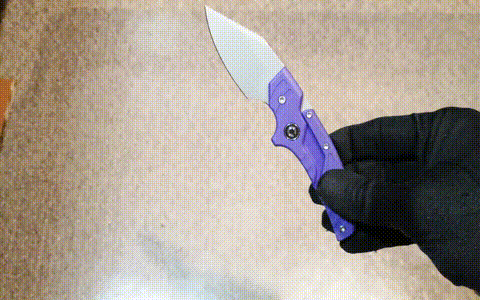
Well, it'll amuse you to no end, and annoy all bystanders in the process. That sounds like a win/win to me.

The Typhoeus' action does not lock in either position. What keeps it there is your grip on the handles, which cam themselves together as you squeeze. Notably, pressing on the spine of the blade with your thumb does make it want to start folding up, and there's probably no jimping there specifically to discourage you from doing that. Keep your fingers instead on the handle itself around the scales and it's not going anywhere.
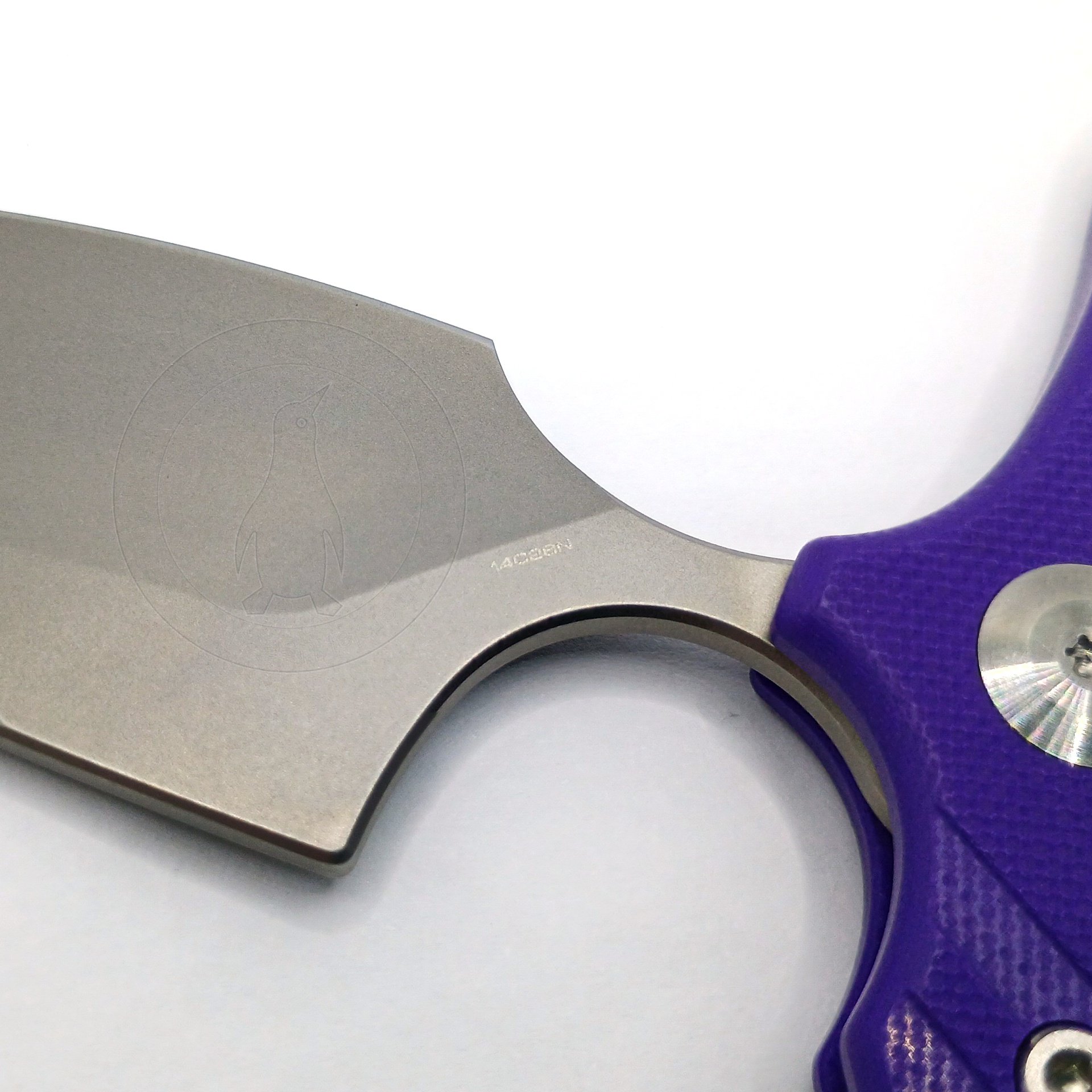
The made is made of 14C28N steel which CIVIVI take great pains to point out as Swedish. Despite this it is still very much made in China. The blade is 0.119" thick, and I am very pleased to report that it's flat ground. It has an attractive satin finish on it, and bears no markings other than...
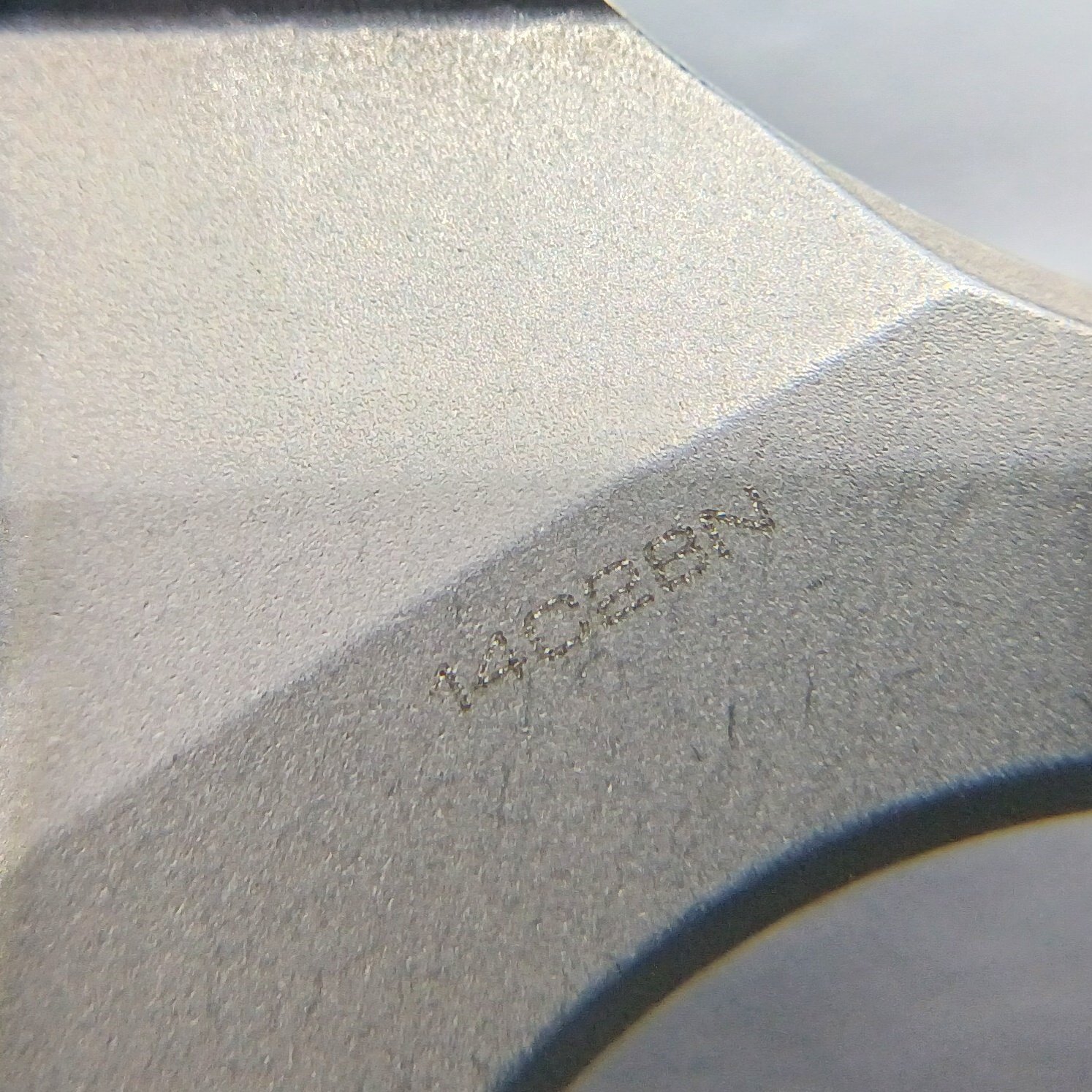
...This nearly microscopic steel descriptor laser engraved into it. It bears no other inscriptions or maker's mark, although it does have CIVIVI's "C" logo as an emblem on the head of the center pivot screw:
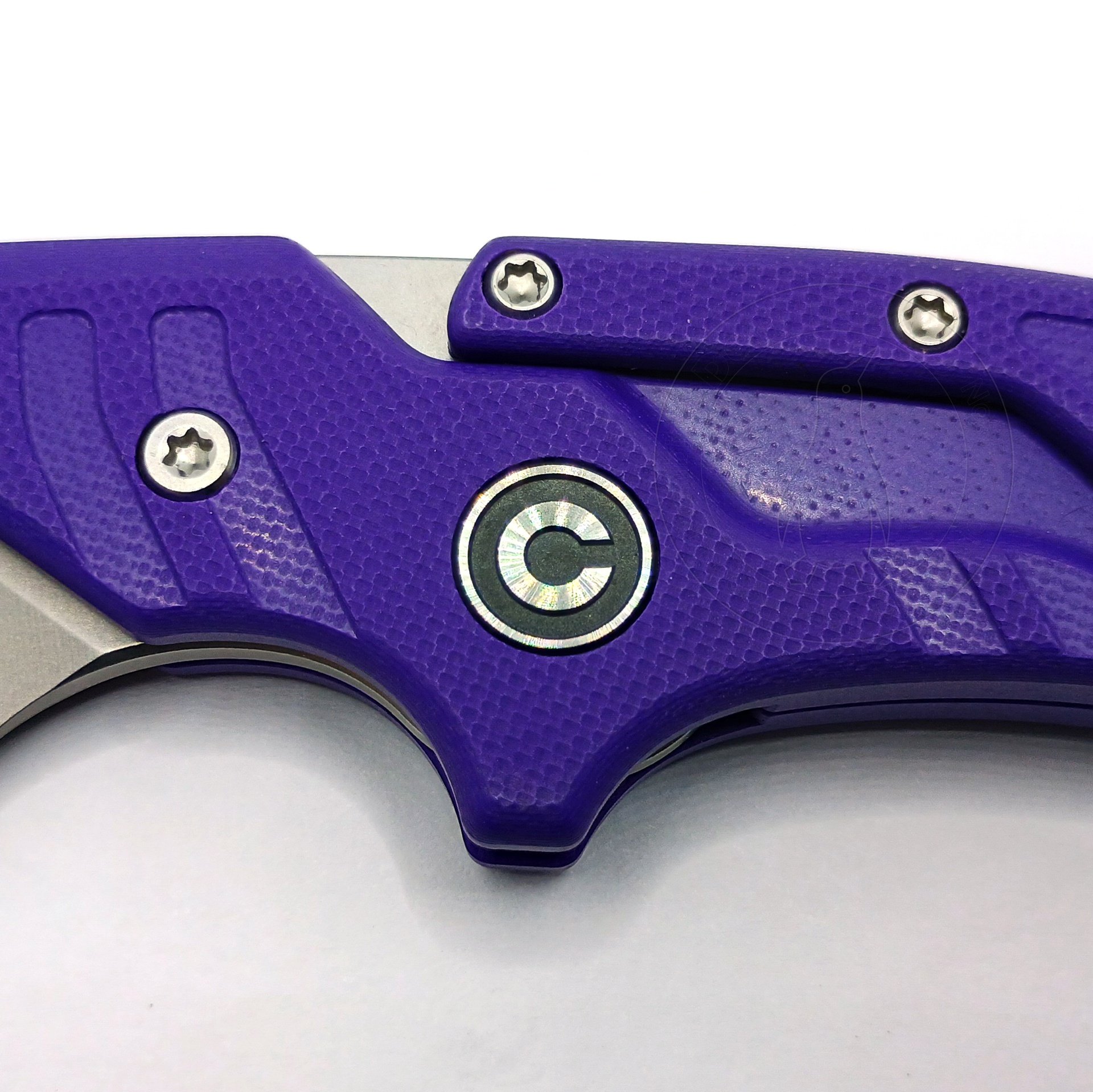
The Typhoeus is quite compact for a "fixed" knife, as evidenced by how much smaller it is even than a bog standard CQC-6K.
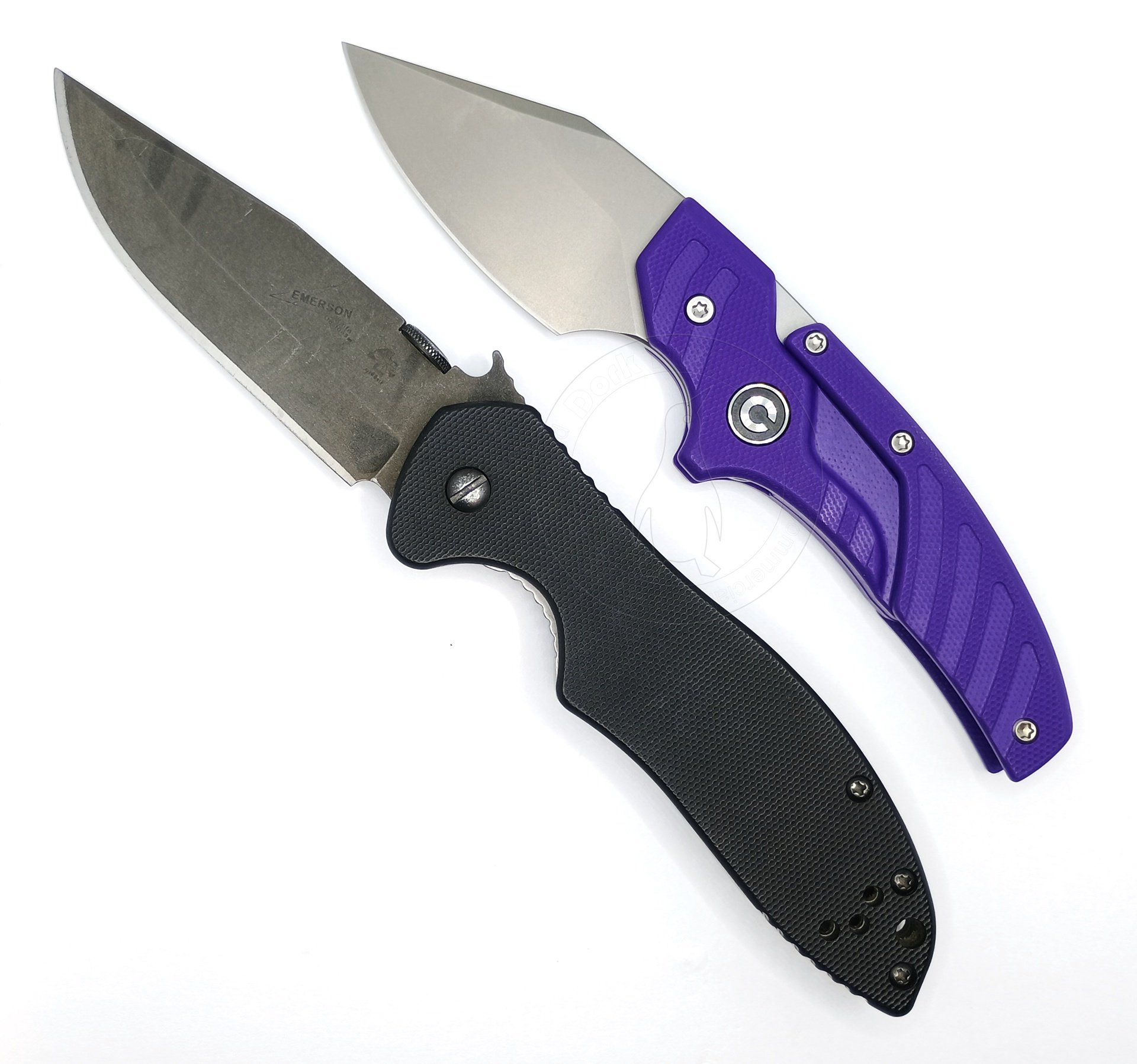
The Inevitable Conclusion
The Typhoeus is a fidget toy par excellence, but at anywhere from $65 to around $100 depending on which color variant you want, it's kind of tough to justify on that merit alone. Luckily, it's also competently manufactured and pleasantly functional in the bargain. If I were you, I'd look at it as a "fixed blade" style knife that's easier to carry than most by magically making itself shorter when you put it away.
It's a shame about the sheath. You'll probably have to add $10 worth of Kydex and rivets to your bill of materials.


Hello my friends, the day is once more / Just wait to see what we have in store / A silly knife no doubt, and one that is furthermore...
...Naughty.
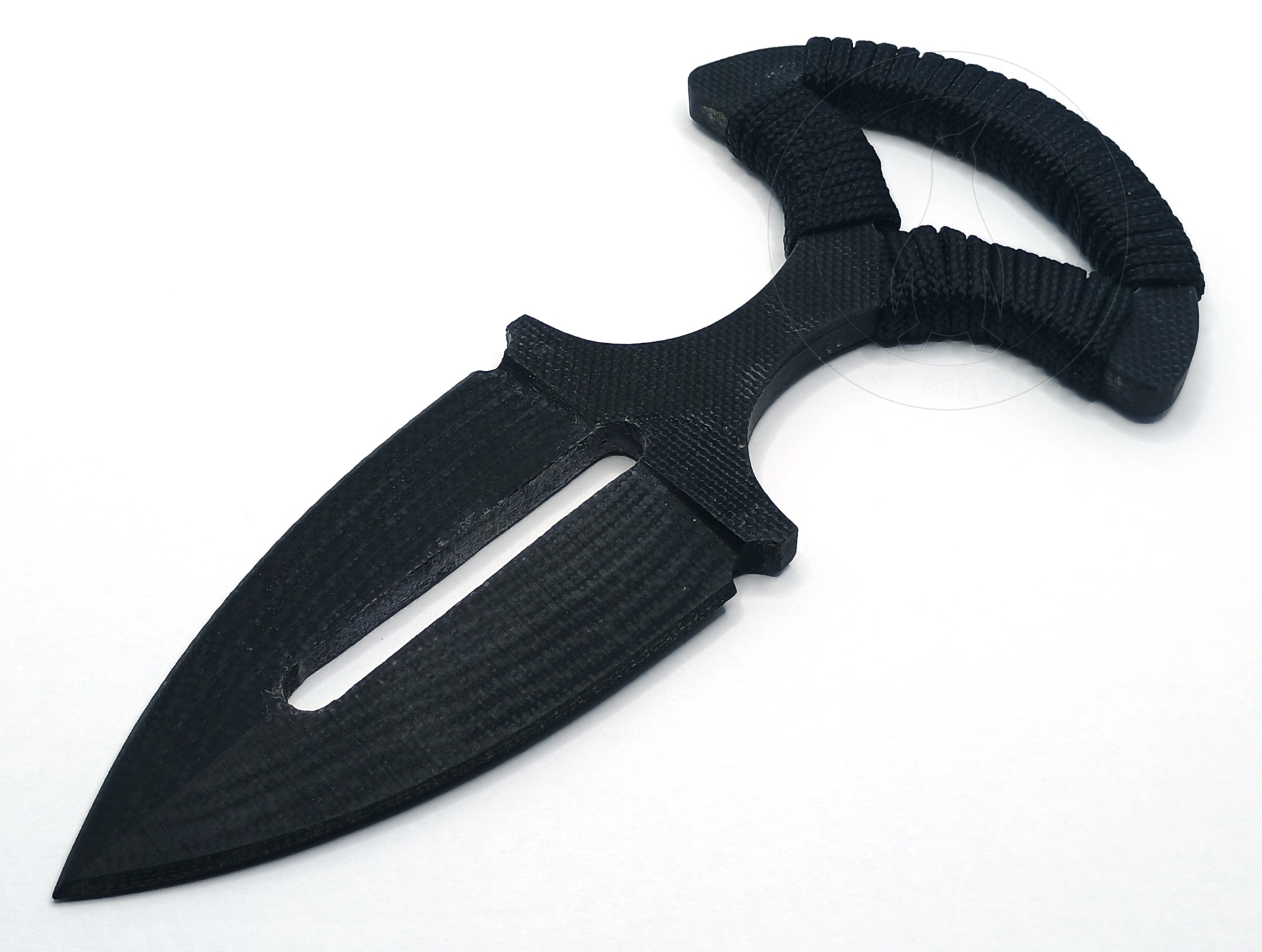
I have on multiple occasions mentioned owning several knives with various aspects that the law finds it within itself to frown upon. And probably just as often, expressed my own personal conclusion that regulations outlawing this feature or that particular mechanism or the other shape or whatever are ultimately all very silly when viewed from the perspective of anyone familiar with, you know, reality. Byzantine knife laws make the least sense out of pretty much anything because at the end of the day blade is a blade, and there is self-evidently no such thing, for example, as a "high capacity assault knife." You could cut someone just as well with a 4" paring knife from the Dollar General as you could with the latest tactical spring loaded all black half serrated tanto point karambit switchblade from 5.11 or Emerson. Or a chunk of obsidian you've knapped on a rock, for that matter. One sharpened chunk of metal is much the same as any other from the standpoint of someone wanting to perform mischief with it -- or one having mischief performed upon them with it.
(And that's notwithstanding the racist motivations that underpin specifically the US federal switchblade ban, balisong bans, and "dirk and dagger" laws.)
But this. This is easily the single most likely thing I've got liable to keep a harebrained legislator up at nights worrying.
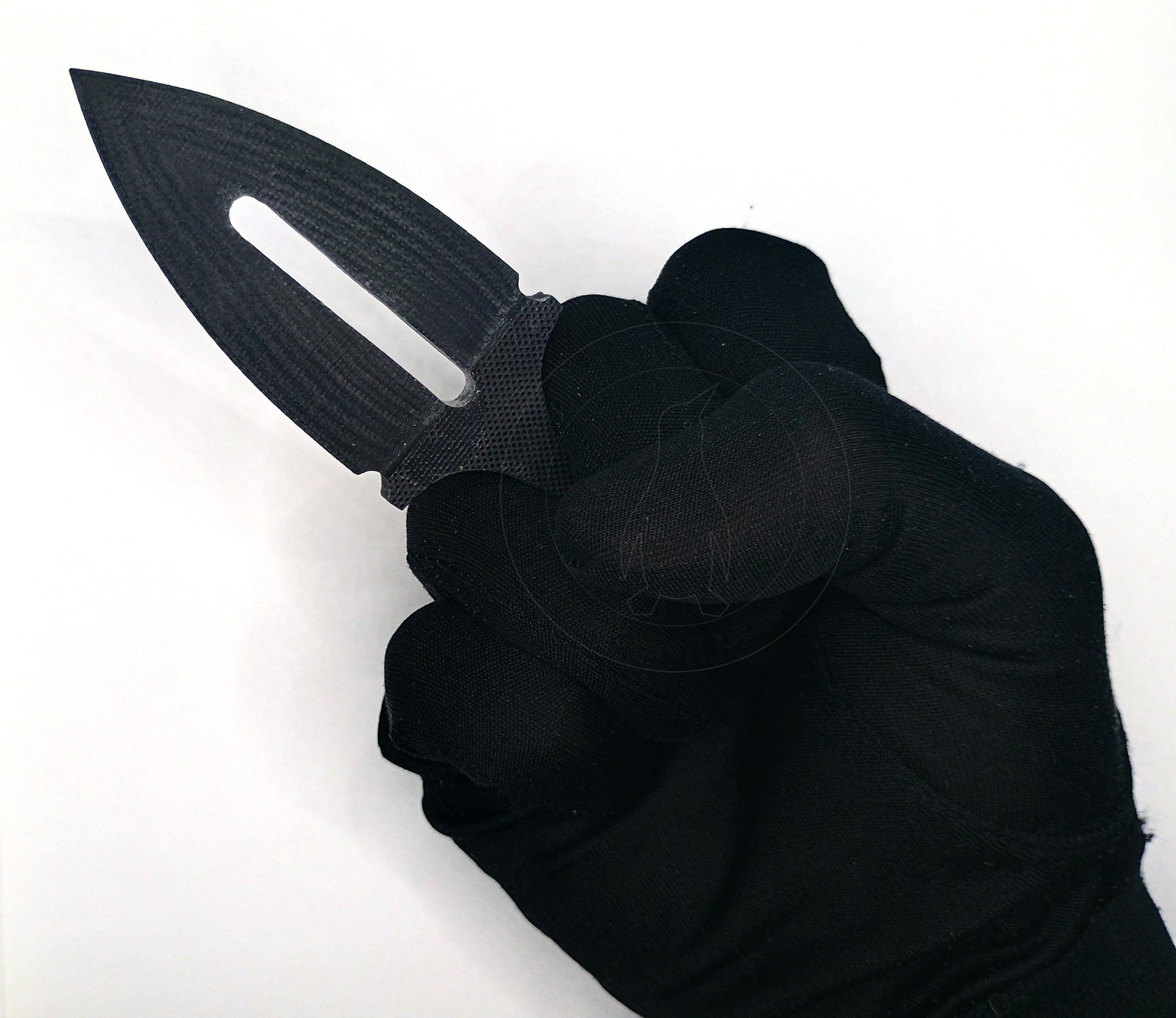
I've probably had it for about 20 years, and I'm pretty sure I bought it from BudK back in the day, when I was in one of my "get it before it's banned" moods.
Yes, this is a punch or push dagger. It is an early example of a brandless OEM Chinese special, so it never to my knowledge had any name or formal model designation, and while I can't find its exact ilk for sale anymore you can still find things online rather like it. If you prefer a brand name option, the Cold Steel FGX Push Blade leaps to mind. It has very little utilitarian purpose. This blade, it is made for stabbin'.
It's also made entirely of G-10, and is therefore completely nonmetallic.
In last week's column I gave an overview of a ceramic bladed folding knife, which doesn't have a metallic blade. But it still had a metallic liner, clip, and screws and therefore would not pass through a metal detector. This doesn't, and it absolutely would.
But even still, don't try it.
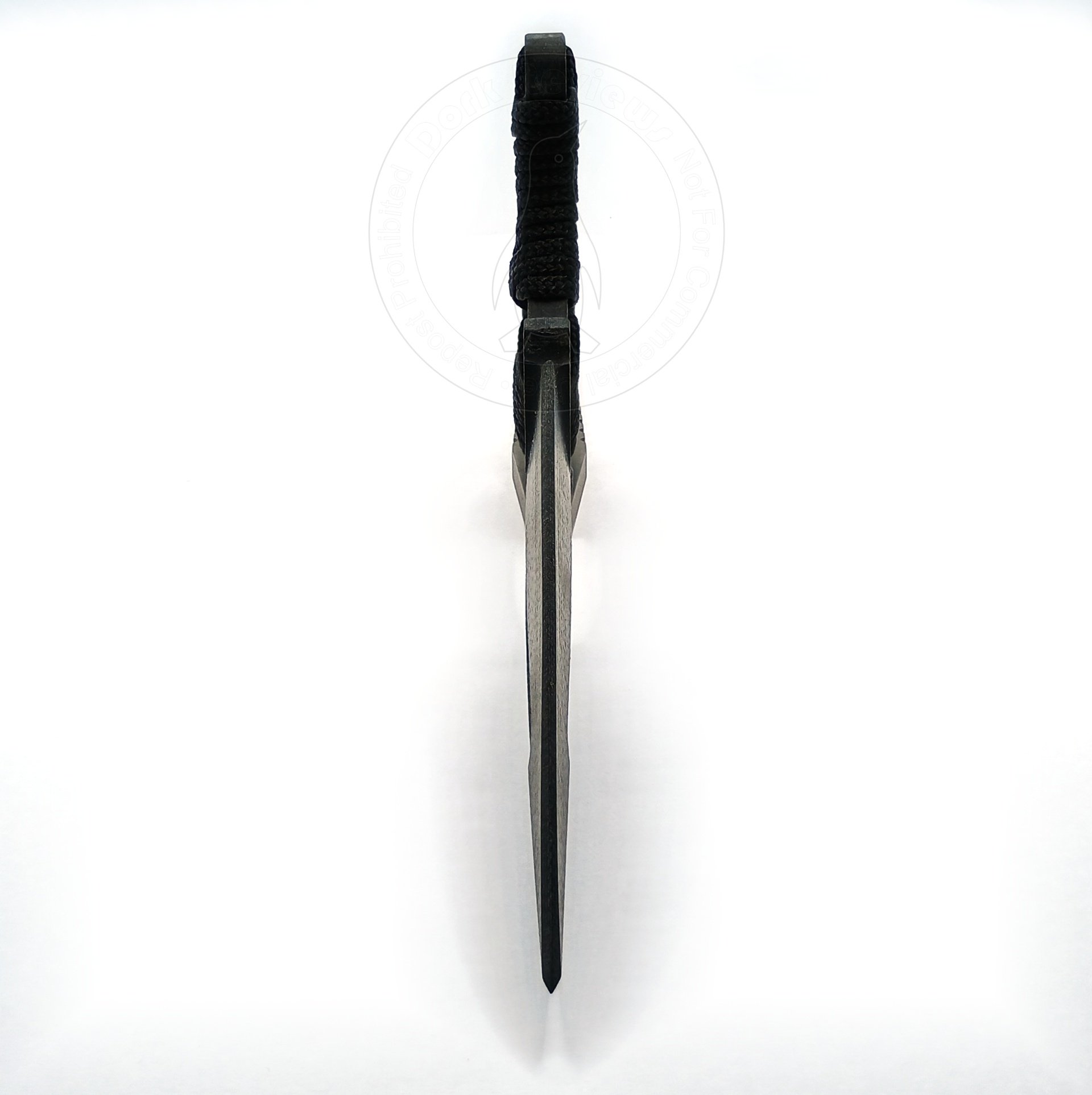
This "knife" is a 5" long, 0.175" thick, single flat piece of textured G-10, which has a cord wrapped T handle and a flat ground "blade" profile milled into it. For its part, G-10 is extremely strong for its weight (in total here only 17.4 grams or 0.62 ounces) and also surprisingly rigid. But considering that the thing and the whole of the thing is just fiberglass suspended in an epoxy resin, it doesn't actually hold an edge worth a damn. Like, at all.
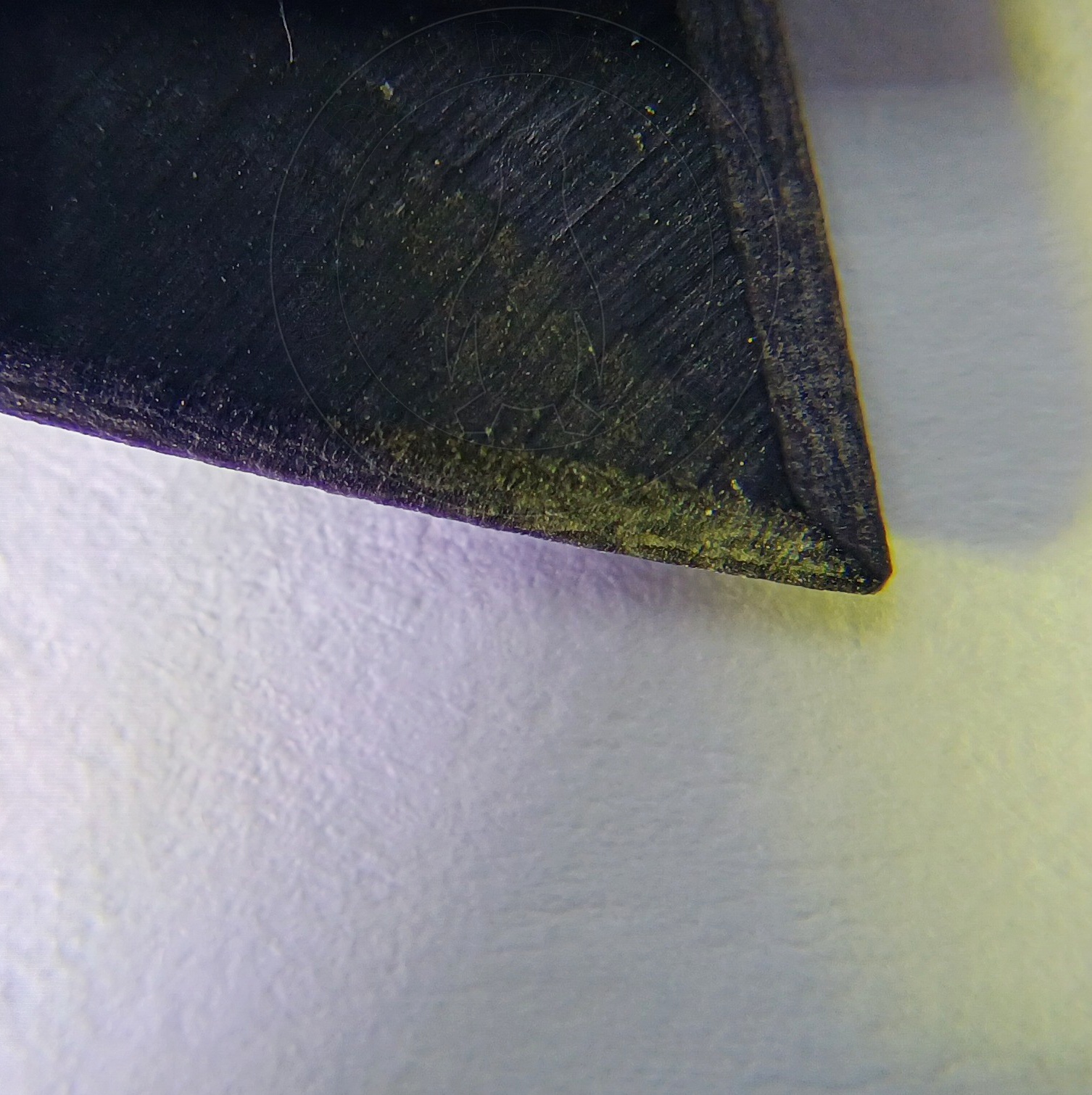
So while there is an edge bevel on it, it's not even sharp enough to make a reliable letter opener. Even if you carefully sharpened it, it's unlikely it would last for more than one cut. The material is just too soft and prone to abrasion.
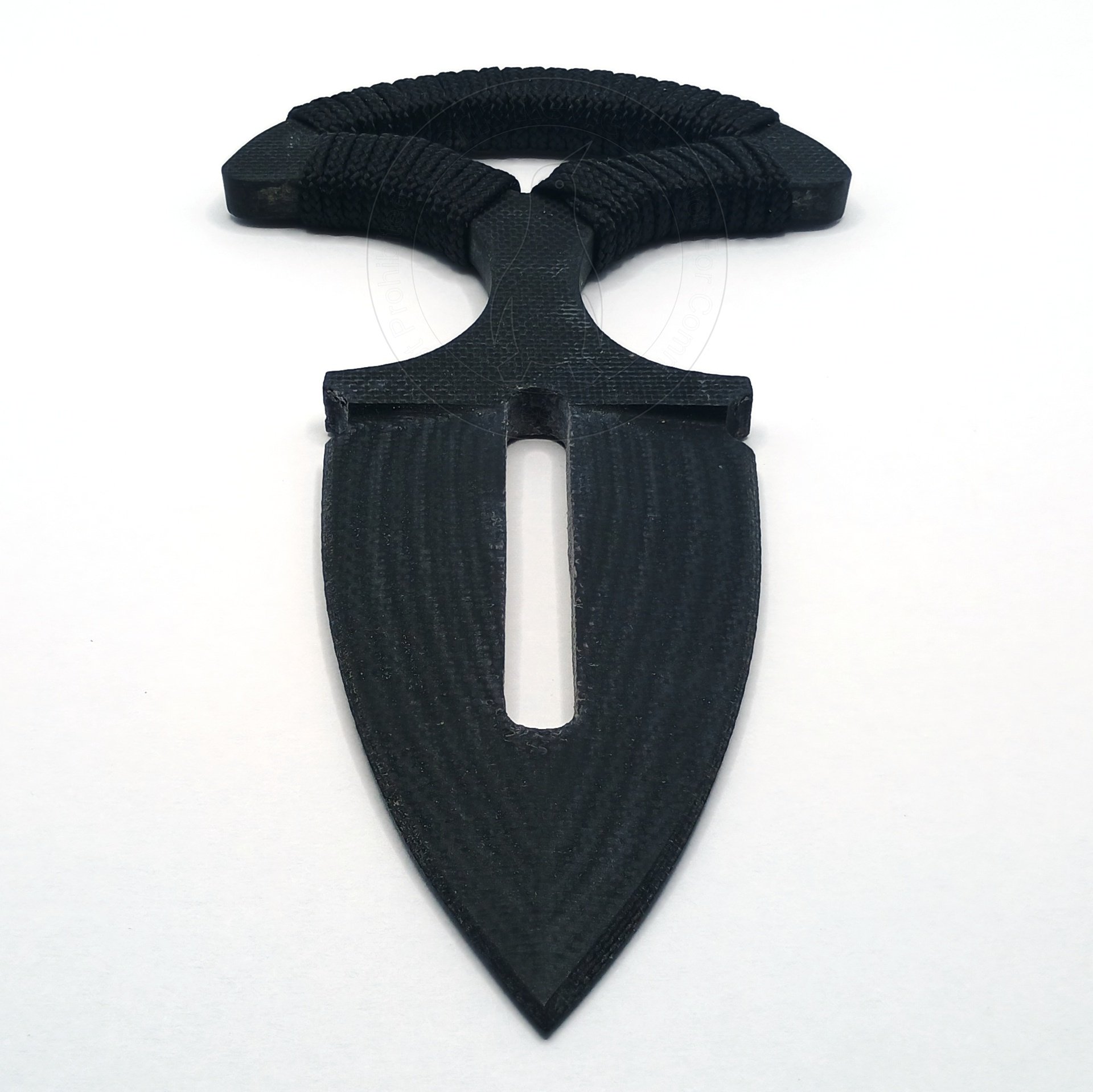
But that's not the point. The point is the point, and this knife is probably quite stout enough to Render Unto Caesar that what is Caesar's. Maybe not all 23 times, but certainly at least once. As a last-ditch holdout, it would seriously inconvenience anyone you punched with it although I imagine given how soft the material is it would utterly fail to penetrate leather or even the cheapest soft body armor.
Even so, I would not want to have this coming at me unexpectedly in the dark.
I present this to you bare, because although it did arrive with a belt sheath -- which ironically contained a large steel button snap on it, completely defeating its implied purpose -- this was made of fake leather so abysmal that it literally disintegrated into fish flakes while in storage in my knife cabinet. So I threw it away. Maybe some day I'll 3D print a replacement one, or something.
Whatevs. I'm obviously not carrying this thing with me anywhere, so I can't think of a single thing that's a lower priority.
The Inevitable Conclusion
It's probably because of things like this that all of our airports have switched over from plain metal detectors to those backscatter X-ray machines now.
It's all theater, though. Both that and this. Despite what the hysterical shriekers would have you believe if they could, to the nearest couple of decimal points no one is actually smuggling these anywhere, nor are they the crux of any kind of secret terrorist plot, and while we're at it nor is anyone realistically going to successfully use it as a last-ditch self defense tool when so many other ones are both better and just as readily available.
Even so, it's sometimes nice to know that just by owning something like this you're pissing off the right people, even if only passively.
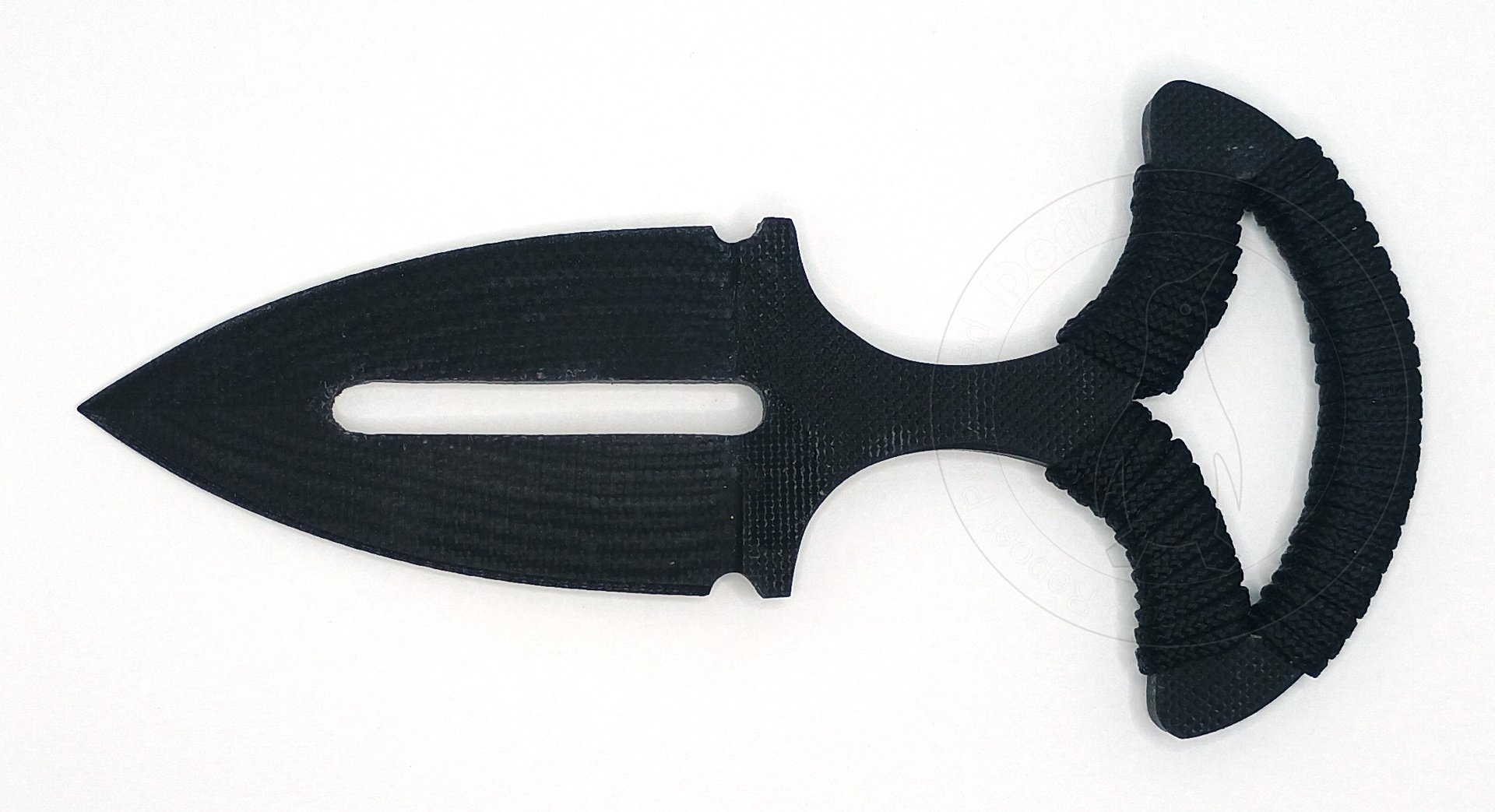
SCH404: Weirdness Not Found

"What the hell is this?" I hear you ask. "This looks like the ordinariest ordinary thing that ever ordinaried."
Here's a hint, by way of a magnet.
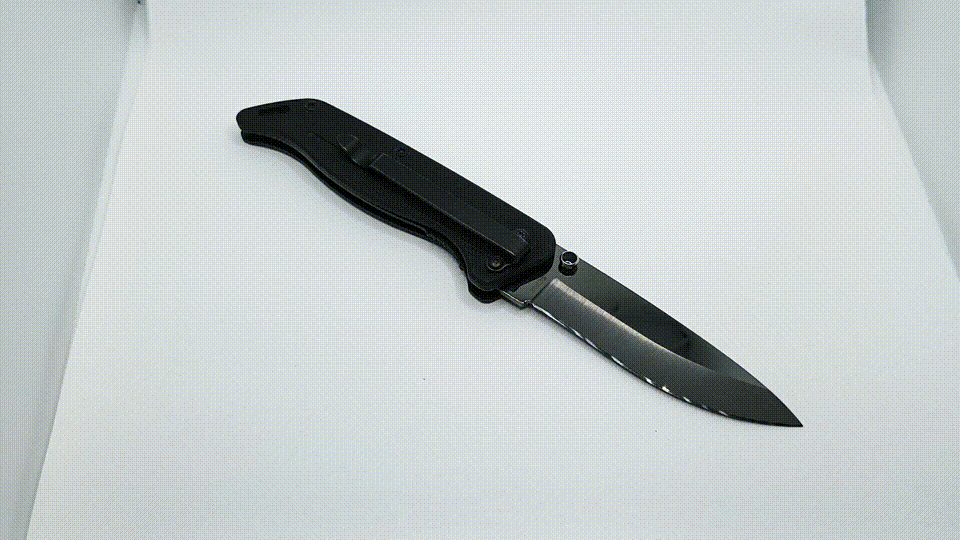
The Schrade SCH404 is indeed one of those from the burgeoning, but still uncommon, sector of ceramic bladed knives. But unlike the cheapie translucent ones that Amazon perpetually refuses to ship to your location, this one has a zirconia ceramic blade with this attractive obsidian finish.
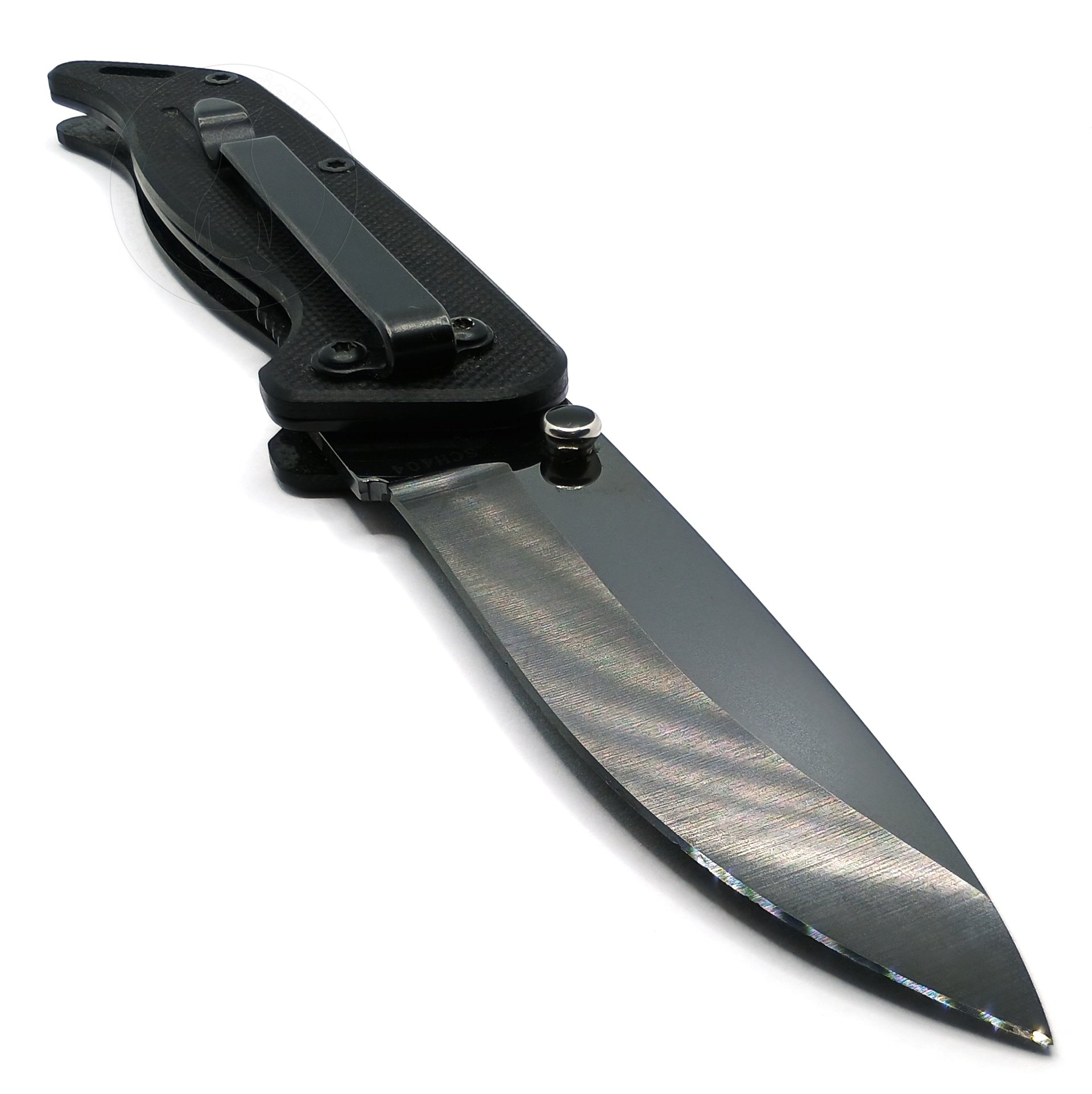
The SCH404 is very old and thus very discontinued. So much so that it's actually pretty tough to find any info on it online. It's also one of those things that perfectly illustrate how us spacemen are already living in the future, but we're so numb to everything nowadays that the mere presence the advanced wondermaterials it's made out of -- things unfathomable to an observer from, say, fifty years ago -- now just feel like they're old hat.
And this was an inexpensive entry level knife in its day, not even remotely premium.
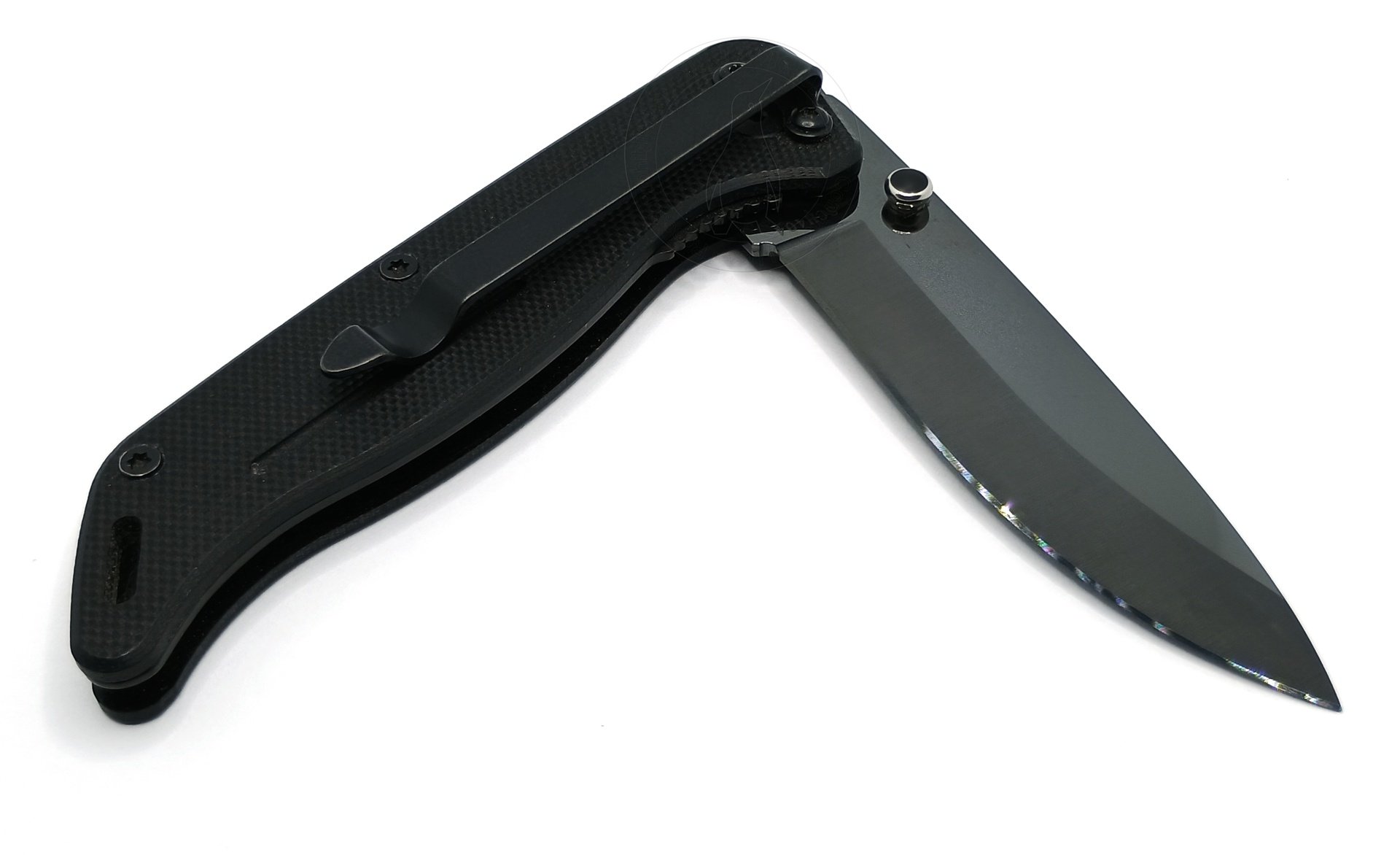
But despite its age, the SCH404 still has quite a few modern aspects about it. Like like the deep carry pocket clip, highly textured G10 scales, and slick single sided liner design. These are all highly desirable hallmarks of current EDC knives. Just in this case also including a blade made of a weird nonmetallic material.
For a start, this is a very light and compact knife. It's only 48.7 grams or 1.72 ounces -- that's actually 2.4 grams lighter than a Benchmade Bugout. It's just 3-3/4" long closed, 6-1/2" open, and sports a 2-3/4" long blade made of that groovy glassine ceramic. I think the only way to go lighter per displacement would be to pay a lot more and pony up for the likes of, say, a Böker Anti Grav.

The SCH404 is pretty thin overall as well. It's 0.346" thick not including the clip, with its lack of bulk in both dimensions and weight combining to make it very easy to carry. The ceramic blade is 0.80" thick.
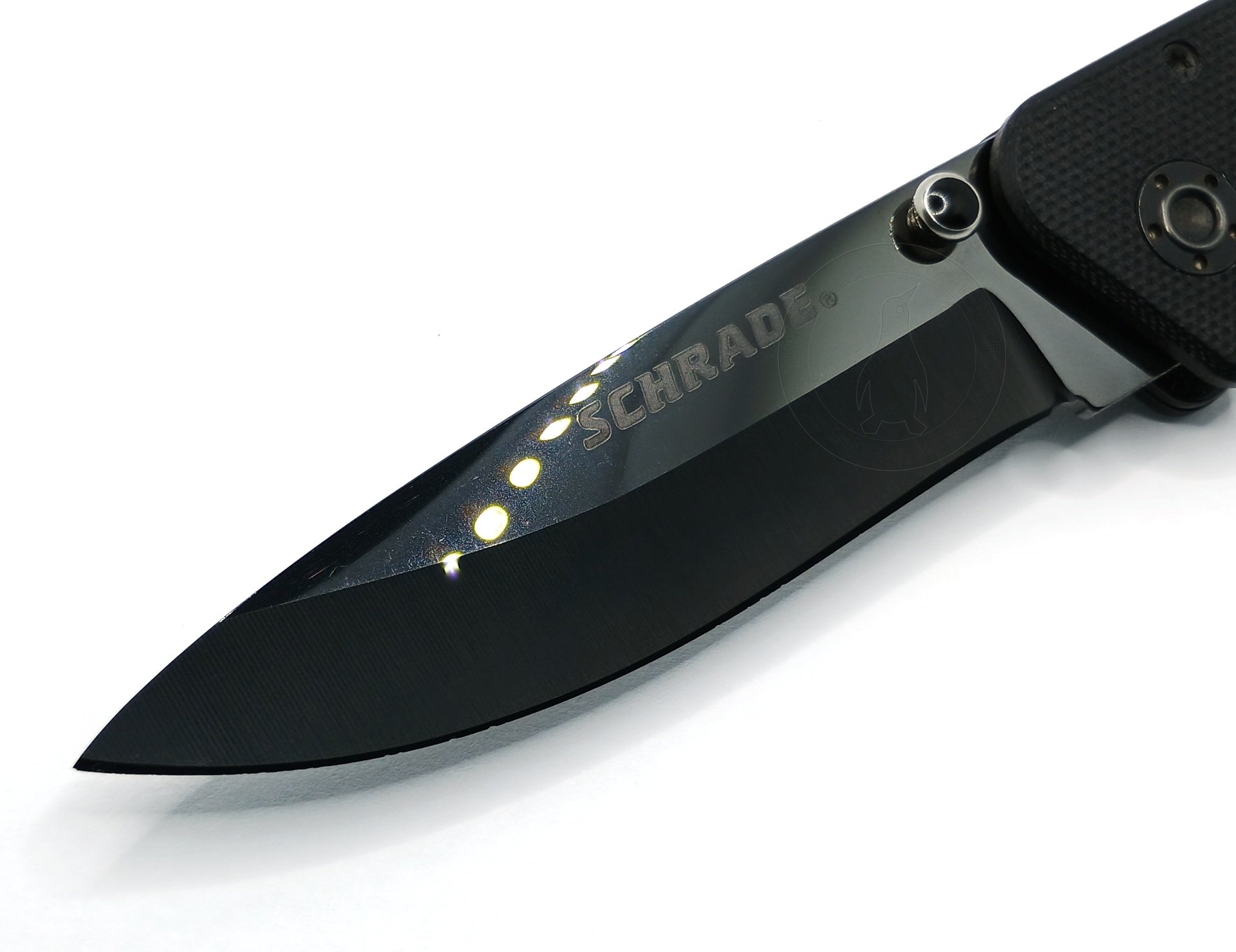
Actually, let's talk about that blade.
Ceramic blades like this one are typically billed as "forever sharp." The zirconia ceramic material is incredibly hard, falling somewhere between 8.5 and 9 on the Moh's scale and thus much harder than steel. It resists abrasion to an incredible degree, and is essentially completely immune to the inherent abrasiveness of cardboard, sisal rope, leather, and even wood.
The glossy obsidian surface is a veritable beacon for fingerprints but not, it must be said, scratches. There is very little that can truly scratch the surface of the SCH404's blade. Basically only sapphire, diamond, and tungsten carbides -- all things you're unlikely to be trying to slice with your pocketknife on a daily basis.
But the material is also very brittle, and the thinner it is the more brittle it gets. Thus a ceramic knife like this chips near-microscopically rather than dulling via abrasion or the edge getting rounded down like a typical steel knife. It's also not a good idea to put any torsion on it at all, because the material would be prone to just snap.

And I know what you're thinking. No, this knife will not sail through a metal detector. The liner, clip, and screws are all made of plain old steel. So forget it. Only the blade and scales are nonmetallic.
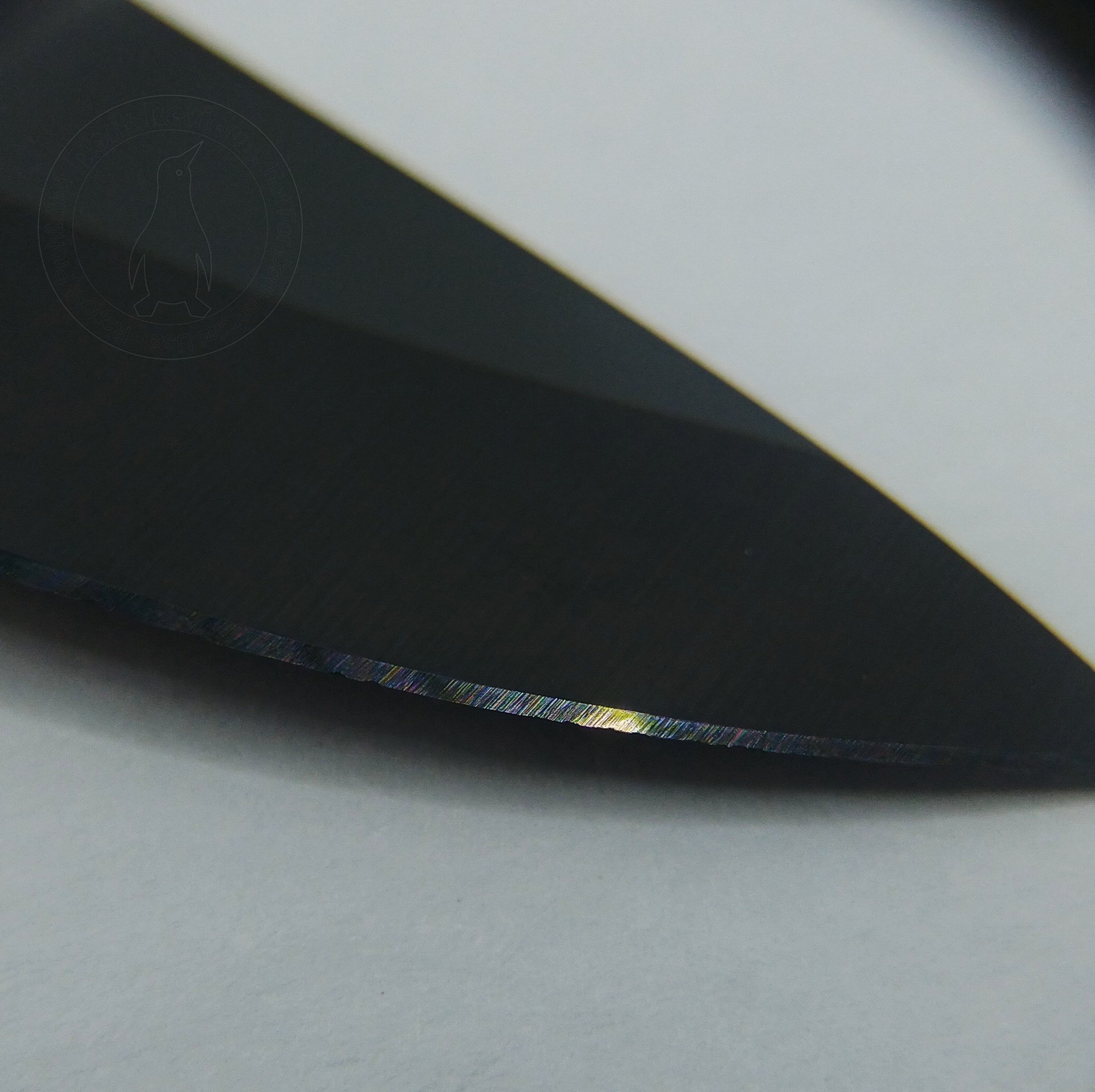
It's a very good thing these come preground, because they are functionally impossible for a hobbyist to properly sharpen. Yes, you can theoretically do the job with resin bonded diamond stones but the process is arduous and difficult, and the penalty for failure is high. My example is very lightly used, so I can only imagine these tiny imperfections in the edge came from the factory. The SCH404 is not quite shaving sharp although it glides through paper and cardboard quite easily still. That's just as well, because if it were truly dull I probably wouldn't be too keen to do anything about it.
I dig the subtle refractive rainbow effect of the light playing off of the texture in the edge like a starling's wing. The SCH404's blade really is stunningly beautiful. The flat of the blade is literally mirror polished, to the point that it casts reflections. The machine marks, meanwhile, sparkle in the light. It's like waving a black diamond around.
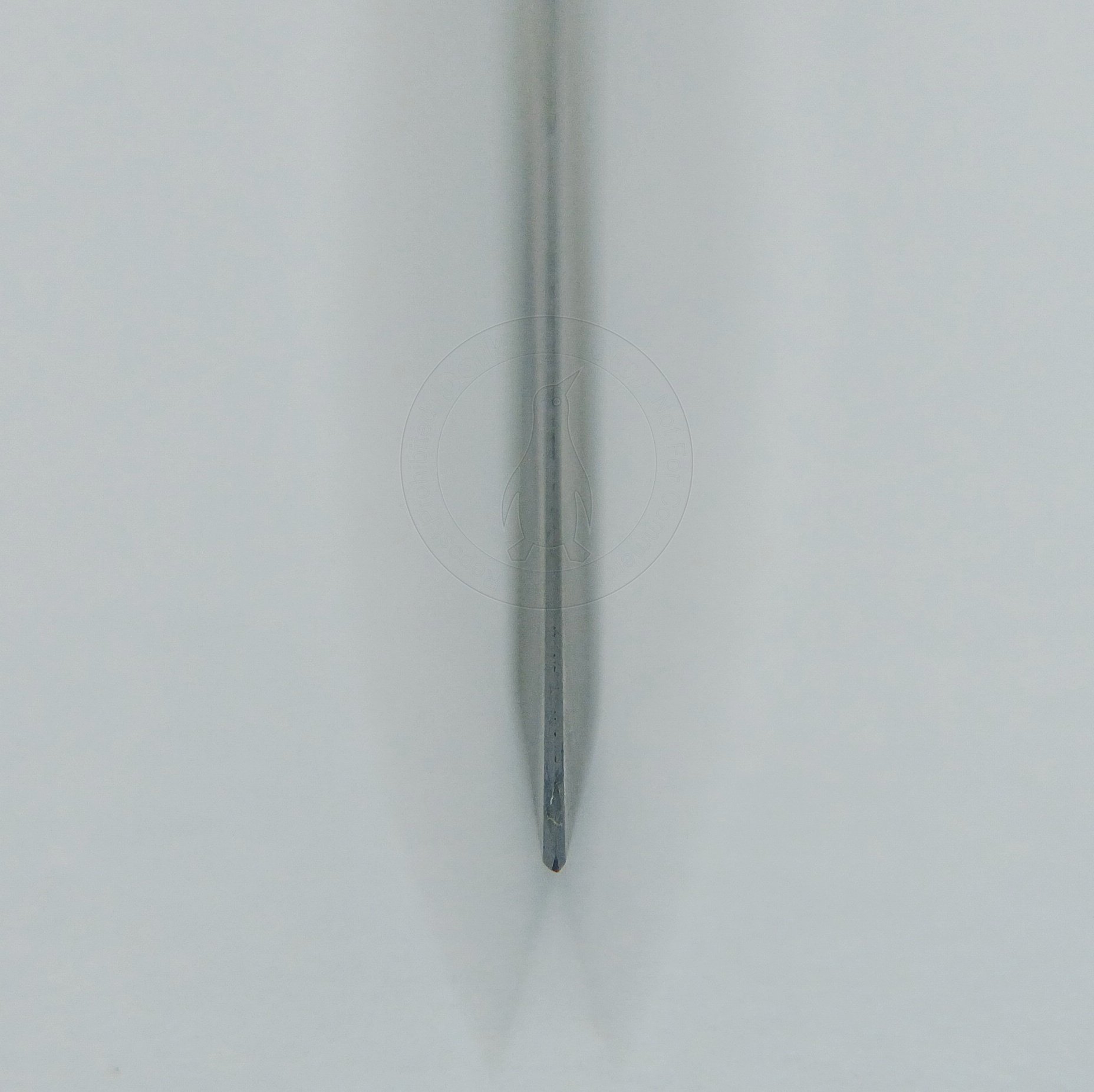
The edge is also fortunately exactly mathematically true. As it bloody well ought to be, given all of the above. If it weren't, good luck trying to correct it.
So, I mentioned the Böker Anti Grav earlier, and I did that on purpose. That's because I suspect, but cannot prove, that this knife was actually OEM'ed by Böker using much of the same equipment, material, and template.
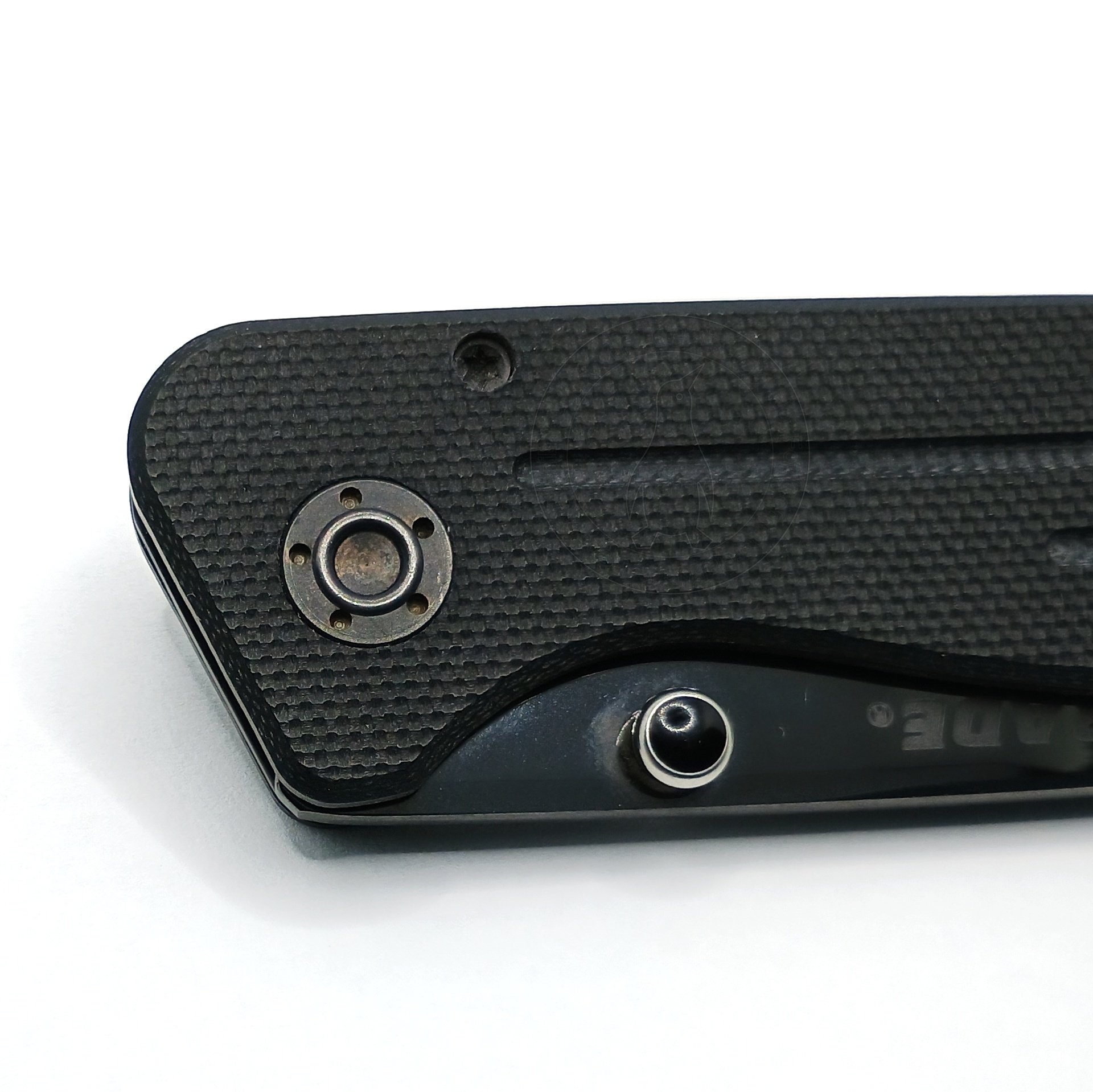
What clues me in is this highly distinctive five-holed spanner nut on the pivot, which is suspiciously reminiscent of the one on the Anti Grav and its sibling, the Anti MC. If so, that's huge -- that makes this an incredible poor man's version of that knife, especially considering that the former retails for about $195 nowadays. The main thing you're lacking is the zooty carbon fiber or titanium scales, but for the end-of-life retail cost of around $15 on this thing I'll sure take the $180 discount. So if that's true, there's the other half of the oddity surrounding this knife. We'll probably never know for sure.

I bothered to take a macro photo of the SCH404's model number etching, so I'm going to show it to you and nobody's going to stop me. Here it is.
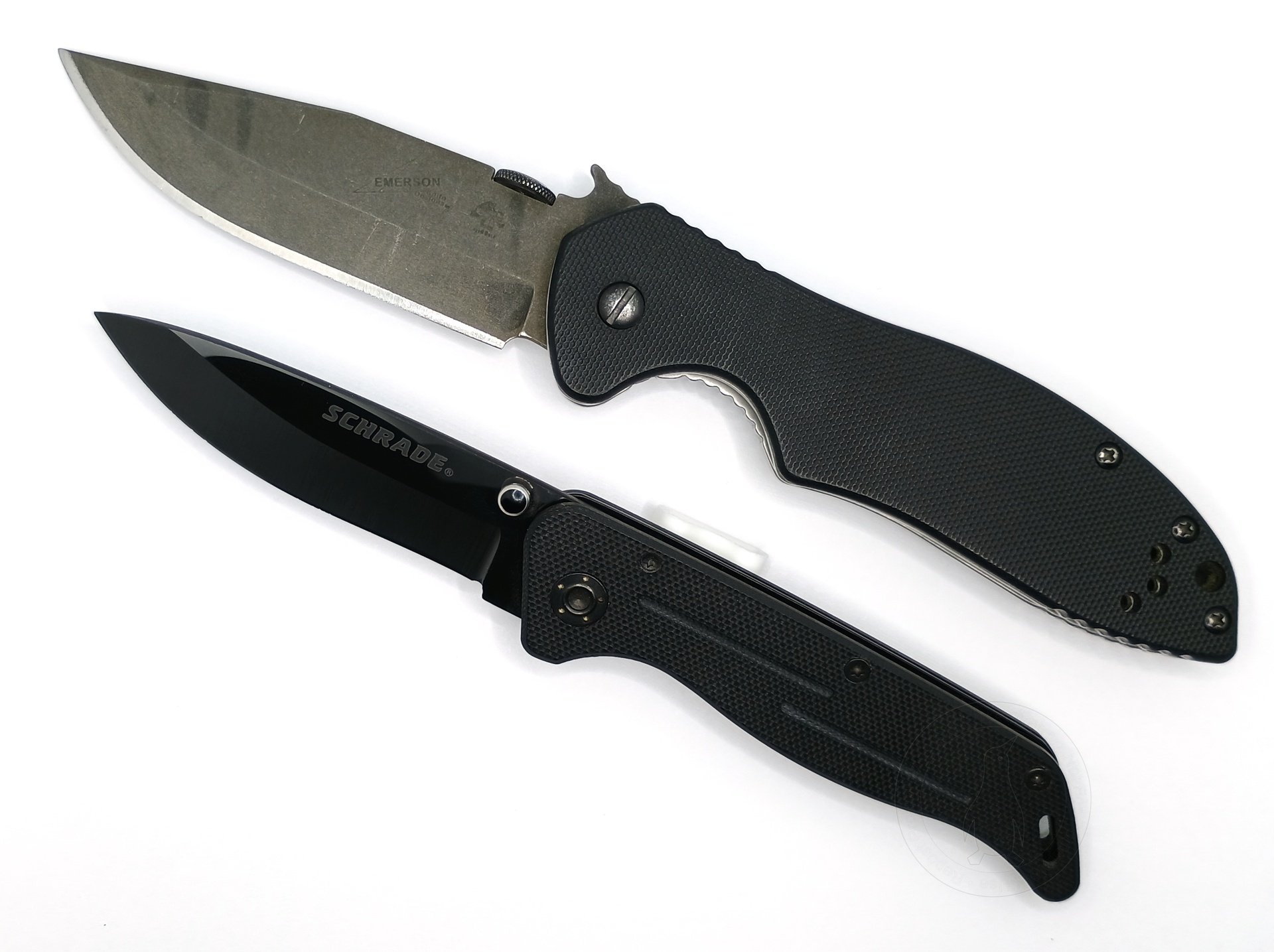
Size wise, the SCH404 falls firmly into the compact category. It's basically the size of a Mini Bugout. Compared to the usual CQC-6K, there, it'll ride thoroughly unnoticed in your pocket.
The Inevitable Conclusion
You can't buy the SCH404 anymore, so there wasn't much point in me yammering on about it. But it's the only folding ceramic knife I own these days so it's the one you got.
Ceramic knives like these -- in their pocket knife incarnations, anyway, and not as the fairly ubiquitous cheap white kitchen knives -- shine for basically one and only one purpose. If your workflow involves cutting a lot of cardboard in a day, something like this absolutely will save you from endless resharpenings or having to go through box cutter blades like popcorn.
Like many things in my collection, both those I've shown you and ones I haven't gotten around to yet, the SCH404 is a bit of a relic. It's a peculiar combination of materials, construction, and price point we're not liable to see the likes of again. At least, not for what it cost when it was available.
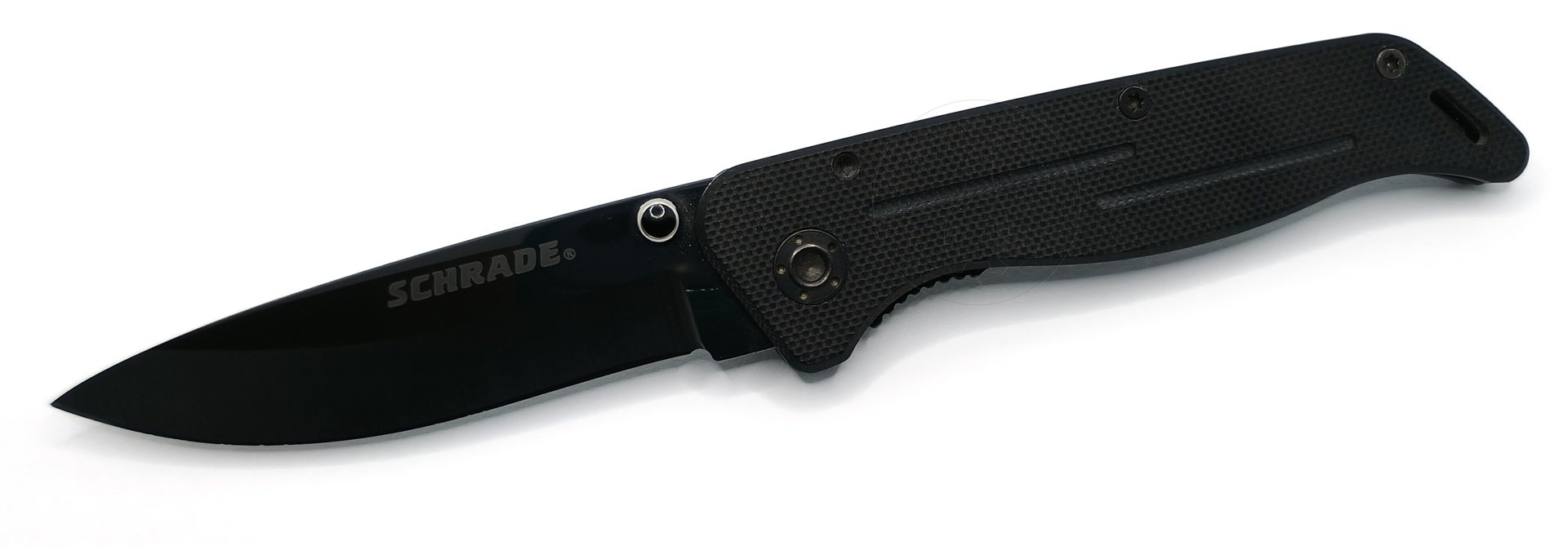
I'm almost feeling like I'm being personally called out, here.
This is the "TZGUO" model Q19. As I'm sure you're getting tired of me telling you, both the brand and the model on this thing really don't mean much; you can find this and many of its near identical siblings wherever Chinese white-box goods are sold, under a near infinite array of names and non-brand monikers. This particular instance came from Amazon, hence the unpronounceable five letter combination. The fact that it sneakily violates the "no balisongs on Amazon" rule is just delicious icing on the cake of overt cheekiness. You can also find these all over AliExpress and probably Wish and Temu by now, too, where they're cheaper and you can score one for about $35. The search term you want is "titanium design balisong," apparently.
But never mind all that. Just check this thing out.

The Q19 is a balisong utility knife. It takes standard Stanley style trapezoid blades, as are readily available everywhere.
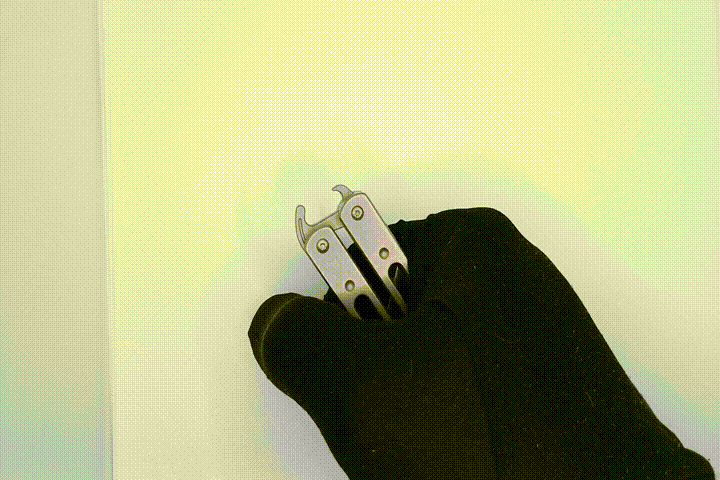
It has a spring loaded latch, too.
Does that remind you of a particular knife? It certainly reminds me of one... Mine!
Now, I don't think I've been scooped, here. Rather, I think this is a case of convergent evolution, as it were, with both myself and whoever is churning these things out arriving at some similar design conclusions for similar reasons.
And it turns out I like The Q19. I've actually been using it as my daily driver for about the past two weeks, which is why you haven't seen me blathering about much of anything else in the interim. And this will go a long way towards explaining the tape gunk stuck to the blade in some of these pictures.
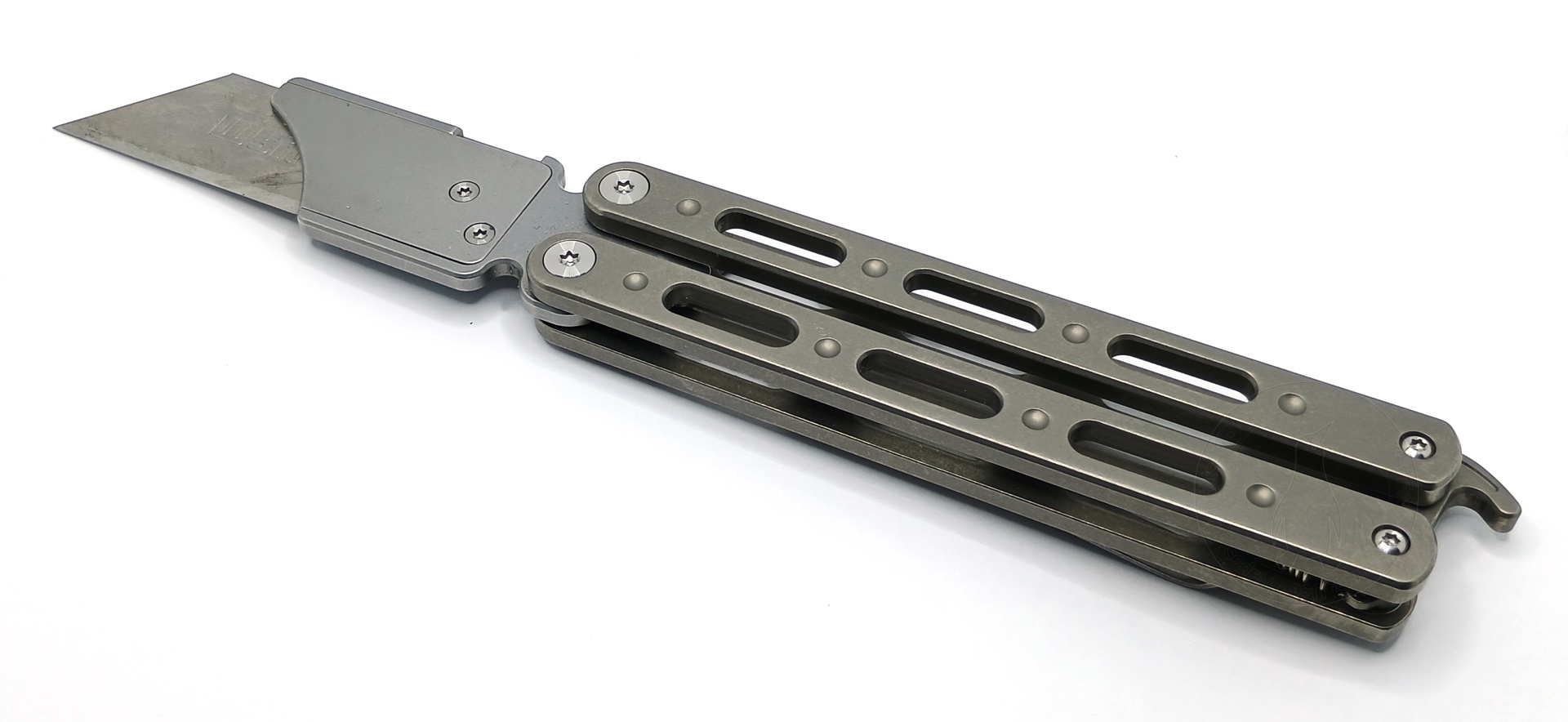
The Q19 is, as implied by its product description, made of titanium. Well, a lot of it is, anyway. The handle scales and latch certainly are. A magnet reveals that the blade carrier and clip are actually steel. That's fine, and the combination of materials adds up to a total weight of 76.5 grams or 2.7 ounces exactly.
It's definitely more of an "EDC" size and not a competition sized knife, measuring out at 4-9/16" long when closed including the tail of the latch sticking out, and precisely 7" long when open with a typical blade installed. It's square in profile with flat sided handle scales, 0.416" thick not including the clip.

Said clip is a traditional design and rides in a little pocket machined into one of the handle slabs. Of course it's not reversible, with no matching pocket on the other side, because this is in accordance with the deeply rooted worldwide conspiracy among all balisong manufacturers everywhere designed specifically to annoy me in particular, wherein it is also on the wrong side of its handle.
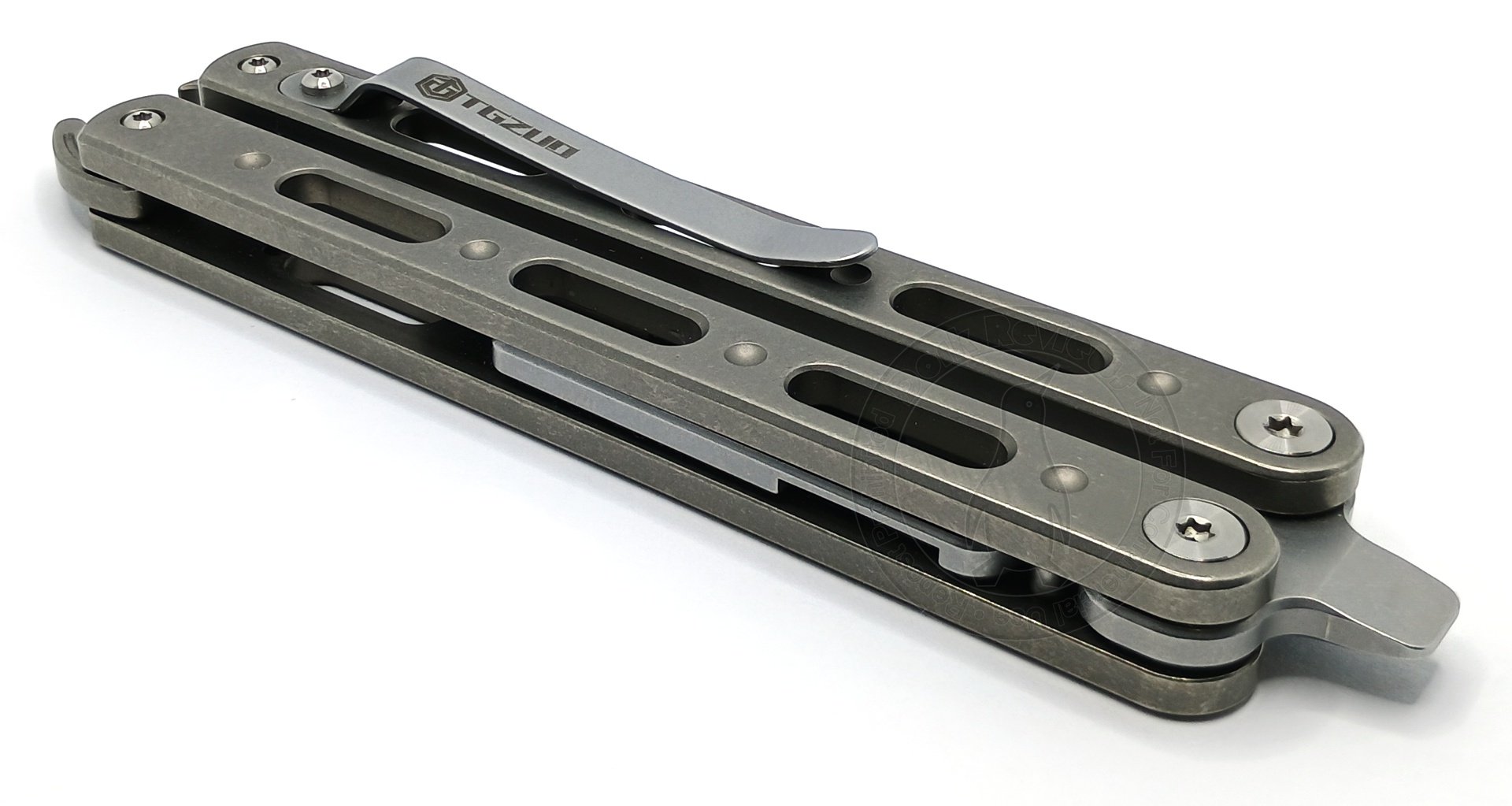
Ahem.
Anyway, the heel of the blade contains a slotted screwdriver tip or, as it's described in the specs, a "pry bar." And the hook on the end of the latch functions as a bottle opener. The manufacturer is thus pathologically driven to bill this as a multi-tool.
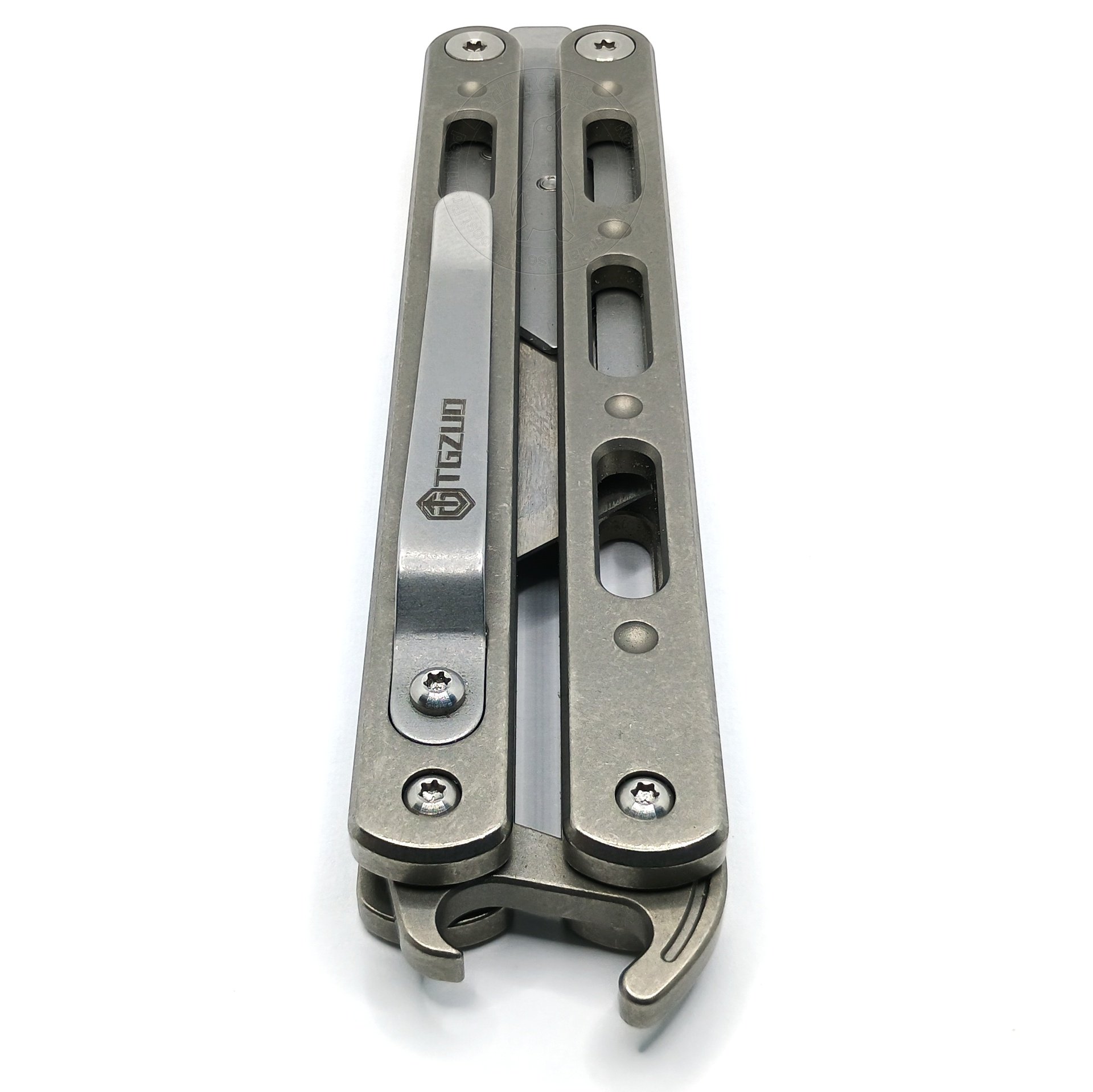
Fair enough, actually. The tailhook does open bottles like nobody's business -- provided you manage to lever it the right way around, and don't try to use it backwards.
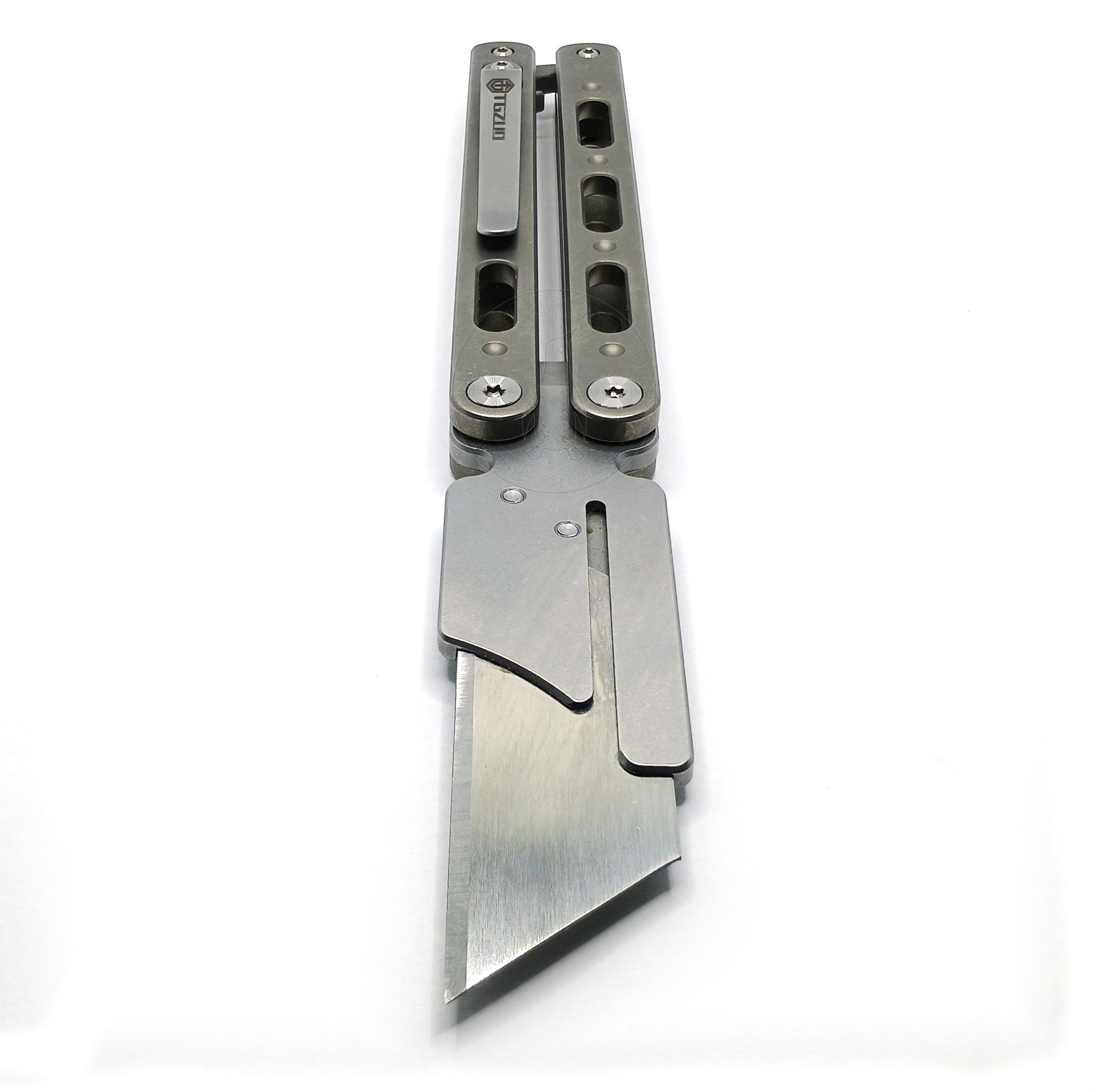
I spent some time trying to research what the Q19 is a knockoff of and ultimately came up empty. If anything, the closest I can come up with is the Artisan ATZ-1823PO, the now discontinued utility knife version of their Kinetic Tool thing. This certainly has a T shaped latch strongly reminiscent of the Artisan one, although that isn't spring loaded and this is. And the Artisan tool has that weird combination switchblade/balisong action which this certainly doesn't.
Annoyingly, then, the Q19 appears to be a more-or-less bespoke design that against all expectation actually turns out to be pretty good. Yeah, I'm just as surprised as you are. That's not how these things are supposed to go.
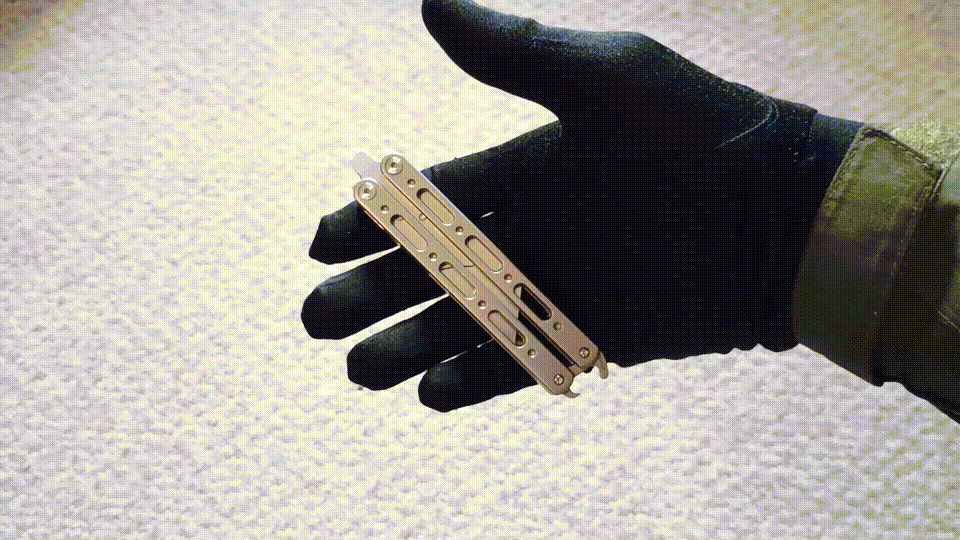
Its action is excellent, for a start. The titanium handles are fairly light but the Q19's balance is spot on, with the center of gravity remaining well inside the handles and not out in the blade carrier. The pivots exhibit no drag and are totally consistent in their nearly complete lack of friction throughout the entire range of travel. The rebound is pleasant and distinct, without setting up any vibrations or resonances in the handles. And thanks to having an extension spring driven design ripped off directly from Benchmade, the latch is held out and away from the handles at all times and can't strike either one during manipulation. It just feels good overall.
You would think that the bottle opener hook would make it snaggy as all hell but somehow it doesn't. The knife is thin enough and rides against your pocket tightly enough that it doesn't seem to cause an issue. The only real fly in the ointment I can see from a design perspective is the prybar tip sticking out of the end, which might get in the way if you're trying to do over-the-finger spin tricks. I guess if it bothers you, you could just grind it off. It's a $35 knife with no collector's value. Who cares?

Hier ist Der Viggletesten.
The Q19 scores favorably here, exhibiting very little wiggle and absolutely zero tap of the blade carrier against the insides of the handles.
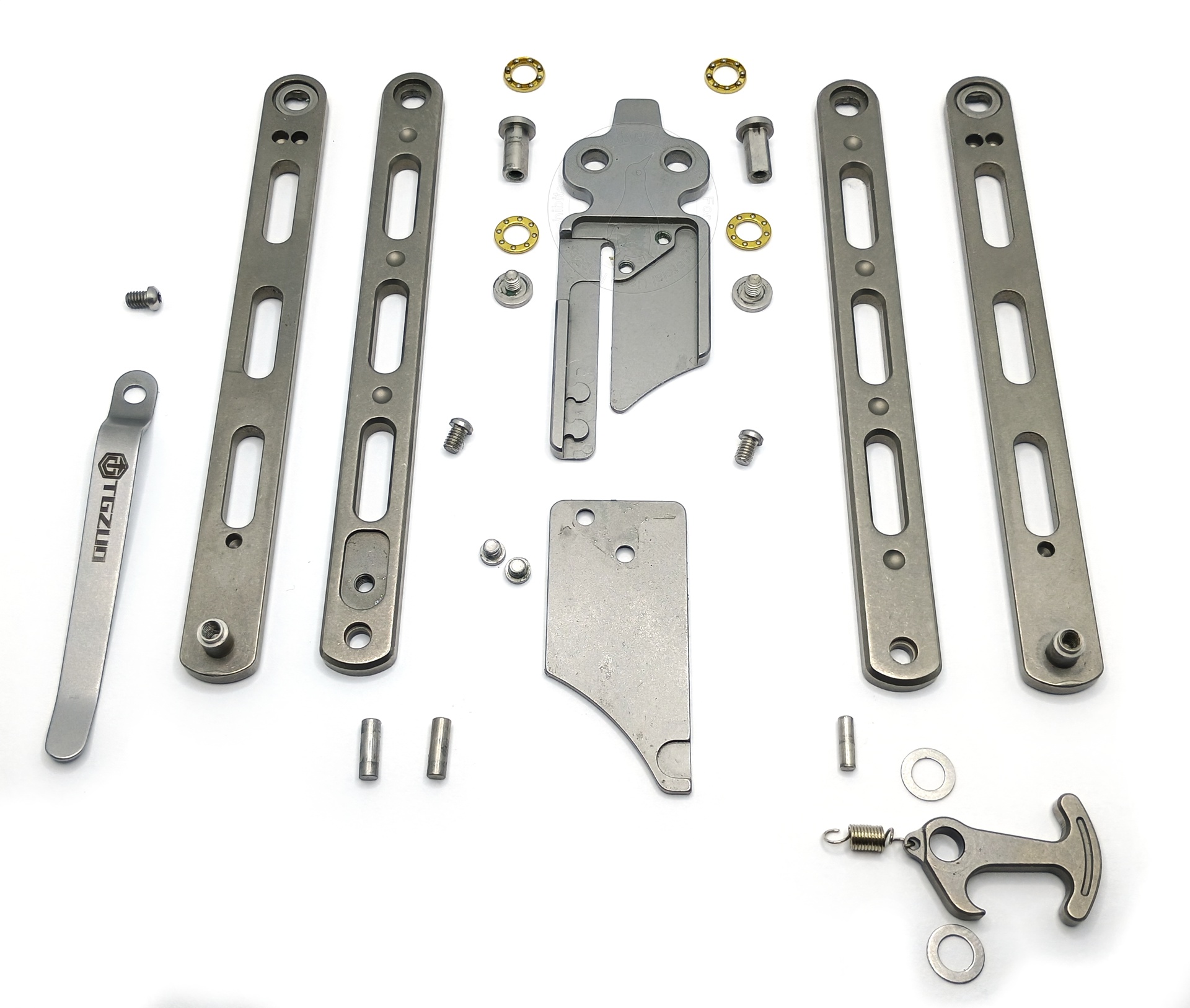
Yes, this is a $35 knife wherein a significant portion of it is constructed of titanium, and it has ball bearing pivots. Nice ones, too. And the inside faces of the handles are pocketed for the bearings, so this wasn't a case of some existing design somebody just decided to slap bearings in and add $2 to the bill of materials. No, it was designed for them from the start.
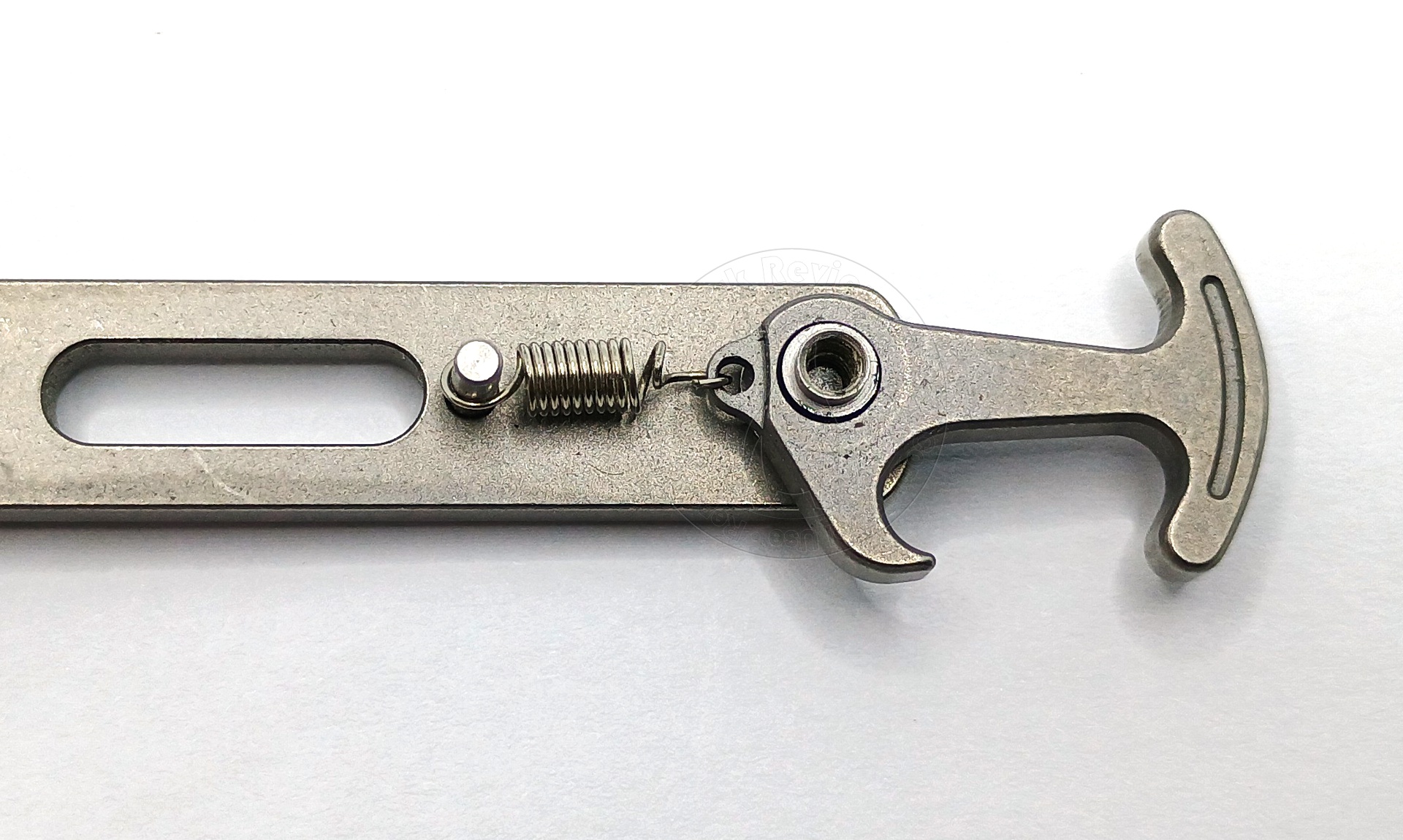
Here's the latch spring mechanism, which is dead simple and suspiciously similar to that of the Benchmade Model 42 and subsequent knives. It will spring open from either the latched or unlatched positions if you give the handles a hearty squeeze together.
The Q19 also has a Zen pin design without the need for kicker pins to be pressed through the blade carrier. This is just as well, because every time you see kicker pins on a cheap Chinese knife they're invariably pressed badly. In this they're just basic straight pins with no shoulders or fancy features, but they sit acceptably square when assembled and don't cause any problems or weirdness.
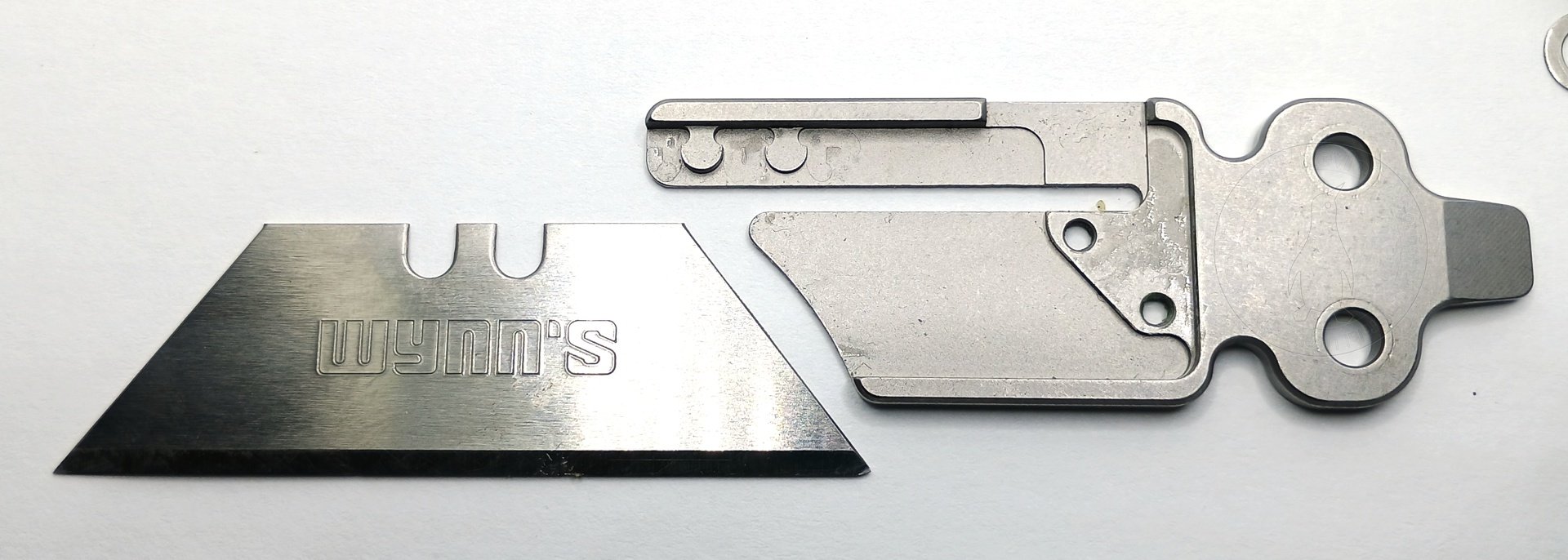
You might think at first blush that installing or changing a blade in this requires tools, based on the two little Torx screws on the blade carrier. But those are a cost cutting measure, not a mechanical necessity; they obviate the manufacturer from having to machine a narrow slot into the blade carrier and instead allow it to be assembled out of two pieces which has got to make it much easier to manufacture. Rather, the nubs that engage the cutouts in the blade are actually mounted on a flexible prong, which you can pull down with the aid of a fingernail just far enough to allow you slide it in and out. If you're chicken you can still install a blade the hard way, by removing those two screws and the top plate. But that's not actually necessary.
Again, this is highly reminiscent of how I do it on all of my printed utility knives. Obviously great minds think alike.
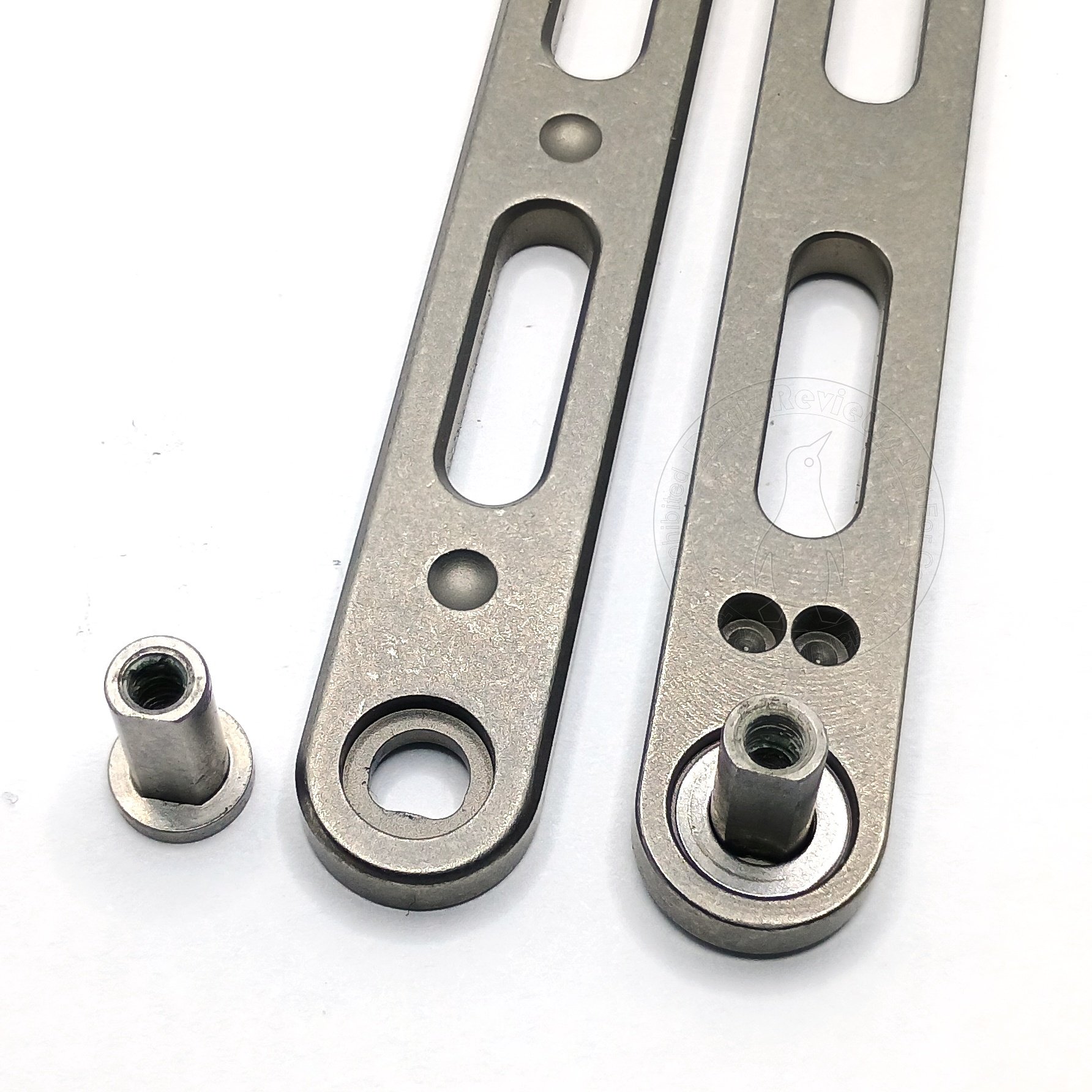
The pivot screws have anti-rotation flats and the handle slabs do indeed have matching D shaped cutouts in them for once -- on all four of them, even. Thus undoing the pivot screws is easy provided only that you start reefing on it from the correct side. There is no visual indicator on either of the screw heads which is the male side and which is the female. But you'll quickly discover that the female side refuses to turn, which clue you in pretty quickly. The Torx head on that side is thus ultimately just decorative. You can install the pivot screws either way around depending on whatever suits your fancy.
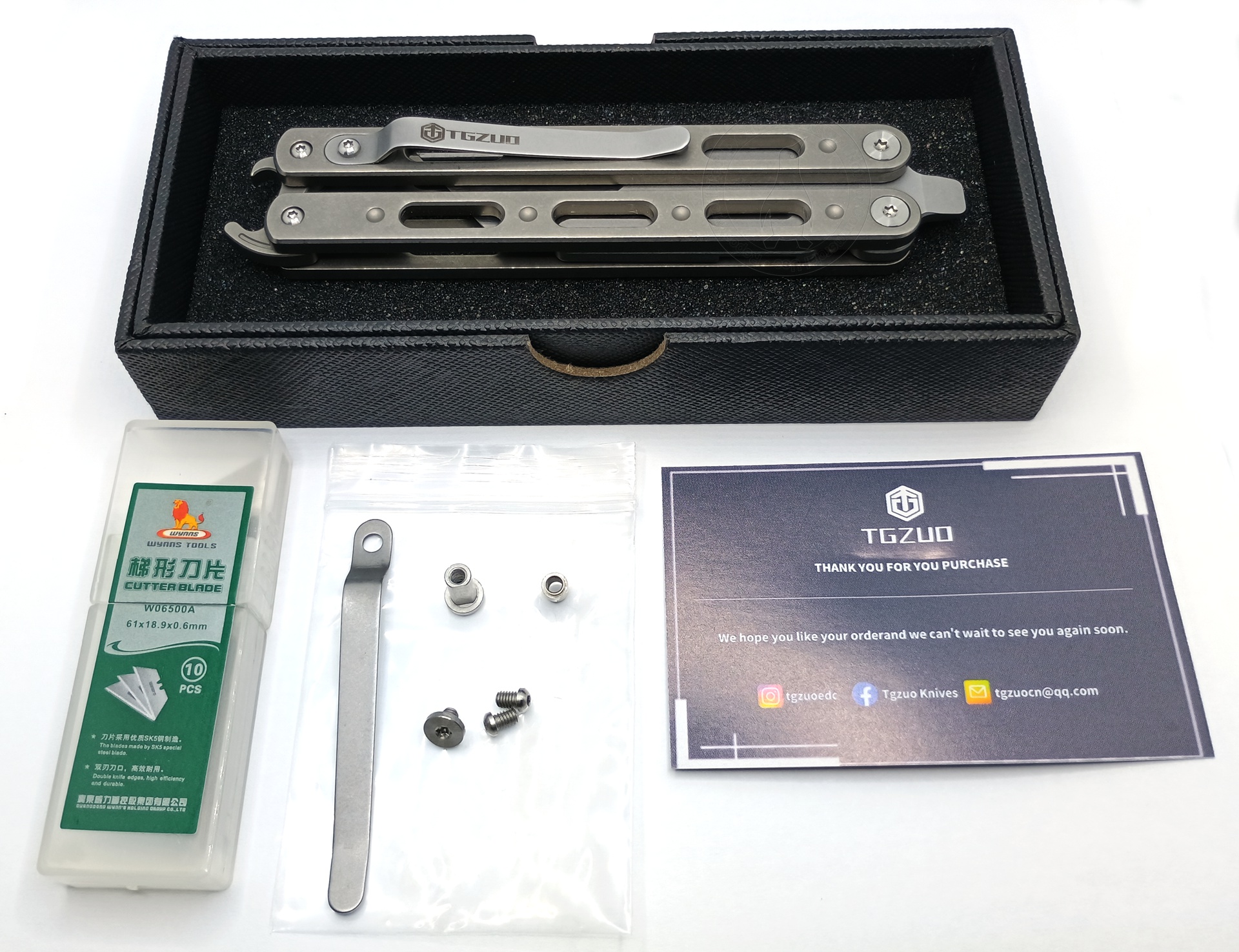
The Q19 comes in a pretty nice woven-textured box, and I was surprised to find that it even comes with a nearly complete set of replacement hardware inside as well. It comes with a spare clip, too, which may be an addition prompted by the smattering of reviews on Amazon bitching about said clip breaking. But I can't prove it. To be fair it is only held down by one screw, so I imagine if you were truly hopelessly uncoordinated it's possible you could rip the clip clean off of the knife. Remember, kids: The clip is for carrying the knife on the inside of your pocket, not for dangling it out in the open off of your belt to get snagged on every damn fool thing you might happen to pass by.
You get two replacement assembly screws (all five are the same, including the one mounting the clip), one each of the male and female pivot screws, one spacer barrel, and a clip. You don't get a replacement spring, though.
It also comes with a box of "WYNNS" utility knife blades, so you don't even have to get on your bicycle and pedal down to the hardware store to get your own. These aren't great, exactly, even easily outperformed in edge retention by those in my cheapo 100 pack from Lowes. But they'll do to start with. Of course you can mount any Stanley style blade in this provided it's thin enough to go in the slot, including fancy composite edged or even the forever-sharp ceramic ones.
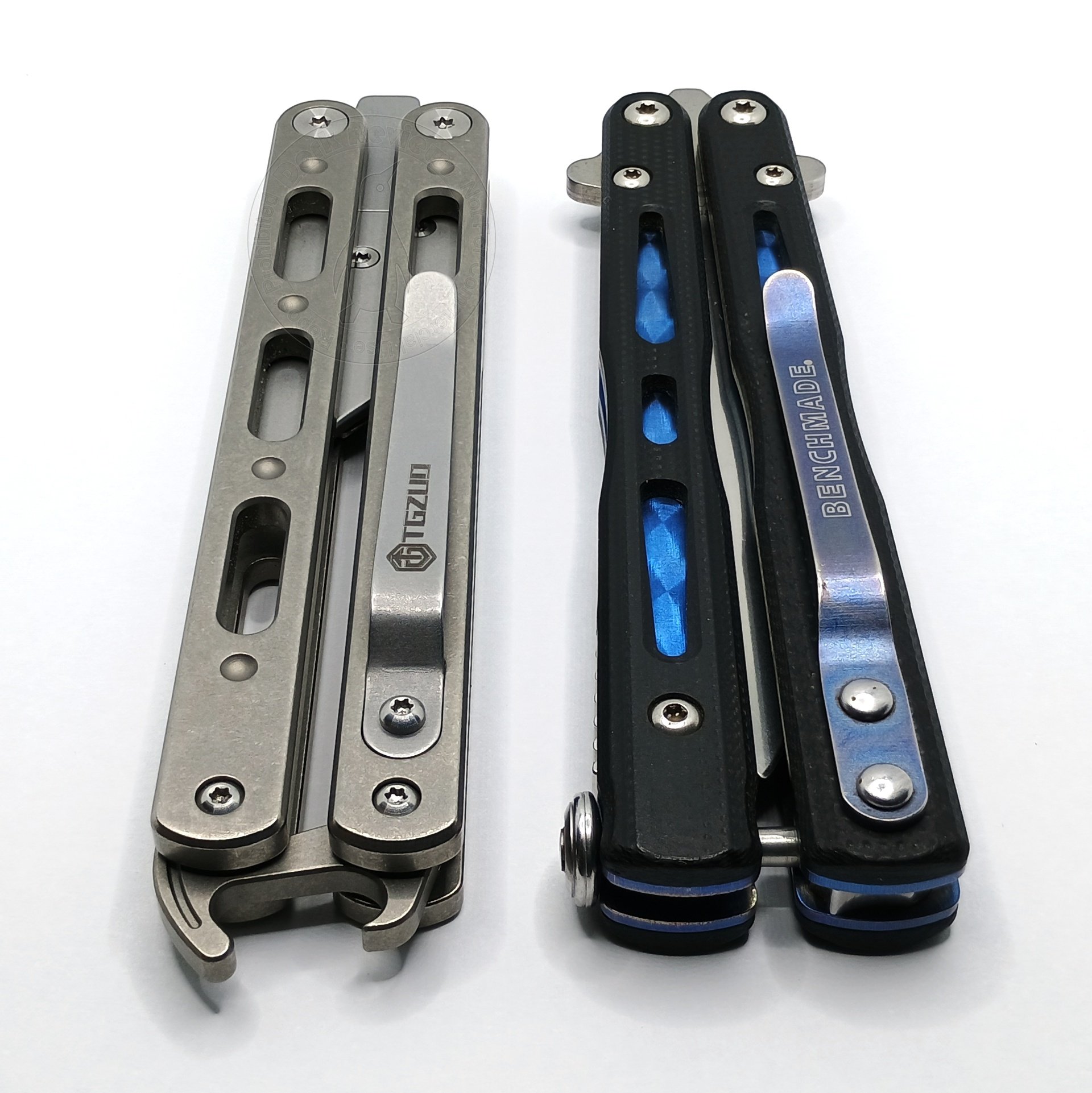
Oh, and the handle slabs are completely interchangeable so when I put it back together I swapped the bite side slabs, so I could put the clip on the correct goddamn side of the knife. I will begrudgingly re-award the points I docked for this originally, even though it should have come this way from the factory in the first place. Dagnabbit.
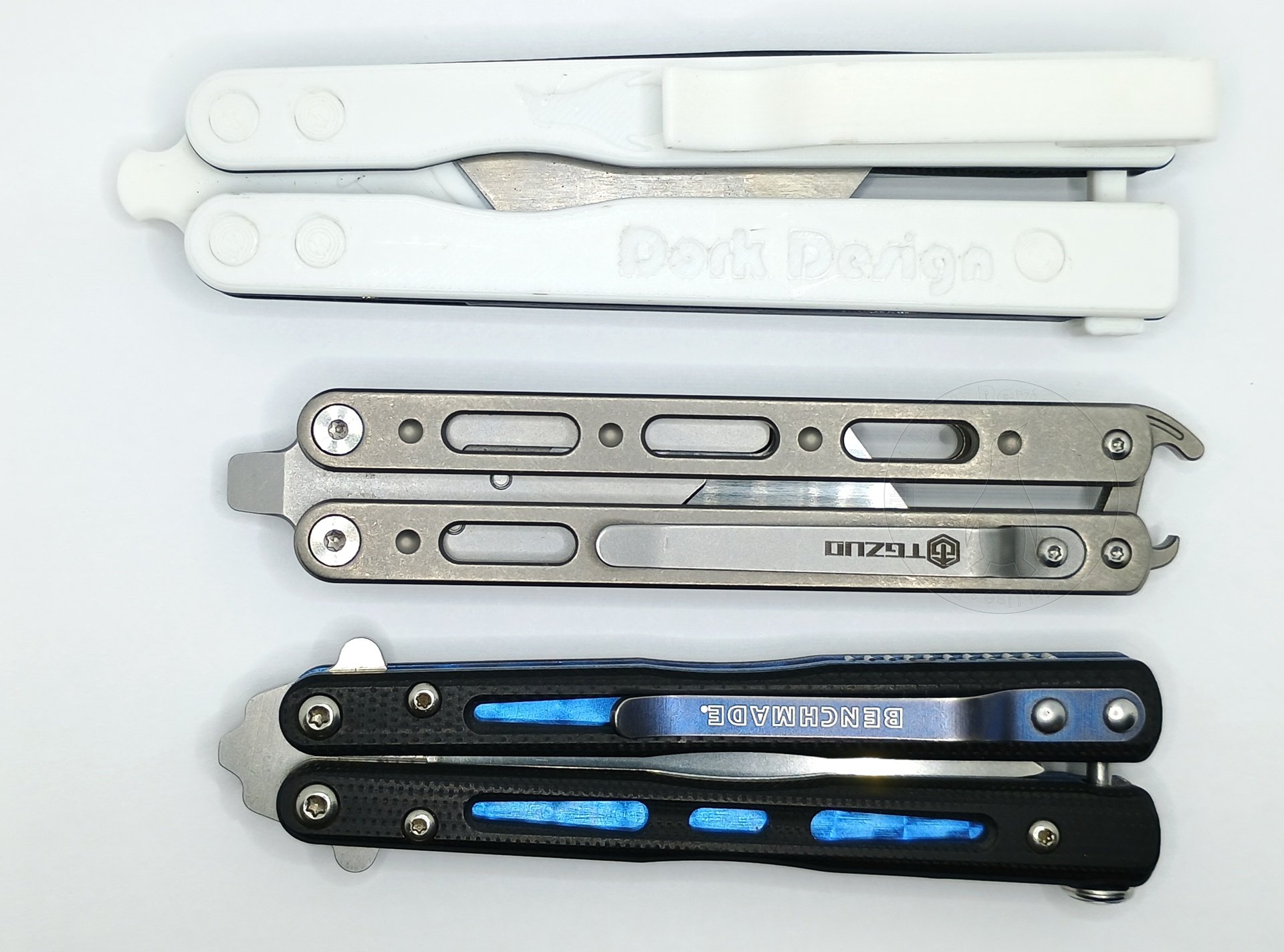
While we're flaunting that Benchmade Morpho, though, let's do our usual size comparison thing.
The Q19 is actually very similar in proportions to the Model 32, the smaller of the two Morphos. It's smaller than my Rockhopper balisong, although not for any mechanical reason -- I just designed the Rockhopper to be longer than it strictly needs to be for comfort purposes.
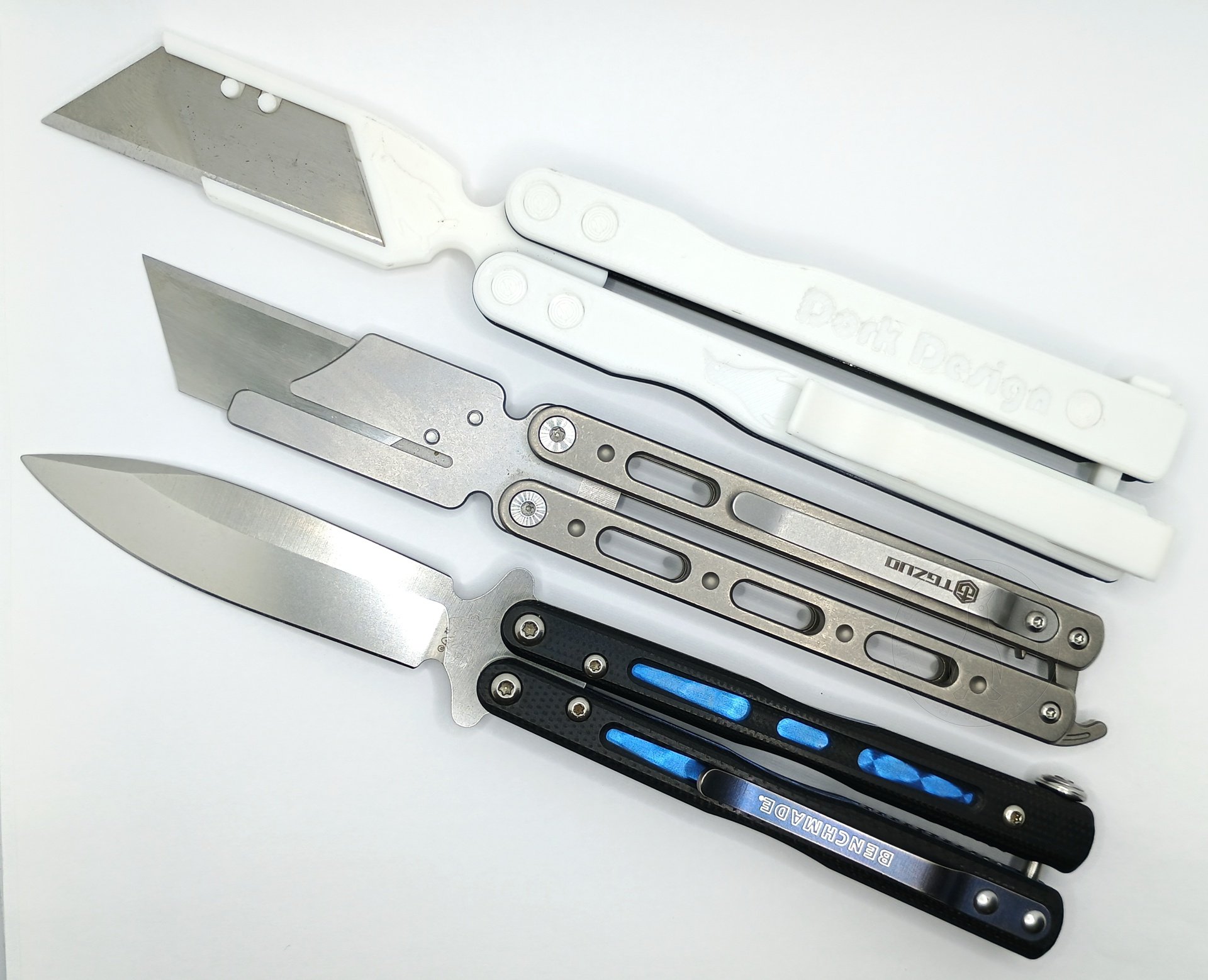
Open it's the same story, although both the Q19 and my Rockhopper's blade carriers are shorter overall than a normal fully steel blade probably would be.
The Inevitable Conclusion
This is pretty much the second coolest box cutter in the world. (The absolute coolest, of course, would be the one I designed. But I would say that, wouldn't I?)
In fact, the Q19 is way better in reality than it has any right to be. I can't find much of anything to complain about, really. It's actually built rather well, it's slick as all fuck, it has all the features, and the price is right, too.
Plus, I think it'd probably make a good introduction for anybody looking to get into balisongs. With a spring latch, titanium handles, and ball bearing pivots all in one package you really can't go wrong. And it's worth mentioning that it's significantly safer to be fucking around with than a normal live bladed balisong, for two reasons: One, you can just take the blade out of it if you feel like it. And two, even on the sharp "bite" side of the blade carrier, about a third of it has no edge exposed. Unless you're holding the handles really far down it's a fair bet you'll just whack the blunt part against your index finger rather than find yourself contributing an express blood donation.

Usually I spend all of my time with this type of thing damning with faint praise. Oh look at the little thing, it thinks it's a real knife, isn't that cute? But with the Q19, I can do no such thing.
It has all the hallmarks of crapness. It's a Chinese made, cheaply sold, generic and endlessly rebadged non-brand product that, for once, actually turns out to deliver 100% of what it promises. I'll be damned.

Okay, okay, this one is kind of a cheap shot.
Not just because this knife is cheap per se, although it definitely is: Only $6 at the moment. Rather, it's because I kinda-sorta posted it already.
But not really.
This knife has no real designation other than it's non-brand name, "Treszen(R)," and we are led to believe its model name is literally "EDC Pocket Knife." I have to wonder if that (R) there means whoever the hell is flogging these things on Amazon actually bothered to register their trademark in the US. Do you know, I'll bet you a nickel they didn't.

This knife bears more than a passing resemblance to one that I showed off in one of my very first Weird Knife Wednesday posts. That was the "SDOKEDC SD604A," and both that and this are very nearly clones of the Scorpiodesign Shapeshifter.
All three of the above are strong contenders for the king of knives that the uninitiated are guaranteed to never be able to figure out how to open. Just let motherfuckers find out you have one of these on you and they'll stop pestering you about borrowing your knife in a big hurry.
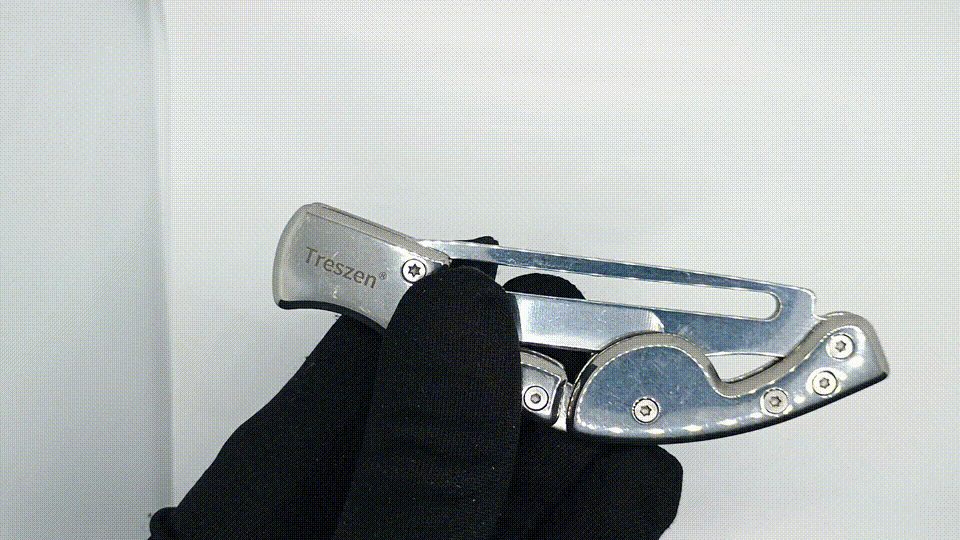
The action is this Rube Goldberg triple-jointed nonsense that achieves, at least according to the design goals of the Scorpiodesign original, a knife with an effective blade length longer than the handle is once it's deployed. If you find somehow that this was a void that absolutely needed filling in your life, well, here you go.
The product description goes on to describe it as, "Special Folding Method."
Yeah, that's for damn sure.
It doesn't really feature a lock as such, but when it's all folded out your grip on the handle forces the two halves to cam together, which effectively holds it open and prevents it from folding up on you.
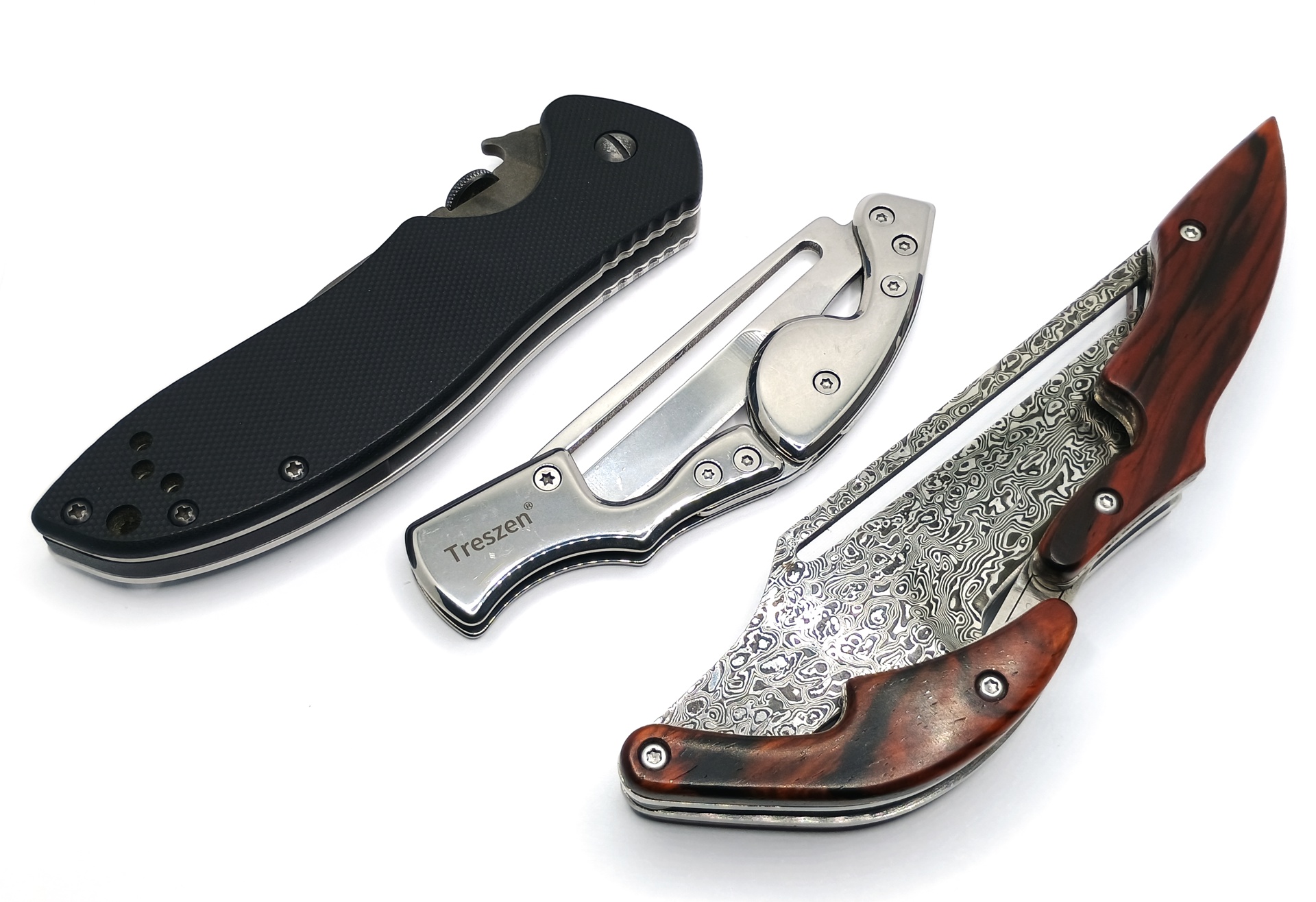
The critical difference here is that the Treszen here is much, much smaller than its inspiration. Small enough that you realistically could actually carry it if you were so inclined, which means I like this incarnation a lot better than the others -- which, novelty aside, are entirely too large and doofy to actually keep on you. That's the SDOKEDC on the right, there, which is near as I can figure identical in dimensions to the original Shapeshifter. And on the left, the bog standard Kershaw CQC-6K.

The Treszen is 5-1/4" long when open and 4" long closed, which puts it well within the realm of actual EDC friendly sizes. It's also only 0.320" thick.
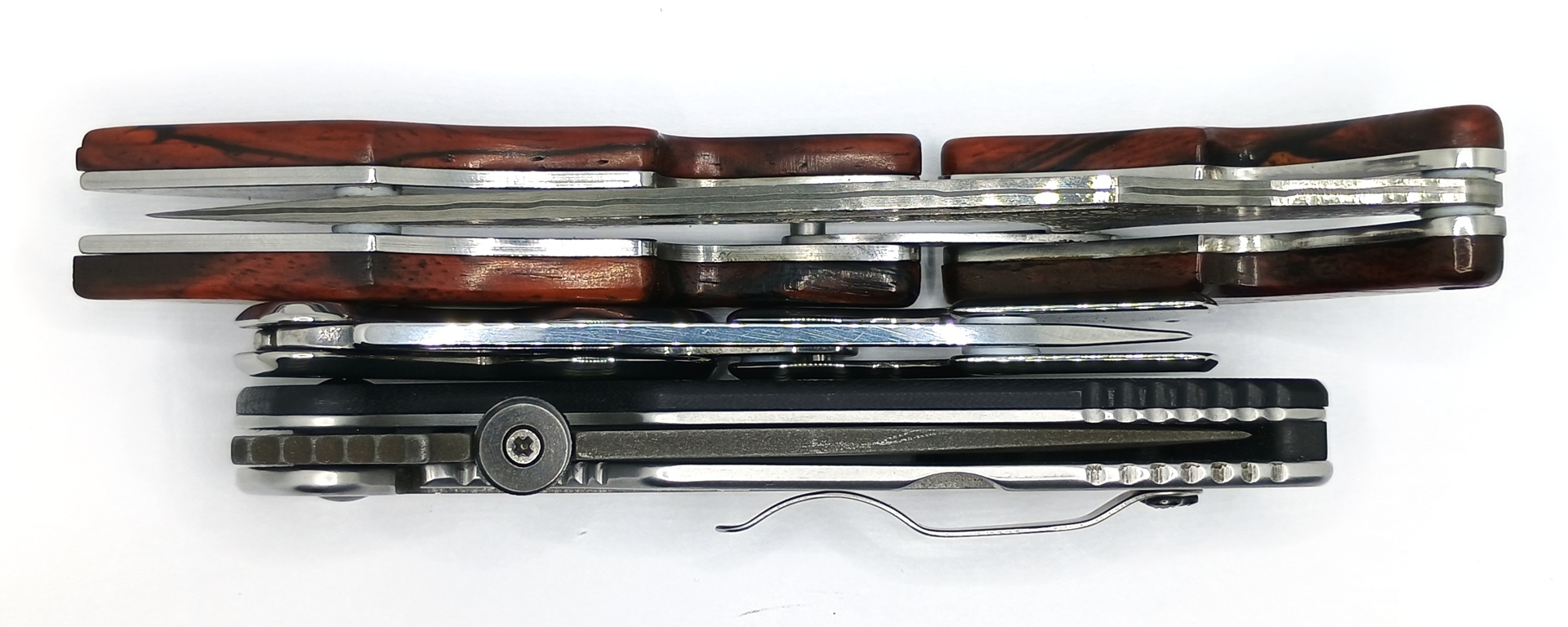
It's way slimmer than the SDOKEDC/Shapeshifter. It's about as thick as a Bugout, actually. But despite this, your EDC aspirations won't be helped in any way whatsoever by the complete lack of any kind of clip, lanyard hole, or even perfunctory ratty nylon belt pouch. You'll just have to let it slosh around in your pocket, I guess.
If it helps you any, though, it is extremely shiny.
That's because it is constructed entirely of metal. What kind of metal? Who knows. The best anyone can tell us is "high carbon steel." But because of this it weighs 61.3 grams overall or 1.16 ounces and feels denser in the hand than you'd expect. Its 2-3/16" blade has a drop point-ish profile that's not too weird to use for things, and is 0.096" thick.
The near mirror-polished surface is, of course, a complete magnet for both scratches and fingerprints. But damned if it doesn't give the thing an unexpectedly grown up vibe. This could, at least in dim lighting perhaps, pass for a gentleman's knife.
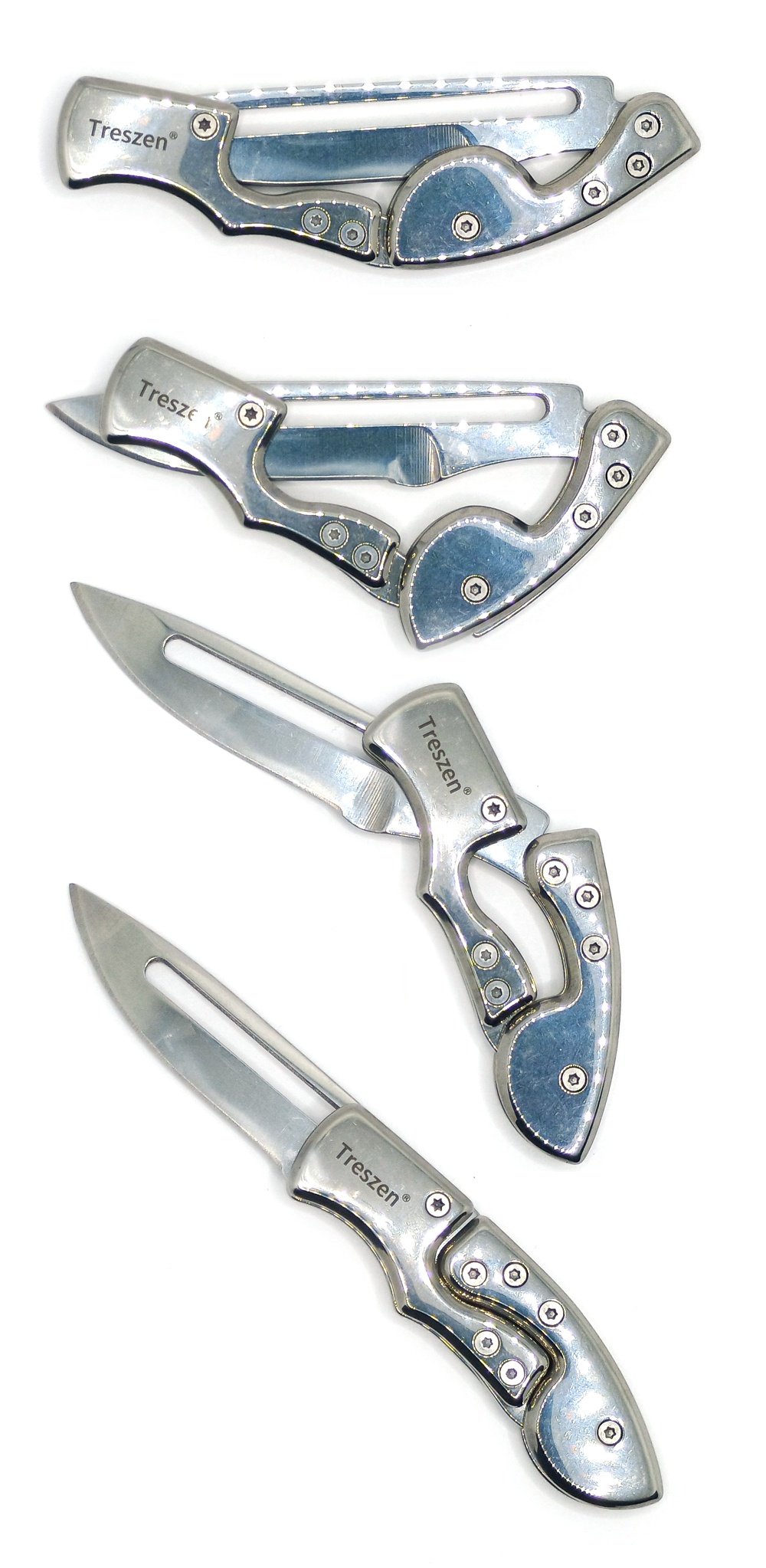
Playing with it is strangely satisfying, too. But that's only after you figure out the inherent fly in the ointment, which is that the tip of the blade by necessity pokes through one of the sections of the handle as a part of the opening process. And if you don't know this and you're not careful about it, it'll poke you, too.
I'll tell you what's not so elegant, though. The Treszen's build quality is actually kind of crap.
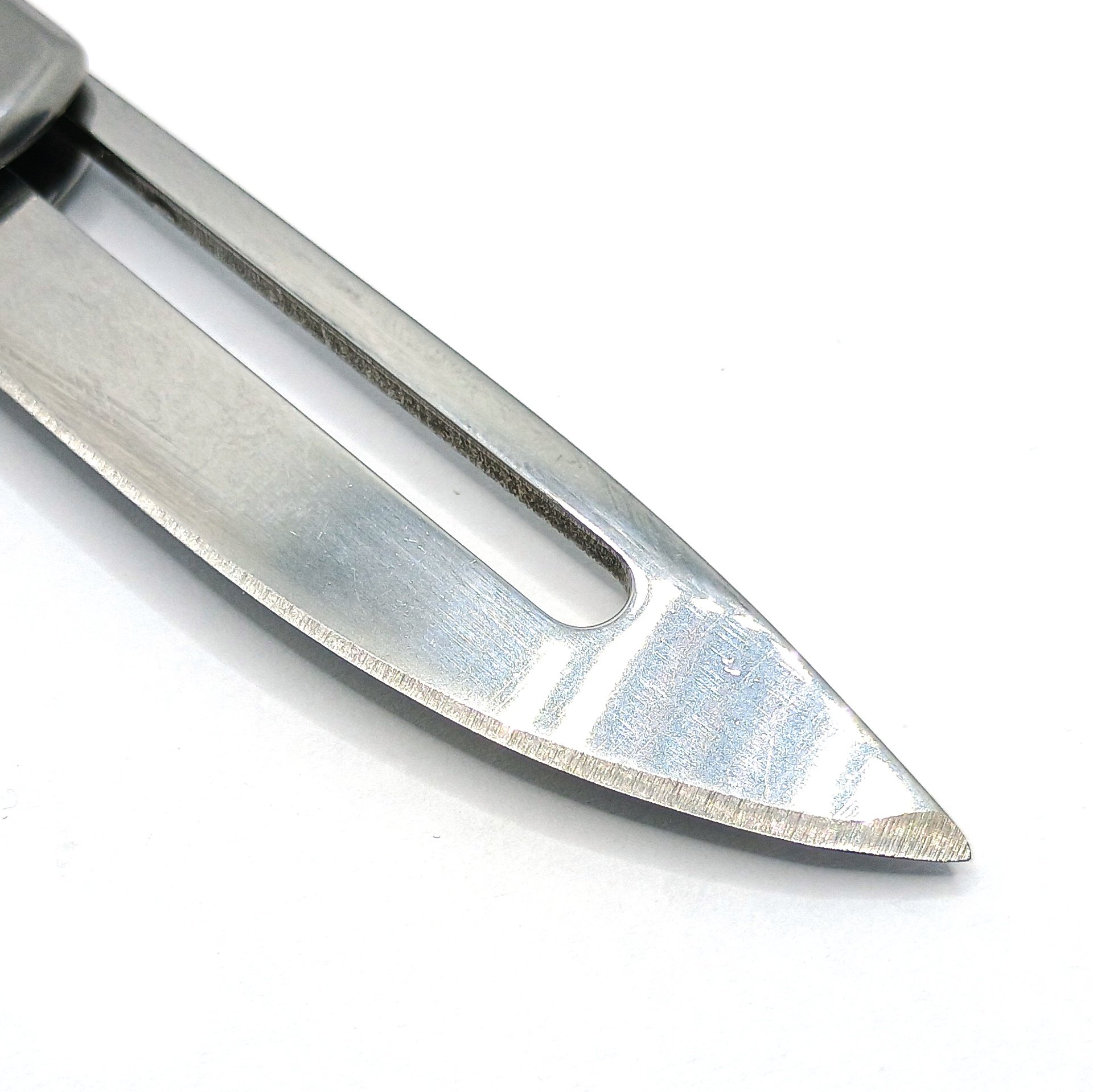
The edge grind features this rather hilarious chicane in it at the tip, for instance. I figure whoever had this on the grinding wheel must have sneezed right when they got to that part.
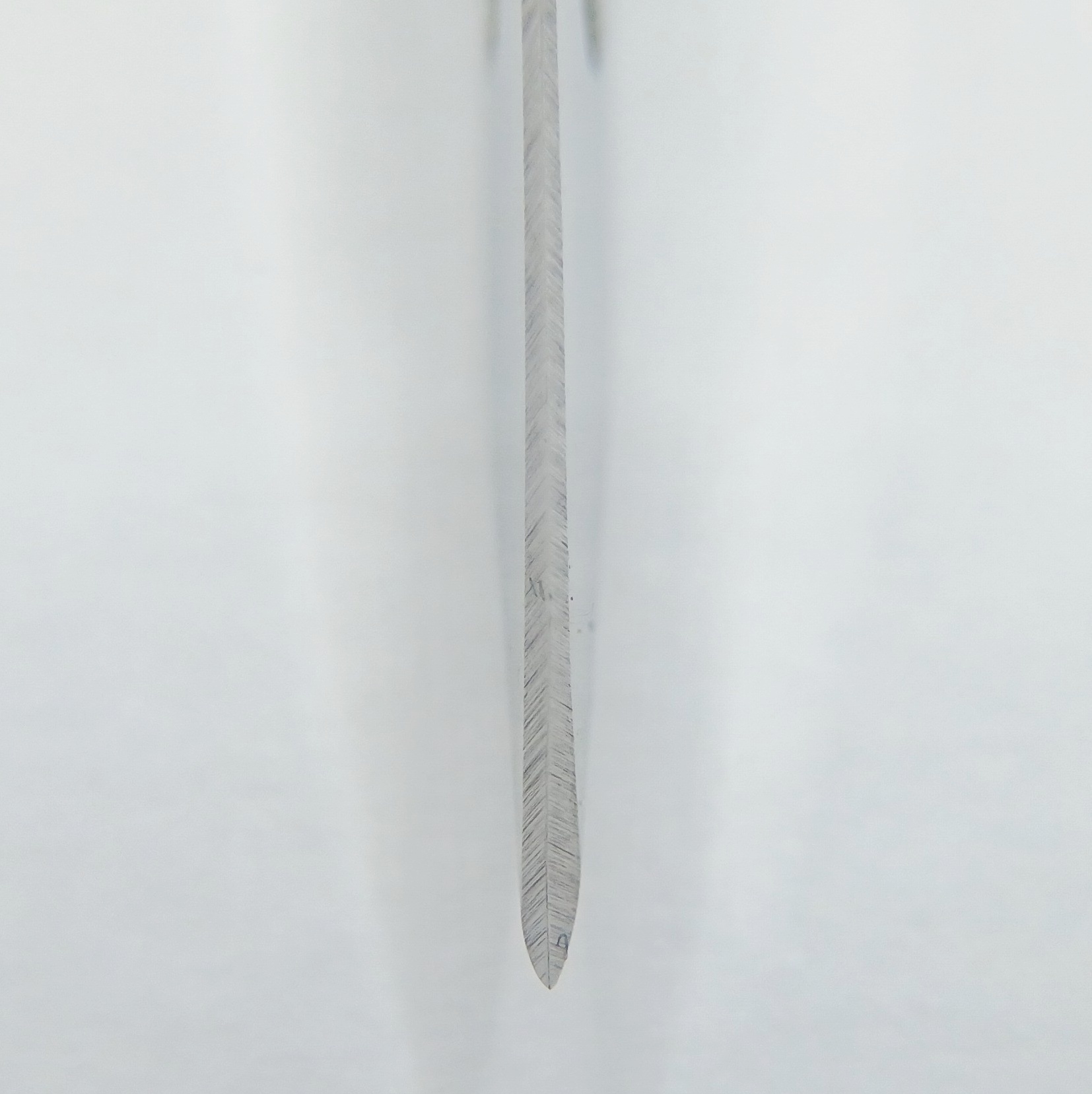
And but of course, the edge is gloriously out of true. At this rate, I would almost be disappointed if it weren't. For $6, would you really deprive yourself of the amusement, nay, sheer joy of spending an hour with your very best diamond stones bullying the edge back into shape?
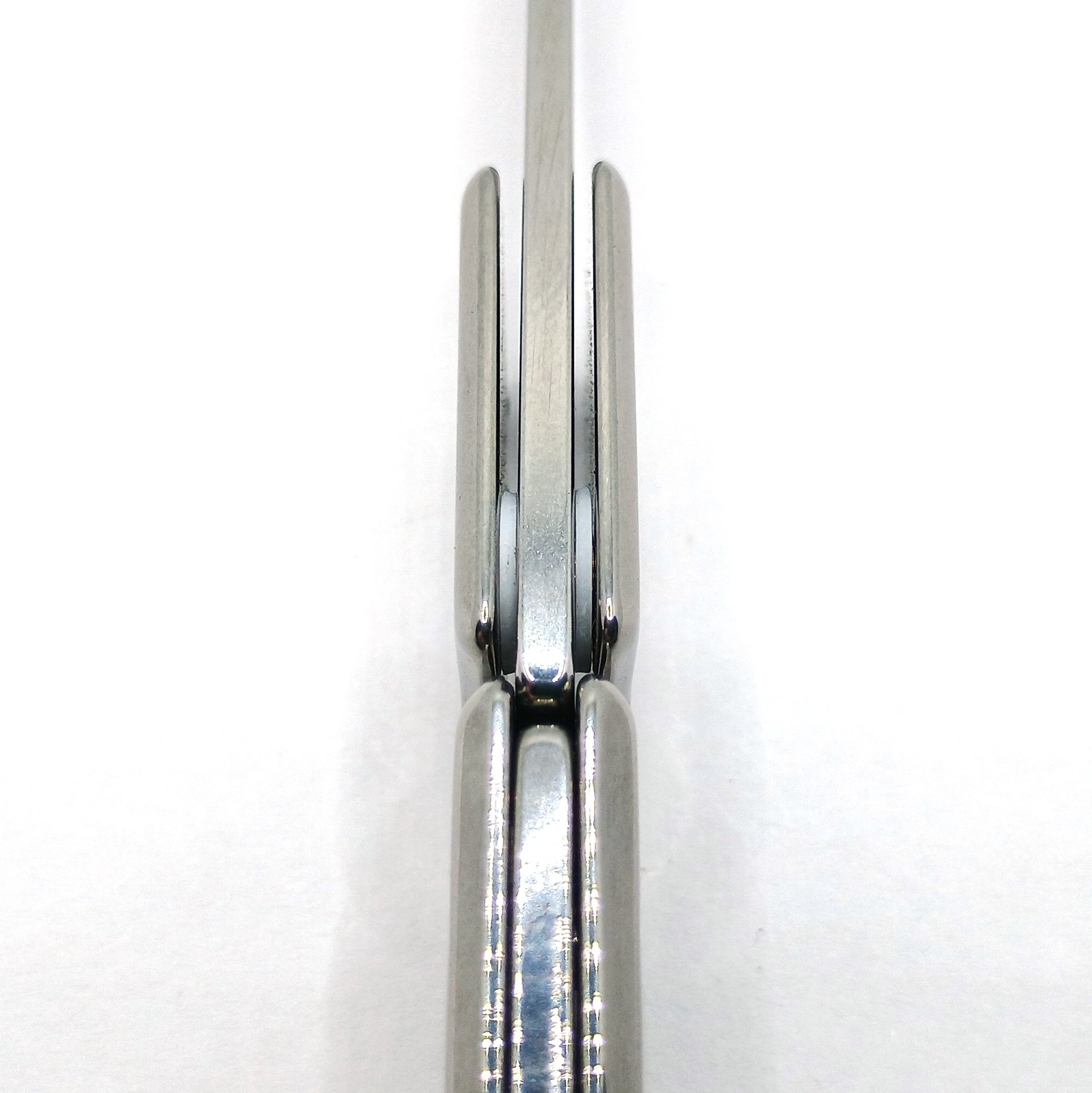
To its credit, the Treszen actually does away with the ridiculous gaps between all the moving parts that the old SDOKEDC featured. Despite not actually being built that well in an objective sense, this helps in making it at least superficially feel quite a bit less naff. The main pivot where the blade slides down along its track is spaced out with these nylon washers, for instance, which probably help reduce the mechanism's friction from completely untenable to merely absurd, and also result in a fairly low amount of wiggle in the blade once it's deployed.
I was going to take the Treszen apart to show you this, but I'm ashamed to admit that, well... I can't.

That's because while it's theoretically held together with Torx screws, several of them are pre-stripped from the factory and some of the others are so malformed that they don't fit any driver I own. Just look at them. I have no idea how the factory even managed to assemble it.
The Inevitable Conclusion
I've never held a knife so crappy that I liked so much.
I don't even really know why. At the end of the day, the Treszen really isn't any more practical than its larger brethren despite being markedly easier to carry. There still isn't any way to describe its method of operation that does not somewhere include the words "deeply silly." And yet.
I can say one thing about it, though, which may also be a result of its German roots: It is categorically impossible to open with one hand. That's not a benefit anybody, except for someone who lives in a place where one-hand opening and locking knives are illegal. Like, oh, Germany. Just a thought.
Strange as it is, ridiculous as it is, I think it would take a indefensibly unreasonable leap for anyone to claim view the Treszen as a weapon. You can't call it anything more than a pennknife. Hell, a Swiss Army Classic is just about John Rambo's Bowie knife compared to this thing. It's so stupid that it's completely nonthreatening.
I mean, just look at him face. How can you not adore that?


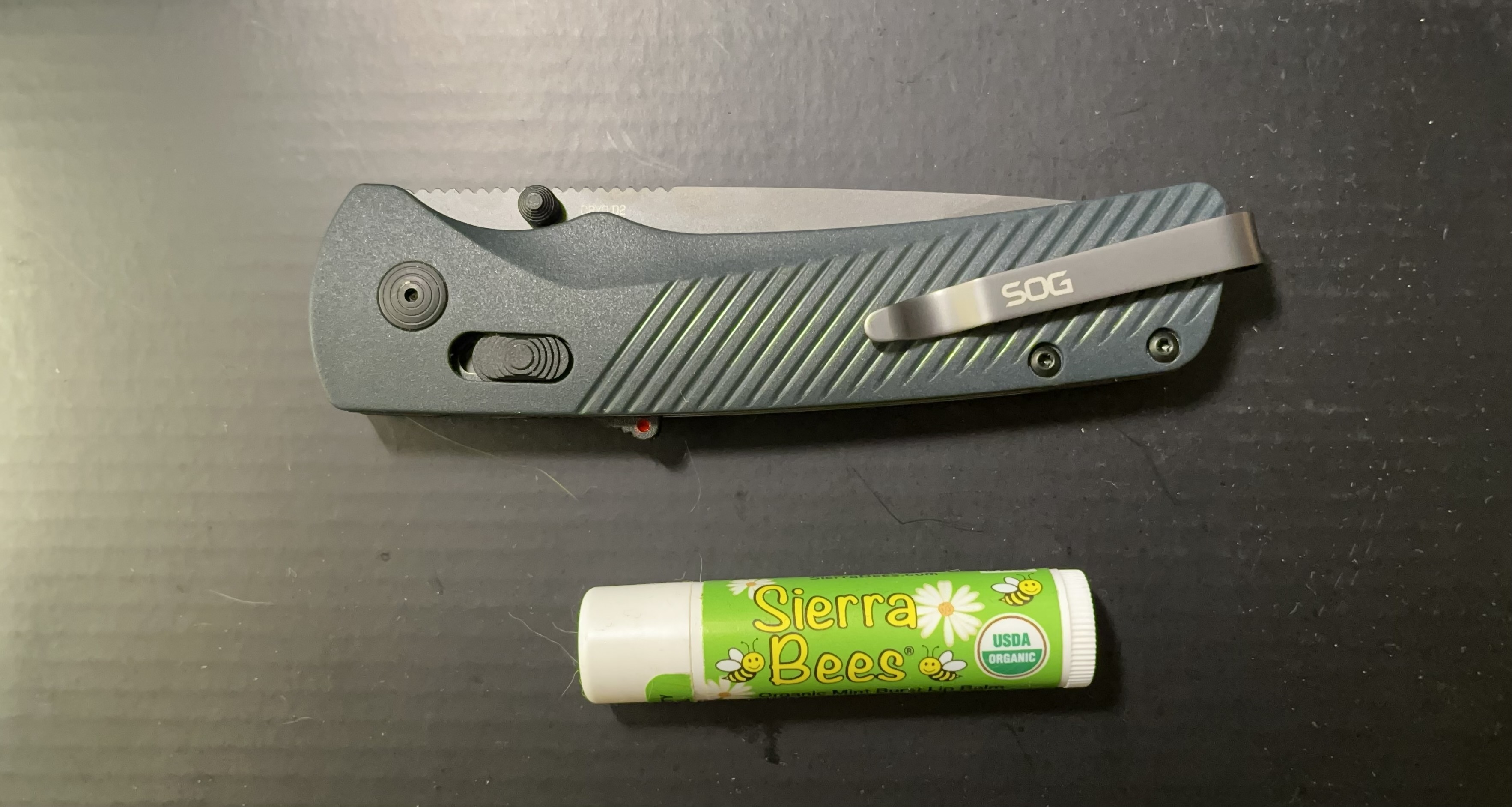
So far I love it. Overall very durable and solid feeling. Love the assisted open action. Blade is very very sharp. Chap Stick for scale.
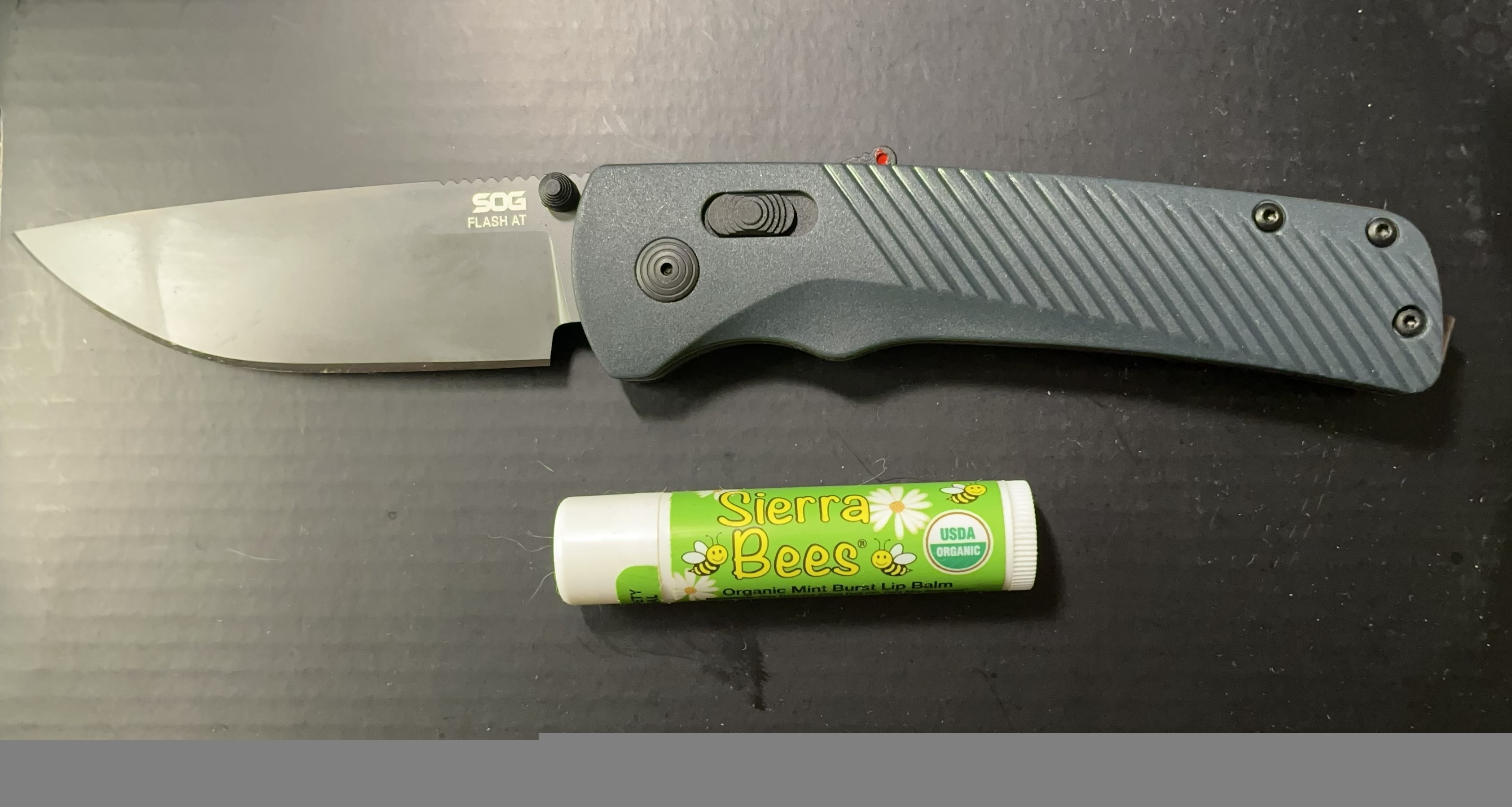
It may in fact happen to transpire that I, too, have a type.
Actually several, probably.
Left to right, top to bottom:
- Kershaw CQC-5K 6074OLBLK
- Kershaw CQC-6K D2 Version
- Kershaw CQC-6K 8Cr Version
- Kershaw CQC-11K D2
- Zero Tolerance ZT0630
- Zero Tolerance ZT0620
- Kershaw CQC-4KXL D2
